Abstract
Background
Nausea and vomiting are distressing symptoms which are experienced commonly during caesarean section under regional anaesthesia and can also occur in the period following the procedure.
Objectives
To assess the efficacy of pharmacological and non‐pharmacological interventions given prophylactically to prevent nausea and vomiting in women undergoing regional anaesthesia for caesarean section.
Search methods
We searched the Cochrane Pregnancy and Childbirth Group’s Trials Register (27 February 2012) and reference lists of identified studies.
Selection criteria
We included randomised controlled trials (RCTs) and excluded quasi‐RCTs and cross‐over studies.
Data collection and analysis
Review authors independently assessed the studies for inclusion, assessed risk of bias and carried out data extraction. Data entry was checked.
Main results
Fifty‐two studies met the inclusion criteria but only 41 studies, involving 5046 women, provided useable data for the review involving women having caesareans under regional anaesthesia. The majority of the studies involved women undergoing elective caesarean section. Only two studies included emergency surgery, however, they did not stratify data according to type of surgery. The studies covered numerous comparisons, but the majority of studies involved 5‐HT3 receptor antagonists, dopamine receptor antagonists, corticosteroids or acupressure. Studies were mainly small and of unclear quality.
Three classes of intervention were found to be effective in at least three out of four of our primary outcomes (intraoperative nausea, intraoperative vomiting, postoperative nausea and postoperative vomiting). These interventions were 5‐HT3 antagonists, dopamine antagonists and sedatives. Other classes of intervention were effective for fewer than three of our primary outcomes.
With 5‐HT antagonists, we found a reduction in intraoperative nausea (average risk ratio (RR) 0.64, 95% confidence interval (CI) 0.46 to 0.88, eight studies, 720 women). There were also reductions in postoperative nausea (average RR 0.40, 95% CI 0.25 to 0.64, four studies, 405 women) and vomiting (average RR 0.50, 95% CI 0.32 to 0.77, five studies, 565 women). We did not detect a significant reduction in intraoperative vomiting (average RR 0.56, 95% CI 0.31 to 1.00, seven studies, 668 women).
Dopamine antagonists demonstrated a reduction in intraoperative nausea (average RR 0.38, 95% CI 0.25 to 0.57, nine studies, 636 women) and intraoperative vomiting (average 0.39, 95% CI 0.24 to 0.64, eight studies, 536 women), with similar reductions in postoperative nausea (average RR 0.60, 95% CI 0.40 to 0.91, five studies, 412 women) and vomiting (average RR 0.57, 95% CI 0.36 to 0.91, six studies, 472 women). These differences were observed with both metoclopramide and droperidol.
Sedatives (most commonly propofol) demonstrated a reduction in intraoperative nausea (average RR 0.71, 95% CI 0.52 to 0.96, four studies, 285 women) and intraoperative vomiting (average RR 0.42, 95% CI 0.26 to 0.68, four studies, 285 women), also with a reduction in postoperative nausea (average RR 0.25, 95% CI 0.09 to 0.71, two studies 145 women) and vomiting (average RR 0.09, 95% CI 0.03 to 0.28, two studies, 145 women).
Acupressure was found to be effective for intraoperative nausea (average RR 0.59, 95% CI 0.38 to 0.90, six studies, 649 women) but not postoperative nausea (average RR 0.83, 95% CI 0.68 to 1.00, three studies, 429 women). Acupressure was not effective at reducing vomiting either intraoperatively (average RR 0.74, 95% CI 0.46 to 1.18, six studies, 649 women) or postoperatively (average RR 0.69, 95% CI 0.45 to 1.06, three studies, 429 women).
Other effective intervention classes included corticosteroids, antihistamines, and anticholinergics.
There were insufficient data to demonstrate any class of intervention was superior to another. There were no significant differences observed in the comparison of combined versus single interventions.
Few studies assessed our secondary outcomes or the incidence of adverse effects. However, one study showed an increase in respiratory depression with sedation (midazolam) compared with dopamine antagonists.
Authors' conclusions
This review indicates that many different interventions have efficacy in preventing nausea and vomiting in women undergoing regional anaesthesia for caesarean section. There is little evidence that combinations of treatment are better than single agents.
Plain language summary
Reducing nausea and vomiting in women receiving regional anaesthesia for caesarean section
Caesarean section is a commonly performed operation for the birth of a baby when difficulties arise either for the mother or for the baby. Women may be either awake for the procedure (regional anaesthesia) or asleep (general anaesthesia). Nausea and vomiting are common and distressing symptoms, which can occur during the procedure if the woman is awake or they can also occur after the procedure. Low blood pressure and some of the medications administered during the procedure may contribute to the nausea and vomiting.
A wide range of medications are commonly used either to reduce the chance of symptoms occurring, or are given as a treatment if symptoms do occur. In addition, a number of non‐drug approaches have been tried such as using acupuncture or acupressure; giving extra oxygen; or giving extra intravenous fluids. We aimed to study the effectiveness of the various treatments to reduce the occurrence of nausea and vomiting during elective or emergency caesarean section using regional anaesthesia. We found 41 studies (involving 5046 women) that met our inclusion criteria and provided data which we could analyse. These were mainly small studies of unclear or poor quality.
Nevertheless, we found that many drugs, such as 5‐HT3 antagonists (e.g. ondansetron), dopamine antagonists (e.g. metoclopramide, droperidol) and sedatives (mainly propofol) were effective in reducing the occurrence of nausea and vomiting either during surgery under regional anaesthesia or afterwards. Other effective interventions for some nausea and vomiting included corticosteroids (e.g. dexamethasone), antihistamines (e.g. cyclizine) and anticholinergics (e.g. scopolamine). In addition, acupressure was effective in reducing some nausea but not vomiting.
Few studies assessed the possible side effects such as headaches, dizziness, low blood pressure, skin rashes and breathing difficulties.
In addition to this review, there will be two further reviews on nausea and vomiting at caesarean section. The first will look at interventions given to reduce nausea and vomiting after general anaesthesia (as opposed to regional anaesthesia). The second will explore interventions given as a treatment to women who do suffer nausea and vomiting during regional anaesthesia.
Background
Nausea and vomiting are common symptoms experienced during caesarean section under regional anaesthesia and can also occur in the postoperative period following caesarean section under either regional or general anaesthesia. Nausea and vomiting during and after the birth of a baby are distressing for both the woman and her family. In addition, when vomiting occurs intraoperatively under regional anaesthesia, it offers significant challenge to the operating surgeon, potentially increasing the duration of the procedure and the risk of bleeding and inadvertent associated surgical trauma. There is also the potential risk of aspiration of gastric contents when vomiting occurs intraoperatively (Paranjothy 2010).
Caesarean section is a very commonly performed surgical procedure. The World Health Organization data indicate the caesarean section rate varies widely from less than 5% of births in low‐income countries (e.g. 5% in Zimbabwe) to 20% to 30% in high‐income countries (e.g. 22% in Germany) (WHO 2008). There are approximately 4.40 million live births in Central Europe and 4.43 million in the United States each year. This equates to approximately 1.7 million caesarean sections performed each year in Europe and the United States alone. Also, rates have risen considerably in high‐income countries in recent years, and still continue to rise. In the UK the rate was 21.3% in 2000 (Thomas 2001) and 23.8% in 2006 (Redshaw 2007). In a recent study of NHS trusts, the caesarean section rate ranged from 14.9% to 32.1% (Bragg 2010). The majority of caesarean sections these days are carried out under regional analgesia, though some need to be carried out under general anaesthesia, particularly in emergency situations or when there is a contraindication to the use of regional anaesthesia.
There are multiple underlying causes of nausea and vomiting at caesarean section and several different modes of intervention are in common use. Many different studies have evaluated these interventions, either compared with one another or with placebo. In some countries, for example in the UK (NICE 2011), there is a recommendation for the routine administration of drugs (antiemetics) or acupressure to try to prevent nausea and vomiting at caesarean section. However, it is probably more common clinical practice to give antiemetic medication as treatment, rather than as prophylaxis. It is not known to what extent medications which are efficacious as treatment are also efficacious as prophylaxis (and vice versa). All such interventions are associated with increased healthcare costs and potential risks to the woman (and potentially to the neonate, via breastfeeding) and therefore, their use should be evidence‐based. The aim of this review is to assess the effectiveness of these interventions given as prophylaxis during caesarean section to prevent nausea and vomiting. Studies aiming to assess interventions for secondary treatment of nausea and vomiting will be assessed in a separate review. A further review will also evaluate studies investigating the treatment of nausea and vomiting following caesarean section under general anaesthesia.
Description of the condition
Nausea is the unpleasant subjective urge to vomit. In contrast, vomiting is the propulsive abdominal muscular spasms associated with the expulsion of gastric contents. Retching is the same propulsive muscular spasms as vomiting (but without the expulsion of gastric contents).
The exact incidence of nausea and vomiting during caesarean section, and in the ensuing postoperative period, is uncertain as few prospective observational studies or audit data have been published. It is also likely that the baseline rate will vary depending on the anaesthetic and analgesic regimen used. However, it would seem reasonable to use the rates of nausea and vomiting in the placebo arms of well‐designed randomised trials as an indication of the baseline rate. Published placebo data show rates of nausea or vomiting ranging from 23% (Fujii 1998a) to 79% (Abouleish 1999). Most studies recruit women in the setting of elective caesarean section, and it is possible that rates are higher in the setting of emergency caesarean section.
Several aetiological factors contribute to the incidence of nausea and vomiting. These include hypotension (a frequent side effect of regional anaesthesia), reduced cardiac output from aorto‐caval compression (Cooke 1979), surgical stimulation from visceral traction such as exteriorisation of the uterus (Wahab 1999) and intraoperative medications including opiates and administered uterotonics including syntocinon and particularly ergometrine (De Groot 1998). Postoperative nausea and vomiting are also common, and can affect women who received regional or general anaesthesia. In most types of surgery, the use of regional anaesthesia is thought to be associated with lower rates of postoperative nausea and vomiting than general anaesthesia (Gan 2003); however, this difference may not be apparent following caesarean section. Almost all postoperative analgesia regimens involve the use of opioid type medications, either by oral, intravenous or neuraxial (spinal or epidural) routes, all of which can contribute to nausea and vomiting.
Description of the intervention
In this review, we have included pharmacological and non‐pharmacological interventions given specifically for the purpose of preventing nausea and vomiting in women undergoing caesarean section. Whilst hypotension is clearly an important cause of these symptoms during caesarean section, treatment for hypotension during regional anaesthesia has already been specifically addressed in another Cochrane review (Cyna 2006). Sometimes interventions can be given for other reasons, but may have an impact on nausea and vomiting. For example, interventions to reduce the risk of acid aspiration may well affect nausea and vomiting. These interventions have also been addressed in another Cochrane review (Paranjothy 2010).
The pharmacological interventions available include medications from a wide range of drug classes including dopamine and serotonin receptor antagonists, corticosteroids, antihistamines, sedatives and anticholinergics (Flake 2004).
A number of non‐pharmacological approaches have also been used to treat intraoperative nausea and vomiting including acupuncture or acupressure (Ho 2006), supplemental oxygen (Ghods 2005; Phillips 2007) and boluses of intravenous fluids (Morgan 2001).
This review has assessed the efficacy of interventions specifically used as prophylaxis to prevent the occurrence of nausea and vomiting in women undergoing caesarean section under regional anaesthesia. We define prophylaxis as an intervention that is commenced prior to, and without regard for, the onset of symptoms. Treatment is defined as an intervention which is commenced following, and in response to, the onset of symptoms. Interventions given as treatment to reduce established nausea and/or vomiting will be assessed in a different review.
How the intervention might work
Pharmacological interventions
The exact mechanism of action of many of the recognised interventions for the prevention of nausea and vomiting is not well understood. However, most treatments can be classed pharmacologically based on their receptor target. Nausea and vomiting caused by visceral stimulation is thought to be mediated predominantly via serotonin and dopamine, whereas nausea and vomiting caused by central nervous system and vestibular mechanisms are thought to be mediated mainly via histamine and acetylcholine. The chemoreceptor trigger zone (CTZ), a small region within the brainstem (responsible for medication and toxin related emesis symptoms) is mediated by serotonin and dopamine.
The main classes of medications in use include the following (Flake 2004; Gan 2003).
Serotonin (5‐HT) receptor subtype‐3 antagonists (e.g. ondansetron, granisetron) antagonise the emetic effects of serotonin in the small bowel, vagus nerve and CTZ (Peixoto 2006). They are effective and have few side effects. The most common adverse effects include headache and gastrointestinal symptoms (including diarrhoea).
Dopamine receptor antagonists (e.g. metoclopramide, prochlorperazine, droperidol, domperidone) antagonise the effects of dopamine at the D2 receptors in the CTZ. They have a wide variety of associated side effects including sedation, agitation, and extra‐pyramidal effects (Chestnut 1989). Droperidol has been associated with very rare, but potentially life threatening, cardiac arrhythmias.
Corticosteroids (most commonly dexamethasone) are regarded as being highly effective but the mechanism of action is not clear (Tzeng 2000). Whilst long‐term steroid use can lead to a wide variety of side effects (such as fluid and electrolyte changes, obesity, and diabetes), single antiemetic doses are well tolerated.
Antihistamines (e.g. phenergan [Habib 2007] and cyclizine [Nortcliffe 2003]) can cause a variety of adverse effects including sedation and dry mouth.
Anticholinergic agents (e.g. glycopyrrolate [Ure 1999], scopolamine [Kotelko 1989]) are mainly useful for nausea and vomiting caused via the vestibular system.
Sedatives. Low doses of sedatives such as midazolam or propofol (Numazaki 2003; Warwick 1997) seem to have efficacy.The mechanism of action is unclear, but may relate to the contribution of psychological factors such as stress and anxiety to the incidence of emetic symptoms
Opioids. A number of studies have attempted to demonstrate the beneficial effects of opioids. Whilst generally considered to be a cause (rather than a treatment) of nausea and vomiting, it is possible that when two opioids are administered together, one of them may reduce the opioid‐induced emetic symptoms caused by the other. This may be due to one drug being an opioid antagonist or partial agonist (such as nalbuphine) (Charuluxananan 2003), or if one drug is given by an alternative route (such as intrathecal fentanyl) (Manullang 2000).
Non‐pharmacological interventions
Supplemental oxygen: hypoxia has been proposed as a contributor to nausea and vomiting (Ghods 2005). At low or moderate concentrations, supplemental oxygen is associated with few side effects.
Intravenous fluids: dehydration has also been proposed as a contributor to nausea and vomiting, perhaps by increasing the incidence and severity of hypotension. Supplemental fluids may assist in treatment of this. Excessive fluid supplementation may theoretically cause volume overload, cardiac failure and electrolyte abnormalities.
Acupuncture or acupressure: a number of trials have proposed efficacy of acupressure or acupuncture (Duggal 1998; Harmon 2000) at the P6 point at the wrist, although the mechanism of action of acupuncture and acupressure is not well understood. Potential adverse effects of acupuncture includes infection or trauma from acupuncture needles.
Why it is important to do this review
Nausea and vomiting are very common symptoms experienced both during and following caesarean section, with significant associated morbidity, and can be very distressing for women and their families. Many interventions are available and routine prophylactic treatment has been proposed (NICE 2011). The available interventions have widely varying cost and significant side‐effect profiles. This review is important to ensure that women undergoing caesarean section are offered interventions to prevent nausea and vomiting which are safe, efficacious and cost effective.
Objectives
To assess the efficacy of pharmacological and non‐pharmacological treatments given prophylactically to prevent nausea and vomiting at caesarean section under regional anaesthesia.
Methods
Criteria for considering studies for this review
Types of studies
We included published and unpublished randomised controlled trials (RCTs), including cluster‐randomised trials. Quasi‐RCTs and cross‐over studies were excluded.
Types of participants
Pregnant women undergoing elective or emergency caesarean section under regional anaesthesia.
Types of interventions
We included studies where the intervention was given with the express purpose of preventing either intraoperative or postoperative nausea and vomiting, or both. We compared the various interventions with placebo or no treatment, and with each other.
We excluded studies where the express purpose was to treat another problem which may impact upon the development of nausea or vomiting, such as studies assessing agents for treating hypotension. Studies which assess the efficacy of these interventions for treatment (rather than prevention) of nausea and vomiting will be included in a separate review.
Interventions included the following categories.
Serotonin (5‐HT3) receptor antagonists (e.g. ondansetron, granisetron).
Dopamine receptor antagonists (e.g. metoclopramide, prochlorperazine, droperidol, domperidone).
Corticosteroids (e.g. dexamethasone).
Antihistamines (e.g. promethazine, cyclizine).
Anticholinergic agents (e.g. glycopyrrolate, scopolamine).
Sedatives (e.g. midazolam, propofol).
Opioids (e.g. nalbuphine)
Supplemental oxygen.
Intravenous fluids.
Acupuncture/acupressure.
We compared the different drug classes against placebo and against each other, setting out individual drugs and doses as subgroups. We compared different drugs within the same class in separate comparisons and we considered differing doses of the same drug, also in separate comparisons.
Types of outcome measures
Primary outcomes
Nausea intraoperatively.
Vomiting (and/or retching) intraoperatively.
Nausea postoperatively.
Vomiting (and/or retching) postoperatively
Secondary outcomes
Maternal adverse effects: e.g. sedation, restlessness, extra‐pyramidal effects, surgical bleeding, hypotension, atonic uterus.
Neonatal morbidity: e.g. Apgar scores less than seven at five minutes.
Initiation of breastfeeding.
Duration of exclusive breastfeeding.
Maternal satisfaction (using a validated questionnaire).
In this review, when authors reported retching and vomiting separately, we combined these data, as we believe retching is more pathophysiologically analogous to vomiting than nausea.
Search methods for identification of studies
Electronic searches
We contacted the Trials Search Co‐ordinator to search the Cochrane Pregnancy and Childbirth Group’s Trials Register (27 February 2012).
The Cochrane Pregnancy and Childbirth Group’s Trials Register is maintained by the Trials Search Co‐ordinator and contains trials identified from:
monthly searches of the Cochrane Central Register of Controlled Trials (CENTRAL);
weekly searches of MEDLINE;
weekly searches of EMBASE;
handsearches of 30 journals and the proceedings of major conferences;
weekly current awareness alerts for a further 44 journals plus monthly BioMed Central email alerts.
Details of the search strategies for CENTRAL, MEDLINE and EMBASE, the list of handsearched journals and conference proceedings, and the list of journals reviewed via the current awareness service can be found in the ‘Specialized Register’ section within the editorial information about the Cochrane Pregnancy and Childbirth Group.
Trials identified through the searching activities described above are each assigned to a review topic (or topics). The Trials Search Co‐ordinator searches the register for each review using the topic list rather than keywords.
Searching other resources
We searched for further studies in the reference list of the studies identified.
We did not apply any language restrictions.
Data collection and analysis
The methodology for data collection and analysis was based on the Cochrane Handbook of Systematic Reviews of Interventions (Higgins 2011).
Selection of studies
Two review authors independently assessed for inclusion all the potential studies we identified as a result of the search strategy. We resolved any disagreement through discussion or, if required, we consulted a third review author.
Data extraction and management
We designed a form to extract data. For eligible studies, at least two review authors extracted the data using the agreed form. We resolved discrepancies through discussion or, if required, we consulted a third author. Data were entered into Review Manager software (RevMan 2011) and checked for accuracy.
When information regarding any of the above was unclear, we attempted to contact authors of the original reports to provide further details.
Assessment of risk of bias in included studies
Two review authors independently assessed the risk of bias for each study using the criteria outlined in the Cochrane Handbook for Systematic Reviews of Interventions (Higgins 2011). Any disagreement was resolved by discussion or by involving a third author.
(1) Sequence generation (checking for possible selection bias)
We have described for each included study the methods used to generate the allocation sequence in sufficient detail to allow an assessment of whether it should produce comparable groups.
We assessed the methods as:
low risk of bias (any truly random process, e.g. random number table; computer random number generator);
high risk of bias (any non random process, e.g. odd or even date of birth; hospital or clinic record number);
unclear risk of bias.
(2) Allocation concealment (checking for possible selection bias)
We have described for each included study the method used to conceal the allocation sequence in sufficient detail and determine whether intervention allocation could have been foreseen in advance of, or during recruitment, or changed after assignment.
We assessed the methods as:
low risk of bias (e.g. telephone or central randomisation; consecutively numbered sealed opaque envelopes);
high risk of bias (open random allocation; unsealed or non‐opaque envelopes, alternation; date of birth);
unclear risk of bias.
(3) Blinding (checking for possible performance bias)
We have described for each included study all the methods used, if any, to blind study participants and personnel from knowledge of which intervention a participant received. We have also provided information on whether the intended blinding was effective. We noted where there was partial blinding (e.g. where it was not been possible to blind participants but where outcome assessment was carried out without knowledge of group assignment). Where blinding was not possible, we assessed whether the lack of blinding was likely to have introduced bias.
We assessed the methods as:
low risk, high risk or unclear risk of bias for participants;
low risk, high risk or unclear risk of bias for personnel;
low risk, high risk or unclear risk for outcome assessors.
Where blinding was considered high risk or of unclear risk, we then assessed to what extent the outcome measurement was likely to have been influenced by lack of blinding.
(4) Incomplete outcome data (checking for possible attrition bias through withdrawals, dropouts, protocol deviations)
We have described for each included study, and for each outcome or class of outcomes, the completeness of data including attrition and exclusions from the analysis. We have stated whether attrition and exclusions were reported, the numbers included in the analysis at each stage (compared with the total randomised participants), reasons for attrition or exclusion where reported, and whether missing data were balanced across groups or were related to outcomes. Where sufficient information was reported, or supplied by the trial authors, we re‐included missing data in the analyses which we undertook. We assessed methods as:
low risk of bias;
high risk of bias;
unclear risk of bias.
We discussed whether missing data greater than 20% might impact on outcomes acknowledging that with long‐term follow‐up, complete data are difficult to attain.
(5) Selective reporting bias
We have described for each included study how the possibility of selective outcome reporting bias was examined by us and what we found.
We assessed the methods as:
low risk of bias (where it is clear that all of the study’s pre‐specified outcomes and all expected outcomes of interest to the review have been reported);
high risk of bias (where not all the study’s pre‐specified outcomes have been reported; one or more reported primary outcomes were not pre‐specified; outcomes of interest are reported incompletely and so cannot be used; study fails to include results of a key outcome that would have been expected to have been reported);
unclear risk of bias.
(6) Other sources of bias
We have described for each included study any important concerns we have had about other possible sources of bias. For example, was there a potential source of bias related to the specific study design? Was the trial stopped early due to some data‐dependent process? Was there extreme baseline imbalance? Has the study been claimed to be fraudulent?
We assessed whether each study was free of other problems that could put it at risk of bias:
low risk of bias;
high risk of bias;
unclear risk of bias.
(7) Overall risk of bias
We made explicit judgements about whether studies are at high risk of bias, according to the criteria given in the Cochrane Handbook for Systematic Reviews of Interventions (Higgins 2011). With reference to (1) to (6) above, we assessed the likely magnitude and direction of the bias and whether we consider it was likely to impact on the findings. We planned to explore the impact of the level of bias through undertaking sensitivity analyses ‐ seeSensitivity analysis.
Measures of treatment effect
Dichotomous data
For dichotomous data, we presented results as summary risk ratio with 95% confidence intervals.
Continuous data
For continuous data, we used the mean difference if outcomes were measured in the same way between trials. We used the standardised mean difference to combine trials that measured the same outcome, but used different methods. Where nausea and/or vomiting were presented as a clear scale or ordinal outcome, we converted this to a dichotomous outcome (e.g. a nausea score of zero = 0, and a nausea score greater than zero = 1). However, when this was not clear, or where data were only presented graphically, we wrote to the authors to request clarification.
Unit of analysis issues
Cluster‐randomised trials
Had we found any cluster‐randomised trials, we would have included them along with the individually‐randomised trials. Their sample sizes would have been adjusted using the methods described in the Cochrane Handbook for Systematic Reviews of Interventions (Higgins 2011) using an estimate of the intracluster correlation co‐efficient (ICC) derived from the trial (if possible), or from another source.
Dealing with missing data
For included studies, we noted levels of attrition. The impact of including studies with high levels of missing data in the overall assessment of treatment effect would have been explored by using sensitivity analysis had we found any such studies.
For all outcomes, analyses were carried out, as far as possible, on an intention‐to‐treat basis, i.e. we attempted to include all participants randomised to each group in the analyses. The denominator for each outcome in each trial was the number randomised minus any participants whose outcomes were known to be missing.
Assessment of heterogeneity
We assessed statistical heterogeneity in each meta‐analysis using the T² (tau‐squared), I² and Chi² statistics. We regarded heterogeneity as substantial if the I² was greater than 30% and either T² was greater than zero or there was a low P value (less than 0.10) in the Chi² test for heterogeneity. Where we found heterogeneity and used a random‐effects meta‐analysis, we reported the average risk ratio, or average mean difference or average standardised mean difference.
Assessment of reporting biases
Had there been 10 or more studies in a meta‐analysis, we would have investigated reporting biases (such as publication bias) using funnel plots. We would have assessed funnel plot asymmetry visually, and used formal tests for funnel plot asymmetry if advised by the group's statistician. For continuous outcomes we would have used the test proposed by Egger 1997, and for dichotomous outcomes we would have used the tests proposed by Harbord 2006. If asymmetry had been detected by any of these tests or been suggested by a visual assessment, we would have performed exploratory analyses to investigate it.
Data synthesis
We carried out statistical analysis using the Review Manager software (RevMan 2011).
We used random‐effects meta‐analyses for combining data because we considered that there was clinical heterogeneity sufficient to expect that the underlying treatment effects differed between trials,. Or, if substantial statistical heterogeneity was detected, we used random‐effects meta‐analysis to produce an overall summary if an average treatment effect across trials was considered clinically meaningful. The random‐effects summary was treated as the average range of possible treatment effects and we discussed the clinical implications of treatment effects differing between trials. If we had considered that the average treatment effect was not clinically meaningful, we would not have combined trials. Where we used random‐effects analyses, the results are presented as the average treatment effect with its 95% confidence interval, and the estimates of T², Chi² P value and I² (Higgins 2011). We found significant clinical and/or methodological heterogeneity between studies sufficient to suggest that treatment effects might differ between trials, which supported our choice of random‐effects meta‐analysis.
We used fixed‐effect analysis in subgroup comparisons of different doses of individual drugs.
Subgroup analysis and investigation of heterogeneity
We conducted planned subgroup analyses classifying whole trials by interaction tests as described by Deeks 2001.
We had planned to carry out the following subgroup analysis, assessing all outcomes.
Elective versus emergency caesarean section.
Individual drug versus Individual drug.
Differing drug doses.
We did not undertake subgroup analysis by elective versus emergency caesarean section as the vast majority of included studies specifically excluded emergency cases. Those studies that did not include non‐elective caesarean cases did not stratify their data based on this exposure, and hence the data were not amenable to this analysis.
For fixed‐effect meta‐analyses, we conducted planned subgroup analyses classifying whole trials by interaction tests as described by Deeks 2001. For random‐effects meta‐analyses, we assessed differences between subgroups by inspection of the subgroups’ confidence intervals; non‐overlapping confidence intervals indicate a statistically significant difference in treatment effect between the subgroups.
Sensitivity analysis
There were insufficient data in any one comparison to undertake sensitivity analysis to assess the effect of missing data or trial quality.
Results
Description of studies
Results of the search
Our searches (February 2012) revealed 178 studies relevant to the outcomes of nausea, vomiting and aspiration prophylaxis at caesarean section. Of these, 111 were excluded, 14 are in the section Studies awaiting classification and there is one ongoing trial (Brody 2008). Many of these excluded studies were included in the review of aspiration prophylaxis (Paranjothy 2010).
Included studies
Of the 52 studies remaining, 41 (involving 5046 women), provided usable data for this review (Abouleish 1999; Apiliogullari 2007; Duman 2010; Biswas 2003; Caba 1997; Charuluxananan 2003; Cherian 2001; Chestnut 1987; Chestnut 1989; Duggal 1998; El‐Deeb 2011; Gaiser 2002; Habib 2006; Harmon 2000; Harnett 2007; Ho 1996; Ho 2006; Huang 1992; Jaafarpour 2008; Kasodekar 2006; Kotelko 1989; Lussos 1992; Mandell 1992; Mukherjee 2006; Nortcliffe 2003; Owczarzak 1997; Pan 1996; Pan 2001; Pan 2003; Pecora 2009; Peixoto 2006; Phillips 2007; Rudra 2004a; Sahoo 2012; Shahriari 2009; Stein 1997; Tarhan 2007; Tzeng 2000; Ure 1999; Wang 2001; Wu 2007). Three studies reported data in conference proceedings only (Apiliogullari 2007; Gaiser 2002; Kasodekar 2006). We could not use data from 11 of the included studies because the data were either presented in a graphical format only, or the data for nausea and vomiting were combined as a single score (Birnbach 1993; Biwas 2002; Boone 2002; Chaudhuri 2004; Imbeloni 1986; Manullang 2000; Munnur 2008; Quiney 1995; Sanansilp 1998; Weiss 1995; Yazigi 2002). We have written to these authors requesting further information.
Seven studies were placed in the category of Characteristics of studies awaiting classification whilst we attempted to contact the authors for further information. A further seven studies (Fujii 1998a; Fujii 1998b; Fujii 1999; Fujii 2002; Fujii 2004; Numazaki 2000; Numazaki 2003) were placed in the category of Characteristics of studies awaiting classification pending investigation into research authenticity (Carlisle 2012). There is one ongoing study (Brody 2008).
Elective versus emergency caesarean sections
Of all our included studies, the vast majority were specifically restricted to elective caesarean sections. Only one study mentioned including both elective and emergency caesareans (Caba 1997), but they did not present the data separately. One other study specifically included only women undergoing emergency caesarean section (Huang 1992). Most of the remaining studies did not mention whether they included elective or emergency caesareans. We have, therefore, not been able to consider the subgroup comparison of elective versus emergency caesarean section.
Excluded studies
The excluded studies are listed in the reference section under excluded studies and the table Characteristics of excluded studies states the reasons for exclusion from this review. Most of the studies that were excluded assessed interventions for reducing the risk of aspiration pneumonitis at caesarean section rather than reducing the risk of nausea and vomiting, as the search strategy included both these circumstances in the original protocol which remains part of the aspiration pneumonitis review (Paranjothy 2010). The studies looking at aspiration prophylaxis are included in the review of interventions for reducing aspiration prophylaxis at caesarean section (Paranjothy 2010).
Although our review assesses interventions for prevention (rather than treatment) of nausea and vomiting, our current search would identify treatment studies too. There were, in fact, no RCTs identified which specifically assessed interventions for treatment (rather than prevention) of nausea and vomiting.
Risk of bias in included studies
Overall risk of bias is reported in Figure 1 and Figure 2.
1.

Methodological quality summary: review authors' judgements about each methodological quality item for each included study.
2.
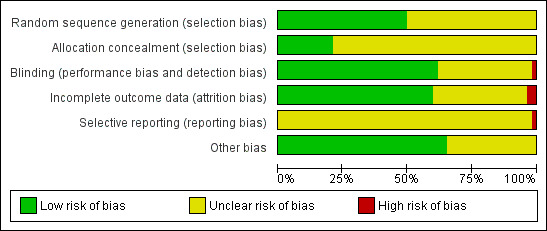
'Risk of bias' graph: review authors' judgements about each risk of bias item presented as percentages across all included studies.
Allocation
Random sequence generation was judged to be of low risk of bias in 26 studies, with 26 studies being judged of unclear risk. Allocation concealment was judged to be of low risk of bias in 11 studies and of unclear risk in 41 studies. There were 10 studies where both sequence generation and allocation concealment were judged to be of low risk (Abouleish 1999; Charuluxananan 2003; Cherian 2001; Chestnut 1987; Manullang 2000; Mukherjee 2006; Peixoto 2006; Phillips 2007; Stein 1997; Tarhan 2007).
Blinding
Blinding was assessed as of low risk of bias in 32 studies and of unclear bias in 19 studies. Blinding was considered at high risk of bias in one study (Rudra 2004a) because the treating anaesthetist was not blinded to the study drug.
Incomplete outcome data
Incomplete outcome data were addressed adequately and so at low risk of bias in 31 studies. In 19 studies, it was judged to be of unclear bias, and at high risk of bias in two studies (Duman 2010; Phillips 2007). In these two studies, data on women had been excluded and we were unable to be re‐include on an intention‐to‐treat basis.
Selective reporting
As we did not assess study protocols, all the studies were judged to be unclear in regards to selective reporting bias, with the exception of one study which clearly showed high risk of bias (Shahriari 2009). This study did not report the pre‐specified outcome of sedation, when this was likely to be an important side effect of the intervention.
Other potential sources of bias
Thirty‐four studies were judged to be free of other potential sources of bias, with 18 being unclear.
Effects of interventions
A. 5‐HT3 receptor antagonists (Comparisons 1, 2, 3)
1) 5‐HT3 receptor antagonists (A) versus placebo (10 studies, 980 women, Comparison 1)
Thirteen studies assessed this comparison with 10 providing data on outcomes (Abouleish 1999; Charuluxananan 2003; Cherian 2001; Harnett 2007; Kasodekar 2006; Pan 1996; Pan 2001; Pan 2003; Peixoto 2006, Sahoo 2012). Three studies provided no data which could be included in our analyses (Boone 2002; Munnur 2008; Yazigi 2002). Of the studies that provided data, nine studied ondansetron (4 mg or 8 mg) (Abouleish 1999; Charuluxananan 2003; Cherian 2001; Harnett 2007; Pan 1996; Pan 2001; Pan 2003; Peixoto 2006, Sahoo 2012) and one examined granisetron (1 mg) (Kasodekar 2006). Of the 10 studies providing data, only three were judged to have had both adequate sequence generation and allocation concealment (Abouleish 1999; Charuluxananan 2003; Cherian 2001), and seven were considered to have adequate blinding (and the remainder being unclear) seeFigure 1 and Figure 2 .
Primary outcomes
Intraoperative nausea
We found that overall, 5‐HT3 antagonists were more effective than placebo at reducing intraoperative nausea (average risk ratio (RR) 0.64, 95% confidence interval (CI) 0.46 to 0.88, eight studies, 720 women, random‐effects [T² = 0.10, Chi² P = 0.02, I² = 57%], Analysis 1.1). but there was substantial heterogeneity (I² = 57%). In a subgroup analysis by type of drug and dose, there was no evidence of differences in treatment effect between the subgroups (Chi² = 3.79 , P = 0.15, I² = 47.2%). The ondansetron 4 mg subgroup was the only one to show a statistically significant effect, likely because this subgroup contained the most trials.
1.1. Analysis.
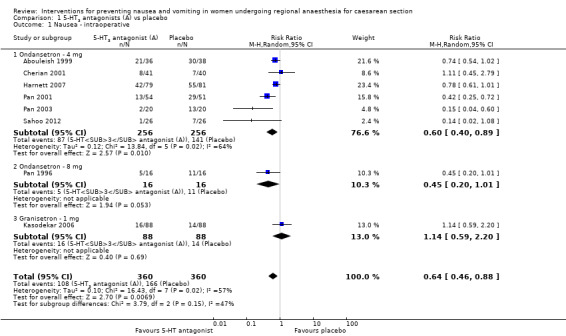
Comparison 1 5‐HT3 antagonists (A) vs placebo, Outcome 1 Nausea ‐ intraoperative.
Intraoperative vomiting
For the outcome of intraoperative vomiting, we were unable to demonstrate a significant difference compared with placebo with 5‐HT3 antagonists (average RR 0.56, 95% CI 0.31 to 1.00, seven studies, 668 women, random‐effects [T² = 0.33, Chi² P = 0.02 , I² = 61%], Analysis 1.2) but again, there was substantial heterogeneity (I² = 61%). In the subgroup analysis by type and dose of drug, there was no evidence of differences in treatment effect between the subgroups (Chi² = 1.94, P = 0.38, I² = 0%).
1.2. Analysis.
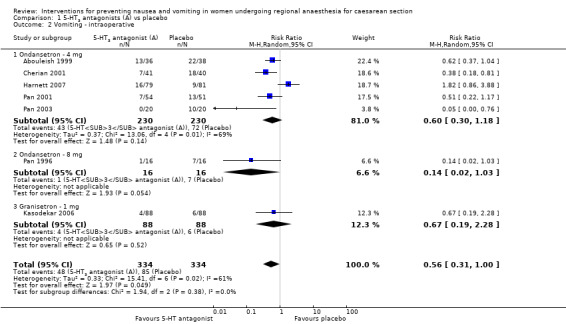
Comparison 1 5‐HT3 antagonists (A) vs placebo, Outcome 2 Vomiting ‐ intraoperative.
Postoperative nausea
There was a reduction in postoperative nausea using 5‐HT3 antagonists versus placebo (average RR 0.40, 95% CI 0.25 to 0.64, four studies, 405 women, random‐effects [T² = 0.08, Chi² P = 0.24, I² = 27%], Analysis 1.3) but again there was significant heterogeneity (I² = 27%).
1.3. Analysis.
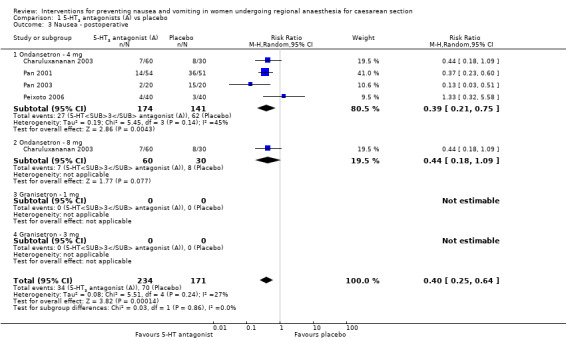
Comparison 1 5‐HT3 antagonists (A) vs placebo, Outcome 3 Nausea ‐ postoperative.
Postoperative vomiting
Postoperative vomiting was also reduced (average RR 0.50, 95% CI 0.32 to 0.77, five studies, 565 women, random‐effects [T² = 0.07, Chi² P = 0.27, I² = 21%], Analysis 1.4). Significant heterogeneity was observed (I² = 21%).
1.4. Analysis.
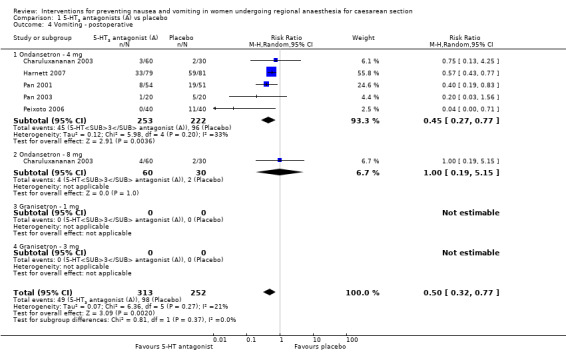
Comparison 1 5‐HT3 antagonists (A) vs placebo, Outcome 4 Vomiting ‐ postoperative.
Secondary outcomes
We identified two differing results in women's satisfaction between 5‐HT3 receptor antagonist drugs and placebo. One study showed a benefit from the ondansetron and the other showed no difference (Analysis 1.9).
1.9. Analysis.

Comparison 1 5‐HT3 antagonists (A) vs placebo, Outcome 9 Maternal satisfaction.
Outcomes not pre‐specified
Although there were no estimates of a composite outcome of adverse effects, a few studies did measure headaches/dizziness. hypotension and pruritis but there were insufficient data to make a statement about adverse effects (seeAnalysis 1.10 to Analysis 1.12).
1.10. Analysis.
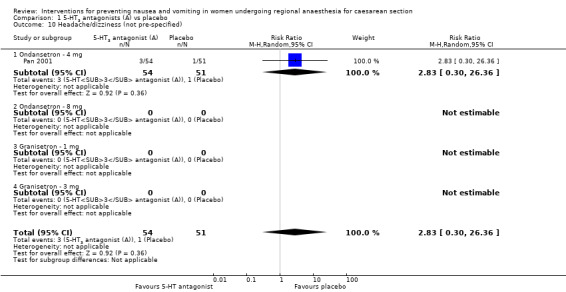
Comparison 1 5‐HT3 antagonists (A) vs placebo, Outcome 10 Headache/dizziness (not pre‐specified).
1.12. Analysis.
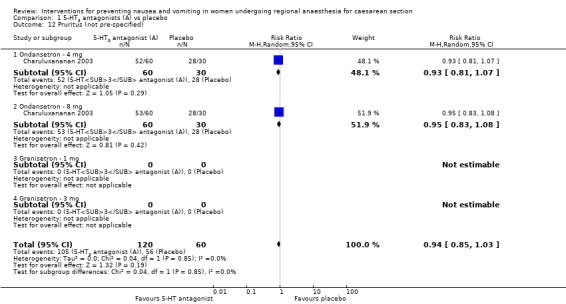
Comparison 1 5‐HT3 antagonists (A) vs placebo, Outcome 12 Pruritus (not pre‐specified).
2) 5‐HT3 antagonists (A) versus other 5 HT3 antagonists (A) (no studies, Comparison 2)
There was only one study comparing two different 5‐HT3 receptor antagonists, ondansetron versus granisetron, but we were unable to use the data as the authors reported a composite outcome (Munnur 2008). We have written to the authors for further information.
3) 5‐HT3 antagonist (A) ‐ ondansetron 8 mg versus 4 mg (one study, 120 women, Comparison 3)
There was only one study comparing differing doses of 5‐HT3 antagonists (Charuluxananan 2003). This study reported the outcomes of postoperative nausea, postoperative vomiting and pruritis. We did not identify any differences between the groups (seeAnalysis 3.3, Analysis 3.4 and Analysis 3.10).
3.3. Analysis.

Comparison 3 5‐HT3 antagonists (A) ‐ Ondansetron 8mg vs 4mg, Outcome 3 Nausea ‐ postoperative.
3.4. Analysis.

Comparison 3 5‐HT3 antagonists (A) ‐ Ondansetron 8mg vs 4mg, Outcome 4 Vomiting ‐ postoperative.
3.10. Analysis.

Comparison 3 5‐HT3 antagonists (A) ‐ Ondansetron 8mg vs 4mg, Outcome 10 Pruritus (not pre‐specified).
B. Dopamine antagonists (Comparisons 4‐6)
1) Dopamine antagonists (B) versus placebo (12 studies, 899 women, Comparison 4)
Fifteen studies compared dopamine antagonists with placebo, of which 12 studies provided data for analysis (Biswas 2003; Chestnut 1987; Duman 2010; Huang 1992; Lussos 1992; Mandell 1992; Pan 1996; Pan 2001; Peixoto 2006; Stein 1997; Tzeng 2000; Wu 2007). Three studies provided no data which could be included in our analyses (Birnbach 1993; Imbeloni 1986; Sanansilp 1998). Of the studies providing data, seven studied metoclopramide (10 mg, 20 mg, 0.15 mg/kg) (Biswas 2003; Chestnut 1987; Duman 2010; Huang 1992; Lussos 1992; Pan 2001; Stein 1997) and five examined droperidol (0.5 mg, 0.625 mg, or 1.25 mg) (Mandell 1992; Pan 1996; Peixoto 2006; Tzeng 2000; Wu 2007).
Overall, the studies were of uncertain quality. Of the 14 studies which provided data, only three were judged to have had both adequate sequence generation and allocation concealment (Chestnut 1987; Peixoto 2006; Stein 1997). Nine were judged to have had adequate blinding with the remaining being unclear (Figure 1).
Primary outcomes
Dopamine antagonists were found to be more effective than placebo at reducing intraoperative nausea (average RR 0.38, 95% CI 0.25 to 0.57, nine studies, 636 women, random‐effects [T² = 0.19, Chi² P = 0.04, I² = 51%], Analysis 4.1), and intraoperative vomiting (RR 0.39, 95% CI 0.24 to 0.64, eight studies, 536 women, random‐effects, T² = 0.00, Chi² P = 0.64, I² = 0%, Analysis 4.2). Dopamine antagonists were found to be more effective than placebo at reducing postoperative nausea (average RR 0.60, 95% CI 0.40 to 0.91, five studies, 412 women, random‐effects T² = 0.08, Chi² P = 0.17, I² = 37%, Analysis 4.3), and postoperative vomiting (average RR 0.57, 95% CI 0.36 to 0.91, six studies, 472 women, random‐effects [T² = 0.13, Chi² P = 0.14, I² = 40%], Analysis 4.4). These findings were persistent when the individual interventions of metoclopramide and droperidol were assessed separately.
4.1. Analysis.
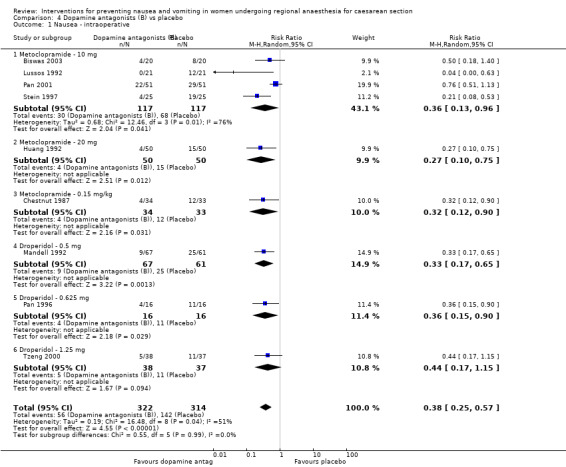
Comparison 4 Dopamine antagonists (B) vs placebo, Outcome 1 Nausea ‐ intraoperative.
4.2. Analysis.
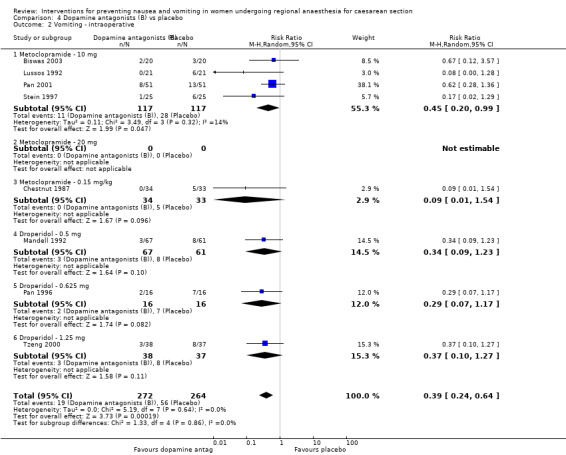
Comparison 4 Dopamine antagonists (B) vs placebo, Outcome 2 Vomiting ‐ intraoperative.
4.3. Analysis.
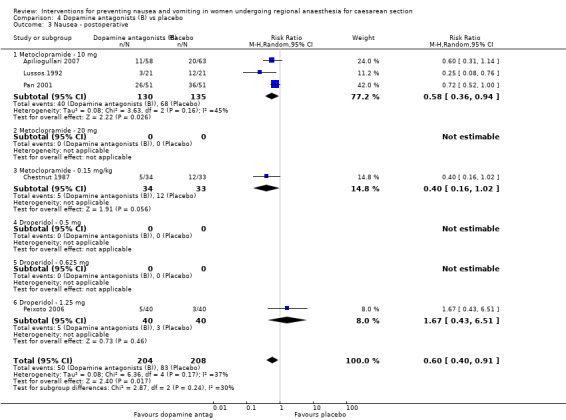
Comparison 4 Dopamine antagonists (B) vs placebo, Outcome 3 Nausea ‐ postoperative.
4.4. Analysis.
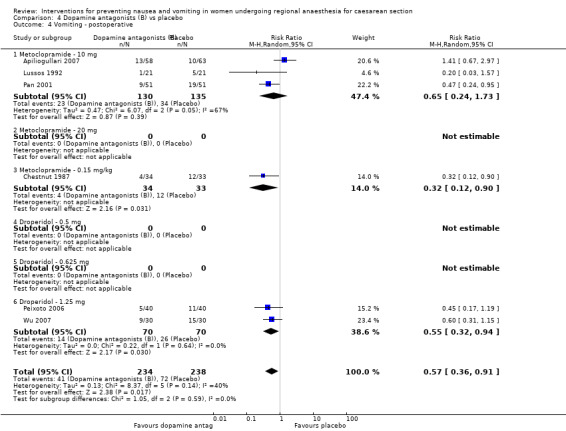
Comparison 4 Dopamine antagonists (B) vs placebo, Outcome 4 Vomiting ‐ postoperative.
Secondary outcomes
We identified no overall difference in women's satisfaction between dopamine antagonists and placebo (RR 1.42, 95% CI 0.91 to 2.21, one study, 102 women, Analysis 4.9). None of the studies looked at a composite outcome of adverse effects.
4.9. Analysis.
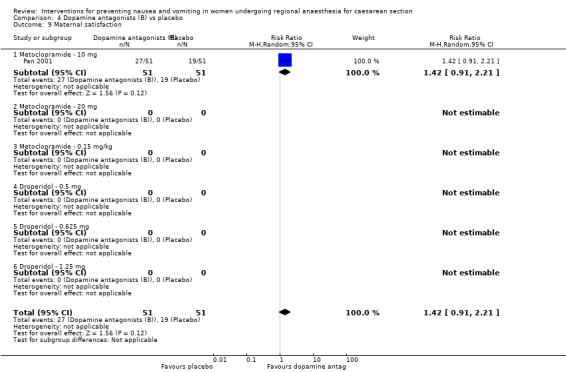
Comparison 4 Dopamine antagonists (B) vs placebo, Outcome 9 Maternal satisfaction.
Outcomes not pre‐specified
Although there were no estimates of a composite outcome of adverse effects, a few studies did measure anxiety, headaches/dizziness, hypotension and pruritus. There were no differences identified (Analysis 4.10; Analysis 4.11; Analysis 4.12; Analysis 4.13).
4.10. Analysis.
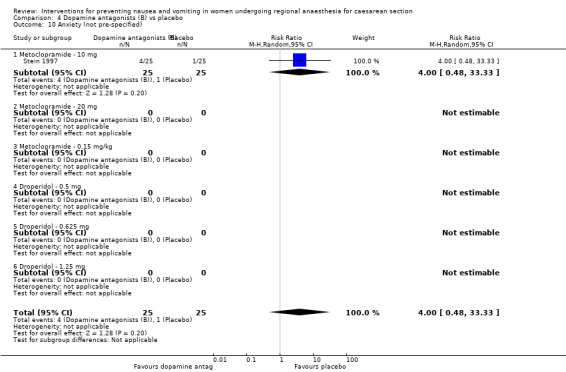
Comparison 4 Dopamine antagonists (B) vs placebo, Outcome 10 Anxiety (not pre‐specified).
4.11. Analysis.
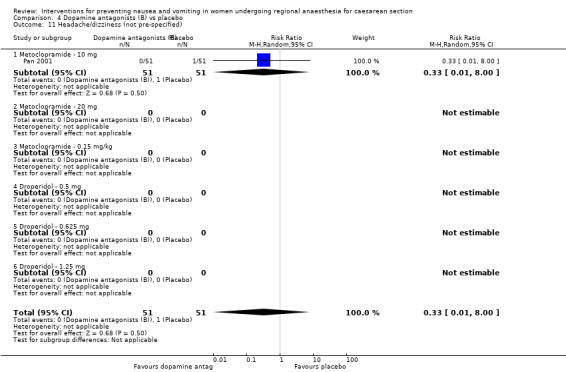
Comparison 4 Dopamine antagonists (B) vs placebo, Outcome 11 Headache/dizziness (not pre‐specified).
4.12. Analysis.
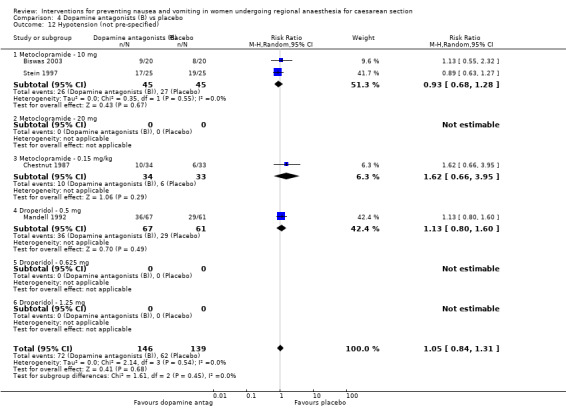
Comparison 4 Dopamine antagonists (B) vs placebo, Outcome 12 Hypotension (not pre‐specified).
4.13. Analysis.
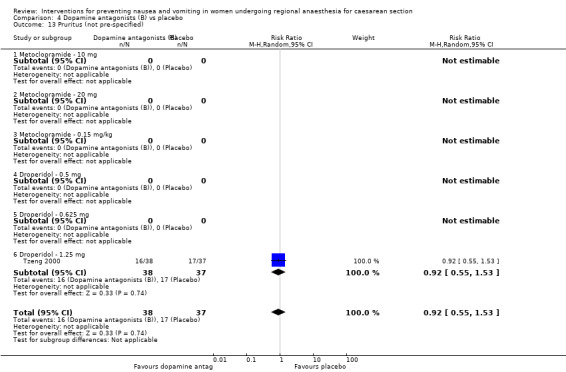
Comparison 4 Dopamine antagonists (B) vs placebo, Outcome 13 Pruritus (not pre‐specified).
Subgroup analyses
For variations between individual drugs, seeAnalysis 4.1 to Analysis 4.5.
2) Dopamine antagonists (B) versus 5‐HT3 antagonists (A) (four studies, 307 women, Comparison 5)
Four studies assessed and provided data on this comparison and involved 307 women (Owczarzak 1997; Pan 1996; Pan 2001; Peixoto 2006). The studies compared various doses of metoclopramide and droperidol, both dopamine antagonists, against various doses of ondansetron and granisetron, both 5‐HT3 antagonists. Overall, the studies were of uncertain quality. Only one study was judged to have adequate sequence generation and allocation concealment (Peixoto 2006). Blinding was judged as adequate for all four studies.
We found an increase in postoperative nausea with dopamine antagonists compared with 5‐HT3 antagonists (RR 1.84, 95% CI 1.13 to 2.98, two studies, 185 women, Analysis 5.3). We did not detect any other significant differences (Analysis 5.1, Analysis 5.2, Analysis 5.4).
5.3. Analysis.
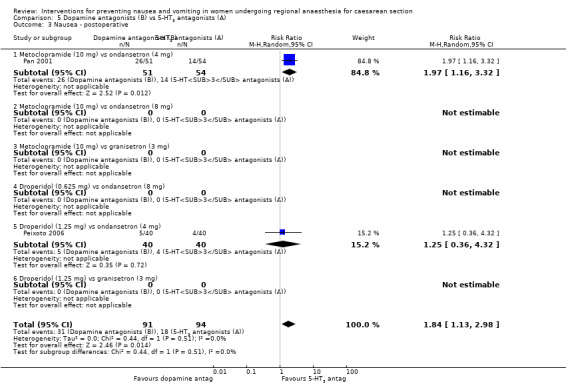
Comparison 5 Dopamine antagonists (B) vs 5‐HT3 antagonists (A), Outcome 3 Nausea ‐ postoperative.
5.1. Analysis.
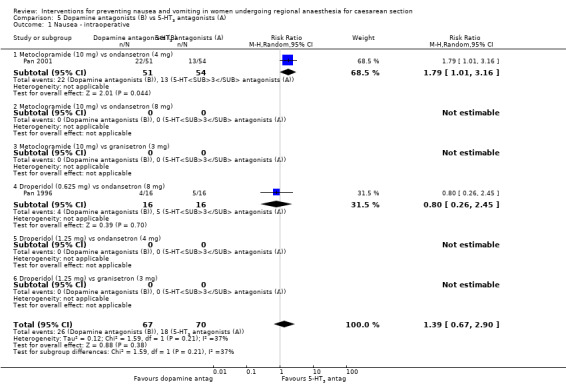
Comparison 5 Dopamine antagonists (B) vs 5‐HT3 antagonists (A), Outcome 1 Nausea ‐ intraoperative.
5.2. Analysis.
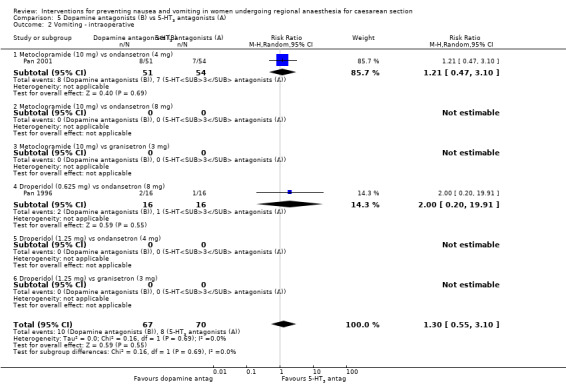
Comparison 5 Dopamine antagonists (B) vs 5‐HT3 antagonists (A), Outcome 2 Vomiting ‐ intraoperative.
5.4. Analysis.
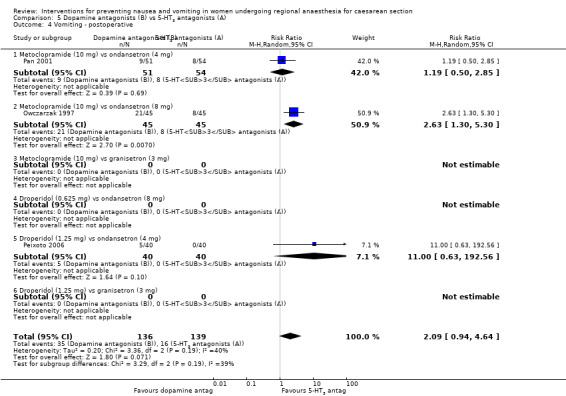
Comparison 5 Dopamine antagonists (B) vs 5‐HT3 antagonists (A), Outcome 4 Vomiting ‐ postoperative.
3) Dopamine antagonists (B) versus other dopamine antagonists (B) (one study, 81 women, Comparison 6)
One study involving 81 women assessed this comparison and provided data for analysis (Chestnut 1989). The study was judged to have adequate sequence generation and adequate blinding. We did not find any significant differences between the different dopamine antagonists for our outcomes (Analysis 6.1 to Analysis 6.4 and Analysis 6.10).
6.1. Analysis.
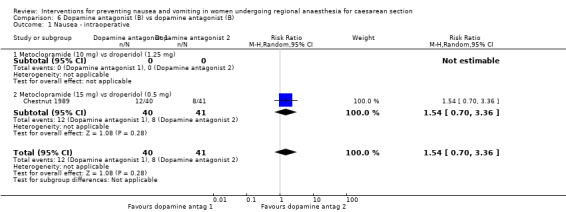
Comparison 6 Dopamine antagonist (B) vs dopamine antagonist (B), Outcome 1 Nausea ‐ intraoperative.
6.4. Analysis.
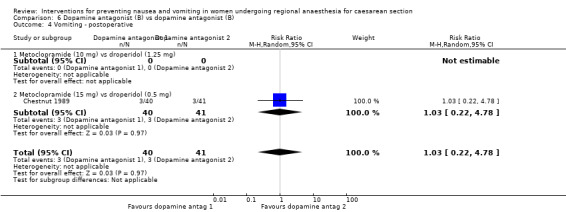
Comparison 6 Dopamine antagonist (B) vs dopamine antagonist (B), Outcome 4 Vomiting ‐ postoperative.
6.10. Analysis.
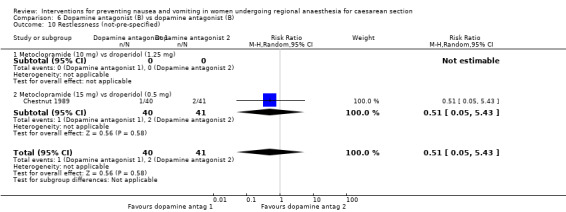
Comparison 6 Dopamine antagonist (B) vs dopamine antagonist (B), Outcome 10 Restlessness (not‐pre‐specified).
C. Corticosteroids (Comparisons 7‐14)
1) Corticosteroids (C) versus placebo (six studies, 490 women, Comparison 7)
Six studies involving 490 women compared corticosteroids against placebo, all studied dexamethasone but in various doses from 2.5 mg to 10 mg (Biswas 2003; Jaafarpour 2008; Nortcliffe 2003; Tzeng 2000; Wang 2001; Wu 2007). Three of the studies addressed intraoperative symptoms (Biswas 2003; Jaafarpour 2008; Tzeng 2000), and three assessed postoperative symptoms (Nortcliffe 2003; Wang 2001; Wu 2007). The studies were of questionable quality with none judged as having adequate sequence generation and allocation concealment. Three had adequate blinding (Tzeng 2000; Wang 2001; Wu 2007). One study (Abdel‐Aleem 2012) is in Studies awaiting classification because the authors excluded women after randomisation if they suffered intraoperative nausea or vomiting and this amounted to 31%. We will write to the authors in an attempt to obtain these data for re‐inclusion.
Primary outcomes
The three studies assessing intraoperative symptoms found a reduction in nausea (average RR 0.31, 95% CI 0.15 to 0.64, three studies, 195 women, random‐effects [T² = 0.00, Chi² P = 0.92, I² = 0%], Analysis 7.1) and vomiting (RR 0.35, 95% CI 0.14 to 0.86, three studies,195 women, random‐effects [T² = 0.00, Chi² P = 0.44, I² = 0%], Analysis 7.2). The studies assessing postoperative symptoms showed no reduction in nausea (average RR 0.75, 95% CI 0.52 to 1.07, two studies, 235 women, random‐effects [T² = 0.01, Chi² P = 0.37, I² = 4%], Analysis 7.3) or vomiting (average RR 0.78, 95% CI 0.54 to 1.12, three studies, 295 women, random‐effects [T² = 0.03, Chi² P = 0.33, I² = 14%], Analysis 7.4).
7.1. Analysis.
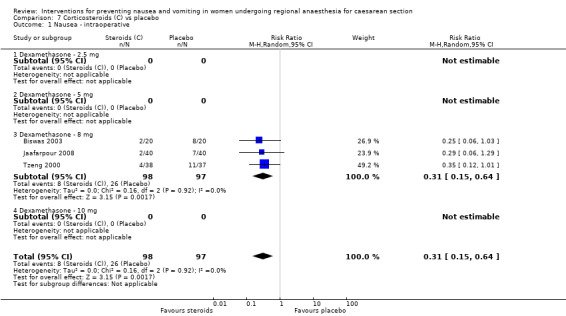
Comparison 7 Corticosteroids (C) vs placebo, Outcome 1 Nausea ‐ intraoperative.
7.2. Analysis.
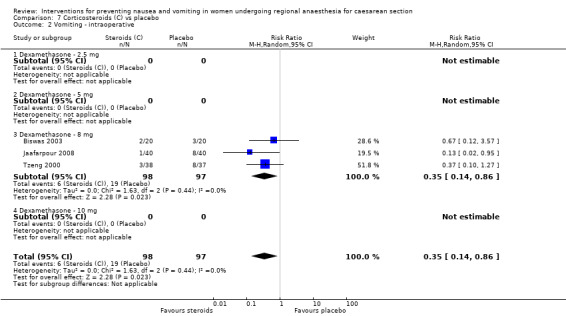
Comparison 7 Corticosteroids (C) vs placebo, Outcome 2 Vomiting ‐ intraoperative.
7.3. Analysis.
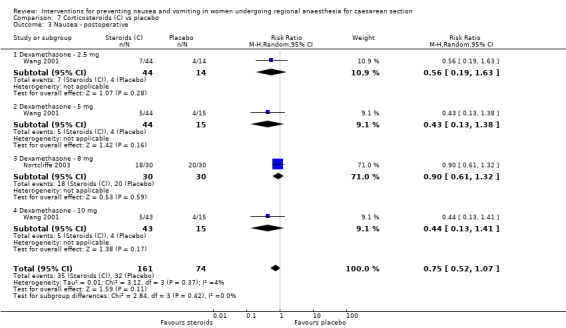
Comparison 7 Corticosteroids (C) vs placebo, Outcome 3 Nausea ‐ postoperative.
7.4. Analysis.
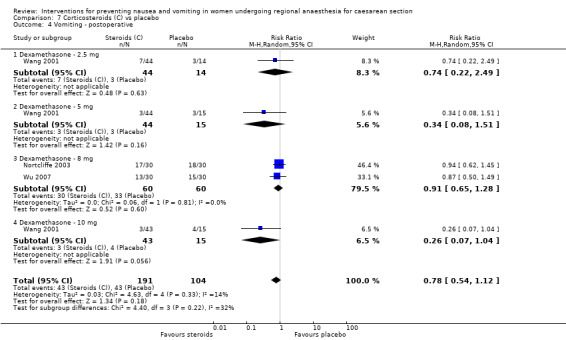
Comparison 7 Corticosteroids (C) vs placebo, Outcome 4 Vomiting ‐ postoperative.
Secondary outcomes
No data reported.
Outcomes not pre‐specified
Although there were no estimates of a composite outcome of adverse effects, a few studies did measure hypotension and pruritis but there were insufficient data to make any firm statement about adverse effects (Analysis 7.10; Analysis 7.11).
7.10. Analysis.
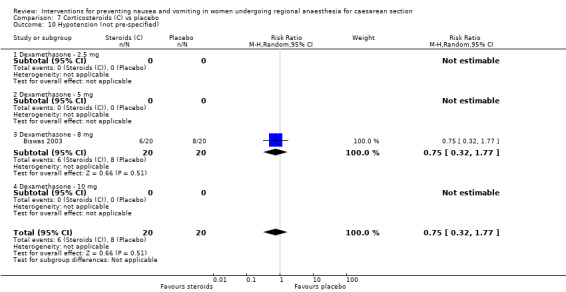
Comparison 7 Corticosteroids (C) vs placebo, Outcome 10 Hypotension (not pre‐specified).
7.11. Analysis.
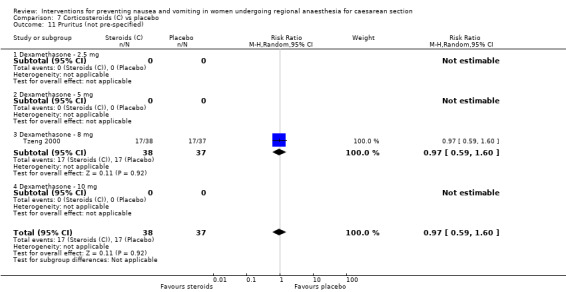
Comparison 7 Corticosteroids (C) vs placebo, Outcome 11 Pruritus (not pre‐specified).
2) Corticosteroids (C) versus 5‐HT3 antagonists (A) (no studies, Comparison 8)
There were no studies that made this comparison.
3) Corticosteroids (C) versus dopamine antagonists (B) (three studies, 176 women, Comparison 9)
There were three studies involving 176 women that assessed this comparison (Biswas 2003; Tzeng 2000; Wu 2007). Two studies had adequate sequence generation and blinding (Tzeng 2000; Wu 2007) but all were unclear with regard to allocation concealment. We did not detect any significant differences between corticosteroids and 5 HT3 antagonists (Analysis 9.1 to Analysis 9.11).
9.1. Analysis.
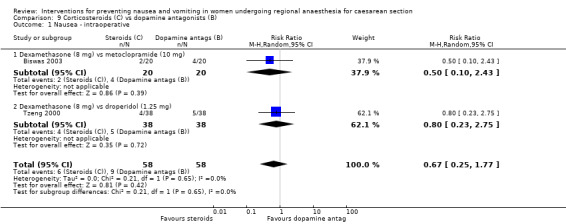
Comparison 9 Corticosteroids (C) vs dopamine antagonists (B), Outcome 1 Nausea ‐ intraoperative.
9.11. Analysis.
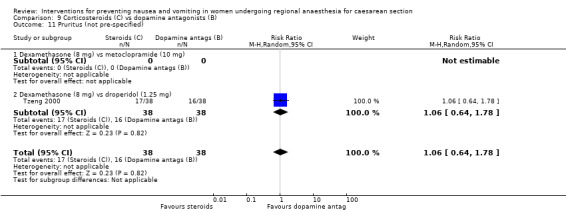
Comparison 9 Corticosteroids (C) vs dopamine antagonists (B), Outcome 11 Pruritus (not pre‐specified).
4) Corticosteroids (C) versus other steroids (C) (no studies, Comparison 10)
There were no studies that made this comparison.
5) Corticosteroid (C) ‐ dexamethasone 2.5 mg versus 5 mg (one study, 88 women, Comparison 11)
One study (Wang 2001) involving 88 women studied this comparison. The outcomes of postoperative nausea and postoperative vomiting were reported, however, there were no differences detected between the groups (Analysis 11.3; Analysis 11.4).
11.3. Analysis.

Comparison 11 Corticosteroids (C) ‐ Dexamethasone 2.5 mg vs 5 mg, Outcome 3 Nausea ‐ postoperative.
11.4. Analysis.

Comparison 11 Corticosteroids (C) ‐ Dexamethasone 2.5 mg vs 5 mg, Outcome 4 Vomiting ‐ postoperative.
6) Corticosteroid (C) ‐ dexamethasone 2.5 mg versus 10 mg (one study, 87 women, Comparison 12)
One study (Wang 2001) involving 87 women studied this comparison. The outcomes of postoperative nausea and postoperative vomiting were reported. However, there no differences detected between the groups (Analysis 12.3; Analysis 12.4).
12.3. Analysis.

Comparison 12 Corticosteroids (C) ‐ Dexamethasone 2.5 mg vs 10 mg, Outcome 3 Nausea ‐ postoperative.
12.4. Analysis.

Comparison 12 Corticosteroids (C) ‐ Dexamethasone 2.5 mg vs 10 mg, Outcome 4 Vomiting ‐ postoperative.
7) Corticosteroid (C) ‐ dexamethasone 5 mg versus 10 mg (one study, 88 women, Comparison 13)
One study (Wang 2001) involving 88 women studied this comparison. The outcomes of postoperative nausea and vomiting were reported. However, we did not detect any differences between the groups (Analysis 13.3; Analysis 13.4).
13.3. Analysis.

Comparison 13 Corticosteroids (C) ‐ Dexamethasone 5 mg vs 10 mg, Outcome 3 Nausea ‐ postoperative.
13.4. Analysis.

Comparison 13 Corticosteroids (C) ‐ Dexamethasone 5 mg vs 10 mg, Outcome 4 Vomiting ‐ postoperative.
D. Antihistamines (Comparisons 14‐19)
1) Antihistamines (D) versus placebo (three studies, 365 women, Comparison 14)
Three studies compared the intervention of antihistamines with placebo (Apiliogullari 2007; Duman 2010; Nortcliffe 2003). Only one study had adequate sequence generation (Duman 2010) and all three studies were unclear with regard to allocation concealment. Two out of three had adequate blinding (Apiliogullari 2007; Duman 2010).
Primary outcomes
We found a reduction in postoperative nausea compared with placebo (average RR 0.39, 95% CI 0.26 to 0.59, three studies, 365 women, random‐effects [T² = 0.01, Chi² P = 0.37, I² = 4%], Analysis 14.3). We also found a reduction in postoperative vomiting (average RR 0.50, 95% CI 0.30 to 0.86, two studies, 184 women, random‐effects [T² = 0.00, Chi² P = 0.96, I² = 0%], Analysis 14.4). Intraoperative symptoms were not assessed by any of the three studies.
14.3. Analysis.
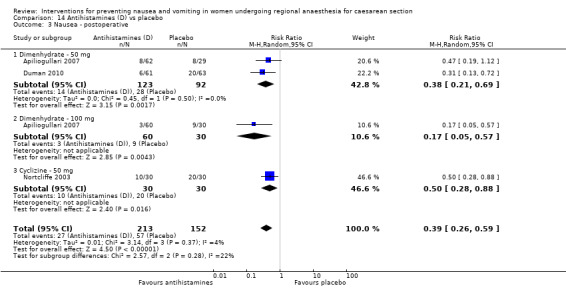
Comparison 14 Antihistamines (D) vs placebo, Outcome 3 Nausea ‐ postoperative.
14.4. Analysis.
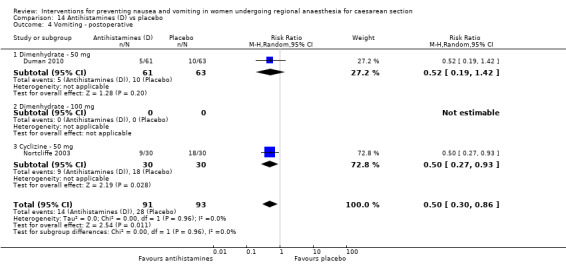
Comparison 14 Antihistamines (D) vs placebo, Outcome 4 Vomiting ‐ postoperative.
Secondary outcomes
Not assessed in the trials.
2) Antihistamines (D) versus 5 HT3 antagonists (A) (no studies, Comparison 15)
There were no studies that made this comparison.
3) Antihistamines (D) versus dopamine antagonists (B) (one study, 119 women, Comparison 16)
One study assessed this comparison (Duman 2010). Although the study had adequate sequence generation, it was unclear if there was adequate allocation concealment or blinding. Also there were potentially significant missing data.
Primary outcomes
No differenced was identified in postoperative nausea (RR 0.52, 95% CI 0.21 to 1.31, one study, 119 women, Analysis 16.3) but there was a reduction in postoperative vomiting (RR 0.37, 95% CI 0.14 to 0.96, one study, 119 women, Analysis 16.4).
16.3. Analysis.

Comparison 16 Antihistamines (D) vs dopamine antagonists (B), Outcome 3 Nausea ‐ postoperative.
16.4. Analysis.

Comparison 16 Antihistamines (D) vs dopamine antagonists (B), Outcome 4 Vomiting ‐ postoperative.
Secondary outcomes
None were assessed in this study.
4) Antihistamines (D) versus corticosteroids (C) (one study, 60 women, Comparison 17)
There was one study involving 60 women that assessed this comparison (Nortcliffe 2003). Sequence generation and allocation concealment were unclear. We did not detect a reduction in postoperative nausea (Analysis 17.3), however, a possible reduction in postoperative vomiting was detected (RR 0.53, 95% CI 0.28 to 0.99, one study, 60 women, Analysis 17.4).
17.3. Analysis.

Comparison 17 Antihistamines (D) vs corticosteroids (C), Outcome 3 Nausea ‐ postoperative.
17.4. Analysis.

Comparison 17 Antihistamines (D) vs corticosteroids (C), Outcome 4 Vomiting ‐ postoperative.
5) Antihistamines (D) versus other antihistamines (D) (no studies, Comparison 18)
There were no studies that made this comparison.
6) Antihistamone (D) ‐ demethylate 50 mg versus 100 mg (one study, 122 women, Comparison 19)
One study (Apiliogullari 2007) involving 122 participants studied this comparison. The outcome of postoperative nausea was reported. However, no significant difference was detected (Analysis 19.3).
19.3. Analysis.

Comparison 19 Antihistamines (D) ‐ Dimenhydrate 100 mg vs 50 mg, Outcome 3 Nausea ‐ postoperative.
E. Anticholinergics (Comparisons 20‐25)
1) Anticholenergics (E) versus placebo (four studies, 453 women, Comparison 20)
Five studies compared the intervention of anticholinergics with placebo with four of these studies (involving 453 women) reporting data that we could use in the review (Biswas 2003; Harnett 2007; Kotelko 1989; Ure 1999). One study provided no data (Quiney 1995) as it presented a combined outcome for nausea and vomiting. One study had adequate sequence generation (Harnett 2007) and the other three were unclear. All four studies were unclear with regard to allocation concealment. Two studies described adequate blinding (Harnett 2007; Kotelko 1989).
Primary outcomes
We found a significant reduction in intraoperative nausea with anticholinergics (average RR 0.67, 95% CI 0.51 to 0.87, four studies, 453 women, random‐effects [T² = 0.03, Chi² P = 0.13, I² = 47%], Analysis 20.1) but we identified no difference in intraoperative vomiting (average RR 0.79, 95% CI 0.40 to 1.54, four studies, 453 women, random‐effects [T² = 0.22, Chi² P = 0.10, I² = 52%], Analysis 20.2). These findings were persistent in the scopolamine subgroup, but not the glycopyrrolate subgroup, however, there were much smaller numbers in the glycopyrrolate subgroup. None of the studies assessed postoperative nausea, however, there was a reduction in postoperative vomiting (RR 0.55, 95% CI 0.41 to 0.74, one study, 161 women, (Analysis 20.4).
20.1. Analysis.
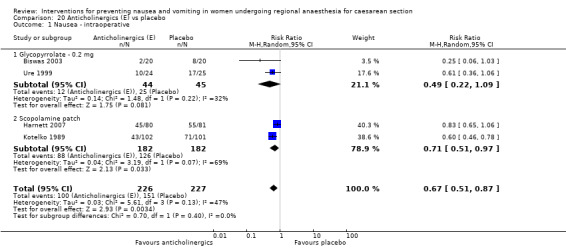
Comparison 20 Anticholinergics (E) vs placebo, Outcome 1 Nausea ‐ intraoperative.
20.2. Analysis.
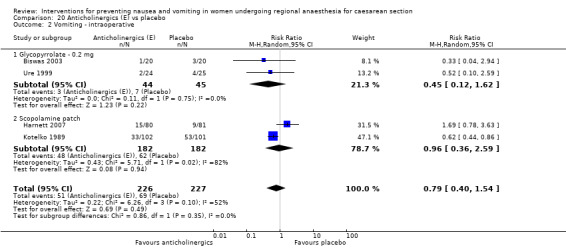
Comparison 20 Anticholinergics (E) vs placebo, Outcome 2 Vomiting ‐ intraoperative.
20.4. Analysis.
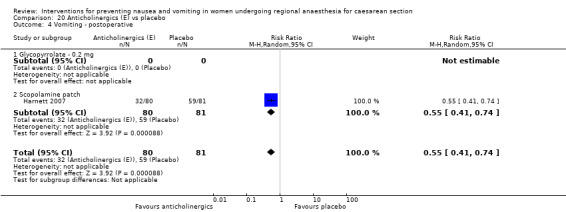
Comparison 20 Anticholinergics (E) vs placebo, Outcome 4 Vomiting ‐ postoperative.
Secondary outcomes
None of the studies assessed any of our secondary outcomes.
Outcomes not pre‐specified
Some studies did assess specific adverse effects, but there are insufficient data to be able to report specifically (Analysis 20.10 to Analysis 20.14).
20.10. Analysis.
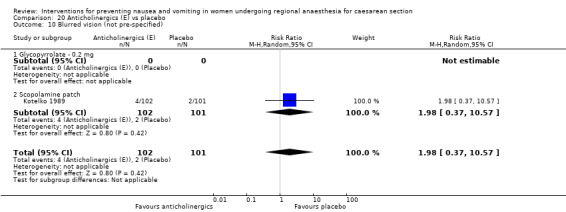
Comparison 20 Anticholinergics (E) vs placebo, Outcome 10 Blurred vision (not pre‐specified).
20.14. Analysis.
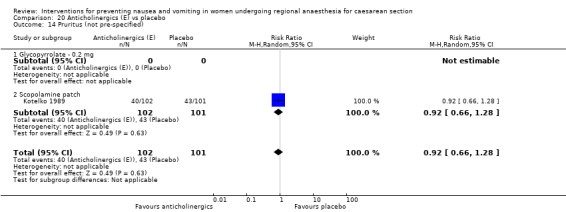
Comparison 20 Anticholinergics (E) vs placebo, Outcome 14 Pruritus (not pre‐specified).
2) Anticholenergics (E) versus 5‐HT3 antagonists (A) (one study, 159 women, Comparison 21)
One study involving 159 women assessed this comparison (Harnett 2007). The study was judged to have adequate sequence generation and blinding but it was unclear when assessed on allocation concealment. No differences were detected between anticholinergics and 5‐HT3 antagonists (Analysis 21.1 to Analysis 21.9).
21.1. Analysis.

Comparison 21 Anticholinergic (E) vs 5‐HT3 antagonist (A), Outcome 1 Nausea ‐ intraoperative.
3) Anticholenergics (E) versus dopamine antagonists (B) (one study, 40 women, Comparison 22)
Two studies involving 80 women assessed this comparison (Biswas 2003; Biwas 2002), however, we were unable to use the composite outcome data for one study (Biwas 2002). The study with included data (Biswas 2003) was unclear with regard to sequence generation, allocation concealment and blinding.
There were insufficient data to make adequate comparisons between anticholinergics and dopamine antagonists (Analysis 22.1 to Analysis 22.11 ).
22.1. Analysis.

Comparison 22 Anticholenergic (E) vs dopamine antagonist (B), Outcome 1 Nausea ‐ intraoperative.
22.11. Analysis.

Comparison 22 Anticholenergic (E) vs dopamine antagonist (B), Outcome 11 Hypotension (not pre‐specified).
4) Anticholenergics (E) versus corticosteroids (C) (one study, 40 women, Comparison 23)
One study involving 40 women assessed this comparison (Biswas 2003). The study was assessed as being unclear with regard to sequence generation, allocation concealment and blinding.
There were insufficient data to make adequate comparisons between anticholinergics and steroids (Analysis 23.1 to Analysis 23.10).
23.1. Analysis.

Comparison 23 Anticholenergic (E) vs corticosteroids (C), Outcome 1 Nausea ‐ intraoperative.
23.10. Analysis.

Comparison 23 Anticholenergic (E) vs corticosteroids (C), Outcome 10 Hypotension (not pre‐specified).
5) Anticholenergics (E) versus antihistamines (D) (no studies, Comparison 24)
There were no studies that made this comparison.
6) Anticholenergics (E) versus other anticholinergics (E) (no studies, Comparison 25)
There were no studies that made this comparison.
F. Sedatives (Comparisons 26‐35)
1) Sedatives (F) versus placebo (four studies, 285 women, Comparison 26)
Five studies assessed the intervention of sedatives versus placebo, with four providing data, and all assessed propofol but at differing doses (Caba 1997; Mukherjee 2006; Rudra 2004a; Tarhan 2007). One study also assessed midazolam (Tarhan 2007) and one study provided data in graphical form only (Weiss 1995). Two studies assessed intraoperative and post operative nausea and vomiting (Caba 1997; Tarhan 2007) and two studies assessed intraoperative nausea and vomiting only (Mukherjee 2006; Rudra 2004a). The studies were of reasonable quality with all five having adequate random sequence generation and two out of four having adequate allocation concealment. Three of the five studies had adequate blinding, with one study rated as inadequate (Rudra 2004a) because the treating anaesthetist was not blinded to the intervention and one study was unclear (Tarhan 2007).
Primary outcomes
We found a reduction in intraoperative nausea compared with placebo (average RR 0.71, 95% CI 0.52 to 0.96, four studies, 285 women, random‐effects [T² = 0.00, Chi² P = 0.56, I² = 0%], Analysis 26.1). These studies also found a reduction in intraoperative vomiting compared with placebo (average RR 0.42, 95% CI 0.26 to 0.68, four studies, 285 women, random‐effects [T² = 0.00, Chi² P = 0.77, I² = 0%], Analysis 26.2). Two studies found propofol reduced both postoperative nausea (average RR 0.25, 95% CI 0.09 to 0.71, two studies, 145 women, [T² = 0.47, Chi² P = 0.09, I² = 58%] Analysis 26.3) and vomiting (average RR 0.09, 95% CI 0.03 to 0.28, two studies, 145 women, [T² = 0.00, Chi² P = 0.39, I² = 0%], Analysis 26.4).
26.1. Analysis.
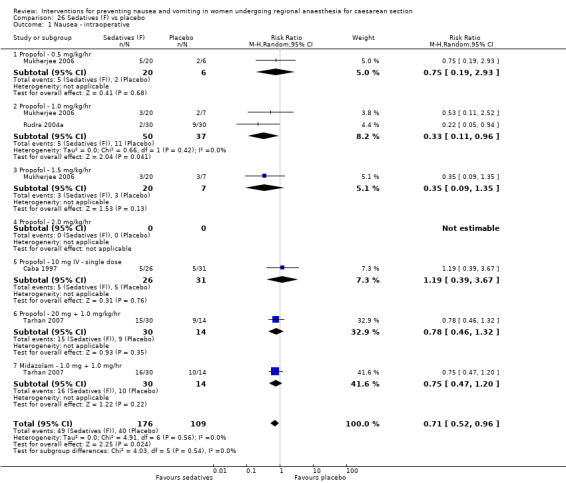
Comparison 26 Sedatives (F) vs placebo, Outcome 1 Nausea ‐ intraoperative.
26.2. Analysis.
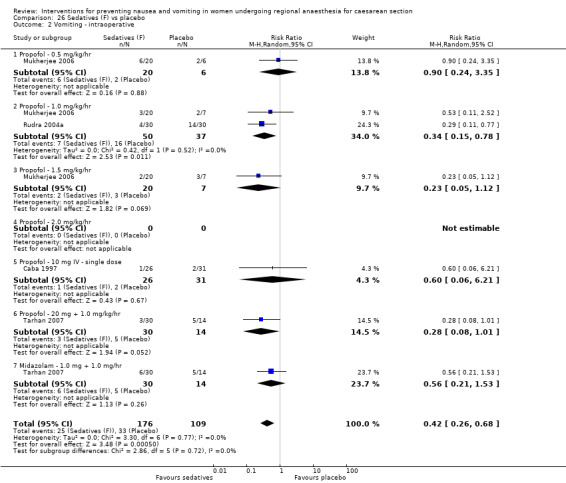
Comparison 26 Sedatives (F) vs placebo, Outcome 2 Vomiting ‐ intraoperative.
26.3. Analysis.
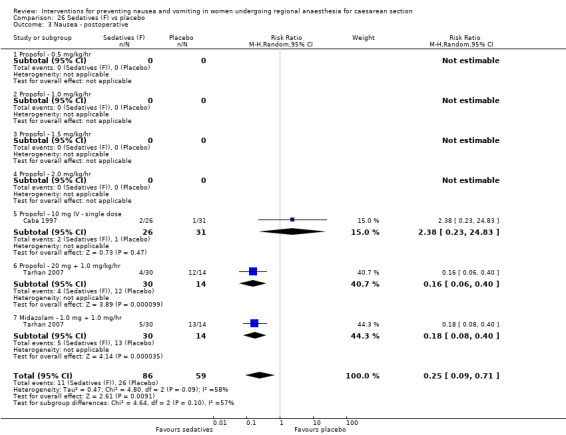
Comparison 26 Sedatives (F) vs placebo, Outcome 3 Nausea ‐ postoperative.
26.4. Analysis.
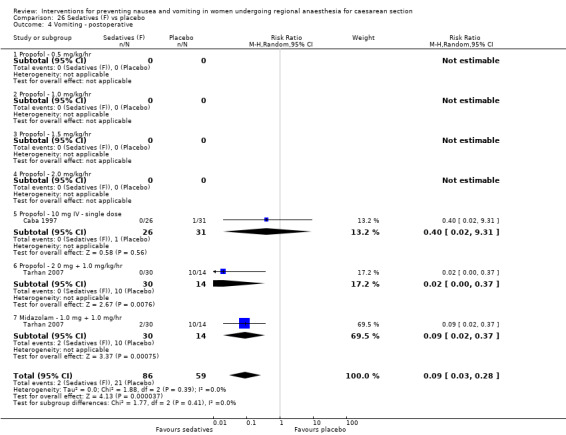
Comparison 26 Sedatives (F) vs placebo, Outcome 4 Vomiting ‐ postoperative.
Secondary outcomes
None of our secondary outcomes were assessed.
2. Sedatives (F) versus 5‐HT3 antagonists (A) (no studies, Comparison 27)
There were no studies that made this comparison.
3) Sedatives (F) versus dopamine antagonists (B) (one study, 80 women, Comparison 28)
One study involving 80 women assessed this comparison (Shahriari 2009). The study had adequate sequence generation but allocation concealment was unclear (Shahriari 2009).
Primary outcomes
We found a reduction in intraoperative nausea (average RR 0.29, 95% CI 0.13 to 0.63, one study, 80 women, Analysis 28.1) There was no difference detected in the incidence of intraoperative vomiting (Analysis 28.2).
28.1. Analysis.
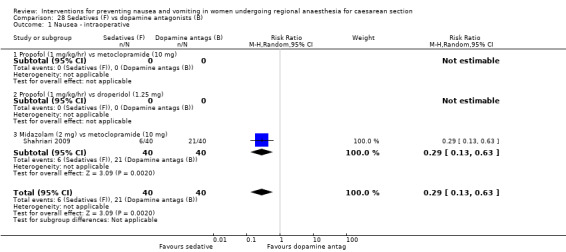
Comparison 28 Sedatives (F) vs dopamine antagonists (B), Outcome 1 Nausea ‐ intraoperative.
28.2. Analysis.
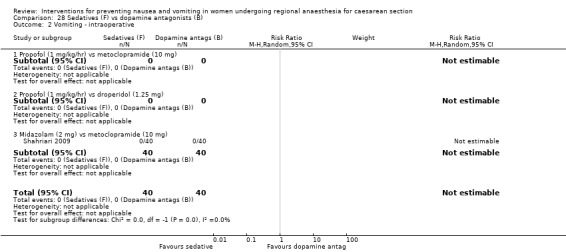
Comparison 28 Sedatives (F) vs dopamine antagonists (B), Outcome 2 Vomiting ‐ intraoperative.
Secondary outcomes
None of our secondary outcomes were assessed in the included trials.
Outcomes not pre‐specified.
The authors did assess some adverse outcomes. There were insufficient data to detect a difference in hypotension (Analysis 28.10), however, an increase in respiratory depression was reported (RR 35.0, 95% CI 2.18 ‐ 562.8, one study, 80 women, Analysis 28.11).
28.10. Analysis.
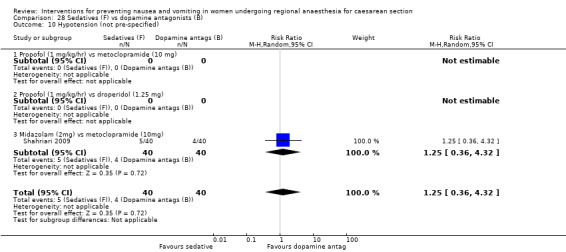
Comparison 28 Sedatives (F) vs dopamine antagonists (B), Outcome 10 Hypotension (not pre‐specified).
28.11. Analysis.
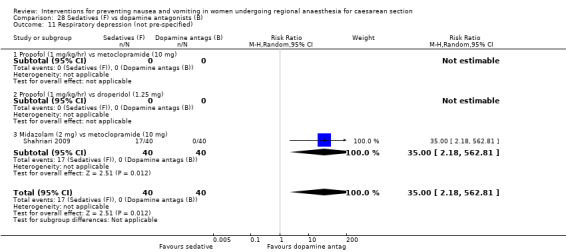
Comparison 28 Sedatives (F) vs dopamine antagonists (B), Outcome 11 Respiratory depression (not pre‐specified).
4) Sedatives (F) versus corticosteroids (C) (no studies, Comparison 29)
There were no studies that made this comparison.
5) Sedatives (F) versus antihistamines (D) (no studies, Comparison 30)
There were no studies that made this comparison.
6) Sedatives (F) versus anticholinergics (E) (no studies, Comparison 31)
There were no studies that made this comparison.
7) Sedatives (F) versus other sedatives (F) (one study, 60 women, Comparison 32)
One study involving 60 women assessed this comparison and compared midazolam versus propofol (Tarhan 2007). The study had adequate sequence generation, allocation concealment and blinding.
There were insufficient data to make adequate comparisons between different sedatives (Analysis 32.1 to Analysis 32.10).
32.1. Analysis.

Comparison 32 Sedative (F) vs sedative (F), Outcome 1 Nausea ‐ intraoperative.
8) Sedative (F) ‐ propofol 0.5 mg/kg/hr versus 1.0 mg/kg/hr (one study, 40 women, Comparison 33)
One study (Mukherjee 2006) involving 40 participants assessed this comparison. The authors reported intraoperative nausea and vomiting. There were insufficient data to make adequate comparisons (Analysis 33.1; Analysis 33.2).
33.1. Analysis.

Comparison 33 Sedatives (F) ‐ Propofol 0.5 mg/kg/hr vs 1 mg/kg/hr, Outcome 1 Nausea ‐ intraoperative.
33.2. Analysis.

Comparison 33 Sedatives (F) ‐ Propofol 0.5 mg/kg/hr vs 1 mg/kg/hr, Outcome 2 Vomiting ‐ intraoperative.
9) Sedative (F) ‐ propofol 0.5 mg/kg/hr versus 1.5 mg/kg/hr (one study, 40 women, Comparison 34)
One study (Mukherjee 2006) involving 40 participants assessed this comparison. The authors reported intraoperative nausea and vomiting. There were insufficient data to make adequate comparisons (Analysis 34.1; Analysis 34.2).
34.1. Analysis.

Comparison 34 Sedatives (F) ‐ Propofol 0.5 mg/kg/hr vs 1.5 mg/kg/hr, Outcome 1 Nausea ‐ intraoperative.
34.2. Analysis.

Comparison 34 Sedatives (F) ‐ Propofol 0.5 mg/kg/hr vs 1.5 mg/kg/hr, Outcome 2 Vomiting ‐ intraoperative.
10) Sedative (F) ‐ propofol 1.0 mg/kg/hr versus 1.5 mg/kg/hr (one study, 40 women, Comparison 35)
One study (Mukherjee 2006) involving 40 participants assessed this comparison. The authors reported intraoperative nausea and vomiting. There were insufficient data to make adequate comparisons (Analysis 35.1; Analysis 35.2).
35.1. Analysis.

Comparison 35 Sedatives (F) ‐ Propofol 1.0 mg/kg/hr vs 1.5 mg/kg/hr, Outcome 1 Nausea ‐ intraoperative.
35.2. Analysis.

Comparison 35 Sedatives (F) ‐ Propofol 1.0 mg/kg/hr vs 1.5 mg/kg/hr, Outcome 2 Vomiting ‐ intraoperative.
G. Opioids (Comparisons 36‐7)
1) Opioids (G) versus placebo (one study, 120 women, Comparison 36)
There was one study that compared opioids with placebo (Charuluxananan 2003). The study was judged to be at low risk of bias.
Primary outcomes
The study found no difference in postoperative nausea (RR 0.75, 95% CI 0.39 to 1.45, one study, 120 women, Analysis 36.3) or vomiting (RR 1.25, 95% CI 0.35 to 4.43, one study, 120 women, Analysis 36.4). There were no data reported on intraoperative symptoms.
36.3. Analysis.

Comparison 36 Opioid (G) vs placebo, Outcome 3 Nausea ‐ postoperative.
36.4. Analysis.

Comparison 36 Opioid (G) vs placebo, Outcome 4 Vomiting ‐ postoperative.
Secondary outcomes
There was a small decrease in pruritis with the intervention (RR 0.86, 95% CI 0.74 to 0.99, one study, 120 women, Analysis 36.10. The one study in this comparison used intrathecal (spinal) nalbuphine as the opioid intervention. Nalbuphine is an opioid partial agonist, which may explain the observed small decrease in pruritis.
36.10. Analysis.

Comparison 36 Opioid (G) vs placebo, Outcome 10 Pruritus (not pre‐specified).
2) Opioids (G) versus 5‐HT3 antagonists (A) (one study, 180 women, Comparison 37)
One study provided data which compared opioids against 5‐HT3 antagonists (Charuluxananan 2003). A second study looked at this comparison but provided a cumulative score outcome (Manullang 2000). The study was well designed, judged as adequate on all criteria except freedom from other bias which was judged as unclear. The study looked at one dose of opioids (nalbuphine 4 mg) against two different doses of 5‐HT3 antagonist (ondansetron 4 mg and 8 mg). We looked at these in different subgroups.
Primary outcomes
There was no difference detected between the two interventions for intraoperative nausea and vomiting and pruritus (Analysis 37.1; Analysis 37.2).
37.1. Analysis.
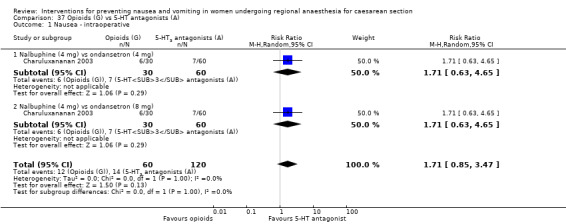
Comparison 37 Opioids (G) vs 5‐HT antagonists (A), Outcome 1 Nausea ‐ intraoperative.
37.2. Analysis.
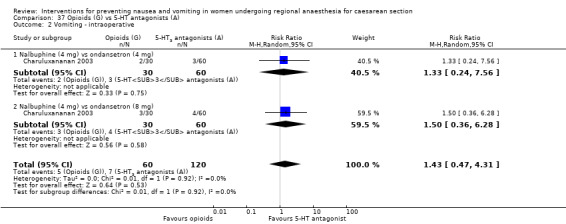
Comparison 37 Opioids (G) vs 5‐HT antagonists (A), Outcome 2 Vomiting ‐ intraoperative.
Secondary outcomes
None of our secondary outcomes were measured.
Not pre‐specified
The study also reported on pruritus but there were insufficient data to report findings (Analysis 37.10).
37.10. Analysis.
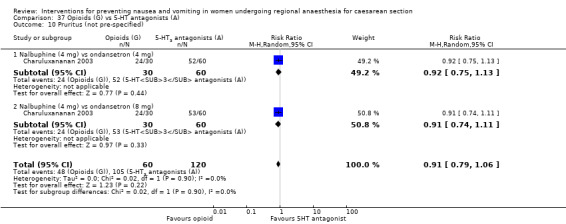
Comparison 37 Opioids (G) vs 5‐HT antagonists (A), Outcome 10 Pruritus (not pre‐specified).
H. Supplemental oxygen (Comparison 38)
1) Supplemental oxygen (H) versus placebo (two studies, 294 women, Comparison 38)
Two studies compared supplemental oxygen with placebo under regional anaesthesia (Pecora 2009; Phillips 2007). One study was of good quality with the randomisation, allocation concealment and blinding all judged as adequate (Phillips 2007). However, some participants did not receive the allocated intervention and their data were not able to be re‐included. The other study was unclear on all 'Risk of bias' criteria.
Primary outcome
We found no difference between placebo and the treatment group in terms of intraoperative nausea (average RR 0.78, 95% CI 0.53 to 1.15, two studies, 294 women, random‐effects [T² = 0.02, Chi² P = 0.27, I² = 19%], Analysis 38.1), intraoperative vomiting (RR 0.42, 95% CI 0.14 to 1.25, one study, 89 women, Analysis 38.2), postoperative nausea (RR 0.65, 95% CI 0.31 to 1.36, one study, 89 women, Analysis 38.3) and intraoperative vomiting (RR 1.56, 95% CI 0.40 to 6.13, one study, 89 women, Analysis 38.4).
38.1. Analysis.
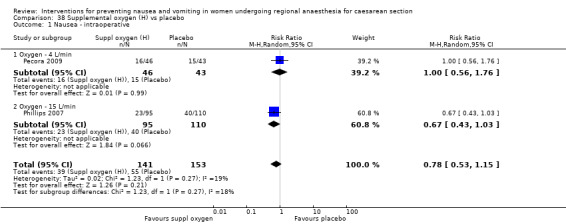
Comparison 38 Supplemental oxygen (H) vs placebo, Outcome 1 Nausea ‐ intraoperative.
38.2. Analysis.
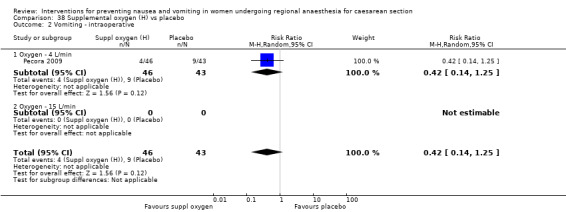
Comparison 38 Supplemental oxygen (H) vs placebo, Outcome 2 Vomiting ‐ intraoperative.
38.3. Analysis.
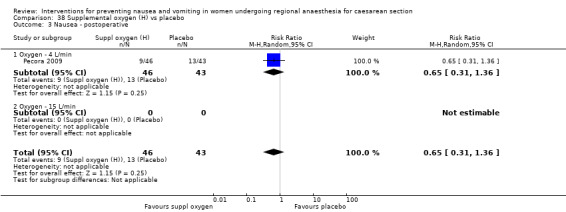
Comparison 38 Supplemental oxygen (H) vs placebo, Outcome 3 Nausea ‐ postoperative.
38.4. Analysis.
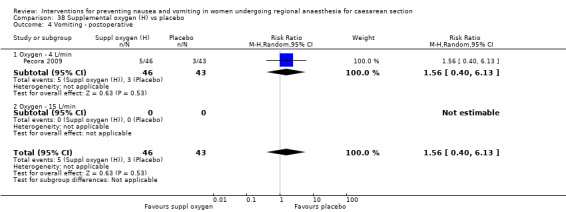
Comparison 38 Supplemental oxygen (H) vs placebo, Outcome 4 Vomiting ‐ postoperative.
Secondary outcomes
None of our secondary outcomes were assessed.
Not pre‐specified outcomes
There was no difference identified in maternal satisfaction (RR 0.96, 95% CI 0.89 to 1.03, one study, 89 women, Analysis 38.9).
38.9. Analysis.
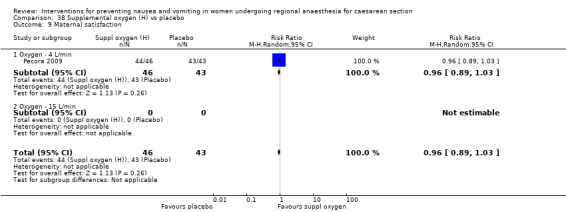
Comparison 38 Supplemental oxygen (H) vs placebo, Outcome 9 Maternal satisfaction.
J. Intravenous fluids (Comparison 39)
1) Intravenous fluids (J) versus placebo (one study, 10 women, Comparison 39)
One very small study compared supplemental intravenous fluid with placebo in regional anaesthesia (Gaiser 2002). The study was of uncertain quality, with random sequence generation, blinding, missing data, selective reporting and other bias all judged as 'Unclear'. Allocation concealment was assessed as adequate.
Primary outcomes
The primary outcomes of postoperative nausea and vomiting were assessed. No difference was detected in either the outcome of postoperative nausea or postoperative vomiting (Analysis 39.3; Analysis 39.4).
39.3. Analysis.

Comparison 39 IV fluids (J) vs placebo, Outcome 3 Nausea ‐ postoperative.
39.4. Analysis.

Comparison 39 IV fluids (J) vs placebo, Outcome 4 Vomiting ‐ postoperative.
Secondary outcomes
None of our secondary outcomes were assessed.
K. Acupressure/acupuncture (Comparison 40‐42)
1) Acupressure/acupuncture (K) versus placebo (six studies, 649 women, Comparison 40)
Seven studies compared acupressure/acupuncture with placebo, with six studies providing data on 649 women (Duggal 1998; Habib 2006; Harmon 2000; Ho 1996; Ho 2006; Stein 1997). One study addressed this question but provided graphical data only (Birnbach 1993). The studies providing data were of reasonable quality with five out of six describing adequate blinding and one rated as unclear (Harmon 2000). However, only three of six described adequate random sequence generation and only one of six adequate allocation concealment (Stein 1997). All six studies assessed intraoperative symptoms. Only three studies (Duggal 1998; Habib 2006; Harmon 2000) also assessed postoperative symptoms.
Primary outcomes
The six studies comparing the intervention with placebo found a reduction in intraoperative nausea (average RR 0.59, 95% CI 0.38 to 0.90, six studies, 649 women, random‐effects [T² = 0.18, Chi² P = 0.004, I² = 71%], Analysis 40.1). No significant difference was seen in intraoperative vomiting (average RR 0.74, 95% CI 0.46 to 1.18, six studies, 649 women, random‐effects [T² = 0.05, Chi² P = 0.33, I² = 13%], Analysis 40.2). The three studies assessing postoperative symptoms identified no reduction in nausea (average RR 0.83, 95% CI 0.68 to 1.00, three studies, 429 women, random‐effects [T² = 0.00, Chi² P = 0.42, I² = 0%], Analysis 40.3), or vomiting (average RR 0.69, 95% CI 0.45 to 1.06, three studies, 429 women, random‐effects [T² = 0.08, Chi² P = 0.10, I² = 57%], Analysis 40.4).
40.1. Analysis.
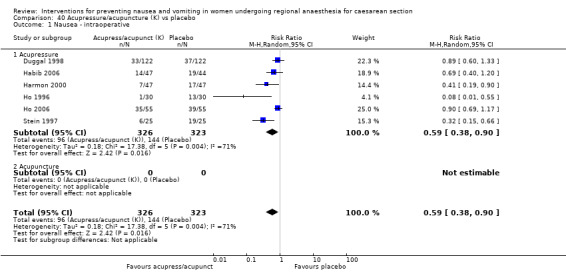
Comparison 40 Acupressure/acupuncture (K) vs placebo, Outcome 1 Nausea ‐ intraoperative.
40.2. Analysis.
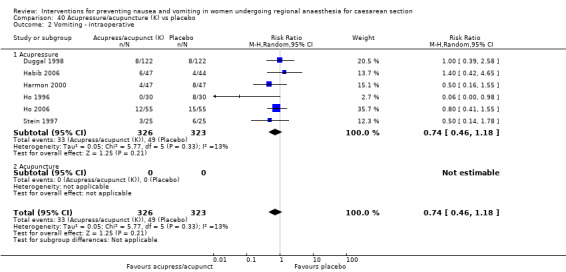
Comparison 40 Acupressure/acupuncture (K) vs placebo, Outcome 2 Vomiting ‐ intraoperative.
40.3. Analysis.
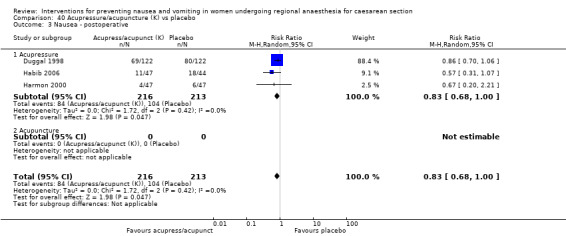
Comparison 40 Acupressure/acupuncture (K) vs placebo, Outcome 3 Nausea ‐ postoperative.
40.4. Analysis.
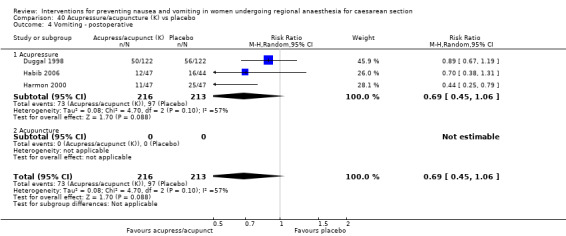
Comparison 40 Acupressure/acupuncture (K) vs placebo, Outcome 4 Vomiting ‐ postoperative.
Secondary outcomes
Only two studies (Ho 1996; Stein 1997) assessed adverse effects and found no difference between the groups for anxiety, dizziness, hypotension and pruritus Analysis 40.10 to Analysis 40.13).
40.10. Analysis.
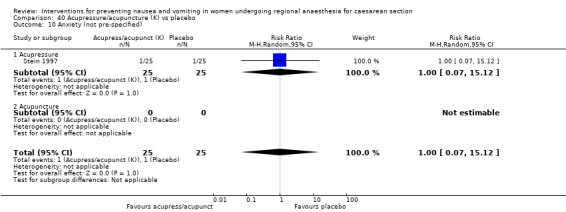
Comparison 40 Acupressure/acupuncture (K) vs placebo, Outcome 10 Anxiety (not pre‐specified).
40.13. Analysis.
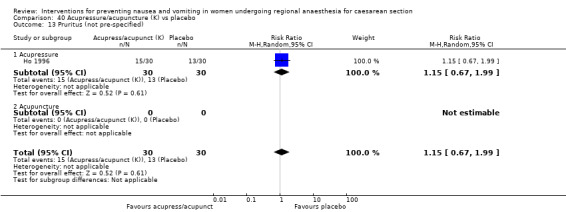
Comparison 40 Acupressure/acupuncture (K) vs placebo, Outcome 13 Pruritus (not pre‐specified).
2) Acupressure/acupuncture (K) versus 5‐HT3 antagonists (A) (no studies, Comparison 41)
There were no studies that made this comparison.
3) Acupressure/acupuncture (K) versus dopamine antagonists (B) (one study, 50 women, Comparison 42)
Two studies assessed this question (Birnbach 1993, Stein 1997) but only one provided useable data (Stein 1997). The study was of good quality.
Primary outcomes
The primary outcomes of intraoperative nausea and vomiting were assessed. No difference was detected in either outcome (Analysis 42.1; Analysis 42.2).
42.1. Analysis.

Comparison 42 Acupuncture/acupressure (K) vs dopamine antagonist (B), Outcome 1 Nausea ‐ intraoperative.
42.2. Analysis.

Comparison 42 Acupuncture/acupressure (K) vs dopamine antagonist (B), Outcome 2 Vomiting ‐ intraoperative.
Secondary outcomes
No data.
Not pre‐specified outcomes
See analyses Analysis 42.10 and Analysis 42.11.
42.10. Analysis.

Comparison 42 Acupuncture/acupressure (K) vs dopamine antagonist (B), Outcome 10 Anxiety (not pre‐specified).
42.11. Analysis.

Comparison 42 Acupuncture/acupressure (K) vs dopamine antagonist (B), Outcome 11 Hypotension (not pre‐specified).
Combinations of interventions (comparisons 43‐47)
There were seven comparisons of combinations of drugs with only one study for each comparison. These are reported below.
1) Droperidol + dexamethasone (B+C) versus placebo (one study, 60 women, Comparison 43)
One study involving 60 women looked at the combination of droperidol plus dexamethasone against placebo (Wu 2007). The study had adequate random sequence generation and blinding, however, it was unclear whether there was adequate concealment allocation. The only outcome assessed was postoperative vomiting which was reduced with the drug combination (RR 0.40, 95% CI 0.18 to 0.89, one study, 60 women, Analysis 43.4).
43.4. Analysis.

Comparison 43 Dopamine antagonists + corticosteroids (B+C) vs placebo, Outcome 4 Vomiting ‐ postoperative.
2) Droperidol + dexamethasone (B+C) versus droperidol (B) alone (one study, 60 women, Comparison 44)
The same study involving 60 women looked at the combination of droperidol plus dexamethasone versus droperidol (Wu 2007). The only outcome assessed was postoperative vomiting and no difference was identified (RR 0.67, 95% CI 0.27 to 1.64, one study, 60 women, Analysis 44.4).
44.4. Analysis.

Comparison 44 Dopamine antagonists + corticosteroids (B+C) vs dopamine antagonists (B), Outcome 4 Vomiting ‐ postoperative.
3) Droperidol + dexamethasone (B+C) versus dexamethasone (C) alone (one study, 60 women. Comparison 45)
The same study involving 60 women looked at the combination of droperidol plus dexamethasone against droperidol (Wu 2007). The only outcome assessed was postoperative vomiting and no difference was identified (RR 0.46, 95% CI 0.20 to 1.05, one study, 60 women, Analysis 45.4).
45.4. Analysis.

Comparison 45 Dopamine antagonists + corticosteroids (B+C) vs corticosteroids (C), Outcome 4 Vomiting ‐ postoperative.
4) Metoclopramide + glycopyrrolate (B+E) versus metoclopramide (B) alone (no studies, Comparison 46)
Although there was one small study, we were unable to use the combined outcome data (Biwas 2002).
5) Metaclopramide + glycopyrrolate (B+E) versus glycopyrrolate (E) alone (no studies, Comparison 47)
Although there was one small study, we were unable to use the combined outcome data (Biwas 2002).
Discussion
Summary of main results
The included studies included in this review fall into three broad groups ‐ those comparing agents with placebo, those comparing different single agents with one another, and those comparing combinations of therapy.
Placebo controlled studies
A. 5‐HT3 antagonists. Using data from 10 studies involving 980 women, overall we found that 5‐HT3 antagonists were effective in reducing intraoperative nausea, and postoperative nausea and vomiting. However, there were insufficient data to determine if there were significant adverse effects like headaches, dizziness, hypotension and pruritus.
B. Dopamine antagonists In 12 studies involving 899 women, we found that dopamine antagonists (both metoclopramide and droperidol) were effective in reducing both intraoperative nausea and vomiting, and postoperative nausea and vomiting. However, there were insufficient data to determine if there were significant adverse effects like headaches, dizziness, hypotension and pruritus.
C. Corticosteroids. In six studies involving 490 women, corticosteroids were found to be effective at reducing intraoperative nausea and vomiting. However, we did not identify any benefit for postoperative nausea and vomiting.
D. Antihistamines. In three studies involving 365 women, antihistamines were effective at reducing postoperative nausea and vomiting, but none of the studies assessed intraoperative nausea and vomiting. There are no data on possible adverse effects.
E. Anticholenergic drugs. In four studies involving 453 women, we found that anticholinergic drugs were effective at reducing intraoperative nausea but not intraoperative vomiting. No study assessed postoperative nausea, however, there was a reduction in postoperative vomiting in one study involving 161 women but there were insufficient data to be sure of other outcomes, including potential adverse effects.
F. Sedatives. In four studies involving 285 women, we found a reduction in intraoperative and postoperative nausea and vomiting. There were insufficient data on potential adverse effects.
G. Opioids. There was just one study involving 120 women and this found no difference in postoperative nausea or vomiting.
H. Supplemental oxygen. There were two studies involving 294 women and these studies found no difference in our primary outcomes.
J. Intravenous fluids. There was just one small study involving 10 women and this provided insufficient data to be able to report findings with any degree of assurance.
K. Acupressure/acupuncture. In six studies involving 649 women, we found a reduction in intraoperative nausea but we identified no difference in postoperative nausea or intraoperative and postoperative vomiting, although there is likely to be insufficient data to be able to say there is no difference. There were insufficient data on potential adverse effects.
Comparison studies
A number of studies compared the efficacy of different single drugs with one another. These included studies comparing different medications within the same class, such as comparing different dopamine antagonists (one study, 81 women) or different doses of 5‐HT3 antagonists (one study, 120 women). Some studies also compared medication of different classes, such as studies comparing a 5‐HT3 antagonist with a dopamine antagonist (four studies, 307 women) or a dopamine antagonist with a steroid (three studies, 176 women).
In our primary outcomes, postoperative nausea was found to be reduced with 5‐HT3 antagonists compared with dopamine antagonists. Postoperative vomiting was found to be reduced with antihistamines compared with dopamine antagonists, and with antihistamines compared with steroids. Sedatives were found to decrease intraoperative nausea compared with dopamine antagonists.
In non‐prespecified outcomes, respiratory depression was found to be significantly increased with sedatives compared with dopamine antagonists.
Combination studies
A number of small combination studies were included in the review. These included the combination of metoclopramide/glycopyrrolate compared with metoclopramide or glycopyrrolate alone, the combination of 5‐HT3/dexamethasone with 5‐HT3 antagonists or droperidol alone, and the combination of 5‐HT3/droperidol and 5‐HT3 antagonists alone.
No difference was detected between any combination of treatment for any of our primary outcomes. However, the combination of dopamine antagonists and corticosteroids was assessed against placebo in one study and found to be effective in reducing postoperative vomiting.
Overall completeness and applicability of evidence
There are good data assessing the efficacy of most classes of antiemetic compared with placebo in preventing nausea and vomiting during and following caesarean section under regional anaesthesia. There are limited data comparing different classes of antiemetics, and very limited data comparing combinations of therapy.
There were no studies identified that assessed the efficacy of antiemetics given for treatment (rather than prevention) of established nausea and vomiting although these would be dealt with in a separate review.
Quality of the evidence
The quality of the evidence in this review varied widely. The 'Risk of bias' assessment ranged from seven studies which assessed as low risk on all criteria (apart from Selective Bias) to five studies assessed as unclear on all criteria. Only four studies were rated as inadequate on any criteria ‐ Duman 2010 and Phillips 2007 for management of missing data, Rudra 2004a for inadequate blinding and Shahriari 2009 for selective reporting.
Of the 52 included studies, 31 described adequate blinding, and 26 described adequate random sequence generation, however only 11 described adequate allocation concealment.
Potential biases in the review process
The possibility of introducing bias was present at every stage of reviewing process. We attempted to minimise bias in a number of ways; two review authors assessed eligibility for inclusion, carried out data extraction and assessed risk of bias. Each worked independently. Nevertheless, the process of assessing risk of bias, for example, is not an exact science and includes many personal judgements.
Agreements and disagreements with other studies or reviews
The findings of this study are consistent with previously published reviews of nausea and vomiting at caesarean section (Balki 2005).
Authors' conclusions
Implications for practice.
This study indicates that many agents, from a diverse range of pharmacological classes, have efficacy in preventing intraoperative and postoperative emetic symptoms at caesarean section. This is perhaps consistent with the multi‐factorial pathogenesis of the condition. Of the included interventions, 5 HT3 antagonists, dopamine antagonists and sedatives all showed a reduction in the majority of our primary outcomes. The other classes of drugs and interventions show effects on some of these outcomes only, for example, acupuncture/acupressure was found to reduce intraoperative nausea, but was not found to affect vomiting or postoperative nausea. This may reflect the amount of data available.
There is little evidence that combinations of treatment are superior to single agents but few studies looked at these aspects.
The studies suggest that emetic symptoms are common both during and following caesarean section. Placebo arms of trials included in this review suggest an intraoperative incidence of nausea in the order of 20% to 60%. This gives some weight to published guidelines recommending prophylaxis rather than treatment of emesis at caesarean section (NICE 2011).
Implications for research.
Whilst there is good evidence that many single agents are efficacious in preventing nausea and vomiting, there is a paucity of good quality data comparing different interventions, nor is there good data comparing combinations of treatment. There are no data comparing the efficacy of agents for treatment of established nausea and vomiting although these would be dealt with in a separate review. Future studies should assess potential adverse effects and women's views.
Acknowledgements
Dr Eugene HC Liu Department of Anaesthesia, National University Hospital, Singapore.
Eugene Liu (EL) and Shantini Paranjothy (SP) wrote the first drafts of the combined protocol (Drugs at caesarean section for preventing nausea, vomiting and aspiration pneumonitis), which was subsequently split into this review and Paranjothy 2010.
Several papers considered for inclusion in the review were not reported in English. Thanks to Edgardo Abalos for translating Caba 1997; Liza Abraham for translating Maranhao 1988; Julie Arbon for translating Jasson 1987; Alex Balistreri for translating Karamanlioglu 1995, von Braun 1994 and Zoroglu 1999; Elizabeth Dumford Chavez for translating Imbeloni 1986; Samiye Godel for translating Ozkan 2000; Gillian Kenyon for translating Tryba 1983; Alison Ledward for translating Jasson 1989b and Zue 1999; Almira Opardija for translating Avramovic 1979; and Sara Roden‐Scott for translating Bifarini 1990 and Bifarini 1992.
As part of the pre‐publication editorial process, this review has been commented on by two peers (an editor and referee who is external to the editorial team), a member of the Pregnancy and Childbirth Group's international panel of consumers and the Group's Statistical Adviser.
Data and analyses
Comparison 1. 5‐HT3 antagonists (A) vs placebo.
| Outcome or subgroup title | No. of studies | No. of participants | Statistical method | Effect size |
|---|---|---|---|---|
| 1 Nausea ‐ intraoperative | 8 | 720 | Risk Ratio (M‐H, Random, 95% CI) | 0.64 [0.46, 0.88] |
| 1.1 Ondansetron ‐ 4 mg | 6 | 512 | Risk Ratio (M‐H, Random, 95% CI) | 0.60 [0.40, 0.89] |
| 1.2 Ondansetron ‐ 8 mg | 1 | 32 | Risk Ratio (M‐H, Random, 95% CI) | 0.45 [0.20, 1.01] |
| 1.3 Granisetron ‐ 1 mg | 1 | 176 | Risk Ratio (M‐H, Random, 95% CI) | 1.14 [0.59, 2.20] |
| 2 Vomiting ‐ intraoperative | 7 | 668 | Risk Ratio (M‐H, Random, 95% CI) | 0.56 [0.31, 1.00] |
| 2.1 Ondansetron ‐ 4 mg | 5 | 460 | Risk Ratio (M‐H, Random, 95% CI) | 0.60 [0.30, 1.18] |
| 2.2 Ondansetron ‐ 8 mg | 1 | 32 | Risk Ratio (M‐H, Random, 95% CI) | 0.14 [0.02, 1.03] |
| 2.3 Granisetron ‐ 1 mg | 1 | 176 | Risk Ratio (M‐H, Random, 95% CI) | 0.67 [0.19, 2.28] |
| 3 Nausea ‐ postoperative | 4 | 405 | Risk Ratio (M‐H, Random, 95% CI) | 0.40 [0.25, 0.64] |
| 3.1 Ondansetron ‐ 4 mg | 4 | 315 | Risk Ratio (M‐H, Random, 95% CI) | 0.39 [0.21, 0.75] |
| 3.2 Ondansetron ‐ 8 mg | 1 | 90 | Risk Ratio (M‐H, Random, 95% CI) | 0.44 [0.18, 1.09] |
| 3.3 Granisetron ‐ 1 mg | 0 | 0 | Risk Ratio (M‐H, Random, 95% CI) | 0.0 [0.0, 0.0] |
| 3.4 Granisetron ‐ 3 mg | 0 | 0 | Risk Ratio (M‐H, Random, 95% CI) | 0.0 [0.0, 0.0] |
| 4 Vomiting ‐ postoperative | 5 | 565 | Risk Ratio (M‐H, Random, 95% CI) | 0.50 [0.32, 0.77] |
| 4.1 Ondansetron ‐ 4 mg | 5 | 475 | Risk Ratio (M‐H, Random, 95% CI) | 0.45 [0.27, 0.77] |
| 4.2 Ondansetron ‐ 8 mg | 1 | 90 | Risk Ratio (M‐H, Random, 95% CI) | 1.0 [0.19, 5.15] |
| 4.3 Granisetron ‐ 1 mg | 0 | 0 | Risk Ratio (M‐H, Random, 95% CI) | 0.0 [0.0, 0.0] |
| 4.4 Granisetron ‐ 3 mg | 0 | 0 | Risk Ratio (M‐H, Random, 95% CI) | 0.0 [0.0, 0.0] |
| 5 Maternal adverse effects | 0 | 0 | Risk Ratio (M‐H, Random, 95% CI) | 0.0 [0.0, 0.0] |
| 5.1 Ondansetron ‐ 4 mg | 0 | 0 | Risk Ratio (M‐H, Random, 95% CI) | 0.0 [0.0, 0.0] |
| 5.2 Ondansetron ‐ 8 mg | 0 | 0 | Risk Ratio (M‐H, Random, 95% CI) | 0.0 [0.0, 0.0] |
| 5.3 Granisetron ‐ 1 mg | 0 | 0 | Risk Ratio (M‐H, Random, 95% CI) | 0.0 [0.0, 0.0] |
| 5.4 Granisetron ‐ 3 mg | 0 | 0 | Risk Ratio (M‐H, Random, 95% CI) | 0.0 [0.0, 0.0] |
| 6 Apgar < 7 at 5 min | 0 | 0 | Risk Ratio (M‐H, Random, 95% CI) | 0.0 [0.0, 0.0] |
| 6.1 Ondansetron ‐ 4 mg | 0 | 0 | Risk Ratio (M‐H, Random, 95% CI) | 0.0 [0.0, 0.0] |
| 6.2 Ondansetron ‐ 8 mg | 0 | 0 | Risk Ratio (M‐H, Random, 95% CI) | 0.0 [0.0, 0.0] |
| 6.3 Granisetron ‐ 1 mg | 0 | 0 | Risk Ratio (M‐H, Random, 95% CI) | 0.0 [0.0, 0.0] |
| 6.4 Granisetron ‐ 3 mg | 0 | 0 | Risk Ratio (M‐H, Random, 95% CI) | 0.0 [0.0, 0.0] |
| 7 Initiaition of breastfeeding | 0 | 0 | Risk Ratio (M‐H, Random, 95% CI) | 0.0 [0.0, 0.0] |
| 7.1 Ondansetron ‐ 4 mg | 0 | 0 | Risk Ratio (M‐H, Random, 95% CI) | 0.0 [0.0, 0.0] |
| 7.2 Ondansetron ‐ 8 mg | 0 | 0 | Risk Ratio (M‐H, Random, 95% CI) | 0.0 [0.0, 0.0] |
| 7.3 Granisetron ‐ 1 mg | 0 | 0 | Risk Ratio (M‐H, Random, 95% CI) | 0.0 [0.0, 0.0] |
| 7.4 Granisetron ‐ 3 mg | 0 | 0 | Risk Ratio (M‐H, Random, 95% CI) | 0.0 [0.0, 0.0] |
| 8 Duration of exclusive breastfeeding | 0 | 0 | Std. Mean Difference (IV, Random, 95% CI) | 0.0 [0.0, 0.0] |
| 8.1 Ondansetron ‐ 4 mg | 0 | 0 | Std. Mean Difference (IV, Random, 95% CI) | 0.0 [0.0, 0.0] |
| 8.2 Ondansetron ‐ 8 mg | 0 | 0 | Std. Mean Difference (IV, Random, 95% CI) | 0.0 [0.0, 0.0] |
| 8.3 Granisetron ‐ 1 mg | 0 | 0 | Std. Mean Difference (IV, Random, 95% CI) | 0.0 [0.0, 0.0] |
| 8.4 Granisetron ‐ 3 mg | 0 | 0 | Std. Mean Difference (IV, Random, 95% CI) | 0.0 [0.0, 0.0] |
| 9 Maternal satisfaction | 2 | Risk Ratio (M‐H, Random, 95% CI) | Totals not selected | |
| 9.1 Ondansetron ‐ 4 mg | 2 | Risk Ratio (M‐H, Random, 95% CI) | 0.0 [0.0, 0.0] | |
| 9.2 Ondansetron ‐ 8 mg | 0 | Risk Ratio (M‐H, Random, 95% CI) | 0.0 [0.0, 0.0] | |
| 9.3 Granisetron ‐ 1 mg | 0 | Risk Ratio (M‐H, Random, 95% CI) | 0.0 [0.0, 0.0] | |
| 9.4 Granisetron ‐ 3 mg | 0 | Risk Ratio (M‐H, Random, 95% CI) | 0.0 [0.0, 0.0] | |
| 10 Headache/dizziness (not pre‐specified) | 1 | 105 | Risk Ratio (M‐H, Random, 95% CI) | 2.83 [0.30, 26.36] |
| 10.1 Ondansetron ‐ 4 mg | 1 | 105 | Risk Ratio (M‐H, Random, 95% CI) | 2.83 [0.30, 26.36] |
| 10.2 Ondansetron ‐ 8 mg | 0 | 0 | Risk Ratio (M‐H, Random, 95% CI) | 0.0 [0.0, 0.0] |
| 10.3 Granisetron ‐ 1 mg | 0 | 0 | Risk Ratio (M‐H, Random, 95% CI) | 0.0 [0.0, 0.0] |
| 10.4 Granisetron ‐ 3 mg | 0 | 0 | Risk Ratio (M‐H, Random, 95% CI) | 0.0 [0.0, 0.0] |
| 11 Hypotension (not pre‐specified) | 3 | 290 | Risk Ratio (M‐H, Random, 95% CI) | 1.22 [0.72, 2.08] |
| 11.1 Ondansetron ‐ 4 mg | 2 | 114 | Risk Ratio (M‐H, Random, 95% CI) | 1.44 [0.48, 4.34] |
| 11.2 Ondansetron ‐ 8 mg | 0 | 0 | Risk Ratio (M‐H, Random, 95% CI) | 0.0 [0.0, 0.0] |
| 11.3 Granisetron ‐ 1 mg | 1 | 176 | Risk Ratio (M‐H, Random, 95% CI) | 3.0 [0.12, 72.65] |
| 11.4 Granisetron ‐ 3 mg | 0 | 0 | Risk Ratio (M‐H, Random, 95% CI) | 0.0 [0.0, 0.0] |
| 12 Pruritus (not pre‐specified) | 1 | 180 | Risk Ratio (M‐H, Random, 95% CI) | 0.94 [0.85, 1.03] |
| 12.1 Ondansetron ‐ 4 mg | 1 | 90 | Risk Ratio (M‐H, Random, 95% CI) | 0.93 [0.81, 1.07] |
| 12.2 Ondansetron ‐ 8 mg | 1 | 90 | Risk Ratio (M‐H, Random, 95% CI) | 0.95 [0.83, 1.08] |
| 12.3 Granisetron ‐ 1 mg | 0 | 0 | Risk Ratio (M‐H, Random, 95% CI) | 0.0 [0.0, 0.0] |
| 12.4 Granisetron ‐ 3 mg | 0 | 0 | Risk Ratio (M‐H, Random, 95% CI) | 0.0 [0.0, 0.0] |
1.11. Analysis.
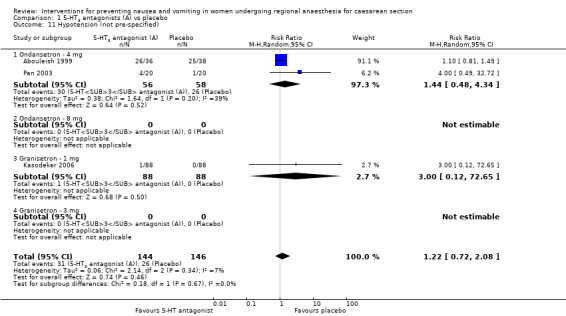
Comparison 1 5‐HT3 antagonists (A) vs placebo, Outcome 11 Hypotension (not pre‐specified).
Comparison 2. 5‐HT3 antagonist (A) vs 5‐HT3 antagonist (A).
| Outcome or subgroup title | No. of studies | No. of participants | Statistical method | Effect size |
|---|---|---|---|---|
| 1 Nausea ‐ intraoperative | 0 | 0 | Risk Ratio (M‐H, Random, 95% CI) | 0.0 [0.0, 0.0] |
| 2 Vomiting ‐ intraoperative | 0 | 0 | Risk Ratio (M‐H, Random, 95% CI) | 0.0 [0.0, 0.0] |
| 3 Nausea ‐ postoperative | 0 | 0 | Risk Ratio (M‐H, Random, 95% CI) | 0.0 [0.0, 0.0] |
| 4 Vomiting ‐ postoperative | 0 | 0 | Risk Ratio (M‐H, Random, 95% CI) | 0.0 [0.0, 0.0] |
| 5 Maternal adverse effects | 0 | 0 | Risk Ratio (M‐H, Random, 95% CI) | 0.0 [0.0, 0.0] |
| 6 Apgar < 7 at 5 min | 0 | 0 | Risk Ratio (M‐H, Random, 95% CI) | 0.0 [0.0, 0.0] |
| 7 Initiation of breastfeeding | 0 | 0 | Risk Ratio (M‐H, Random, 95% CI) | 0.0 [0.0, 0.0] |
| 8 Duration of exclusive breastfeeding | 0 | 0 | Mean Difference (IV, Random, 95% CI) | 0.0 [0.0, 0.0] |
| 9 Maternal satisfaction | 0 | 0 | Risk Ratio (M‐H, Random, 95% CI) | 0.0 [0.0, 0.0] |
Comparison 3. 5‐HT3 antagonists (A) ‐ Ondansetron 8mg vs 4mg.
| Outcome or subgroup title | No. of studies | No. of participants | Statistical method | Effect size |
|---|---|---|---|---|
| 1 Nausea ‐ intraoperative | 0 | 0 | Risk Ratio (M‐H, Fixed, 95% CI) | 0.0 [0.0, 0.0] |
| 2 Vomiting ‐ intraoperative | 0 | 0 | Risk Ratio (M‐H, Fixed, 95% CI) | 0.0 [0.0, 0.0] |
| 3 Nausea ‐ postoperative | 1 | 120 | Risk Ratio (M‐H, Fixed, 95% CI) | 1.0 [0.37, 2.68] |
| 4 Vomiting ‐ postoperative | 1 | 120 | Risk Ratio (M‐H, Fixed, 95% CI) | 1.33 [0.31, 5.70] |
| 5 Maternal adverse effects | 0 | 0 | Risk Ratio (M‐H, Fixed, 95% CI) | 0.0 [0.0, 0.0] |
| 6 Apgar < 7 at 5 min | 0 | 0 | Risk Ratio (M‐H, Fixed, 95% CI) | 0.0 [0.0, 0.0] |
| 7 Initiation of breastfeeding | 0 | 0 | Risk Ratio (M‐H, Fixed, 95% CI) | 0.0 [0.0, 0.0] |
| 8 Duration of exclusive breastfeeding | 0 | 0 | Mean Difference (IV, Fixed, 95% CI) | 0.0 [0.0, 0.0] |
| 9 Maternal satisfaction | 0 | 0 | Risk Ratio (M‐H, Fixed, 95% CI) | 0.0 [0.0, 0.0] |
| 10 Pruritus (not pre‐specified) | 1 | 120 | Risk Ratio (M‐H, Fixed, 95% CI) | 1.02 [0.89, 1.17] |
Comparison 4. Dopamine antagonists (B) vs placebo.
| Outcome or subgroup title | No. of studies | No. of participants | Statistical method | Effect size |
|---|---|---|---|---|
| 1 Nausea ‐ intraoperative | 9 | 636 | Risk Ratio (M‐H, Random, 95% CI) | 0.38 [0.25, 0.57] |
| 1.1 Metoclopramide ‐ 10 mg | 4 | 234 | Risk Ratio (M‐H, Random, 95% CI) | 0.36 [0.13, 0.96] |
| 1.2 Metoclopramide ‐ 20 mg | 1 | 100 | Risk Ratio (M‐H, Random, 95% CI) | 0.27 [0.10, 0.75] |
| 1.3 Metoclopramide ‐ 0.15 mg/kg | 1 | 67 | Risk Ratio (M‐H, Random, 95% CI) | 0.32 [0.12, 0.90] |
| 1.4 Droperidol ‐ 0.5 mg | 1 | 128 | Risk Ratio (M‐H, Random, 95% CI) | 0.33 [0.17, 0.65] |
| 1.5 Droperidol ‐ 0.625 mg | 1 | 32 | Risk Ratio (M‐H, Random, 95% CI) | 0.36 [0.15, 0.90] |
| 1.6 Droperidol ‐ 1.25 mg | 1 | 75 | Risk Ratio (M‐H, Random, 95% CI) | 0.44 [0.17, 1.15] |
| 2 Vomiting ‐ intraoperative | 8 | 536 | Risk Ratio (M‐H, Random, 95% CI) | 0.39 [0.24, 0.64] |
| 2.1 Metoclopramide ‐ 10 mg | 4 | 234 | Risk Ratio (M‐H, Random, 95% CI) | 0.45 [0.20, 0.99] |
| 2.2 Metoclopramide ‐ 20 mg | 0 | 0 | Risk Ratio (M‐H, Random, 95% CI) | 0.0 [0.0, 0.0] |
| 2.3 Metoclopramide ‐ 0.15 mg/kg | 1 | 67 | Risk Ratio (M‐H, Random, 95% CI) | 0.09 [0.01, 1.54] |
| 2.4 Droperidol ‐ 0.5 mg | 1 | 128 | Risk Ratio (M‐H, Random, 95% CI) | 0.34 [0.09, 1.23] |
| 2.5 Droperidol ‐ 0.625 mg | 1 | 32 | Risk Ratio (M‐H, Random, 95% CI) | 0.29 [0.07, 1.17] |
| 2.6 Droperidol ‐ 1.25 mg | 1 | 75 | Risk Ratio (M‐H, Random, 95% CI) | 0.37 [0.10, 1.27] |
| 3 Nausea ‐ postoperative | 5 | 412 | Risk Ratio (M‐H, Random, 95% CI) | 0.60 [0.40, 0.91] |
| 3.1 Metoclopramide ‐ 10 mg | 3 | 265 | Risk Ratio (M‐H, Random, 95% CI) | 0.58 [0.36, 0.94] |
| 3.2 Metoclopramide ‐ 20 mg | 0 | 0 | Risk Ratio (M‐H, Random, 95% CI) | 0.0 [0.0, 0.0] |
| 3.3 Metoclopramide ‐ 0.15 mg/kg | 1 | 67 | Risk Ratio (M‐H, Random, 95% CI) | 0.40 [0.16, 1.02] |
| 3.4 Droperidol ‐ 0.5 mg | 0 | 0 | Risk Ratio (M‐H, Random, 95% CI) | 0.0 [0.0, 0.0] |
| 3.5 Droperidol ‐ 0.625 mg | 0 | 0 | Risk Ratio (M‐H, Random, 95% CI) | 0.0 [0.0, 0.0] |
| 3.6 Droperidol ‐ 1.25 mg | 1 | 80 | Risk Ratio (M‐H, Random, 95% CI) | 1.67 [0.43, 6.51] |
| 4 Vomiting ‐ postoperative | 6 | 472 | Risk Ratio (M‐H, Random, 95% CI) | 0.57 [0.36, 0.91] |
| 4.1 Metoclopramide ‐ 10 mg | 3 | 265 | Risk Ratio (M‐H, Random, 95% CI) | 0.65 [0.24, 1.73] |
| 4.2 Metoclopramide ‐ 20 mg | 0 | 0 | Risk Ratio (M‐H, Random, 95% CI) | 0.0 [0.0, 0.0] |
| 4.3 Metoclopramide ‐ 0.15 mg/kg | 1 | 67 | Risk Ratio (M‐H, Random, 95% CI) | 0.32 [0.12, 0.90] |
| 4.4 Droperidol ‐ 0.5 mg | 0 | 0 | Risk Ratio (M‐H, Random, 95% CI) | 0.0 [0.0, 0.0] |
| 4.5 Droperidol ‐ 0.625 mg | 0 | 0 | Risk Ratio (M‐H, Random, 95% CI) | 0.0 [0.0, 0.0] |
| 4.6 Droperidol ‐ 1.25 mg | 2 | 140 | Risk Ratio (M‐H, Random, 95% CI) | 0.55 [0.32, 0.94] |
| 5 Maternal adverse effects | 0 | 0 | Risk Ratio (M‐H, Random, 95% CI) | 0.0 [0.0, 0.0] |
| 5.1 Metoclopramide ‐ 10 mg | 0 | 0 | Risk Ratio (M‐H, Random, 95% CI) | 0.0 [0.0, 0.0] |
| 5.2 Metoclopramide ‐ 20 mg | 0 | 0 | Risk Ratio (M‐H, Random, 95% CI) | 0.0 [0.0, 0.0] |
| 5.3 Metoclopramide ‐ 0.15 mg/kg | 0 | 0 | Risk Ratio (M‐H, Random, 95% CI) | 0.0 [0.0, 0.0] |
| 5.4 Droperidol ‐ 0.5 mg | 0 | 0 | Risk Ratio (M‐H, Random, 95% CI) | 0.0 [0.0, 0.0] |
| 5.5 Droperidol ‐ 0.625 mg | 0 | 0 | Risk Ratio (M‐H, Random, 95% CI) | 0.0 [0.0, 0.0] |
| 5.6 Droperidol ‐ 1.25 mg | 0 | 0 | Risk Ratio (M‐H, Random, 95% CI) | 0.0 [0.0, 0.0] |
| 6 Apgar < 7 at 5 min | 0 | 0 | Risk Ratio (M‐H, Random, 95% CI) | 0.0 [0.0, 0.0] |
| 6.1 Metoclopramide ‐ 10 mg | 0 | 0 | Risk Ratio (M‐H, Random, 95% CI) | 0.0 [0.0, 0.0] |
| 6.2 Metoclopramide ‐ 20 mg | 0 | 0 | Risk Ratio (M‐H, Random, 95% CI) | 0.0 [0.0, 0.0] |
| 6.3 Metoclopramide ‐ 0.15 mg/kg | 0 | 0 | Risk Ratio (M‐H, Random, 95% CI) | 0.0 [0.0, 0.0] |
| 6.4 Droperidol ‐ 0.5 mg | 0 | 0 | Risk Ratio (M‐H, Random, 95% CI) | 0.0 [0.0, 0.0] |
| 6.5 Droperidol ‐ 0.625 mg | 0 | 0 | Risk Ratio (M‐H, Random, 95% CI) | 0.0 [0.0, 0.0] |
| 6.6 Droperidol ‐ 1.25 mg | 0 | 0 | Risk Ratio (M‐H, Random, 95% CI) | 0.0 [0.0, 0.0] |
| 7 Initiation of breastfeeding | 0 | 0 | Risk Ratio (M‐H, Random, 95% CI) | 0.0 [0.0, 0.0] |
| 7.1 Metoclopramide ‐ 10 mg | 0 | 0 | Risk Ratio (M‐H, Random, 95% CI) | 0.0 [0.0, 0.0] |
| 7.2 Metoclopramide ‐ 20 mg | 0 | 0 | Risk Ratio (M‐H, Random, 95% CI) | 0.0 [0.0, 0.0] |
| 7.3 Metoclopramide ‐ 0.15 mg/kg | 0 | 0 | Risk Ratio (M‐H, Random, 95% CI) | 0.0 [0.0, 0.0] |
| 7.4 Droperidol ‐ 0.5 mg | 0 | 0 | Risk Ratio (M‐H, Random, 95% CI) | 0.0 [0.0, 0.0] |
| 7.5 Droperidol ‐ 0.625 mg | 0 | 0 | Risk Ratio (M‐H, Random, 95% CI) | 0.0 [0.0, 0.0] |
| 7.6 Droperidol ‐ 1.25 mg | 0 | 0 | Risk Ratio (M‐H, Random, 95% CI) | 0.0 [0.0, 0.0] |
| 8 Duration of exclusive breastfeeding | 0 | 0 | Std. Mean Difference (IV, Random, 95% CI) | 0.0 [0.0, 0.0] |
| 8.1 Metoclopramide ‐ 10 mg | 0 | 0 | Std. Mean Difference (IV, Random, 95% CI) | 0.0 [0.0, 0.0] |
| 8.2 Metoclopramide ‐ 20 mg | 0 | 0 | Std. Mean Difference (IV, Random, 95% CI) | 0.0 [0.0, 0.0] |
| 8.3 Metoclopramide ‐ 0.5 mg/kg | 0 | 0 | Std. Mean Difference (IV, Random, 95% CI) | 0.0 [0.0, 0.0] |
| 8.4 Droperidol ‐ 0.5 mg | 0 | 0 | Std. Mean Difference (IV, Random, 95% CI) | 0.0 [0.0, 0.0] |
| 8.5 Droperidol ‐ 0.625 mg | 0 | 0 | Std. Mean Difference (IV, Random, 95% CI) | 0.0 [0.0, 0.0] |
| 8.6 Droperidol ‐ 1.25 mg | 0 | 0 | Std. Mean Difference (IV, Random, 95% CI) | 0.0 [0.0, 0.0] |
| 9 Maternal satisfaction | 1 | 102 | Risk Ratio (M‐H, Random, 95% CI) | 1.42 [0.91, 2.21] |
| 9.1 Metoclopramide ‐ 10 mg | 1 | 102 | Risk Ratio (M‐H, Random, 95% CI) | 1.42 [0.91, 2.21] |
| 9.2 Metoclopramide ‐ 20 mg | 0 | 0 | Risk Ratio (M‐H, Random, 95% CI) | 0.0 [0.0, 0.0] |
| 9.3 Metoclopramide ‐ 0.15 mg/kg | 0 | 0 | Risk Ratio (M‐H, Random, 95% CI) | 0.0 [0.0, 0.0] |
| 9.4 Droperidol ‐ 0.5 mg | 0 | 0 | Risk Ratio (M‐H, Random, 95% CI) | 0.0 [0.0, 0.0] |
| 9.5 Droperidol ‐ 0.625 mg | 0 | 0 | Risk Ratio (M‐H, Random, 95% CI) | 0.0 [0.0, 0.0] |
| 9.6 Droperidol ‐ 1.25 mg | 0 | 0 | Risk Ratio (M‐H, Random, 95% CI) | 0.0 [0.0, 0.0] |
| 10 Anxiety (not pre‐specified) | 1 | 50 | Risk Ratio (M‐H, Random, 95% CI) | 4.0 [0.48, 33.33] |
| 10.1 Metoclopramide ‐ 10 mg | 1 | 50 | Risk Ratio (M‐H, Random, 95% CI) | 4.0 [0.48, 33.33] |
| 10.2 Metoclopramide ‐ 20 mg | 0 | 0 | Risk Ratio (M‐H, Random, 95% CI) | 0.0 [0.0, 0.0] |
| 10.3 Metoclopramide ‐ 0.15 mg/kg | 0 | 0 | Risk Ratio (M‐H, Random, 95% CI) | 0.0 [0.0, 0.0] |
| 10.4 Droperidol ‐ 0.5 mg | 0 | 0 | Risk Ratio (M‐H, Random, 95% CI) | 0.0 [0.0, 0.0] |
| 10.5 Droperidol ‐ 0.625 mg | 0 | 0 | Risk Ratio (M‐H, Random, 95% CI) | 0.0 [0.0, 0.0] |
| 10.6 Droperidol ‐ 1.25 mg | 0 | 0 | Risk Ratio (M‐H, Random, 95% CI) | 0.0 [0.0, 0.0] |
| 11 Headache/dizziness (not pre‐specified) | 1 | 102 | Risk Ratio (M‐H, Random, 95% CI) | 0.33 [0.01, 8.00] |
| 11.1 Metoclopramide ‐ 10 mg | 1 | 102 | Risk Ratio (M‐H, Random, 95% CI) | 0.33 [0.01, 8.00] |
| 11.2 Metoclopramide ‐ 20 mg | 0 | 0 | Risk Ratio (M‐H, Random, 95% CI) | 0.0 [0.0, 0.0] |
| 11.3 Metoclopramide ‐ 0.15 mg/kg | 0 | 0 | Risk Ratio (M‐H, Random, 95% CI) | 0.0 [0.0, 0.0] |
| 11.4 Droperidol ‐ 0.5 mg | 0 | 0 | Risk Ratio (M‐H, Random, 95% CI) | 0.0 [0.0, 0.0] |
| 11.5 Droperidol ‐ 0.625 mg | 0 | 0 | Risk Ratio (M‐H, Random, 95% CI) | 0.0 [0.0, 0.0] |
| 11.6 Droperidol ‐ 1.25 mg | 0 | 0 | Risk Ratio (M‐H, Random, 95% CI) | 0.0 [0.0, 0.0] |
| 12 Hypotension (not pre‐specified) | 4 | 285 | Risk Ratio (M‐H, Random, 95% CI) | 1.05 [0.84, 1.31] |
| 12.1 Metoclopramide ‐ 10 mg | 2 | 90 | Risk Ratio (M‐H, Random, 95% CI) | 0.93 [0.68, 1.28] |
| 12.2 Metoclopramide ‐ 20 mg | 0 | 0 | Risk Ratio (M‐H, Random, 95% CI) | 0.0 [0.0, 0.0] |
| 12.3 Metoclopramide ‐ 0.15 mg/kg | 1 | 67 | Risk Ratio (M‐H, Random, 95% CI) | 1.62 [0.66, 3.95] |
| 12.4 Droperidol ‐ 0.5 mg | 1 | 128 | Risk Ratio (M‐H, Random, 95% CI) | 1.13 [0.80, 1.60] |
| 12.5 Droperidol ‐ 0.625 mg | 0 | 0 | Risk Ratio (M‐H, Random, 95% CI) | 0.0 [0.0, 0.0] |
| 12.6 Droperidol ‐ 1.25 mg | 0 | 0 | Risk Ratio (M‐H, Random, 95% CI) | 0.0 [0.0, 0.0] |
| 13 Pruritus (not pre‐specified) | 1 | 75 | Risk Ratio (M‐H, Random, 95% CI) | 0.92 [0.55, 1.53] |
| 13.1 Metoclopramide ‐ 10 mg | 0 | 0 | Risk Ratio (M‐H, Random, 95% CI) | 0.0 [0.0, 0.0] |
| 13.2 Metoclopramide ‐ 20 mg | 0 | 0 | Risk Ratio (M‐H, Random, 95% CI) | 0.0 [0.0, 0.0] |
| 13.3 Metoclopramide ‐ 0.15 mg/kg | 0 | 0 | Risk Ratio (M‐H, Random, 95% CI) | 0.0 [0.0, 0.0] |
| 13.4 Droperidol ‐ 0.5 mg | 0 | 0 | Risk Ratio (M‐H, Random, 95% CI) | 0.0 [0.0, 0.0] |
| 13.5 Droperidol ‐ 0.625 mg | 0 | 0 | Risk Ratio (M‐H, Random, 95% CI) | 0.0 [0.0, 0.0] |
| 13.6 Droperidol ‐ 1.25 mg | 1 | 75 | Risk Ratio (M‐H, Random, 95% CI) | 0.92 [0.55, 1.53] |
Comparison 5. Dopamine antagonists (B) vs 5‐HT3 antagonists (A).
| Outcome or subgroup title | No. of studies | No. of participants | Statistical method | Effect size |
|---|---|---|---|---|
| 1 Nausea ‐ intraoperative | 2 | 137 | Risk Ratio (M‐H, Random, 95% CI) | 1.39 [0.67, 2.90] |
| 1.1 Metoclopramide (10 mg) vs ondansetron (4 mg) | 1 | 105 | Risk Ratio (M‐H, Random, 95% CI) | 1.79 [1.01, 3.16] |
| 1.2 Metoclopramide (10 mg) vs ondansetron (8 mg) | 0 | 0 | Risk Ratio (M‐H, Random, 95% CI) | 0.0 [0.0, 0.0] |
| 1.3 Metoclopramide (10 mg) vs granisetron (3 mg) | 0 | 0 | Risk Ratio (M‐H, Random, 95% CI) | 0.0 [0.0, 0.0] |
| 1.4 Droperidol (0.625 mg) vs ondansetron (8 mg) | 1 | 32 | Risk Ratio (M‐H, Random, 95% CI) | 0.8 [0.26, 2.45] |
| 1.5 Droperidol (1.25 mg) vs ondansetron (4 mg) | 0 | 0 | Risk Ratio (M‐H, Random, 95% CI) | 0.0 [0.0, 0.0] |
| 1.6 Droperidol (1.25 mg) vs granisetron (3 mg) | 0 | 0 | Risk Ratio (M‐H, Random, 95% CI) | 0.0 [0.0, 0.0] |
| 2 Vomiting ‐ intraoperative | 2 | 137 | Risk Ratio (M‐H, Random, 95% CI) | 1.30 [0.55, 3.10] |
| 2.1 Metoclopramide (10 mg) vs ondansetron (4 mg) | 1 | 105 | Risk Ratio (M‐H, Random, 95% CI) | 1.21 [0.47, 3.10] |
| 2.2 Metoclopramide (10 mg) vs ondansetron (8 mg) | 0 | 0 | Risk Ratio (M‐H, Random, 95% CI) | 0.0 [0.0, 0.0] |
| 2.3 Metoclopramide (10 mg) vs granisetron (3 mg) | 0 | 0 | Risk Ratio (M‐H, Random, 95% CI) | 0.0 [0.0, 0.0] |
| 2.4 Droperidol (0.625 mg) vs ondansetron (8 mg) | 1 | 32 | Risk Ratio (M‐H, Random, 95% CI) | 2.0 [0.20, 19.91] |
| 2.5 Droperidol (1.25 mg) vs ondansetron (4 mg) | 0 | 0 | Risk Ratio (M‐H, Random, 95% CI) | 0.0 [0.0, 0.0] |
| 2.6 Droperidol (1.25 mg) vs granisetron (3 mg) | 0 | 0 | Risk Ratio (M‐H, Random, 95% CI) | 0.0 [0.0, 0.0] |
| 3 Nausea ‐ postoperative | 2 | 185 | Risk Ratio (M‐H, Random, 95% CI) | 1.84 [1.13, 2.98] |
| 3.1 Metoclopramide (10 mg) vs ondansetron (4 mg) | 1 | 105 | Risk Ratio (M‐H, Random, 95% CI) | 1.97 [1.16, 3.32] |
| 3.2 Metoclopramide (10 mg) vs ondansetron (8 mg) | 0 | 0 | Risk Ratio (M‐H, Random, 95% CI) | 0.0 [0.0, 0.0] |
| 3.3 Metoclopramide (10 mg) vs granisetron (3 mg) | 0 | 0 | Risk Ratio (M‐H, Random, 95% CI) | 0.0 [0.0, 0.0] |
| 3.4 Droperidol (0.625 mg) vs ondansetron (8 mg) | 0 | 0 | Risk Ratio (M‐H, Random, 95% CI) | 0.0 [0.0, 0.0] |
| 3.5 Droperidol (1.25 mg) vs ondansetron (4 mg) | 1 | 80 | Risk Ratio (M‐H, Random, 95% CI) | 1.25 [0.36, 4.32] |
| 3.6 Droperidol (1.25 mg) vs granisetron (3 mg) | 0 | 0 | Risk Ratio (M‐H, Random, 95% CI) | 0.0 [0.0, 0.0] |
| 4 Vomiting ‐ postoperative | 3 | 275 | Risk Ratio (M‐H, Random, 95% CI) | 2.09 [0.94, 4.64] |
| 4.1 Metoclopramide (10 mg) vs ondansetron (4 mg) | 1 | 105 | Risk Ratio (M‐H, Random, 95% CI) | 1.19 [0.50, 2.85] |
| 4.2 Metoclopramide (10 mg) vs ondansetron (8 mg) | 1 | 90 | Risk Ratio (M‐H, Random, 95% CI) | 2.63 [1.30, 5.30] |
| 4.3 Metoclopramide (10 mg) vs granisetron (3 mg) | 0 | 0 | Risk Ratio (M‐H, Random, 95% CI) | 0.0 [0.0, 0.0] |
| 4.4 Droperidol (0.625 mg) vs ondansetron (8 mg) | 0 | 0 | Risk Ratio (M‐H, Random, 95% CI) | 0.0 [0.0, 0.0] |
| 4.5 Droperidol (1.25 mg) vs ondansetron (4 mg) | 1 | 80 | Risk Ratio (M‐H, Random, 95% CI) | 11.00 [0.63, 192.56] |
| 4.6 Droperidol (1.25 mg) vs granisetron (3 mg) | 0 | 0 | Risk Ratio (M‐H, Random, 95% CI) | 0.0 [0.0, 0.0] |
| 5 Maternal adverse effects | 0 | 0 | Risk Ratio (M‐H, Random, 95% CI) | 0.0 [0.0, 0.0] |
| 5.1 Metoclopramide (10 mg) vs ondansetron (4 mg) | 0 | 0 | Risk Ratio (M‐H, Random, 95% CI) | 0.0 [0.0, 0.0] |
| 5.2 Metoclopramide (10 mg) vs ondansetron (8 mg) | 0 | 0 | Risk Ratio (M‐H, Random, 95% CI) | 0.0 [0.0, 0.0] |
| 5.3 Metoclopramide (10 mg) vs granisetron (3 mg) | 0 | 0 | Risk Ratio (M‐H, Random, 95% CI) | 0.0 [0.0, 0.0] |
| 5.4 Droperidol (0.625 mg) vs ondansetron (8 mg) | 0 | 0 | Risk Ratio (M‐H, Random, 95% CI) | 0.0 [0.0, 0.0] |
| 5.5 Droperidol (1.25 mg) vs ondansetron (4 mg) | 0 | 0 | Risk Ratio (M‐H, Random, 95% CI) | 0.0 [0.0, 0.0] |
| 5.6 Droperidol (1.25 mg) vs granisetron (3 mg) | 0 | 0 | Risk Ratio (M‐H, Random, 95% CI) | 0.0 [0.0, 0.0] |
| 6 Apgar < 7 at 5 min | 0 | 0 | Risk Ratio (M‐H, Random, 95% CI) | 0.0 [0.0, 0.0] |
| 6.1 Metoclopramide (10 mg) vs ondansetron (4 mg) | 0 | 0 | Risk Ratio (M‐H, Random, 95% CI) | 0.0 [0.0, 0.0] |
| 6.2 Metoclopramide (10 mg) vs ondansetron (8 mg) | 0 | 0 | Risk Ratio (M‐H, Random, 95% CI) | 0.0 [0.0, 0.0] |
| 6.3 Metoclopramide (10 mg) vs granisetron (3 mg) | 0 | 0 | Risk Ratio (M‐H, Random, 95% CI) | 0.0 [0.0, 0.0] |
| 6.4 Droperidol (0.625 mg) vs ondansetron (8 mg) | 0 | 0 | Risk Ratio (M‐H, Random, 95% CI) | 0.0 [0.0, 0.0] |
| 6.5 Droperidol (1.25 mg) vs ondansetron (4 mg) | 0 | 0 | Risk Ratio (M‐H, Random, 95% CI) | 0.0 [0.0, 0.0] |
| 6.6 Droperidol (1.25 mg) vs granisetron (3 mg) | 0 | 0 | Risk Ratio (M‐H, Random, 95% CI) | 0.0 [0.0, 0.0] |
| 7 Initiation of breastfeeding | 0 | 0 | Risk Ratio (M‐H, Random, 95% CI) | 0.0 [0.0, 0.0] |
| 7.1 Metoclopramide (10 mg) vs ondansetron (4 mg) | 0 | 0 | Risk Ratio (M‐H, Random, 95% CI) | 0.0 [0.0, 0.0] |
| 7.2 Metoclopramide (10 mg) vs ondansetron (8 mg) | 0 | 0 | Risk Ratio (M‐H, Random, 95% CI) | 0.0 [0.0, 0.0] |
| 7.3 Metoclopramide (10 mg) vs granisetron (3 mg) | 0 | 0 | Risk Ratio (M‐H, Random, 95% CI) | 0.0 [0.0, 0.0] |
| 7.4 Droperidol (0.625 mg) vs ondansetron (8 mg) | 0 | 0 | Risk Ratio (M‐H, Random, 95% CI) | 0.0 [0.0, 0.0] |
| 7.5 Droperidol (1.25 mg) vs ondansetron (4 mg) | 0 | 0 | Risk Ratio (M‐H, Random, 95% CI) | 0.0 [0.0, 0.0] |
| 7.6 Droperidol (1.25 mg) vs granisetron (3 mg) | 0 | 0 | Risk Ratio (M‐H, Random, 95% CI) | 0.0 [0.0, 0.0] |
| 8 Duration of exclusive breastfeeding | 0 | 0 | Mean Difference (IV, Random, 95% CI) | 0.0 [0.0, 0.0] |
| 8.1 Metoclopramide (10 mg) vs ondansetron (4 mg) | 0 | 0 | Mean Difference (IV, Random, 95% CI) | 0.0 [0.0, 0.0] |
| 8.2 Metoclopramide (10 mg) vs ondansetron (8 mg) | 0 | 0 | Mean Difference (IV, Random, 95% CI) | 0.0 [0.0, 0.0] |
| 8.3 Metoclopramide (10 mg) vs granisetron (3 mg) | 0 | 0 | Mean Difference (IV, Random, 95% CI) | 0.0 [0.0, 0.0] |
| 8.4 Droperidol (0.625 mg) vs ondansetron (8 mg) | 0 | 0 | Mean Difference (IV, Random, 95% CI) | 0.0 [0.0, 0.0] |
| 8.5 Droperidol (1.25 mg) vs ondansetron (4 mg) | 0 | 0 | Mean Difference (IV, Random, 95% CI) | 0.0 [0.0, 0.0] |
| 8.6 Droperidol (1.25 mg) vs granisetron (3 mg) | 0 | 0 | Mean Difference (IV, Random, 95% CI) | 0.0 [0.0, 0.0] |
| 9 Maternal satisfaction | 1 | 105 | Risk Ratio (M‐H, Random, 95% CI) | 0.71 [0.53, 0.97] |
| 9.1 Metoclopramide (10 mg) vs ondansetron (4 mg) | 1 | 105 | Risk Ratio (M‐H, Random, 95% CI) | 0.71 [0.53, 0.97] |
| 9.2 Metoclopramide (10 mg) vs ondansetron (8 mg) | 0 | 0 | Risk Ratio (M‐H, Random, 95% CI) | 0.0 [0.0, 0.0] |
| 9.3 Metoclopramide (10 mg) vs granisetron (3 mg) | 0 | 0 | Risk Ratio (M‐H, Random, 95% CI) | 0.0 [0.0, 0.0] |
| 9.4 Droperidol (0.625 mg) vs ondansetron (8 mg) | 0 | 0 | Risk Ratio (M‐H, Random, 95% CI) | 0.0 [0.0, 0.0] |
| 9.5 Droperidol (1.25 mg) vs ondansetron (4 mg) | 0 | 0 | Risk Ratio (M‐H, Random, 95% CI) | 0.0 [0.0, 0.0] |
| 9.6 Droperidol (1.25 mg) vs granisetron (3 mg) | 0 | 0 | Risk Ratio (M‐H, Random, 95% CI) | 0.0 [0.0, 0.0] |
| 10 Headache/dizziness (not pre‐specified) | 1 | 105 | Risk Ratio (M‐H, Random, 95% CI) | 0.15 [0.01, 2.85] |
| 10.1 Metoclopramide (10 mg) vs ondansetron (4 mg) | 1 | 105 | Risk Ratio (M‐H, Random, 95% CI) | 0.15 [0.01, 2.85] |
| 10.2 Metoclopramide (10 mg) vs ondansetron (8 mg) | 0 | 0 | Risk Ratio (M‐H, Random, 95% CI) | 0.0 [0.0, 0.0] |
| 10.3 Metoclopramide (10 mg) vs granisetron (3 mg) | 0 | 0 | Risk Ratio (M‐H, Random, 95% CI) | 0.0 [0.0, 0.0] |
| 10.4 Droperidol (0.625 mg) vs ondansetron (8 mg) | 0 | 0 | Risk Ratio (M‐H, Random, 95% CI) | 0.0 [0.0, 0.0] |
| 10.5 Droperidol (1.25 mg) vs ondansetron (4 mg) | 0 | 0 | Risk Ratio (M‐H, Random, 95% CI) | 0.0 [0.0, 0.0] |
| 10.6 Droperidol (1.25 mg) vs granisetron (3 mg) | 0 | 0 | Risk Ratio (M‐H, Random, 95% CI) | 0.0 [0.0, 0.0] |
| 11 Pruritus < 8 hours (not pre‐specified) | 1 | 90 | Risk Ratio (M‐H, Random, 95% CI) | 1.23 [0.90, 1.68] |
| 11.1 Metoclopramide (10 mg) vs ondansetron (4 mg) | 0 | 0 | Risk Ratio (M‐H, Random, 95% CI) | 0.0 [0.0, 0.0] |
| 11.2 Metoclopramide (10 mg) vs ondansetron (8 mg) | 1 | 90 | Risk Ratio (M‐H, Random, 95% CI) | 1.23 [0.90, 1.68] |
| 11.3 Metoclopramide (10 mg) vs granisetron (3 mg) | 0 | 0 | Risk Ratio (M‐H, Random, 95% CI) | 0.0 [0.0, 0.0] |
| 11.4 Droperidol (0.625 mg) vs ondansetron (8 mg) | 0 | 0 | Risk Ratio (M‐H, Random, 95% CI) | 0.0 [0.0, 0.0] |
| 11.5 Droperidol (1.25 mg) vs ondansetron (4 mg) | 0 | 0 | Risk Ratio (M‐H, Random, 95% CI) | 0.0 [0.0, 0.0] |
| 11.6 Droperidol (1.25 mg) vs granisetron (3 mg) | 0 | 0 | Risk Ratio (M‐H, Random, 95% CI) | 0.0 [0.0, 0.0] |
| 12 Pruritus > 8 hours (not pre‐specified) | 1 | 90 | Risk Ratio (M‐H, Random, 95% CI) | 4.29 [2.10, 8.73] |
| 12.1 Metoclopramide (10 mg) vs ondansetron (4 mg) | 0 | 0 | Risk Ratio (M‐H, Random, 95% CI) | 0.0 [0.0, 0.0] |
| 12.2 Metoclopramide (10 mg) vs ondansetron (8 mg) | 1 | 90 | Risk Ratio (M‐H, Random, 95% CI) | 4.29 [2.10, 8.73] |
| 12.3 Metoclopramide (10 mg) vs granisetron (3 mg) | 0 | 0 | Risk Ratio (M‐H, Random, 95% CI) | 0.0 [0.0, 0.0] |
| 12.4 Droperidol (0.625 mg) vs ondansetron (8 mg) | 0 | 0 | Risk Ratio (M‐H, Random, 95% CI) | 0.0 [0.0, 0.0] |
| 12.5 Droperidol (1.25 mg) vs ondansetron (4 mg) | 0 | 0 | Risk Ratio (M‐H, Random, 95% CI) | 0.0 [0.0, 0.0] |
| 12.6 Droperidol (1.25 mg) vs granisetron (3 mg) | 0 | 0 | Risk Ratio (M‐H, Random, 95% CI) | 0.0 [0.0, 0.0] |
5.9. Analysis.
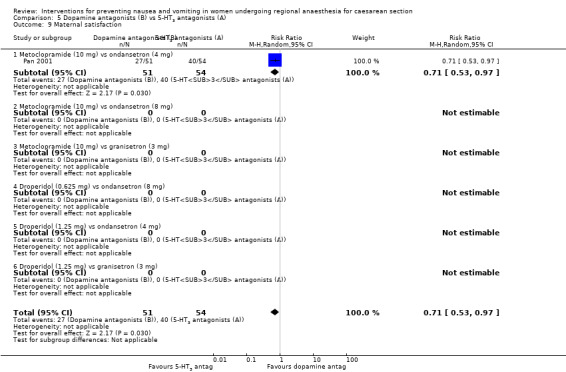
Comparison 5 Dopamine antagonists (B) vs 5‐HT3 antagonists (A), Outcome 9 Maternal satisfaction.
5.10. Analysis.
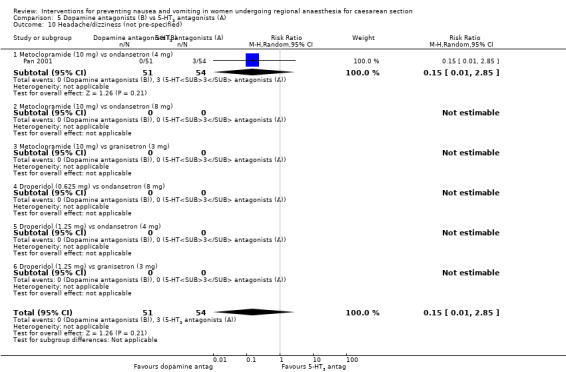
Comparison 5 Dopamine antagonists (B) vs 5‐HT3 antagonists (A), Outcome 10 Headache/dizziness (not pre‐specified).
5.11. Analysis.
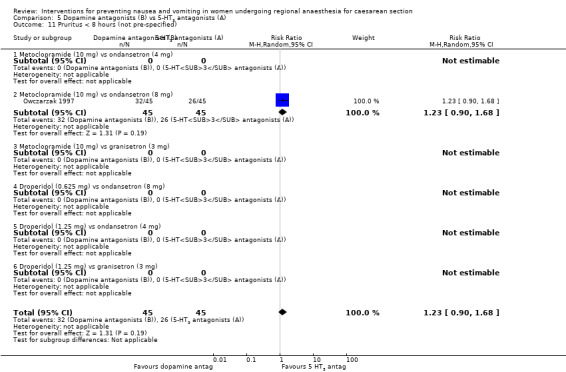
Comparison 5 Dopamine antagonists (B) vs 5‐HT3 antagonists (A), Outcome 11 Pruritus < 8 hours (not pre‐specified).
5.12. Analysis.
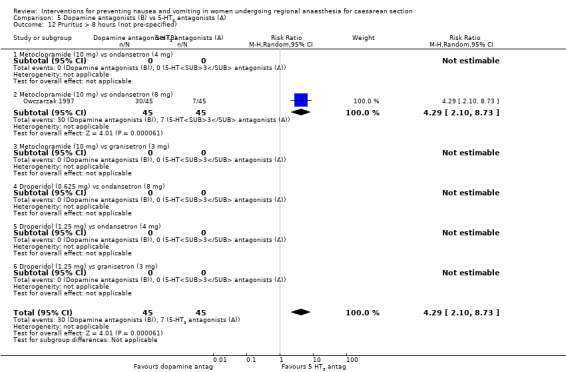
Comparison 5 Dopamine antagonists (B) vs 5‐HT3 antagonists (A), Outcome 12 Pruritus > 8 hours (not pre‐specified).
Comparison 6. Dopamine antagonist (B) vs dopamine antagonist (B).
| Outcome or subgroup title | No. of studies | No. of participants | Statistical method | Effect size |
|---|---|---|---|---|
| 1 Nausea ‐ intraoperative | 1 | 81 | Risk Ratio (M‐H, Random, 95% CI) | 1.54 [0.70, 3.36] |
| 1.1 Metoclopramide (10 mg) vs droperidol (1.25 mg) | 0 | 0 | Risk Ratio (M‐H, Random, 95% CI) | 0.0 [0.0, 0.0] |
| 1.2 Metoclopramide (15 mg) vs droperidol (0.5 mg) | 1 | 81 | Risk Ratio (M‐H, Random, 95% CI) | 1.54 [0.70, 3.36] |
| 2 Vomiting ‐ intraoperative | 1 | 81 | Risk Ratio (M‐H, Random, 95% CI) | 0.51 [0.05, 5.43] |
| 2.1 Metoclopramide (10 mg) vs droperidol (1.25 mg) | 0 | 0 | Risk Ratio (M‐H, Random, 95% CI) | 0.0 [0.0, 0.0] |
| 2.2 Metoclopramide (15 mg) vs droperidol (0.5 mg) | 1 | 81 | Risk Ratio (M‐H, Random, 95% CI) | 0.51 [0.05, 5.43] |
| 3 Nausea ‐ postoperative | 1 | 81 | Risk Ratio (M‐H, Random, 95% CI) | 1.03 [0.32, 3.27] |
| 3.1 Metoclopramide (10 mg) vs droperidol (1.25 mg) | 0 | 0 | Risk Ratio (M‐H, Random, 95% CI) | 0.0 [0.0, 0.0] |
| 3.2 Metoclopramide (15 mg) vs droperidol (0.5 mg) | 1 | 81 | Risk Ratio (M‐H, Random, 95% CI) | 1.03 [0.32, 3.27] |
| 4 Vomiting ‐ postoperative | 1 | 81 | Risk Ratio (M‐H, Random, 95% CI) | 1.03 [0.22, 4.78] |
| 4.1 Metoclopramide (10 mg) vs droperidol (1.25 mg) | 0 | 0 | Risk Ratio (M‐H, Random, 95% CI) | 0.0 [0.0, 0.0] |
| 4.2 Metoclopramide (15 mg) vs droperidol (0.5 mg) | 1 | 81 | Risk Ratio (M‐H, Random, 95% CI) | 1.03 [0.22, 4.78] |
| 5 Maternal adverse effects | 0 | 0 | Risk Ratio (M‐H, Random, 95% CI) | 0.0 [0.0, 0.0] |
| 5.1 Metoclopramide (10 mg) vs droperidol (1.25 mg) | 0 | 0 | Risk Ratio (M‐H, Random, 95% CI) | 0.0 [0.0, 0.0] |
| 5.2 Metoclopramide (15 mg) vs droperidol (0.5 mg) | 0 | 0 | Risk Ratio (M‐H, Random, 95% CI) | 0.0 [0.0, 0.0] |
| 6 Apgar < 7 at 5 min | 0 | 0 | Risk Ratio (M‐H, Random, 95% CI) | 0.0 [0.0, 0.0] |
| 6.1 Metoclopramide (10 mg) vs droperidol (1.25 mg) | 0 | 0 | Risk Ratio (M‐H, Random, 95% CI) | 0.0 [0.0, 0.0] |
| 6.2 Metoclopramide (15 mg) vs droperidol (0.5 mg) | 0 | 0 | Risk Ratio (M‐H, Random, 95% CI) | 0.0 [0.0, 0.0] |
| 7 Initiaition of breastfeeding | 0 | 0 | Risk Ratio (M‐H, Random, 95% CI) | 0.0 [0.0, 0.0] |
| 7.1 Metoclopramide (10 mg) vs droperidol (1.25 mg) | 0 | 0 | Risk Ratio (M‐H, Random, 95% CI) | 0.0 [0.0, 0.0] |
| 7.2 Metoclopramide (15 mg) vs droperidol (0.5 mg) | 0 | 0 | Risk Ratio (M‐H, Random, 95% CI) | 0.0 [0.0, 0.0] |
| 8 Duration of exclusive breastfeeding | 0 | 0 | Std. Mean Difference (IV, Random, 95% CI) | 0.0 [0.0, 0.0] |
| 8.1 Metoclopramide (10 mg) vs droperidol (1.25 mg) | 0 | 0 | Std. Mean Difference (IV, Random, 95% CI) | 0.0 [0.0, 0.0] |
| 8.2 Metoclopramide (15 mg) vs droperidol (0.5 mg) | 0 | 0 | Std. Mean Difference (IV, Random, 95% CI) | 0.0 [0.0, 0.0] |
| 9 Maternal satisfaction | 0 | 0 | Risk Ratio (M‐H, Random, 95% CI) | 0.0 [0.0, 0.0] |
| 9.1 Metoclopramide (10 mg) vs droperidol (1.25 mg) | 0 | 0 | Risk Ratio (M‐H, Random, 95% CI) | 0.0 [0.0, 0.0] |
| 9.2 Metoclopramide (15 mg) vs droperidol (0.5 mg) | 0 | 0 | Risk Ratio (M‐H, Random, 95% CI) | 0.0 [0.0, 0.0] |
| 10 Restlessness (not‐pre‐specified) | 1 | 81 | Risk Ratio (M‐H, Random, 95% CI) | 0.51 [0.05, 5.43] |
| 10.1 Metoclopramide (10 mg) vs droperidol (1.25 mg) | 0 | 0 | Risk Ratio (M‐H, Random, 95% CI) | 0.0 [0.0, 0.0] |
| 10.2 Metoclopramide (15 mg) vs droperidol (0.5 mg) | 1 | 81 | Risk Ratio (M‐H, Random, 95% CI) | 0.51 [0.05, 5.43] |
6.2. Analysis.
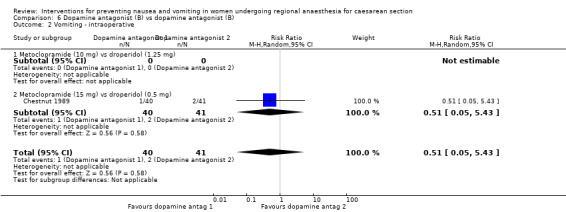
Comparison 6 Dopamine antagonist (B) vs dopamine antagonist (B), Outcome 2 Vomiting ‐ intraoperative.
6.3. Analysis.
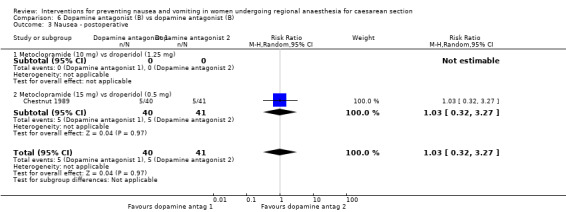
Comparison 6 Dopamine antagonist (B) vs dopamine antagonist (B), Outcome 3 Nausea ‐ postoperative.
Comparison 7. Corticosteroids (C) vs placebo.
| Outcome or subgroup title | No. of studies | No. of participants | Statistical method | Effect size |
|---|---|---|---|---|
| 1 Nausea ‐ intraoperative | 3 | 195 | Risk Ratio (M‐H, Random, 95% CI) | 0.31 [0.15, 0.64] |
| 1.1 Dexamethasone ‐ 2.5 mg | 0 | 0 | Risk Ratio (M‐H, Random, 95% CI) | 0.0 [0.0, 0.0] |
| 1.2 Dexamethasone ‐ 5 mg | 0 | 0 | Risk Ratio (M‐H, Random, 95% CI) | 0.0 [0.0, 0.0] |
| 1.3 Dexamethasone ‐ 8 mg | 3 | 195 | Risk Ratio (M‐H, Random, 95% CI) | 0.31 [0.15, 0.64] |
| 1.4 Dexamethasone ‐ 10 mg | 0 | 0 | Risk Ratio (M‐H, Random, 95% CI) | 0.0 [0.0, 0.0] |
| 2 Vomiting ‐ intraoperative | 3 | 195 | Risk Ratio (M‐H, Random, 95% CI) | 0.35 [0.14, 0.86] |
| 2.1 Dexamethasone ‐ 2.5 mg | 0 | 0 | Risk Ratio (M‐H, Random, 95% CI) | 0.0 [0.0, 0.0] |
| 2.2 Dexamethasone ‐ 5 mg | 0 | 0 | Risk Ratio (M‐H, Random, 95% CI) | 0.0 [0.0, 0.0] |
| 2.3 Dexamethasone ‐ 8 mg | 3 | 195 | Risk Ratio (M‐H, Random, 95% CI) | 0.35 [0.14, 0.86] |
| 2.4 Dexamethasone ‐ 10 mg | 0 | 0 | Risk Ratio (M‐H, Random, 95% CI) | 0.0 [0.0, 0.0] |
| 3 Nausea ‐ postoperative | 2 | 235 | Risk Ratio (M‐H, Random, 95% CI) | 0.75 [0.52, 1.07] |
| 3.1 Dexamethasone ‐ 2.5 mg | 1 | 58 | Risk Ratio (M‐H, Random, 95% CI) | 0.56 [0.19, 1.63] |
| 3.2 Dexamethasone ‐ 5 mg | 1 | 59 | Risk Ratio (M‐H, Random, 95% CI) | 0.43 [0.13, 1.38] |
| 3.3 Dexamethasone ‐ 8 mg | 1 | 60 | Risk Ratio (M‐H, Random, 95% CI) | 0.9 [0.61, 1.32] |
| 3.4 Dexamethasone ‐ 10 mg | 1 | 58 | Risk Ratio (M‐H, Random, 95% CI) | 0.44 [0.13, 1.41] |
| 4 Vomiting ‐ postoperative | 3 | 295 | Risk Ratio (M‐H, Random, 95% CI) | 0.78 [0.54, 1.12] |
| 4.1 Dexamethasone ‐ 2.5 mg | 1 | 58 | Risk Ratio (M‐H, Random, 95% CI) | 0.74 [0.22, 2.49] |
| 4.2 Dexamethasone ‐ 5 mg | 1 | 59 | Risk Ratio (M‐H, Random, 95% CI) | 0.34 [0.08, 1.51] |
| 4.3 Dexamethasone ‐ 8 mg | 2 | 120 | Risk Ratio (M‐H, Random, 95% CI) | 0.91 [0.65, 1.28] |
| 4.4 Dexamethasone ‐ 10 mg | 1 | 58 | Risk Ratio (M‐H, Random, 95% CI) | 0.26 [0.07, 1.04] |
| 5 Maternal adverse effects | 0 | 0 | Risk Ratio (M‐H, Random, 95% CI) | 0.0 [0.0, 0.0] |
| 5.1 Dexamethasone ‐ 2.5 mg | 0 | 0 | Risk Ratio (M‐H, Random, 95% CI) | 0.0 [0.0, 0.0] |
| 5.2 Dexamethasone ‐ 5 mg | 0 | 0 | Risk Ratio (M‐H, Random, 95% CI) | 0.0 [0.0, 0.0] |
| 5.3 Dexamethasone ‐ 8 mg | 0 | 0 | Risk Ratio (M‐H, Random, 95% CI) | 0.0 [0.0, 0.0] |
| 5.4 Dexamethasone ‐ 10 mg | 0 | 0 | Risk Ratio (M‐H, Random, 95% CI) | 0.0 [0.0, 0.0] |
| 6 Apgar < 7 at 5 min | 0 | 0 | Risk Ratio (M‐H, Random, 95% CI) | 0.0 [0.0, 0.0] |
| 6.1 Dexamethasone ‐ 2.5 mg | 0 | 0 | Risk Ratio (M‐H, Random, 95% CI) | 0.0 [0.0, 0.0] |
| 6.2 Dexamethasone ‐ 5 mg | 0 | 0 | Risk Ratio (M‐H, Random, 95% CI) | 0.0 [0.0, 0.0] |
| 6.3 Dexamethasone ‐ 8 mg | 0 | 0 | Risk Ratio (M‐H, Random, 95% CI) | 0.0 [0.0, 0.0] |
| 6.4 Dexamethasone ‐ 10 mg | 0 | 0 | Risk Ratio (M‐H, Random, 95% CI) | 0.0 [0.0, 0.0] |
| 7 Initiaition of breastfeeding | 0 | 0 | Risk Ratio (M‐H, Random, 95% CI) | 0.0 [0.0, 0.0] |
| 7.1 Dexamethasone ‐ 2.5 mg | 0 | 0 | Risk Ratio (M‐H, Random, 95% CI) | 0.0 [0.0, 0.0] |
| 7.2 Dexamethasone ‐ 5 mg | 0 | 0 | Risk Ratio (M‐H, Random, 95% CI) | 0.0 [0.0, 0.0] |
| 7.3 Dexamethasone ‐ 8 mg | 0 | 0 | Risk Ratio (M‐H, Random, 95% CI) | 0.0 [0.0, 0.0] |
| 7.4 Dexamethasone ‐ 10 mg | 0 | 0 | Risk Ratio (M‐H, Random, 95% CI) | 0.0 [0.0, 0.0] |
| 8 Duration of exclusive breastfeeding | 0 | 0 | Std. Mean Difference (IV, Random, 95% CI) | 0.0 [0.0, 0.0] |
| 8.1 Dexamethasone ‐ 2.5 mg | 0 | 0 | Std. Mean Difference (IV, Random, 95% CI) | 0.0 [0.0, 0.0] |
| 8.2 Dexamethasone ‐ 5 mg | 0 | 0 | Std. Mean Difference (IV, Random, 95% CI) | 0.0 [0.0, 0.0] |
| 8.3 Dexamethasone ‐ 8 mg | 0 | 0 | Std. Mean Difference (IV, Random, 95% CI) | 0.0 [0.0, 0.0] |
| 8.4 Dexamethasone ‐ 10 mg | 0 | 0 | Std. Mean Difference (IV, Random, 95% CI) | 0.0 [0.0, 0.0] |
| 9 Maternal satisfaction | 0 | 0 | Mean Difference (IV, Random, 95% CI) | 0.0 [0.0, 0.0] |
| 9.1 Dexamethasone ‐ 2.5 mg | 0 | 0 | Mean Difference (IV, Random, 95% CI) | 0.0 [0.0, 0.0] |
| 9.2 Dexamethasone ‐ 5 mg | 0 | 0 | Mean Difference (IV, Random, 95% CI) | 0.0 [0.0, 0.0] |
| 9.3 Dexamethasone ‐ 8 mg | 0 | 0 | Mean Difference (IV, Random, 95% CI) | 0.0 [0.0, 0.0] |
| 9.4 Dexamethasone ‐ 10 mg | 0 | 0 | Mean Difference (IV, Random, 95% CI) | 0.0 [0.0, 0.0] |
| 10 Hypotension (not pre‐specified) | 1 | 40 | Risk Ratio (M‐H, Random, 95% CI) | 0.75 [0.32, 1.77] |
| 10.1 Dexamethasone ‐ 2.5 mg | 0 | 0 | Risk Ratio (M‐H, Random, 95% CI) | 0.0 [0.0, 0.0] |
| 10.2 Dexamethasone ‐ 5 mg | 0 | 0 | Risk Ratio (M‐H, Random, 95% CI) | 0.0 [0.0, 0.0] |
| 10.3 Dexamethasone ‐ 8 mg | 1 | 40 | Risk Ratio (M‐H, Random, 95% CI) | 0.75 [0.32, 1.77] |
| 10.4 Dexamethasone ‐ 10 mg | 0 | 0 | Risk Ratio (M‐H, Random, 95% CI) | 0.0 [0.0, 0.0] |
| 11 Pruritus (not pre‐specified) | 1 | 75 | Risk Ratio (M‐H, Random, 95% CI) | 0.97 [0.59, 1.60] |
| 11.1 Dexamethasone ‐ 2.5 mg | 0 | 0 | Risk Ratio (M‐H, Random, 95% CI) | 0.0 [0.0, 0.0] |
| 11.2 Dexamethasone ‐ 5 mg | 0 | 0 | Risk Ratio (M‐H, Random, 95% CI) | 0.0 [0.0, 0.0] |
| 11.3 Dexamethasone ‐ 8 mg | 1 | 75 | Risk Ratio (M‐H, Random, 95% CI) | 0.97 [0.59, 1.60] |
| 11.4 Dexamethasone ‐ 10 mg | 0 | 0 | Risk Ratio (M‐H, Random, 95% CI) | 0.0 [0.0, 0.0] |
Comparison 9. Corticosteroids (C) vs dopamine antagonists (B).
| Outcome or subgroup title | No. of studies | No. of participants | Statistical method | Effect size |
|---|---|---|---|---|
| 1 Nausea ‐ intraoperative | 2 | 116 | Risk Ratio (M‐H, Random, 95% CI) | 0.67 [0.25, 1.77] |
| 1.1 Dexamethasone (8 mg) vs metoclopramide (10 mg) | 1 | 40 | Risk Ratio (M‐H, Random, 95% CI) | 0.5 [0.10, 2.43] |
| 1.2 Dexamethasone (8 mg) vs droperidol (1.25 mg) | 1 | 76 | Risk Ratio (M‐H, Random, 95% CI) | 0.8 [0.23, 2.75] |
| 2 Vomiting ‐ intraoperative | 2 | 116 | Risk Ratio (M‐H, Random, 95% CI) | 1.0 [0.31, 3.27] |
| 2.1 Dexamethasone (8 mg) vs metoclopramide (10 mg) | 1 | 40 | Risk Ratio (M‐H, Random, 95% CI) | 1.0 [0.16, 6.42] |
| 2.2 Dexamethasone (8 mg) vs droperidol (1.25 mg) | 1 | 76 | Risk Ratio (M‐H, Random, 95% CI) | 1.0 [0.22, 4.65] |
| 3 Nausea ‐ postoperative | 0 | 0 | Risk Ratio (M‐H, Random, 95% CI) | 0.0 [0.0, 0.0] |
| 3.1 Dexamethasone (8 mg) vs metoclopramide (10 mg) | 0 | 0 | Risk Ratio (M‐H, Random, 95% CI) | 0.0 [0.0, 0.0] |
| 3.2 Dexamethasone (8 mg) vs droperidol (1.25 mg) | 0 | 0 | Risk Ratio (M‐H, Random, 95% CI) | 0.0 [0.0, 0.0] |
| 4 Vomiting ‐ postoperative | 1 | 60 | Risk Ratio (M‐H, Random, 95% CI) | 1.44 [0.73, 2.86] |
| 4.1 Dexamethasone (8 mg) vs metoclopramide (10 mg) | 0 | 0 | Risk Ratio (M‐H, Random, 95% CI) | 0.0 [0.0, 0.0] |
| 4.2 Dexamethasone (8 mg) vs droperidol (1.25 mg) | 1 | 60 | Risk Ratio (M‐H, Random, 95% CI) | 1.44 [0.73, 2.86] |
| 5 Maternal adverse effects | 0 | 0 | Risk Ratio (M‐H, Random, 95% CI) | 0.0 [0.0, 0.0] |
| 5.1 Dexamethasone (8 mg) vs metoclopramide (10 mg) | 0 | 0 | Risk Ratio (M‐H, Random, 95% CI) | 0.0 [0.0, 0.0] |
| 5.2 Dexamethasone (8 mg) vs droperidol (1.25 mg) | 0 | 0 | Risk Ratio (M‐H, Random, 95% CI) | 0.0 [0.0, 0.0] |
| 6 Apgar < 7 at 5 min | 0 | 0 | Risk Ratio (M‐H, Random, 95% CI) | 0.0 [0.0, 0.0] |
| 6.1 Dexamethasone (8 mg) vs metoclopramide (10 mg) | 0 | 0 | Risk Ratio (M‐H, Random, 95% CI) | 0.0 [0.0, 0.0] |
| 6.2 Dexamethasone (8 mg) vs droperidol (1.25 mg) | 0 | 0 | Risk Ratio (M‐H, Random, 95% CI) | 0.0 [0.0, 0.0] |
| 7 Initiaition of breastfeeding | 0 | 0 | Risk Ratio (M‐H, Random, 95% CI) | 0.0 [0.0, 0.0] |
| 7.1 Dexamethasone (8 mg) vs metoclopramide (10 mg) | 0 | 0 | Risk Ratio (M‐H, Random, 95% CI) | 0.0 [0.0, 0.0] |
| 7.2 Dexamethasone (8 mg) vs droperidol (1.25 mg) | 0 | 0 | Risk Ratio (M‐H, Random, 95% CI) | 0.0 [0.0, 0.0] |
| 8 Duration of exclusive breastfeeding | 0 | 0 | Std. Mean Difference (IV, Random, 95% CI) | 0.0 [0.0, 0.0] |
| 8.1 Dexamethasone (8 mg) vs metoclopramide (10 mg) | 0 | 0 | Std. Mean Difference (IV, Random, 95% CI) | 0.0 [0.0, 0.0] |
| 8.2 Dexamethasone (8 mg) vs droperidol (1.25 mg) | 0 | 0 | Std. Mean Difference (IV, Random, 95% CI) | 0.0 [0.0, 0.0] |
| 9 Maternal satisfaction | 0 | 0 | Risk Ratio (M‐H, Random, 95% CI) | 0.0 [0.0, 0.0] |
| 9.1 Dexamethasone (8 mg) vs metoclopramide (10 mg) | 0 | 0 | Risk Ratio (M‐H, Random, 95% CI) | 0.0 [0.0, 0.0] |
| 9.2 Dexamethasone (8 mg) vs droperidol (1.25 mg) | 0 | 0 | Risk Ratio (M‐H, Random, 95% CI) | 0.0 [0.0, 0.0] |
| 10 Hypotension (not pre‐specified) | 1 | 40 | Risk Ratio (M‐H, Random, 95% CI) | 0.67 [0.29, 1.52] |
| 10.1 Dexamethasone (8 mg) vs metoclopramide (10 mg) | 1 | 40 | Risk Ratio (M‐H, Random, 95% CI) | 0.67 [0.29, 1.52] |
| 10.2 Dexamethasone (8 mg) vs droperidol (1.25 mg) | 0 | 0 | Risk Ratio (M‐H, Random, 95% CI) | 0.0 [0.0, 0.0] |
| 11 Pruritus (not pre‐specified) | 1 | 76 | Risk Ratio (M‐H, Random, 95% CI) | 1.06 [0.64, 1.78] |
| 11.1 Dexamethasone (8 mg) vs metoclopramide (10 mg) | 0 | 0 | Risk Ratio (M‐H, Random, 95% CI) | 0.0 [0.0, 0.0] |
| 11.2 Dexamethasone (8 mg) vs droperidol (1.25 mg) | 1 | 76 | Risk Ratio (M‐H, Random, 95% CI) | 1.06 [0.64, 1.78] |
9.2. Analysis.
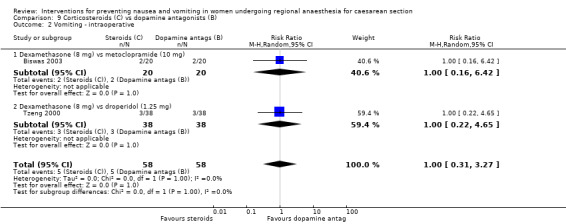
Comparison 9 Corticosteroids (C) vs dopamine antagonists (B), Outcome 2 Vomiting ‐ intraoperative.
9.4. Analysis.
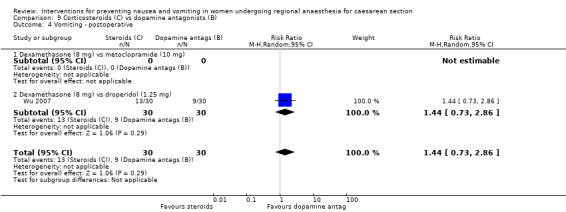
Comparison 9 Corticosteroids (C) vs dopamine antagonists (B), Outcome 4 Vomiting ‐ postoperative.
9.10. Analysis.
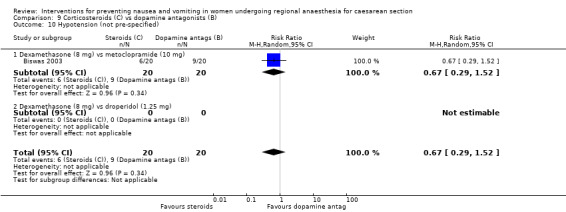
Comparison 9 Corticosteroids (C) vs dopamine antagonists (B), Outcome 10 Hypotension (not pre‐specified).
Comparison 11. Corticosteroids (C) ‐ Dexamethasone 2.5 mg vs 5 mg.
| Outcome or subgroup title | No. of studies | No. of participants | Statistical method | Effect size |
|---|---|---|---|---|
| 1 Nausea ‐ intraoperative | 0 | 0 | Risk Ratio (M‐H, Fixed, 95% CI) | 0.0 [0.0, 0.0] |
| 2 Vomiting ‐ intraoperative | 0 | 0 | Risk Ratio (M‐H, Fixed, 95% CI) | 0.0 [0.0, 0.0] |
| 3 Nausea ‐ postoperative | 1 | 88 | Risk Ratio (M‐H, Fixed, 95% CI) | 1.4 [0.48, 4.08] |
| 4 Vomiting ‐ postoperative | 1 | 88 | Risk Ratio (M‐H, Fixed, 95% CI) | 2.33 [0.64, 8.45] |
| 5 Maternal adverse effects | 0 | 0 | Risk Ratio (M‐H, Fixed, 95% CI) | 0.0 [0.0, 0.0] |
| 6 Apgar < 7 at 5 min | 0 | 0 | Risk Ratio (M‐H, Fixed, 95% CI) | 0.0 [0.0, 0.0] |
| 7 Initiation of breastfeeding | 0 | 0 | Risk Ratio (M‐H, Fixed, 95% CI) | 0.0 [0.0, 0.0] |
| 8 Duration of breastfeeding | 0 | 0 | Mean Difference (IV, Fixed, 95% CI) | 0.0 [0.0, 0.0] |
| 9 Maternal satisfaction | 0 | 0 | Risk Ratio (M‐H, Fixed, 95% CI) | 0.0 [0.0, 0.0] |
Comparison 12. Corticosteroids (C) ‐ Dexamethasone 2.5 mg vs 10 mg.
| Outcome or subgroup title | No. of studies | No. of participants | Statistical method | Effect size |
|---|---|---|---|---|
| 1 Nausea ‐ intraoperative | 0 | 0 | Risk Ratio (M‐H, Fixed, 95% CI) | 0.0 [0.0, 0.0] |
| 2 Vomiting ‐ intraoperative | 0 | 0 | Risk Ratio (M‐H, Fixed, 95% CI) | 0.0 [0.0, 0.0] |
| 3 Nausea ‐ postoperative | 1 | 87 | Risk Ratio (M‐H, Fixed, 95% CI) | 1.37 [0.47, 3.98] |
| 4 Vomiting ‐ postoperative | 1 | 87 | Risk Ratio (M‐H, Fixed, 95% CI) | 2.28 [0.63, 8.25] |
| 5 Maternal adverse effects | 0 | 0 | Risk Ratio (M‐H, Fixed, 95% CI) | 0.0 [0.0, 0.0] |
| 6 Apgar < 7 at 5 min | 0 | 0 | Risk Ratio (M‐H, Fixed, 95% CI) | 0.0 [0.0, 0.0] |
| 7 Initiation of breastfeeding | 0 | 0 | Risk Ratio (M‐H, Fixed, 95% CI) | 0.0 [0.0, 0.0] |
| 8 Duration of breastfeeding | 0 | 0 | Mean Difference (IV, Fixed, 95% CI) | 0.0 [0.0, 0.0] |
| 9 Maternal satisfaction | 0 | 0 | Risk Ratio (M‐H, Fixed, 95% CI) | 0.0 [0.0, 0.0] |
Comparison 13. Corticosteroids (C) ‐ Dexamethasone 5 mg vs 10 mg.
| Outcome or subgroup title | No. of studies | No. of participants | Statistical method | Effect size |
|---|---|---|---|---|
| 1 Nausea ‐ intraoperative | 0 | 0 | Risk Ratio (M‐H, Fixed, 95% CI) | 0.0 [0.0, 0.0] |
| 2 Vomiting ‐ intraoperative | 0 | 0 | Risk Ratio (M‐H, Fixed, 95% CI) | 0.0 [0.0, 0.0] |
| 3 Nausea ‐ postoperative | 1 | 87 | Risk Ratio (M‐H, Fixed, 95% CI) | 0.98 [0.30, 3.14] |
| 4 Vomiting ‐ postoperative | 1 | 87 | Risk Ratio (M‐H, Fixed, 95% CI) | 0.98 [0.21, 4.58] |
| 5 Maternal adverse effects | 0 | 0 | Risk Ratio (M‐H, Fixed, 95% CI) | 0.0 [0.0, 0.0] |
| 6 Apgar < 7 at 5 min | 0 | 0 | Risk Ratio (M‐H, Fixed, 95% CI) | 0.0 [0.0, 0.0] |
| 7 Initiation of breastfeeding | 0 | 0 | Risk Ratio (M‐H, Fixed, 95% CI) | 0.0 [0.0, 0.0] |
| 8 Duration of breastfeeding | 0 | 0 | Mean Difference (IV, Fixed, 95% CI) | 0.0 [0.0, 0.0] |
| 9 Maternal satisfaction | 0 | 0 | Risk Ratio (M‐H, Fixed, 95% CI) | 0.0 [0.0, 0.0] |
Comparison 14. Antihistamines (D) vs placebo.
| Outcome or subgroup title | No. of studies | No. of participants | Statistical method | Effect size |
|---|---|---|---|---|
| 1 Nausea ‐ intraoperative | 0 | 0 | Risk Ratio (M‐H, Random, 95% CI) | 0.0 [0.0, 0.0] |
| 1.1 Dimenhydrate ‐ 50 mg | 0 | 0 | Risk Ratio (M‐H, Random, 95% CI) | 0.0 [0.0, 0.0] |
| 1.2 Dimenhydrate ‐ 100 mg | 0 | 0 | Risk Ratio (M‐H, Random, 95% CI) | 0.0 [0.0, 0.0] |
| 1.3 Cyclizine ‐ 50 mg | 0 | 0 | Risk Ratio (M‐H, Random, 95% CI) | 0.0 [0.0, 0.0] |
| 2 Vomiting ‐ intraoperative | 0 | 0 | Risk Ratio (M‐H, Random, 95% CI) | 0.0 [0.0, 0.0] |
| 2.1 Dimenhydrate ‐ 50 mg | 0 | 0 | Risk Ratio (M‐H, Random, 95% CI) | 0.0 [0.0, 0.0] |
| 2.2 Dimenhydrate ‐ 100 mg | 0 | 0 | Risk Ratio (M‐H, Random, 95% CI) | 0.0 [0.0, 0.0] |
| 2.3 Cyclizine ‐ 50 mg | 0 | 0 | Risk Ratio (M‐H, Random, 95% CI) | 0.0 [0.0, 0.0] |
| 3 Nausea ‐ postoperative | 3 | 365 | Risk Ratio (M‐H, Random, 95% CI) | 0.39 [0.26, 0.59] |
| 3.1 Dimenhydrate ‐ 50 mg | 2 | 215 | Risk Ratio (M‐H, Random, 95% CI) | 0.38 [0.21, 0.69] |
| 3.2 Dimenhydrate ‐ 100 mg | 1 | 90 | Risk Ratio (M‐H, Random, 95% CI) | 0.17 [0.05, 0.57] |
| 3.3 Cyclizine ‐ 50 mg | 1 | 60 | Risk Ratio (M‐H, Random, 95% CI) | 0.5 [0.28, 0.88] |
| 4 Vomiting ‐ postoperative | 2 | 184 | Risk Ratio (M‐H, Random, 95% CI) | 0.50 [0.30, 0.86] |
| 4.1 Dimenhydrate ‐ 50 mg | 1 | 124 | Risk Ratio (M‐H, Random, 95% CI) | 0.52 [0.19, 1.42] |
| 4.2 Dimenhydrate ‐ 100 mg | 0 | 0 | Risk Ratio (M‐H, Random, 95% CI) | 0.0 [0.0, 0.0] |
| 4.3 Cyclizine ‐ 50 mg | 1 | 60 | Risk Ratio (M‐H, Random, 95% CI) | 0.5 [0.27, 0.93] |
| 5 Maternal adverse effects | 0 | 0 | Risk Ratio (M‐H, Random, 95% CI) | 0.0 [0.0, 0.0] |
| 5.1 Dimenhydrate ‐ 50 mg | 0 | 0 | Risk Ratio (M‐H, Random, 95% CI) | 0.0 [0.0, 0.0] |
| 5.2 Dimenhydrate ‐ 100 mg | 0 | 0 | Risk Ratio (M‐H, Random, 95% CI) | 0.0 [0.0, 0.0] |
| 5.3 Cyclizine ‐ 50 mg | 0 | 0 | Risk Ratio (M‐H, Random, 95% CI) | 0.0 [0.0, 0.0] |
| 6 Apgar < 7 at 5 min | 0 | 0 | Risk Ratio (M‐H, Random, 95% CI) | 0.0 [0.0, 0.0] |
| 6.1 Dimenhydrate ‐ 50 mg | 0 | 0 | Risk Ratio (M‐H, Random, 95% CI) | 0.0 [0.0, 0.0] |
| 6.2 Dimenhydrate ‐ 100 mg | 0 | 0 | Risk Ratio (M‐H, Random, 95% CI) | 0.0 [0.0, 0.0] |
| 6.3 Cyclizine ‐ 50 mg | 0 | 0 | Risk Ratio (M‐H, Random, 95% CI) | 0.0 [0.0, 0.0] |
| 7 Initiaition of breastfeeding | 0 | 0 | Risk Ratio (M‐H, Random, 95% CI) | 0.0 [0.0, 0.0] |
| 7.1 Dimenhydrate ‐ 50 mg | 0 | 0 | Risk Ratio (M‐H, Random, 95% CI) | 0.0 [0.0, 0.0] |
| 7.2 Dimenhydrate ‐ 100 mg | 0 | 0 | Risk Ratio (M‐H, Random, 95% CI) | 0.0 [0.0, 0.0] |
| 7.3 Cyclizine ‐ 50 mg | 0 | 0 | Risk Ratio (M‐H, Random, 95% CI) | 0.0 [0.0, 0.0] |
| 8 Duration of exclusive breastfeeding | 0 | 0 | Std. Mean Difference (IV, Random, 95% CI) | 0.0 [0.0, 0.0] |
| 8.1 Dimenhydrate ‐ 50 mg | 0 | 0 | Std. Mean Difference (IV, Random, 95% CI) | 0.0 [0.0, 0.0] |
| 8.2 Dimenhydrate ‐ 100 mg | 0 | 0 | Std. Mean Difference (IV, Random, 95% CI) | 0.0 [0.0, 0.0] |
| 8.3 Cyclizine ‐ 50 mg | 0 | 0 | Std. Mean Difference (IV, Random, 95% CI) | 0.0 [0.0, 0.0] |
| 9 Maternal satisfaction | 0 | 0 | Risk Ratio (M‐H, Random, 95% CI) | 0.0 [0.0, 0.0] |
| 9.1 Dimenhydrate ‐ 50 mg | 0 | 0 | Risk Ratio (M‐H, Random, 95% CI) | 0.0 [0.0, 0.0] |
| 9.2 Dimenhydrate ‐ 100 mg | 0 | 0 | Risk Ratio (M‐H, Random, 95% CI) | 0.0 [0.0, 0.0] |
| 9.3 Cyclizine ‐ 50 mg | 0 | 0 | Risk Ratio (M‐H, Random, 95% CI) | 0.0 [0.0, 0.0] |
Comparison 16. Antihistamines (D) vs dopamine antagonists (B).
| Outcome or subgroup title | No. of studies | No. of participants | Statistical method | Effect size |
|---|---|---|---|---|
| 1 Nausea ‐ intraoperative | 0 | 0 | Risk Ratio (M‐H, Random, 95% CI) | 0.0 [0.0, 0.0] |
| 1.1 Dimenhydrinate (50 mg) vs metoclopramide (10 mg) | 0 | 0 | Risk Ratio (M‐H, Random, 95% CI) | 0.0 [0.0, 0.0] |
| 2 Vomiting ‐ intraoperative | 0 | 0 | Risk Ratio (M‐H, Random, 95% CI) | 0.0 [0.0, 0.0] |
| 2.1 Dimenhydrinate (50 mg) vs metoclopramide (10 mg) | 0 | 0 | Risk Ratio (M‐H, Random, 95% CI) | 0.0 [0.0, 0.0] |
| 3 Nausea ‐ postoperative | 1 | 119 | Risk Ratio (M‐H, Random, 95% CI) | 0.52 [0.21, 1.31] |
| 3.1 Dimenhydrinate (50 mg) vs metoclopramide (10 mg) | 1 | 119 | Risk Ratio (M‐H, Random, 95% CI) | 0.52 [0.21, 1.31] |
| 4 Vomiting ‐ postoperative | 1 | 119 | Risk Ratio (M‐H, Random, 95% CI) | 0.37 [0.14, 0.96] |
| 4.1 Dimenhydrinate (50 mg) vs metoclopramide (10 mg) | 1 | 119 | Risk Ratio (M‐H, Random, 95% CI) | 0.37 [0.14, 0.96] |
| 5 Maternal adverse effects | 0 | 0 | Risk Ratio (M‐H, Random, 95% CI) | 0.0 [0.0, 0.0] |
| 5.1 Dimenhydrinate (50 mg) vs metoclopramide (10 mg) | 0 | 0 | Risk Ratio (M‐H, Random, 95% CI) | 0.0 [0.0, 0.0] |
| 6 Apgar < 7 at 5 min | 0 | 0 | Risk Ratio (M‐H, Random, 95% CI) | 0.0 [0.0, 0.0] |
| 6.1 Dimenhydrinate (50 mg) vs metoclopramide (10 mg) | 0 | 0 | Risk Ratio (M‐H, Random, 95% CI) | 0.0 [0.0, 0.0] |
| 7 Initiaition of breastfeeding | 0 | 0 | Risk Ratio (M‐H, Random, 95% CI) | 0.0 [0.0, 0.0] |
| 7.1 Dimenhydrinate (50 mg) vs metoclopramide (10 mg) | 0 | 0 | Risk Ratio (M‐H, Random, 95% CI) | 0.0 [0.0, 0.0] |
| 8 Duration of exclusive breastfeeding | 0 | 0 | Std. Mean Difference (IV, Random, 95% CI) | 0.0 [0.0, 0.0] |
| 8.1 Dimenhydrinate (50 mg) vs metoclopramide (10 mg) | 0 | 0 | Std. Mean Difference (IV, Random, 95% CI) | 0.0 [0.0, 0.0] |
| 9 Maternal satisfaction | 0 | 0 | Risk Ratio (M‐H, Random, 95% CI) | 0.0 [0.0, 0.0] |
| 9.1 Dimenhydrinate (50 mg) vs metoclopramide (10 mg) | 0 | 0 | Risk Ratio (M‐H, Random, 95% CI) | 0.0 [0.0, 0.0] |
Comparison 17. Antihistamines (D) vs corticosteroids (C).
| Outcome or subgroup title | No. of studies | No. of participants | Statistical method | Effect size |
|---|---|---|---|---|
| 1 Nausea ‐ intraoperative | 0 | 0 | Risk Ratio (M‐H, Random, 95% CI) | 0.0 [0.0, 0.0] |
| 1.1 Cyclizine (50 mg) vs dexamethasone (8 mg) | 0 | 0 | Risk Ratio (M‐H, Random, 95% CI) | 0.0 [0.0, 0.0] |
| 2 Vomiting ‐ intraoperative | 0 | 0 | Risk Ratio (M‐H, Random, 95% CI) | 0.0 [0.0, 0.0] |
| 2.1 Cyclizine (50 mg) vs dexamethasone (8 mg) | 0 | 0 | Risk Ratio (M‐H, Random, 95% CI) | 0.0 [0.0, 0.0] |
| 3 Nausea ‐ postoperative | 1 | 60 | Risk Ratio (M‐H, Random, 95% CI) | 0.56 [0.31, 1.00] |
| 3.1 Cyclizine (50 mg) vs dexamethasone (8 mg) | 1 | 60 | Risk Ratio (M‐H, Random, 95% CI) | 0.56 [0.31, 1.00] |
| 4 Vomiting ‐ postoperative | 1 | 60 | Risk Ratio (M‐H, Random, 95% CI) | 0.53 [0.28, 0.99] |
| 4.1 Cyclizine (50 mg) vs dexamethasone (8 mg) | 1 | 60 | Risk Ratio (M‐H, Random, 95% CI) | 0.53 [0.28, 0.99] |
| 5 Maternal adverse effects | 0 | 0 | Risk Ratio (M‐H, Random, 95% CI) | 0.0 [0.0, 0.0] |
| 5.1 Cyclizine (50 mg) vs dexamethasone (8 mg) | 0 | 0 | Risk Ratio (M‐H, Random, 95% CI) | 0.0 [0.0, 0.0] |
| 6 Apgar < 7 at 5 min | 0 | 0 | Risk Ratio (M‐H, Random, 95% CI) | 0.0 [0.0, 0.0] |
| 6.1 Cyclizine (50 mg) vs dexamethasone (8 mg) | 0 | 0 | Risk Ratio (M‐H, Random, 95% CI) | 0.0 [0.0, 0.0] |
| 7 Initiaition of breastfeeding | 0 | 0 | Risk Ratio (M‐H, Random, 95% CI) | 0.0 [0.0, 0.0] |
| 7.1 Cyclizine (50 mg) vs dexamethasone (8 mg) | 0 | 0 | Risk Ratio (M‐H, Random, 95% CI) | 0.0 [0.0, 0.0] |
| 8 Duration of exclusive breastfeeding | 0 | 0 | Std. Mean Difference (IV, Random, 95% CI) | 0.0 [0.0, 0.0] |
| 8.1 Cyclizine (50 mg) vs dexamethasone (8 mg) | 0 | 0 | Std. Mean Difference (IV, Random, 95% CI) | 0.0 [0.0, 0.0] |
| 9 Maternal satisfaction | 0 | 0 | Risk Ratio (M‐H, Random, 95% CI) | 0.0 [0.0, 0.0] |
| 9.1 Cyclizine (50 mg) vs dexamethasone (8 mg) | 0 | 0 | Risk Ratio (M‐H, Random, 95% CI) | 0.0 [0.0, 0.0] |
Comparison 19. Antihistamines (D) ‐ Dimenhydrate 100 mg vs 50 mg.
| Outcome or subgroup title | No. of studies | No. of participants | Statistical method | Effect size |
|---|---|---|---|---|
| 1 Nausea ‐ intraoperative | 0 | 0 | Risk Ratio (M‐H, Fixed, 95% CI) | 0.0 [0.0, 0.0] |
| 2 Vomiting ‐ intraoperative | 0 | 0 | Risk Ratio (M‐H, Fixed, 95% CI) | 0.0 [0.0, 0.0] |
| 3 Nausea ‐ postoperative | 1 | 122 | Risk Ratio (M‐H, Fixed, 95% CI) | 0.36 [0.10, 1.30] |
| 4 Vomiting ‐ postoperative | 0 | 0 | Risk Ratio (M‐H, Fixed, 95% CI) | 0.0 [0.0, 0.0] |
| 5 Maternal adverse effects | 0 | 0 | Risk Ratio (M‐H, Fixed, 95% CI) | 0.0 [0.0, 0.0] |
| 6 Apgar < 7 at 5 min | 0 | 0 | Risk Ratio (M‐H, Fixed, 95% CI) | 0.0 [0.0, 0.0] |
| 7 Initiation of breastfeeding | 0 | 0 | Risk Ratio (M‐H, Fixed, 95% CI) | 0.0 [0.0, 0.0] |
| 8 Duration of breastfeeding | 0 | 0 | Mean Difference (IV, Fixed, 95% CI) | 0.0 [0.0, 0.0] |
| 9 Maternal satisfaction | 0 | 0 | Risk Ratio (M‐H, Fixed, 95% CI) | 0.0 [0.0, 0.0] |
Comparison 20. Anticholinergics (E) vs placebo.
| Outcome or subgroup title | No. of studies | No. of participants | Statistical method | Effect size |
|---|---|---|---|---|
| 1 Nausea ‐ intraoperative | 4 | 453 | Risk Ratio (M‐H, Random, 95% CI) | 0.67 [0.51, 0.87] |
| 1.1 Glycopyrrolate ‐ 0.2 mg | 2 | 89 | Risk Ratio (M‐H, Random, 95% CI) | 0.49 [0.22, 1.09] |
| 1.2 Scopolamine patch | 2 | 364 | Risk Ratio (M‐H, Random, 95% CI) | 0.71 [0.51, 0.97] |
| 2 Vomiting ‐ intraoperative | 4 | 453 | Risk Ratio (M‐H, Random, 95% CI) | 0.79 [0.40, 1.54] |
| 2.1 Glycopyrrolate ‐ 0.2 mg | 2 | 89 | Risk Ratio (M‐H, Random, 95% CI) | 0.45 [0.12, 1.62] |
| 2.2 Scopolamine patch | 2 | 364 | Risk Ratio (M‐H, Random, 95% CI) | 0.96 [0.36, 2.59] |
| 3 Nausea ‐ postoperative | 0 | 0 | Risk Ratio (M‐H, Random, 95% CI) | 0.0 [0.0, 0.0] |
| 3.1 Glycopyrrolate ‐ 0.2 mg | 0 | 0 | Risk Ratio (M‐H, Random, 95% CI) | 0.0 [0.0, 0.0] |
| 3.2 Scopolamine patch | 0 | 0 | Risk Ratio (M‐H, Random, 95% CI) | 0.0 [0.0, 0.0] |
| 4 Vomiting ‐ postoperative | 1 | 161 | Risk Ratio (M‐H, Random, 95% CI) | 0.55 [0.41, 0.74] |
| 4.1 Glycopyrrolate ‐ 0.2 mg | 0 | 0 | Risk Ratio (M‐H, Random, 95% CI) | 0.0 [0.0, 0.0] |
| 4.2 Scopolamine patch | 1 | 161 | Risk Ratio (M‐H, Random, 95% CI) | 0.55 [0.41, 0.74] |
| 5 Maternal adverse effects | 0 | 0 | Risk Ratio (M‐H, Random, 95% CI) | 0.0 [0.0, 0.0] |
| 5.1 Glycopyrrolate ‐ 0.2 mg | 0 | 0 | Risk Ratio (M‐H, Random, 95% CI) | 0.0 [0.0, 0.0] |
| 5.2 Scopolamine patch | 0 | 0 | Risk Ratio (M‐H, Random, 95% CI) | 0.0 [0.0, 0.0] |
| 6 Apgar < 7 at 5 min | 0 | 0 | Risk Ratio (M‐H, Random, 95% CI) | 0.0 [0.0, 0.0] |
| 6.1 Glycopyrrolate ‐ 0.2 mg | 0 | 0 | Risk Ratio (M‐H, Random, 95% CI) | 0.0 [0.0, 0.0] |
| 6.2 Scopolamine patch | 0 | 0 | Risk Ratio (M‐H, Random, 95% CI) | 0.0 [0.0, 0.0] |
| 7 Initiaition of breastfeeding | 0 | 0 | Risk Ratio (M‐H, Random, 95% CI) | 0.0 [0.0, 0.0] |
| 7.1 Glycopyrrolate ‐ 0.2 mg | 0 | 0 | Risk Ratio (M‐H, Random, 95% CI) | 0.0 [0.0, 0.0] |
| 7.2 Scopolamine patch | 0 | 0 | Risk Ratio (M‐H, Random, 95% CI) | 0.0 [0.0, 0.0] |
| 8 Duration of exclusive breastfeeding | 0 | 0 | Std. Mean Difference (IV, Random, 95% CI) | 0.0 [0.0, 0.0] |
| 8.1 Glycopyrrolate ‐ 0.2 mg | 0 | 0 | Std. Mean Difference (IV, Random, 95% CI) | 0.0 [0.0, 0.0] |
| 8.2 Scopolamine patch | 0 | 0 | Std. Mean Difference (IV, Random, 95% CI) | 0.0 [0.0, 0.0] |
| 9 Maternal satisfaction | 0 | 0 | Risk Ratio (M‐H, Random, 95% CI) | 0.0 [0.0, 0.0] |
| 9.1 Glycopyrrolate ‐ 0.2 mg | 0 | 0 | Risk Ratio (M‐H, Random, 95% CI) | 0.0 [0.0, 0.0] |
| 9.2 Scopolamine patch | 0 | 0 | Risk Ratio (M‐H, Random, 95% CI) | 0.0 [0.0, 0.0] |
| 10 Blurred vision (not pre‐specified) | 1 | 203 | Risk Ratio (M‐H, Random, 95% CI) | 1.98 [0.37, 10.57] |
| 10.1 Glycopyrrolate ‐ 0.2 mg | 0 | 0 | Risk Ratio (M‐H, Random, 95% CI) | 0.0 [0.0, 0.0] |
| 10.2 Scopolamine patch | 1 | 203 | Risk Ratio (M‐H, Random, 95% CI) | 1.98 [0.37, 10.57] |
| 11 Disorientation (not pre‐specified) | 1 | 203 | Risk Ratio (M‐H, Random, 95% CI) | 2.97 [0.12, 72.08] |
| 11.1 Glycopyrrolate ‐ 0.2 mg | 0 | 0 | Risk Ratio (M‐H, Random, 95% CI) | 0.0 [0.0, 0.0] |
| 11.2 Scopolamine patch | 1 | 203 | Risk Ratio (M‐H, Random, 95% CI) | 2.97 [0.12, 72.08] |
| 12 Dizziness (not pre‐specified) | 1 | 203 | Risk Ratio (M‐H, Random, 95% CI) | 0.99 [0.39, 2.54] |
| 12.1 Glycopyrrolate ‐ 0.2 mg | 0 | 0 | Risk Ratio (M‐H, Random, 95% CI) | 0.0 [0.0, 0.0] |
| 12.2 Scopolamine patch | 1 | 203 | Risk Ratio (M‐H, Random, 95% CI) | 0.99 [0.39, 2.54] |
| 13 Hypotension (not pre‐specified) | 2 | 89 | Risk Ratio (M‐H, Random, 95% CI) | 0.79 [0.50, 1.26] |
| 13.1 Glycopyrrolate ‐ 0.2 mg | 2 | 89 | Risk Ratio (M‐H, Random, 95% CI) | 0.79 [0.50, 1.26] |
| 13.2 Scopolamine patch | 0 | 0 | Risk Ratio (M‐H, Random, 95% CI) | 0.0 [0.0, 0.0] |
| 14 Pruritus (not pre‐specified) | 1 | 203 | Risk Ratio (M‐H, Random, 95% CI) | 0.92 [0.66, 1.28] |
| 14.1 Glycopyrrolate ‐ 0.2 mg | 0 | 0 | Risk Ratio (M‐H, Random, 95% CI) | 0.0 [0.0, 0.0] |
| 14.2 Scopolamine patch | 1 | 203 | Risk Ratio (M‐H, Random, 95% CI) | 0.92 [0.66, 1.28] |
20.11. Analysis.
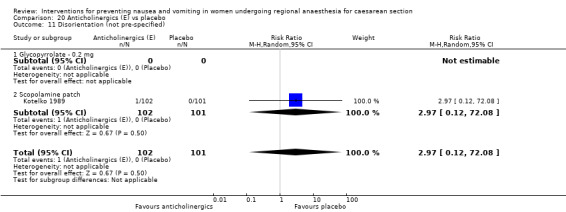
Comparison 20 Anticholinergics (E) vs placebo, Outcome 11 Disorientation (not pre‐specified).
20.12. Analysis.
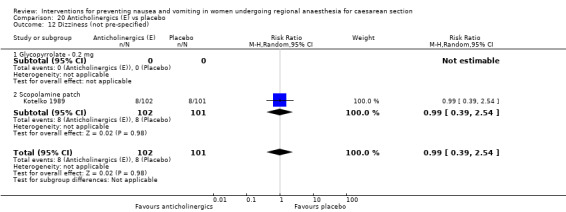
Comparison 20 Anticholinergics (E) vs placebo, Outcome 12 Dizziness (not pre‐specified).
20.13. Analysis.
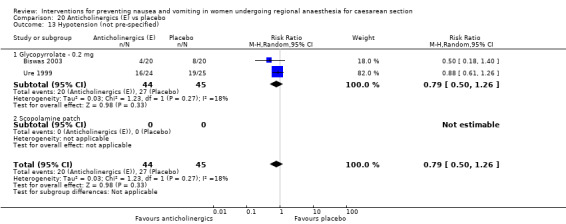
Comparison 20 Anticholinergics (E) vs placebo, Outcome 13 Hypotension (not pre‐specified).
Comparison 21. Anticholinergic (E) vs 5‐HT3 antagonist (A).
| Outcome or subgroup title | No. of studies | No. of participants | Statistical method | Effect size |
|---|---|---|---|---|
| 1 Nausea ‐ intraoperative | 1 | 159 | Risk Ratio (M‐H, Random, 95% CI) | 1.06 [0.80, 1.40] |
| 1.1 Scopolamine 1.5 mg vs Ondansetron 4 mg | 1 | 159 | Risk Ratio (M‐H, Random, 95% CI) | 1.06 [0.80, 1.40] |
| 2 Vomiting ‐ intraoperative | 1 | 159 | Risk Ratio (M‐H, Random, 95% CI) | 0.93 [0.49, 1.74] |
| 2.1 Scopolamine 1.5 mg vs Ondansetron 4 mg | 1 | 159 | Risk Ratio (M‐H, Random, 95% CI) | 0.93 [0.49, 1.74] |
| 3 Nausea ‐ postoperative | 0 | 0 | Risk Ratio (M‐H, Random, 95% CI) | 0.0 [0.0, 0.0] |
| 3.1 Scopolamine 1.5 mg vs Ondansetron 4 mg | 0 | 0 | Risk Ratio (M‐H, Random, 95% CI) | 0.0 [0.0, 0.0] |
| 4 Vomiting ‐ postoperative | 1 | 159 | Risk Ratio (M‐H, Random, 95% CI) | 0.96 [0.66, 1.39] |
| 4.1 Scopolamine 1.5 mg vs Ondansetron 4 mg | 1 | 159 | Risk Ratio (M‐H, Random, 95% CI) | 0.96 [0.66, 1.39] |
| 5 Maternal adverse effects | 0 | 0 | Risk Ratio (M‐H, Random, 95% CI) | 0.0 [0.0, 0.0] |
| 5.1 Scopolamine 1.5 mg vs Ondansetron 4 mg | 0 | 0 | Risk Ratio (M‐H, Random, 95% CI) | 0.0 [0.0, 0.0] |
| 6 Apgar < 7 at 5min | 0 | 0 | Risk Ratio (M‐H, Random, 95% CI) | 0.0 [0.0, 0.0] |
| 6.1 Scopolamine 1.5 mg vs Ondansetron 4 mg | 0 | 0 | Risk Ratio (M‐H, Random, 95% CI) | 0.0 [0.0, 0.0] |
| 7 Initiaition of breastfeeding | 0 | 0 | Risk Ratio (M‐H, Random, 95% CI) | 0.0 [0.0, 0.0] |
| 7.1 Scopolamine 1.5 mg vs Ondansetron 4 mg | 0 | 0 | Risk Ratio (M‐H, Random, 95% CI) | 0.0 [0.0, 0.0] |
| 8 Duration of exclusive breastfeeding | 0 | 0 | Std. Mean Difference (IV, Random, 95% CI) | 0.0 [0.0, 0.0] |
| 8.1 Scopalamine 1.5 mg vs Ondansetron 4 mg | 0 | 0 | Std. Mean Difference (IV, Random, 95% CI) | 0.0 [0.0, 0.0] |
| 9 Maternal satisfaction | 0 | 0 | Risk Ratio (M‐H, Random, 95% CI) | 0.0 [0.0, 0.0] |
| 9.1 Scopolamine 1.5 mg vs Ondansetron 4 mg | 0 | 0 | Risk Ratio (M‐H, Random, 95% CI) | 0.0 [0.0, 0.0] |
21.2. Analysis.

Comparison 21 Anticholinergic (E) vs 5‐HT3 antagonist (A), Outcome 2 Vomiting ‐ intraoperative.
21.4. Analysis.

Comparison 21 Anticholinergic (E) vs 5‐HT3 antagonist (A), Outcome 4 Vomiting ‐ postoperative.
Comparison 22. Anticholenergic (E) vs dopamine antagonist (B).
| Outcome or subgroup title | No. of studies | No. of participants | Statistical method | Effect size |
|---|---|---|---|---|
| 1 Nausea ‐ intraoperative | 1 | 40 | Risk Ratio (M‐H, Random, 95% CI) | 0.5 [0.10, 2.43] |
| 1.1 Glycopyrrolate (0.2 mg) vs metoclopramide (10 mg) | 1 | 40 | Risk Ratio (M‐H, Random, 95% CI) | 0.5 [0.10, 2.43] |
| 2 Vomiting ‐ intraoperative | 1 | 40 | Risk Ratio (M‐H, Random, 95% CI) | 0.5 [0.05, 5.08] |
| 2.1 Glycopyrrolate (0.2 mg) vs metoclopramide (10 mg) | 1 | 40 | Risk Ratio (M‐H, Random, 95% CI) | 0.5 [0.05, 5.08] |
| 3 Nausea ‐ postoperative | 0 | 0 | Risk Ratio (M‐H, Random, 95% CI) | 0.0 [0.0, 0.0] |
| 3.1 Glycopyrrolate (0.2 mg) vs metoclopramide (10 mg) | 0 | 0 | Risk Ratio (M‐H, Random, 95% CI) | 0.0 [0.0, 0.0] |
| 4 Vomiting ‐ postoperative | 0 | 0 | Risk Ratio (M‐H, Random, 95% CI) | 0.0 [0.0, 0.0] |
| 4.1 Glycopyrrolate (0.2 mg) vs metoclopramide (10 mg) | 0 | 0 | Risk Ratio (M‐H, Random, 95% CI) | 0.0 [0.0, 0.0] |
| 5 Maternal adverse effects | 0 | 0 | Risk Ratio (M‐H, Random, 95% CI) | 0.0 [0.0, 0.0] |
| 5.1 Glycopyrrolate (0.2 mg) vs metoclopramide (10 mg) | 0 | 0 | Risk Ratio (M‐H, Random, 95% CI) | 0.0 [0.0, 0.0] |
| 6 Apgar < 7 at 5 min | 0 | 0 | Risk Ratio (M‐H, Random, 95% CI) | 0.0 [0.0, 0.0] |
| 6.1 Glycopyrrolate (0.2 mg) vs metoclopramide (10 mg) | 0 | 0 | Risk Ratio (M‐H, Random, 95% CI) | 0.0 [0.0, 0.0] |
| 7 Initiaition of breastfeeding | 0 | 0 | Risk Ratio (M‐H, Random, 95% CI) | 0.0 [0.0, 0.0] |
| 7.1 Glycopyrrolate (0.2 mg) vs metoclopramide (10 mg) | 0 | 0 | Risk Ratio (M‐H, Random, 95% CI) | 0.0 [0.0, 0.0] |
| 8 Duration of exclusive breastfeeding | 0 | 0 | Std. Mean Difference (IV, Random, 95% CI) | 0.0 [0.0, 0.0] |
| 8.1 Glycopyrrolate (0.2 mg) vs metoclopramide (10 mg) | 0 | 0 | Std. Mean Difference (IV, Random, 95% CI) | 0.0 [0.0, 0.0] |
| 9 Maternal satisfaction | 0 | 0 | Risk Ratio (M‐H, Random, 95% CI) | 0.0 [0.0, 0.0] |
| 9.1 Glycopyrrolate (0.2 mg) vs metoclopramide (10 mg) | 0 | 0 | Risk Ratio (M‐H, Random, 95% CI) | 0.0 [0.0, 0.0] |
| 10 Heart rate < 60 beats/min (not pre‐specified) | 0 | 0 | Risk Ratio (M‐H, Random, 95% CI) | 0.0 [0.0, 0.0] |
| 10.1 Glycopyrrolate (0.2 mg) vs metoclopramide (10 mg) | 0 | 0 | Risk Ratio (M‐H, Random, 95% CI) | 0.0 [0.0, 0.0] |
| 11 Hypotension (not pre‐specified) | 1 | 40 | Risk Ratio (M‐H, Random, 95% CI) | 0.44 [0.16, 1.21] |
| 11.1 Glycopyrrolate (0.2 mg) vs metoclopramide (10 mg) | 1 | 40 | Risk Ratio (M‐H, Random, 95% CI) | 0.44 [0.16, 1.21] |
22.2. Analysis.

Comparison 22 Anticholenergic (E) vs dopamine antagonist (B), Outcome 2 Vomiting ‐ intraoperative.
Comparison 23. Anticholenergic (E) vs corticosteroids (C).
| Outcome or subgroup title | No. of studies | No. of participants | Statistical method | Effect size |
|---|---|---|---|---|
| 1 Nausea ‐ intraoperative | 1 | 40 | Risk Ratio (M‐H, Random, 95% CI) | 1.0 [0.16, 6.42] |
| 1.1 Glycopyrrolate (0.2 mg) vs dexamethasone (8 mg) | 1 | 40 | Risk Ratio (M‐H, Random, 95% CI) | 1.0 [0.16, 6.42] |
| 2 Vomiting ‐ intraoperative | 1 | 40 | Risk Ratio (M‐H, Random, 95% CI) | 0.5 [0.05, 5.08] |
| 2.1 Glycopyrrolate (0.2 mg) vs dexamethasone (8 mg) | 1 | 40 | Risk Ratio (M‐H, Random, 95% CI) | 0.5 [0.05, 5.08] |
| 3 Nausea ‐ postoperative | 0 | 0 | Risk Ratio (M‐H, Random, 95% CI) | 0.0 [0.0, 0.0] |
| 3.1 Glycopyrrolate (0.2 mg) vs dexamethasone (8 mg) | 0 | 0 | Risk Ratio (M‐H, Random, 95% CI) | 0.0 [0.0, 0.0] |
| 4 Vomiting ‐ postoperative | 0 | 0 | Risk Ratio (M‐H, Random, 95% CI) | 0.0 [0.0, 0.0] |
| 4.1 Glycopyrrolate (0.2 mg) vs dexamethasone (8 mg) | 0 | 0 | Risk Ratio (M‐H, Random, 95% CI) | 0.0 [0.0, 0.0] |
| 5 Maternal adverse effects | 0 | 0 | Risk Ratio (M‐H, Random, 95% CI) | 0.0 [0.0, 0.0] |
| 5.1 Glycopyrrolate (0.2 mg) vs dexamethasone (8 mg) | 0 | 0 | Risk Ratio (M‐H, Random, 95% CI) | 0.0 [0.0, 0.0] |
| 6 Apgar < 7 at 5 min | 0 | 0 | Risk Ratio (M‐H, Random, 95% CI) | 0.0 [0.0, 0.0] |
| 6.1 Glycopyrrolate (0.2 mg) vs dexamethasone (8 mg) | 0 | 0 | Risk Ratio (M‐H, Random, 95% CI) | 0.0 [0.0, 0.0] |
| 7 Initiaition of breastfeeding | 0 | 0 | Risk Ratio (M‐H, Random, 95% CI) | 0.0 [0.0, 0.0] |
| 7.1 Glycopyrrolate (0.2 mg) vs dexamethasone (8 mg) | 0 | 0 | Risk Ratio (M‐H, Random, 95% CI) | 0.0 [0.0, 0.0] |
| 8 Duration of exclusive breastfeeding | 0 | 0 | Std. Mean Difference (IV, Random, 95% CI) | 0.0 [0.0, 0.0] |
| 8.1 Glycopyrrolate (0.2 mg) vs dexamethasone (8 mg) | 0 | 0 | Std. Mean Difference (IV, Random, 95% CI) | 0.0 [0.0, 0.0] |
| 9 Maternal satisfaction | 0 | 0 | Risk Ratio (M‐H, Random, 95% CI) | 0.0 [0.0, 0.0] |
| 9.1 Glycopyrrolate (0.2 mg) vs dexamethasone (8 mg) | 0 | 0 | Risk Ratio (M‐H, Random, 95% CI) | 0.0 [0.0, 0.0] |
| 10 Hypotension (not pre‐specified) | 1 | 40 | Risk Ratio (M‐H, Random, 95% CI) | 0.67 [0.22, 2.01] |
| 10.1 Glycopyrrolate (0.2 mg) vs dexamethasone (8 mg) | 1 | 40 | Risk Ratio (M‐H, Random, 95% CI) | 0.67 [0.22, 2.01] |
23.2. Analysis.

Comparison 23 Anticholenergic (E) vs corticosteroids (C), Outcome 2 Vomiting ‐ intraoperative.
Comparison 26. Sedatives (F) vs placebo.
| Outcome or subgroup title | No. of studies | No. of participants | Statistical method | Effect size |
|---|---|---|---|---|
| 1 Nausea ‐ intraoperative | 4 | 285 | Risk Ratio (M‐H, Random, 95% CI) | 0.71 [0.52, 0.96] |
| 1.1 Propofol ‐ 0.5 mg/kg/hr | 1 | 26 | Risk Ratio (M‐H, Random, 95% CI) | 0.75 [0.19, 2.93] |
| 1.2 Propofol ‐ 1.0 mg/kg/hr | 2 | 87 | Risk Ratio (M‐H, Random, 95% CI) | 0.33 [0.11, 0.96] |
| 1.3 Propofol ‐ 1.5 mg/kg/hr | 1 | 27 | Risk Ratio (M‐H, Random, 95% CI) | 0.35 [0.09, 1.35] |
| 1.4 Propofol ‐ 2.0 mg/kg/hr | 0 | 0 | Risk Ratio (M‐H, Random, 95% CI) | 0.0 [0.0, 0.0] |
| 1.5 Propofol ‐ 10 mg IV ‐ single dose | 1 | 57 | Risk Ratio (M‐H, Random, 95% CI) | 1.19 [0.39, 3.67] |
| 1.6 Propofol ‐ 20 mg + 1.0 mg/kg/hr | 1 | 44 | Risk Ratio (M‐H, Random, 95% CI) | 0.78 [0.46, 1.32] |
| 1.7 Midazolam ‐ 1.0 mg + 1.0 mg/hr | 1 | 44 | Risk Ratio (M‐H, Random, 95% CI) | 0.75 [0.47, 1.20] |
| 2 Vomiting ‐ intraoperative | 4 | 285 | Risk Ratio (M‐H, Random, 95% CI) | 0.42 [0.26, 0.68] |
| 2.1 Propofol ‐ 0.5 mg/kg/hr | 1 | 26 | Risk Ratio (M‐H, Random, 95% CI) | 0.9 [0.24, 3.35] |
| 2.2 Propofol ‐ 1.0 mg/kg/hr | 2 | 87 | Risk Ratio (M‐H, Random, 95% CI) | 0.34 [0.15, 0.78] |
| 2.3 Propofol ‐ 1.5 mg/kg/hr | 1 | 27 | Risk Ratio (M‐H, Random, 95% CI) | 0.23 [0.05, 1.12] |
| 2.4 Propofol ‐ 2.0 mg/kg/hr | 0 | 0 | Risk Ratio (M‐H, Random, 95% CI) | 0.0 [0.0, 0.0] |
| 2.5 Propofol ‐ 10 mg IV ‐ single dose | 1 | 57 | Risk Ratio (M‐H, Random, 95% CI) | 0.60 [0.06, 6.21] |
| 2.6 Propofol ‐ 20 mg + 1.0 mg/kg/hr | 1 | 44 | Risk Ratio (M‐H, Random, 95% CI) | 0.28 [0.08, 1.01] |
| 2.7 Midazolam ‐ 1.0 mg + 1.0 mg/hr | 1 | 44 | Risk Ratio (M‐H, Random, 95% CI) | 0.56 [0.21, 1.53] |
| 3 Nausea ‐ postoperative | 2 | 145 | Risk Ratio (M‐H, Random, 95% CI) | 0.25 [0.09, 0.71] |
| 3.1 Propofol ‐ 0.5 mg/kg/hr | 0 | 0 | Risk Ratio (M‐H, Random, 95% CI) | 0.0 [0.0, 0.0] |
| 3.2 Propofol ‐ 1.0 mg/kg/hr | 0 | 0 | Risk Ratio (M‐H, Random, 95% CI) | 0.0 [0.0, 0.0] |
| 3.3 Propofol ‐ 1.5 mg/kg/hr | 0 | 0 | Risk Ratio (M‐H, Random, 95% CI) | 0.0 [0.0, 0.0] |
| 3.4 Propofol ‐ 2.0 mg/kg/hr | 0 | 0 | Risk Ratio (M‐H, Random, 95% CI) | 0.0 [0.0, 0.0] |
| 3.5 Propofol ‐ 10 mg IV ‐ single dose | 1 | 57 | Risk Ratio (M‐H, Random, 95% CI) | 2.38 [0.23, 24.83] |
| 3.6 Propofol ‐ 20 mg + 1.0 mg/kg/hr | 1 | 44 | Risk Ratio (M‐H, Random, 95% CI) | 0.16 [0.06, 0.40] |
| 3.7 Midazolam ‐ 1.0 mg + 1.0 mg/hr | 1 | 44 | Risk Ratio (M‐H, Random, 95% CI) | 0.18 [0.08, 0.40] |
| 4 Vomiting ‐ postoperative | 2 | 145 | Risk Ratio (M‐H, Random, 95% CI) | 0.09 [0.03, 0.28] |
| 4.1 Propofol ‐ 0.5 mg/kg/hr | 0 | 0 | Risk Ratio (M‐H, Random, 95% CI) | 0.0 [0.0, 0.0] |
| 4.2 Propofol ‐ 1.0 mg/kg/hr | 0 | 0 | Risk Ratio (M‐H, Random, 95% CI) | 0.0 [0.0, 0.0] |
| 4.3 Propofol ‐ 1.5 mg/kg/hr | 0 | 0 | Risk Ratio (M‐H, Random, 95% CI) | 0.0 [0.0, 0.0] |
| 4.4 Propofol ‐ 2.0 mg/kg/hr | 0 | 0 | Risk Ratio (M‐H, Random, 95% CI) | 0.0 [0.0, 0.0] |
| 4.5 Propofol ‐ 10 mg IV ‐ single dose | 1 | 57 | Risk Ratio (M‐H, Random, 95% CI) | 0.40 [0.02, 9.31] |
| 4.6 Propofol ‐ 2 0 mg + 1.0 mg/kg/hr | 1 | 44 | Risk Ratio (M‐H, Random, 95% CI) | 0.02 [0.00, 0.37] |
| 4.7 Midazolam ‐ 1.0 mg + 1.0 mg/hr | 1 | 44 | Risk Ratio (M‐H, Random, 95% CI) | 0.09 [0.02, 0.37] |
| 5 Maternal adverse effects | 0 | 0 | Risk Ratio (M‐H, Random, 95% CI) | 0.0 [0.0, 0.0] |
| 5.1 Propofol ‐ 0.5 mg/kg/hr | 0 | 0 | Risk Ratio (M‐H, Random, 95% CI) | 0.0 [0.0, 0.0] |
| 5.2 Propofol ‐ 1.0 mg/kg/hr | 0 | 0 | Risk Ratio (M‐H, Random, 95% CI) | 0.0 [0.0, 0.0] |
| 5.3 Propofol ‐ 1.5 mg/kg/hr | 0 | 0 | Risk Ratio (M‐H, Random, 95% CI) | 0.0 [0.0, 0.0] |
| 5.4 Propofol ‐ 2.0 mg/kg/hr | 0 | 0 | Risk Ratio (M‐H, Random, 95% CI) | 0.0 [0.0, 0.0] |
| 5.5 Propofol ‐ 10 mg IV ‐ single dose | 0 | 0 | Risk Ratio (M‐H, Random, 95% CI) | 0.0 [0.0, 0.0] |
| 5.6 Propofol ‐ 20 mg + 1.0 mg/kg/hr | 0 | 0 | Risk Ratio (M‐H, Random, 95% CI) | 0.0 [0.0, 0.0] |
| 5.7 Midazolam ‐ 1.0 mg + 1.0 mg/hr | 0 | 0 | Risk Ratio (M‐H, Random, 95% CI) | 0.0 [0.0, 0.0] |
| 6 Apgar < 7 at 5 min | 0 | 0 | Risk Ratio (M‐H, Random, 95% CI) | 0.0 [0.0, 0.0] |
| 6.1 Propofol ‐ 0.5 mg/kg/hr | 0 | 0 | Risk Ratio (M‐H, Random, 95% CI) | 0.0 [0.0, 0.0] |
| 6.2 Propofol ‐ 1.0 mg/kg/hr | 0 | 0 | Risk Ratio (M‐H, Random, 95% CI) | 0.0 [0.0, 0.0] |
| 6.3 Propofol ‐ 1.5 mg/kg/hr | 0 | 0 | Risk Ratio (M‐H, Random, 95% CI) | 0.0 [0.0, 0.0] |
| 6.4 Propofol ‐ 2.0 mg/kg/hr | 0 | 0 | Risk Ratio (M‐H, Random, 95% CI) | 0.0 [0.0, 0.0] |
| 6.5 Propofol ‐ 10 mg IV ‐ single dose | 0 | 0 | Risk Ratio (M‐H, Random, 95% CI) | 0.0 [0.0, 0.0] |
| 6.6 Propofol ‐ 20 mg + 1.0 mg/kg/hr | 0 | 0 | Risk Ratio (M‐H, Random, 95% CI) | 0.0 [0.0, 0.0] |
| 6.7 Midazolam ‐ 1.0 mg + 1.0 mg/hr | 0 | 0 | Risk Ratio (M‐H, Random, 95% CI) | 0.0 [0.0, 0.0] |
| 7 Initiaition of breastfeeding | 0 | 0 | Risk Ratio (M‐H, Random, 95% CI) | 0.0 [0.0, 0.0] |
| 7.1 Propofol ‐ 0.5 mg/kg/hr | 0 | 0 | Risk Ratio (M‐H, Random, 95% CI) | 0.0 [0.0, 0.0] |
| 7.2 Propofol ‐ 1.0 mg/kg/hr | 0 | 0 | Risk Ratio (M‐H, Random, 95% CI) | 0.0 [0.0, 0.0] |
| 7.3 Propofol ‐ 1.5 mg/kg/hr | 0 | 0 | Risk Ratio (M‐H, Random, 95% CI) | 0.0 [0.0, 0.0] |
| 7.4 Propofol ‐ 2.0 mg/kg/hr | 0 | 0 | Risk Ratio (M‐H, Random, 95% CI) | 0.0 [0.0, 0.0] |
| 7.5 Propofol ‐ 10 mg IV ‐ single dose | 0 | 0 | Risk Ratio (M‐H, Random, 95% CI) | 0.0 [0.0, 0.0] |
| 7.6 Propofol ‐ 20 mg + 1.0 mg/kg/hr | 0 | 0 | Risk Ratio (M‐H, Random, 95% CI) | 0.0 [0.0, 0.0] |
| 7.7 Midazolam ‐ 1.0 mg + 1.0 mg/hr | 0 | 0 | Risk Ratio (M‐H, Random, 95% CI) | 0.0 [0.0, 0.0] |
| 8 Duration of exclusive breastfeeding | 0 | 0 | Std. Mean Difference (IV, Random, 95% CI) | 0.0 [0.0, 0.0] |
| 8.1 Propofol ‐ 0.5 mg/kg/hr | 0 | 0 | Std. Mean Difference (IV, Random, 95% CI) | 0.0 [0.0, 0.0] |
| 8.2 Propofol ‐ 1.0 mg/kg/hr | 0 | 0 | Std. Mean Difference (IV, Random, 95% CI) | 0.0 [0.0, 0.0] |
| 8.3 Propofol ‐ 1.5 mg/kg/hr | 0 | 0 | Std. Mean Difference (IV, Random, 95% CI) | 0.0 [0.0, 0.0] |
| 8.4 Propofol ‐ 2.0 mg/kg/hr | 0 | 0 | Std. Mean Difference (IV, Random, 95% CI) | 0.0 [0.0, 0.0] |
| 8.5 Propofol ‐ 10 mg IV ‐ single dose | 0 | 0 | Std. Mean Difference (IV, Random, 95% CI) | 0.0 [0.0, 0.0] |
| 8.6 Propofol ‐ 20 mg + 1.0mg/kg/hr | 0 | 0 | Std. Mean Difference (IV, Random, 95% CI) | 0.0 [0.0, 0.0] |
| 8.7 Midazolam ‐ 1.0 mg + 1.0 mg/kg | 0 | 0 | Std. Mean Difference (IV, Random, 95% CI) | 0.0 [0.0, 0.0] |
| 9 Maternal satisfaction | 0 | 0 | Risk Ratio (M‐H, Random, 95% CI) | 0.0 [0.0, 0.0] |
| 9.1 Propofol ‐ 0.5 mg/kg/hr | 0 | 0 | Risk Ratio (M‐H, Random, 95% CI) | 0.0 [0.0, 0.0] |
| 9.2 Propofol ‐ 1.0 mg/kg/hr | 0 | 0 | Risk Ratio (M‐H, Random, 95% CI) | 0.0 [0.0, 0.0] |
| 9.3 Propofol ‐ 1.5 mg/kg/hr | 0 | 0 | Risk Ratio (M‐H, Random, 95% CI) | 0.0 [0.0, 0.0] |
| 9.4 Propofol ‐ 2.0 mg/kg/hr | 0 | 0 | Risk Ratio (M‐H, Random, 95% CI) | 0.0 [0.0, 0.0] |
| 9.5 Propofol ‐ 10 mg IV ‐ single dose | 0 | 0 | Risk Ratio (M‐H, Random, 95% CI) | 0.0 [0.0, 0.0] |
| 9.6 Propofol ‐ 20 mg + 1.0 mg/kg/hr | 0 | 0 | Risk Ratio (M‐H, Random, 95% CI) | 0.0 [0.0, 0.0] |
| 9.7 Midazolam ‐ 1.0 mg + 1.0 mg/hr | 0 | 0 | Risk Ratio (M‐H, Random, 95% CI) | 0.0 [0.0, 0.0] |
| 10 Respiratory depression (not pre‐specified) | 0 | 0 | Risk Ratio (M‐H, Random, 95% CI) | 0.0 [0.0, 0.0] |
| 10.1 Propofol ‐ 0.5 mg/kg/hr | 0 | 0 | Risk Ratio (M‐H, Random, 95% CI) | 0.0 [0.0, 0.0] |
| 10.2 Propofol ‐ 1.0 mg/kg/hr | 0 | 0 | Risk Ratio (M‐H, Random, 95% CI) | 0.0 [0.0, 0.0] |
| 10.3 Propofol ‐ 1.5 mg/kg/hr | 0 | 0 | Risk Ratio (M‐H, Random, 95% CI) | 0.0 [0.0, 0.0] |
| 10.4 Propofol ‐ 2.0 mg/kg/hr | 0 | 0 | Risk Ratio (M‐H, Random, 95% CI) | 0.0 [0.0, 0.0] |
| 10.5 Propofol ‐ 10 mg IV ‐ single dose | 0 | 0 | Risk Ratio (M‐H, Random, 95% CI) | 0.0 [0.0, 0.0] |
| 10.6 Propofol ‐ 20 mg + 1.0 mg/kg/hr | 0 | 0 | Risk Ratio (M‐H, Random, 95% CI) | 0.0 [0.0, 0.0] |
| 10.7 Midazolam ‐ 1.0 mg + 1.0 mg/hr | 0 | 0 | Risk Ratio (M‐H, Random, 95% CI) | 0.0 [0.0, 0.0] |
Comparison 28. Sedatives (F) vs dopamine antagonists (B).
| Outcome or subgroup title | No. of studies | No. of participants | Statistical method | Effect size |
|---|---|---|---|---|
| 1 Nausea ‐ intraoperative | 1 | 80 | Risk Ratio (M‐H, Random, 95% CI) | 0.29 [0.13, 0.63] |
| 1.1 Propofol (1 mg/kg/hr) vs metoclopramide (10 mg) | 0 | 0 | Risk Ratio (M‐H, Random, 95% CI) | 0.0 [0.0, 0.0] |
| 1.2 Propofol (1 mg/kg/hr) vs droperidol (1.25 mg) | 0 | 0 | Risk Ratio (M‐H, Random, 95% CI) | 0.0 [0.0, 0.0] |
| 1.3 Midazolam (2 mg) vs metoclopramide (10 mg) | 1 | 80 | Risk Ratio (M‐H, Random, 95% CI) | 0.29 [0.13, 0.63] |
| 2 Vomiting ‐ intraoperative | 1 | 80 | Risk Ratio (M‐H, Random, 95% CI) | 0.0 [0.0, 0.0] |
| 2.1 Propofol (1 mg/kg/hr) vs metoclopramide (10 mg) | 0 | 0 | Risk Ratio (M‐H, Random, 95% CI) | 0.0 [0.0, 0.0] |
| 2.2 Propofol (1 mg/kg/hr) vs droperidol (1.25 mg) | 0 | 0 | Risk Ratio (M‐H, Random, 95% CI) | 0.0 [0.0, 0.0] |
| 2.3 Midazolam (2 mg) vs metoclopramide (10 mg) | 1 | 80 | Risk Ratio (M‐H, Random, 95% CI) | 0.0 [0.0, 0.0] |
| 3 Nausea ‐ postoperative | 0 | 0 | Risk Ratio (M‐H, Random, 95% CI) | 0.0 [0.0, 0.0] |
| 3.1 Propofol (1 mg/kg/hr) vs metoclopramide (10 mg) | 0 | 0 | Risk Ratio (M‐H, Random, 95% CI) | 0.0 [0.0, 0.0] |
| 3.2 Propofol (1 mg/kg/hr) vs droperidol (1.25 mg) | 0 | 0 | Risk Ratio (M‐H, Random, 95% CI) | 0.0 [0.0, 0.0] |
| 3.3 Midazolam (2 mg) vs metoclopramide (10 mg) | 0 | 0 | Risk Ratio (M‐H, Random, 95% CI) | 0.0 [0.0, 0.0] |
| 4 Vomiting ‐ postoperative | 0 | 0 | Risk Ratio (M‐H, Random, 95% CI) | 0.0 [0.0, 0.0] |
| 4.1 Propofol (1 mg/kg/hr) vs metoclopramide (10 mg) | 0 | 0 | Risk Ratio (M‐H, Random, 95% CI) | 0.0 [0.0, 0.0] |
| 4.2 Propofol (1 mg/kg/hr) vs droperidol (1.25 mg) | 0 | 0 | Risk Ratio (M‐H, Random, 95% CI) | 0.0 [0.0, 0.0] |
| 4.3 Midazolam (2 mg) vs metoclopramide (10 mg) | 0 | 0 | Risk Ratio (M‐H, Random, 95% CI) | 0.0 [0.0, 0.0] |
| 5 Maternal adverse effects | 0 | 0 | Risk Ratio (M‐H, Random, 95% CI) | 0.0 [0.0, 0.0] |
| 5.1 Propofol (1 mg/kg/hr) vs metoclopramide (10 mg) | 0 | 0 | Risk Ratio (M‐H, Random, 95% CI) | 0.0 [0.0, 0.0] |
| 5.2 Propofol (1 mg/kg/hr) vs droperidol (1.25 mg) | 0 | 0 | Risk Ratio (M‐H, Random, 95% CI) | 0.0 [0.0, 0.0] |
| 5.3 Midazolam (2 mg) vs metoclopramide (10 mg) | 0 | 0 | Risk Ratio (M‐H, Random, 95% CI) | 0.0 [0.0, 0.0] |
| 6 Apgar < 7 at 5 min | 0 | 0 | Risk Ratio (M‐H, Random, 95% CI) | 0.0 [0.0, 0.0] |
| 6.1 Propofol (1 mg/kg/hr) vs metoclopramide (10 mg) | 0 | 0 | Risk Ratio (M‐H, Random, 95% CI) | 0.0 [0.0, 0.0] |
| 6.2 Propofol (1 mg/kg/hr) vs droperidol (1.25 mg) | 0 | 0 | Risk Ratio (M‐H, Random, 95% CI) | 0.0 [0.0, 0.0] |
| 6.3 Midazolam (2 mg) vs metoclopramide (10 mg) | 0 | 0 | Risk Ratio (M‐H, Random, 95% CI) | 0.0 [0.0, 0.0] |
| 7 Initiaition of breastfeeding | 0 | 0 | Risk Ratio (M‐H, Random, 95% CI) | 0.0 [0.0, 0.0] |
| 7.1 Propofol (1 mg/kg/hr) vs metoclopramide (10 mg) | 0 | 0 | Risk Ratio (M‐H, Random, 95% CI) | 0.0 [0.0, 0.0] |
| 7.2 Propofol (1 mg/kg/hr) vs droperidol (1.25 mg) | 0 | 0 | Risk Ratio (M‐H, Random, 95% CI) | 0.0 [0.0, 0.0] |
| 7.3 Midazolam (2 mg) vs metoclopramide (10 mg) | 0 | 0 | Risk Ratio (M‐H, Random, 95% CI) | 0.0 [0.0, 0.0] |
| 8 Duration of exclusive breastfeeding | 0 | 0 | Std. Mean Difference (IV, Random, 95% CI) | 0.0 [0.0, 0.0] |
| 8.1 Propofol (1 mg/kg/hr) vs metoclopramide (10 mg) | 0 | 0 | Std. Mean Difference (IV, Random, 95% CI) | 0.0 [0.0, 0.0] |
| 8.2 Propofol (1 mg/kg/hr) vs droperidol (1.25 mg) | 0 | 0 | Std. Mean Difference (IV, Random, 95% CI) | 0.0 [0.0, 0.0] |
| 8.3 Midazolam (2 mg) vs metoclopramide (10 mg) | 0 | 0 | Std. Mean Difference (IV, Random, 95% CI) | 0.0 [0.0, 0.0] |
| 9 Maternal satisfaction | 0 | 0 | Risk Ratio (M‐H, Random, 95% CI) | 0.0 [0.0, 0.0] |
| 9.1 Propofol (1 mg/kg/hr) vs metoclopramide (10 mg) | 0 | 0 | Risk Ratio (M‐H, Random, 95% CI) | 0.0 [0.0, 0.0] |
| 9.2 Propofol (1 mg/kg/hr) vs droperidol (1.25 mg) | 0 | 0 | Risk Ratio (M‐H, Random, 95% CI) | 0.0 [0.0, 0.0] |
| 9.3 Midazolam (2 mg) vs metoclopramide (10 mg) | 0 | 0 | Risk Ratio (M‐H, Random, 95% CI) | 0.0 [0.0, 0.0] |
| 10 Hypotension (not pre‐specified) | 1 | 80 | Risk Ratio (M‐H, Random, 95% CI) | 1.25 [0.36, 4.32] |
| 10.1 Propofol (1 mg/kg/hr) vs metoclopramide (10 mg) | 0 | 0 | Risk Ratio (M‐H, Random, 95% CI) | 0.0 [0.0, 0.0] |
| 10.2 Propofol (1 mg/kg/hr) vs droperidol (1.25 mg) | 0 | 0 | Risk Ratio (M‐H, Random, 95% CI) | 0.0 [0.0, 0.0] |
| 10.3 Midazolam (2mg) vs metoclopramide (10mg) | 1 | 80 | Risk Ratio (M‐H, Random, 95% CI) | 1.25 [0.36, 4.32] |
| 11 Respiratory depression (not pre‐specified) | 1 | 80 | Risk Ratio (M‐H, Random, 95% CI) | 35.00 [2.18, 562.81] |
| 11.1 Propofol (1 mg/kg/hr) vs metoclopramide (10 mg) | 0 | 0 | Risk Ratio (M‐H, Random, 95% CI) | 0.0 [0.0, 0.0] |
| 11.2 Propofol (1 mg/kg/hr) vs droperidol (1.25 mg) | 0 | 0 | Risk Ratio (M‐H, Random, 95% CI) | 0.0 [0.0, 0.0] |
| 11.3 Midazolam (2 mg) vs metoclopramide (10 mg) | 1 | 80 | Risk Ratio (M‐H, Random, 95% CI) | 35.00 [2.18, 562.81] |
Comparison 32. Sedative (F) vs sedative (F).
| Outcome or subgroup title | No. of studies | No. of participants | Statistical method | Effect size |
|---|---|---|---|---|
| 1 Nausea ‐ intraoperative | 1 | 60 | Risk Ratio (M‐H, Random, 95% CI) | 1.07 [0.65, 1.74] |
| 1.1 Midazolam (1 mg/kg/hr) vs propofol (20 mg + 1 mg/kg/hr) | 1 | 60 | Risk Ratio (M‐H, Random, 95% CI) | 1.07 [0.65, 1.74] |
| 2 Vomiting ‐ intraoperative | 1 | 60 | Risk Ratio (M‐H, Random, 95% CI) | 2.0 [0.55, 7.27] |
| 2.1 Midazolam (1 mg/kg/hr) vs propofol (20 mg + 1 mg/kg/hr) | 1 | 60 | Risk Ratio (M‐H, Random, 95% CI) | 2.0 [0.55, 7.27] |
| 3 Nausea ‐ postoperative | 1 | 60 | Risk Ratio (M‐H, Random, 95% CI) | 1.25 [0.37, 4.21] |
| 3.1 Midazolam (1 mg/kg/hr) vs propofol (20 mg + 1 mg/kg/hr) | 1 | 60 | Risk Ratio (M‐H, Random, 95% CI) | 1.25 [0.37, 4.21] |
| 4 Vomiting ‐ postoperative | 1 | 60 | Risk Ratio (M‐H, Random, 95% CI) | 5.0 [0.25, 99.95] |
| 4.1 Midazolam (1 mg/kg/hr) vs propofol (20 mg + 1 mg/kg/hr) | 1 | 60 | Risk Ratio (M‐H, Random, 95% CI) | 5.0 [0.25, 99.95] |
| 5 Maternal adverse effects | 0 | 0 | Risk Ratio (M‐H, Random, 95% CI) | 0.0 [0.0, 0.0] |
| 5.1 Midazolam (1 mg/kg/hr) vs propofol (20 mg + 1 mg/kg/hr) | 0 | 0 | Risk Ratio (M‐H, Random, 95% CI) | 0.0 [0.0, 0.0] |
| 6 Apgar < 7 at 5 min | 0 | 0 | Risk Ratio (M‐H, Random, 95% CI) | 0.0 [0.0, 0.0] |
| 6.1 Midazolam (1 mg/kg/hr) vs propofol (20 mg + 1 mg/kg/hr) | 0 | 0 | Risk Ratio (M‐H, Random, 95% CI) | 0.0 [0.0, 0.0] |
| 7 Initiaition of breastfeeding | 0 | 0 | Risk Ratio (M‐H, Random, 95% CI) | 0.0 [0.0, 0.0] |
| 7.1 Midazolam (1 mg/kg/hr) vs propofol (20 mg + 1 mg/kg/hr) | 0 | 0 | Risk Ratio (M‐H, Random, 95% CI) | 0.0 [0.0, 0.0] |
| 8 Duration of exclusive breastfeeding | 0 | 0 | Std. Mean Difference (IV, Random, 95% CI) | 0.0 [0.0, 0.0] |
| 8.1 Midazolam (1 mg/kg/hr) vs propofol (20 mg + 1 mg/kg/hr) | 0 | 0 | Std. Mean Difference (IV, Random, 95% CI) | 0.0 [0.0, 0.0] |
| 9 Maternal satisfaction | 0 | 0 | Risk Ratio (M‐H, Random, 95% CI) | 0.0 [0.0, 0.0] |
| 9.1 Midazolam (1 mg/kg/hr) vs propofol (20 mg + 1 mg/kg/hr) | 0 | 0 | Risk Ratio (M‐H, Random, 95% CI) | 0.0 [0.0, 0.0] |
| 10 Respiratory depression (not pre‐specified) | 0 | 0 | Risk Ratio (M‐H, Random, 95% CI) | 0.0 [0.0, 0.0] |
| 10.1 Propofol ‐ 0.5 mg/kg/hr | 0 | 0 | Risk Ratio (M‐H, Random, 95% CI) | 0.0 [0.0, 0.0] |
| 10.2 Propofol ‐ 1.0 mg/kg/hr | 0 | 0 | Risk Ratio (M‐H, Random, 95% CI) | 0.0 [0.0, 0.0] |
| 10.3 Propofol ‐ 1.5 mg/kg/hr | 0 | 0 | Risk Ratio (M‐H, Random, 95% CI) | 0.0 [0.0, 0.0] |
| 10.4 Propofol ‐ 2.0 mg/kg/hr | 0 | 0 | Risk Ratio (M‐H, Random, 95% CI) | 0.0 [0.0, 0.0] |
| 10.5 Propofol ‐ 20 mg + 1.0 mg/kg/hr | 0 | 0 | Risk Ratio (M‐H, Random, 95% CI) | 0.0 [0.0, 0.0] |
| 10.6 Midazolam ‐ 1.0 mg + 1.0 mg/hr | 0 | 0 | Risk Ratio (M‐H, Random, 95% CI) | 0.0 [0.0, 0.0] |
32.2. Analysis.

Comparison 32 Sedative (F) vs sedative (F), Outcome 2 Vomiting ‐ intraoperative.
32.3. Analysis.

Comparison 32 Sedative (F) vs sedative (F), Outcome 3 Nausea ‐ postoperative.
32.4. Analysis.

Comparison 32 Sedative (F) vs sedative (F), Outcome 4 Vomiting ‐ postoperative.
Comparison 33. Sedatives (F) ‐ Propofol 0.5 mg/kg/hr vs 1 mg/kg/hr.
| Outcome or subgroup title | No. of studies | No. of participants | Statistical method | Effect size |
|---|---|---|---|---|
| 1 Nausea ‐ intraoperative | 1 | 40 | Risk Ratio (M‐H, Fixed, 95% CI) | 1.67 [0.46, 6.06] |
| 2 Vomiting ‐ intraoperative | 1 | 40 | Risk Ratio (M‐H, Fixed, 95% CI) | 2.0 [0.58, 6.91] |
| 3 Nausea ‐ postoperative | 0 | 0 | Risk Ratio (M‐H, Fixed, 95% CI) | 0.0 [0.0, 0.0] |
| 4 Vomiting ‐postoperative | 0 | 0 | Risk Ratio (M‐H, Fixed, 95% CI) | 0.0 [0.0, 0.0] |
| 5 Maternal adverse effects | 0 | 0 | Risk Ratio (M‐H, Fixed, 95% CI) | 0.0 [0.0, 0.0] |
| 6 Apgar < 7 at 5 min | 0 | 0 | Risk Ratio (M‐H, Fixed, 95% CI) | 0.0 [0.0, 0.0] |
| 7 Initiation of breastfeeding | 0 | 0 | Risk Ratio (M‐H, Fixed, 95% CI) | 0.0 [0.0, 0.0] |
| 8 Duration of breastfeeding | 0 | 0 | Mean Difference (IV, Fixed, 95% CI) | 0.0 [0.0, 0.0] |
| 9 Maternal satisfaction | 0 | 0 | Risk Ratio (M‐H, Fixed, 95% CI) | 0.0 [0.0, 0.0] |
Comparison 34. Sedatives (F) ‐ Propofol 0.5 mg/kg/hr vs 1.5 mg/kg/hr.
| Outcome or subgroup title | No. of studies | No. of participants | Statistical method | Effect size |
|---|---|---|---|---|
| 1 Nausea ‐ intraoperative | 1 | 40 | Risk Ratio (M‐H, Fixed, 95% CI) | 1.67 [0.46, 6.06] |
| 2 Vomiting ‐ intraoperative | 1 | 40 | Risk Ratio (M‐H, Fixed, 95% CI) | 3.0 [0.69, 13.12] |
| 3 Nausea ‐ postoperative | 0 | 0 | Risk Ratio (M‐H, Fixed, 95% CI) | 0.0 [0.0, 0.0] |
| 4 Vomiting ‐ postoperative | 0 | 0 | Risk Ratio (M‐H, Fixed, 95% CI) | 0.0 [0.0, 0.0] |
| 5 Maternal adverse outcomes | 0 | 0 | Risk Ratio (M‐H, Fixed, 95% CI) | 0.0 [0.0, 0.0] |
| 6 Apgar < 7 at 5 min | 0 | 0 | Risk Ratio (M‐H, Fixed, 95% CI) | 0.0 [0.0, 0.0] |
| 7 Initiation of breastfeeding | 0 | 0 | Risk Ratio (M‐H, Fixed, 95% CI) | 0.0 [0.0, 0.0] |
| 8 Duration of breastfeeding | 0 | 0 | Mean Difference (IV, Fixed, 95% CI) | 0.0 [0.0, 0.0] |
| 9 Maternal satisfaction | 0 | 0 | Risk Ratio (M‐H, Fixed, 95% CI) | 0.0 [0.0, 0.0] |
Comparison 35. Sedatives (F) ‐ Propofol 1.0 mg/kg/hr vs 1.5 mg/kg/hr.
| Outcome or subgroup title | No. of studies | No. of participants | Statistical method | Effect size |
|---|---|---|---|---|
| 1 Nausea ‐ intraoperative | 1 | 40 | Risk Ratio (M‐H, Fixed, 95% CI) | 1.0 [0.23, 4.37] |
| 2 Vomiting ‐ intraoperative | 1 | 40 | Risk Ratio (M‐H, Fixed, 95% CI) | 1.5 [0.28, 8.04] |
| 3 Nausea ‐ postoperative | 0 | 0 | Risk Ratio (M‐H, Fixed, 95% CI) | 0.0 [0.0, 0.0] |
| 4 Vomiting ‐ postoperative | 0 | 0 | Risk Ratio (M‐H, Fixed, 95% CI) | 0.0 [0.0, 0.0] |
| 5 Maternal adverse effects | 0 | 0 | Risk Ratio (M‐H, Fixed, 95% CI) | 0.0 [0.0, 0.0] |
| 6 Apgar < 7 at 5 min | 0 | 0 | Risk Ratio (M‐H, Fixed, 95% CI) | 0.0 [0.0, 0.0] |
| 7 Initiation of breastfeeding | 0 | 0 | Risk Ratio (M‐H, Fixed, 95% CI) | 0.0 [0.0, 0.0] |
| 8 Duration of breastfeeding | 0 | 0 | Mean Difference (IV, Fixed, 95% CI) | 0.0 [0.0, 0.0] |
| 9 Maternal satisfaction | 0 | 0 | Risk Ratio (M‐H, Fixed, 95% CI) | 0.0 [0.0, 0.0] |
Comparison 36. Opioid (G) vs placebo.
| Outcome or subgroup title | No. of studies | No. of participants | Statistical method | Effect size |
|---|---|---|---|---|
| 1 Nausea ‐ intraoperative | 0 | 0 | Risk Ratio (M‐H, Random, 95% CI) | 0.0 [0.0, 0.0] |
| 1.1 Nalbuphine ‐ 4 mg | 0 | 0 | Risk Ratio (M‐H, Random, 95% CI) | 0.0 [0.0, 0.0] |
| 2 Vomiting ‐ intraoperative | 0 | 0 | Risk Ratio (M‐H, Random, 95% CI) | 0.0 [0.0, 0.0] |
| 2.1 Nalbuphine ‐ 4 mg | 0 | 0 | Risk Ratio (M‐H, Random, 95% CI) | 0.0 [0.0, 0.0] |
| 3 Nausea ‐ postoperative | 1 | 120 | Risk Ratio (M‐H, Random, 95% CI) | 0.75 [0.39, 1.45] |
| 3.1 Nalbuphine ‐ 4 mg | 1 | 120 | Risk Ratio (M‐H, Random, 95% CI) | 0.75 [0.39, 1.45] |
| 4 Vomiting ‐ postoperative | 1 | 120 | Risk Ratio (M‐H, Random, 95% CI) | 1.25 [0.35, 4.43] |
| 4.1 Nalbuphine ‐ 4 mg | 1 | 120 | Risk Ratio (M‐H, Random, 95% CI) | 1.25 [0.35, 4.43] |
| 5 Materanl adverse effects | 0 | 0 | Risk Ratio (M‐H, Random, 95% CI) | 0.0 [0.0, 0.0] |
| 5.1 Nalbuphine ‐ 4 mg | 0 | 0 | Risk Ratio (M‐H, Random, 95% CI) | 0.0 [0.0, 0.0] |
| 6 Apgar < 7 at 5 min | 0 | 0 | Risk Ratio (M‐H, Random, 95% CI) | 0.0 [0.0, 0.0] |
| 6.1 Nalbuphine ‐ 4 mg | 0 | 0 | Risk Ratio (M‐H, Random, 95% CI) | 0.0 [0.0, 0.0] |
| 7 Initiaition of breastfeeding | 0 | 0 | Risk Ratio (M‐H, Random, 95% CI) | 0.0 [0.0, 0.0] |
| 7.1 Nalbuphine ‐ 4 mg | 0 | 0 | Risk Ratio (M‐H, Random, 95% CI) | 0.0 [0.0, 0.0] |
| 8 Duration of exclusive breastfeeding | 0 | 0 | Std. Mean Difference (IV, Random, 95% CI) | 0.0 [0.0, 0.0] |
| 8.1 Nalbuphine ‐ 4 mg | 0 | 0 | Std. Mean Difference (IV, Random, 95% CI) | 0.0 [0.0, 0.0] |
| 9 Maternal satisfaction | 0 | 0 | Risk Ratio (M‐H, Random, 95% CI) | 0.0 [0.0, 0.0] |
| 9.1 Nalbuphine ‐ 4 mg | 0 | 0 | Risk Ratio (M‐H, Random, 95% CI) | 0.0 [0.0, 0.0] |
| 10 Pruritus (not pre‐specified) | 1 | 120 | Risk Ratio (M‐H, Random, 95% CI) | 0.86 [0.74, 0.99] |
| 10.1 Nalbuphine ‐ 4 mg | 1 | 120 | Risk Ratio (M‐H, Random, 95% CI) | 0.86 [0.74, 0.99] |
Comparison 37. Opioids (G) vs 5‐HT antagonists (A).
| Outcome or subgroup title | No. of studies | No. of participants | Statistical method | Effect size |
|---|---|---|---|---|
| 1 Nausea ‐ intraoperative | 1 | 180 | Risk Ratio (M‐H, Random, 95% CI) | 1.71 [0.85, 3.47] |
| 1.1 Nalbuphine (4 mg) vs ondansetron (4 mg) | 1 | 90 | Risk Ratio (M‐H, Random, 95% CI) | 1.71 [0.63, 4.65] |
| 1.2 Nalbuphine (4 mg) vs ondansetron (8 mg) | 1 | 90 | Risk Ratio (M‐H, Random, 95% CI) | 1.71 [0.63, 4.65] |
| 2 Vomiting ‐ intraoperative | 1 | 180 | Risk Ratio (M‐H, Random, 95% CI) | 1.43 [0.47, 4.31] |
| 2.1 Nalbuphine (4 mg) vs ondansetron (4 mg) | 1 | 90 | Risk Ratio (M‐H, Random, 95% CI) | 1.33 [0.24, 7.56] |
| 2.2 Nalbuphine (4 mg) vs ondansetron (8 mg) | 1 | 90 | Risk Ratio (M‐H, Random, 95% CI) | 1.5 [0.36, 6.28] |
| 3 Nausea ‐ postoperative | 0 | 0 | Risk Ratio (M‐H, Random, 95% CI) | 0.0 [0.0, 0.0] |
| 3.1 Nalbuphine (4 mg) vs ondansetron (4 mg) | 0 | 0 | Risk Ratio (M‐H, Random, 95% CI) | 0.0 [0.0, 0.0] |
| 3.2 Nalbuphine (4 mg) vs ondansetron (8 mg) | 0 | 0 | Risk Ratio (M‐H, Random, 95% CI) | 0.0 [0.0, 0.0] |
| 4 Vomiting ‐ postoperative | 0 | 0 | Risk Ratio (M‐H, Random, 95% CI) | 0.0 [0.0, 0.0] |
| 4.1 Nalbuphine (4 mg) vs ondansetron (4 mg) | 0 | 0 | Risk Ratio (M‐H, Random, 95% CI) | 0.0 [0.0, 0.0] |
| 4.2 Nalbuphine (4 mg) vs ondansetron (8 mg) | 0 | 0 | Risk Ratio (M‐H, Random, 95% CI) | 0.0 [0.0, 0.0] |
| 5 Maternal adverse effects | 0 | 0 | Risk Ratio (M‐H, Random, 95% CI) | 0.0 [0.0, 0.0] |
| 5.1 Nalbuphine (4 mg) vs ondansetron (4 mg) | 0 | 0 | Risk Ratio (M‐H, Random, 95% CI) | 0.0 [0.0, 0.0] |
| 5.2 Nalbuphine (4 mg) vs ondansetron (8 mg) | 0 | 0 | Risk Ratio (M‐H, Random, 95% CI) | 0.0 [0.0, 0.0] |
| 6 Apgar < 7 at 5 min | 0 | 0 | Risk Ratio (M‐H, Random, 95% CI) | 0.0 [0.0, 0.0] |
| 6.1 Nalbuphine (4 mg) vs ondansetron (4 mg) | 0 | 0 | Risk Ratio (M‐H, Random, 95% CI) | 0.0 [0.0, 0.0] |
| 6.2 Nalbuphine (4 mg) vs ondansetron (8 mg) | 0 | 0 | Risk Ratio (M‐H, Random, 95% CI) | 0.0 [0.0, 0.0] |
| 7 Initiaition of breastfeeding | 0 | 0 | Risk Ratio (M‐H, Random, 95% CI) | 0.0 [0.0, 0.0] |
| 7.1 Nalbuphine (4 mg) vs ondansetron (4 mg) | 0 | 0 | Risk Ratio (M‐H, Random, 95% CI) | 0.0 [0.0, 0.0] |
| 7.2 Nalbuphine (4 mg) vs ondansetron (8 mg) | 0 | 0 | Risk Ratio (M‐H, Random, 95% CI) | 0.0 [0.0, 0.0] |
| 8 Duration of exclusive breastfeeding | 0 | 0 | Std. Mean Difference (IV, Random, 95% CI) | 0.0 [0.0, 0.0] |
| 8.1 Nalbuphine (4 mg) vs ondansetron (4 mg) | 0 | 0 | Std. Mean Difference (IV, Random, 95% CI) | 0.0 [0.0, 0.0] |
| 8.2 Nalbuphine (4 mg) vs ondansetron (8 mg) | 0 | 0 | Std. Mean Difference (IV, Random, 95% CI) | 0.0 [0.0, 0.0] |
| 9 Maternal satisfaction | 0 | 0 | Risk Ratio (M‐H, Random, 95% CI) | 0.0 [0.0, 0.0] |
| 9.1 Nalbuphine (4 mg) vs ondansetron (4 mg) | 0 | 0 | Risk Ratio (M‐H, Random, 95% CI) | 0.0 [0.0, 0.0] |
| 9.2 Nalbuphine (4 mg) vs ondansetron (8 mg) | 0 | 0 | Risk Ratio (M‐H, Random, 95% CI) | 0.0 [0.0, 0.0] |
| 10 Pruritus (not pre‐specified) | 1 | 180 | Risk Ratio (M‐H, Random, 95% CI) | 0.91 [0.79, 1.06] |
| 10.1 Nalbuphine (4 mg) vs ondansetron (4 mg) | 1 | 90 | Risk Ratio (M‐H, Random, 95% CI) | 0.92 [0.75, 1.13] |
| 10.2 Nalbuphine (4 mg) vs ondansetron (8 mg) | 1 | 90 | Risk Ratio (M‐H, Random, 95% CI) | 0.91 [0.74, 1.11] |
Comparison 38. Supplemental oxygen (H) vs placebo.
| Outcome or subgroup title | No. of studies | No. of participants | Statistical method | Effect size |
|---|---|---|---|---|
| 1 Nausea ‐ intraoperative | 2 | 294 | Risk Ratio (M‐H, Random, 95% CI) | 0.78 [0.53, 1.15] |
| 1.1 Oxygen ‐ 4 L/min | 1 | 89 | Risk Ratio (M‐H, Random, 95% CI) | 1.00 [0.56, 1.76] |
| 1.2 Oxygen ‐ 15 L/min | 1 | 205 | Risk Ratio (M‐H, Random, 95% CI) | 0.67 [0.43, 1.03] |
| 2 Vomiting ‐ intraoperative | 1 | 89 | Risk Ratio (M‐H, Random, 95% CI) | 0.42 [0.14, 1.25] |
| 2.1 Oxygen ‐ 4 L/min | 1 | 89 | Risk Ratio (M‐H, Random, 95% CI) | 0.42 [0.14, 1.25] |
| 2.2 Oxygen ‐ 15 L/min | 0 | 0 | Risk Ratio (M‐H, Random, 95% CI) | 0.0 [0.0, 0.0] |
| 3 Nausea ‐ postoperative | 1 | 89 | Risk Ratio (M‐H, Random, 95% CI) | 0.65 [0.31, 1.36] |
| 3.1 Oxygen ‐ 4 L/min | 1 | 89 | Risk Ratio (M‐H, Random, 95% CI) | 0.65 [0.31, 1.36] |
| 3.2 Oxygen ‐ 15 L/min | 0 | 0 | Risk Ratio (M‐H, Random, 95% CI) | 0.0 [0.0, 0.0] |
| 4 Vomiting ‐ postoperative | 1 | 89 | Risk Ratio (M‐H, Random, 95% CI) | 1.56 [0.40, 6.13] |
| 4.1 Oxygen ‐ 4 L/min | 1 | 89 | Risk Ratio (M‐H, Random, 95% CI) | 1.56 [0.40, 6.13] |
| 4.2 Oxygen ‐ 15 L/min | 0 | 0 | Risk Ratio (M‐H, Random, 95% CI) | 0.0 [0.0, 0.0] |
| 5 Maternal adverse effects | 0 | 0 | Risk Ratio (M‐H, Random, 95% CI) | 0.0 [0.0, 0.0] |
| 5.1 Oxygen ‐ 4 L/min | 0 | 0 | Risk Ratio (M‐H, Random, 95% CI) | 0.0 [0.0, 0.0] |
| 5.2 Oxygen ‐ 15 L/min | 0 | 0 | Risk Ratio (M‐H, Random, 95% CI) | 0.0 [0.0, 0.0] |
| 6 Apgar < 7 at 5 min | 0 | 0 | Risk Ratio (M‐H, Random, 95% CI) | 0.0 [0.0, 0.0] |
| 6.1 Oxygen ‐ 4 L/min | 0 | 0 | Risk Ratio (M‐H, Random, 95% CI) | 0.0 [0.0, 0.0] |
| 6.2 Oxygen ‐ 15 L/min | 0 | 0 | Risk Ratio (M‐H, Random, 95% CI) | 0.0 [0.0, 0.0] |
| 7 Initiaition of breastfeeding | 0 | 0 | Risk Ratio (M‐H, Random, 95% CI) | 0.0 [0.0, 0.0] |
| 7.1 Oxygen ‐ 4 L/min | 0 | 0 | Risk Ratio (M‐H, Random, 95% CI) | 0.0 [0.0, 0.0] |
| 7.2 Oxygen ‐ 15 L/min | 0 | 0 | Risk Ratio (M‐H, Random, 95% CI) | 0.0 [0.0, 0.0] |
| 8 Duration of exclusive breastfeeding | 0 | 0 | Std. Mean Difference (IV, Random, 95% CI) | 0.0 [0.0, 0.0] |
| 8.1 Oxygen ‐ 4 L/min | 0 | 0 | Std. Mean Difference (IV, Random, 95% CI) | 0.0 [0.0, 0.0] |
| 8.2 Oxygen ‐ 15 L/min | 0 | 0 | Std. Mean Difference (IV, Random, 95% CI) | 0.0 [0.0, 0.0] |
| 9 Maternal satisfaction | 1 | 89 | Risk Ratio (M‐H, Random, 95% CI) | 0.96 [0.89, 1.03] |
| 9.1 Oxygen ‐ 4 L/min | 1 | 89 | Risk Ratio (M‐H, Random, 95% CI) | 0.96 [0.89, 1.03] |
| 9.2 Oxygen ‐ 15 L/min | 0 | 0 | Risk Ratio (M‐H, Random, 95% CI) | 0.0 [0.0, 0.0] |
Comparison 39. IV fluids (J) vs placebo.
| Outcome or subgroup title | No. of studies | No. of participants | Statistical method | Effect size |
|---|---|---|---|---|
| 1 Nausea ‐ intraoperative | 0 | 0 | Risk Ratio (M‐H, Random, 95% CI) | 0.0 [0.0, 0.0] |
| 1.1 IV bolus 20 mL/kg | 0 | 0 | Risk Ratio (M‐H, Random, 95% CI) | 0.0 [0.0, 0.0] |
| 2 Vomiting ‐ intraoperative | 0 | 0 | Risk Ratio (M‐H, Random, 95% CI) | 0.0 [0.0, 0.0] |
| 2.1 IV bolus 20 mL/kg | 0 | 0 | Risk Ratio (M‐H, Random, 95% CI) | 0.0 [0.0, 0.0] |
| 3 Nausea ‐ postoperative | 1 | 10 | Risk Ratio (M‐H, Random, 95% CI) | 1.57 [0.77, 3.22] |
| 3.1 IV bolus 20 mL/kg | 1 | 10 | Risk Ratio (M‐H, Random, 95% CI) | 1.57 [0.77, 3.22] |
| 4 Vomiting ‐ postoperative | 1 | 10 | Risk Ratio (M‐H, Random, 95% CI) | 2.0 [0.63, 6.38] |
| 4.1 IV bolus 20 mL/kg | 1 | 10 | Risk Ratio (M‐H, Random, 95% CI) | 2.0 [0.63, 6.38] |
| 5 Maternal adverse effects | 0 | 0 | Risk Ratio (M‐H, Random, 95% CI) | 0.0 [0.0, 0.0] |
| 5.1 IV bolus 20 mL/kg | 0 | 0 | Risk Ratio (M‐H, Random, 95% CI) | 0.0 [0.0, 0.0] |
| 6 Apgar < 7 at 5 min | 0 | 0 | Risk Ratio (M‐H, Random, 95% CI) | 0.0 [0.0, 0.0] |
| 6.1 IV bolus 20 mL/kg | 0 | 0 | Risk Ratio (M‐H, Random, 95% CI) | 0.0 [0.0, 0.0] |
| 7 Initiaition of breastfeeding | 0 | 0 | Risk Ratio (M‐H, Random, 95% CI) | 0.0 [0.0, 0.0] |
| 7.1 IV bolus 20 mL/kg | 0 | 0 | Risk Ratio (M‐H, Random, 95% CI) | 0.0 [0.0, 0.0] |
| 8 Duration of exclusive breastfeeding | 0 | 0 | Std. Mean Difference (IV, Random, 95% CI) | 0.0 [0.0, 0.0] |
| 8.1 IV bolus 20 mL/kg | 0 | 0 | Std. Mean Difference (IV, Random, 95% CI) | 0.0 [0.0, 0.0] |
| 9 Maternal satisfaction | 0 | 0 | Risk Ratio (M‐H, Random, 95% CI) | 0.0 [0.0, 0.0] |
| 9.1 General anaesthesia | 0 | 0 | Risk Ratio (M‐H, Random, 95% CI) | 0.0 [0.0, 0.0] |
| 9.2 Regional anaesthesia | 0 | 0 | Risk Ratio (M‐H, Random, 95% CI) | 0.0 [0.0, 0.0] |
| 9.3 IV bolus 20 mL/kg | 0 | 0 | Risk Ratio (M‐H, Random, 95% CI) | 0.0 [0.0, 0.0] |
Comparison 40. Acupressure/acupuncture (K) vs placebo.
| Outcome or subgroup title | No. of studies | No. of participants | Statistical method | Effect size |
|---|---|---|---|---|
| 1 Nausea ‐ intraoperative | 6 | 649 | Risk Ratio (M‐H, Random, 95% CI) | 0.59 [0.38, 0.90] |
| 1.1 Acupressure | 6 | 649 | Risk Ratio (M‐H, Random, 95% CI) | 0.59 [0.38, 0.90] |
| 1.2 Acupuncture | 0 | 0 | Risk Ratio (M‐H, Random, 95% CI) | 0.0 [0.0, 0.0] |
| 2 Vomiting ‐ intraoperative | 6 | 649 | Risk Ratio (M‐H, Random, 95% CI) | 0.74 [0.46, 1.18] |
| 2.1 Acupressure | 6 | 649 | Risk Ratio (M‐H, Random, 95% CI) | 0.74 [0.46, 1.18] |
| 2.2 Acupuncture | 0 | 0 | Risk Ratio (M‐H, Random, 95% CI) | 0.0 [0.0, 0.0] |
| 3 Nausea ‐ postoperative | 3 | 429 | Risk Ratio (M‐H, Random, 95% CI) | 0.83 [0.68, 1.00] |
| 3.1 Acupressure | 3 | 429 | Risk Ratio (M‐H, Random, 95% CI) | 0.83 [0.68, 1.00] |
| 3.2 Acupuncture | 0 | 0 | Risk Ratio (M‐H, Random, 95% CI) | 0.0 [0.0, 0.0] |
| 4 Vomiting ‐ postoperative | 3 | 429 | Risk Ratio (M‐H, Random, 95% CI) | 0.69 [0.45, 1.06] |
| 4.1 Acupressure | 3 | 429 | Risk Ratio (M‐H, Random, 95% CI) | 0.69 [0.45, 1.06] |
| 4.2 Acupuncture | 0 | 0 | Risk Ratio (M‐H, Random, 95% CI) | 0.0 [0.0, 0.0] |
| 5 Maternal adverse effects | 0 | 0 | Risk Ratio (M‐H, Random, 95% CI) | 0.0 [0.0, 0.0] |
| 5.1 Acupressure | 0 | 0 | Risk Ratio (M‐H, Random, 95% CI) | 0.0 [0.0, 0.0] |
| 5.2 Acupuncture | 0 | 0 | Risk Ratio (M‐H, Random, 95% CI) | 0.0 [0.0, 0.0] |
| 6 Apgar < 7 at 5 min | 0 | 0 | Risk Ratio (M‐H, Random, 95% CI) | 0.0 [0.0, 0.0] |
| 6.1 Acupressure | 0 | 0 | Risk Ratio (M‐H, Random, 95% CI) | 0.0 [0.0, 0.0] |
| 6.2 Acupuncture | 0 | 0 | Risk Ratio (M‐H, Random, 95% CI) | 0.0 [0.0, 0.0] |
| 7 Initiaition of breastfeeding | 0 | 0 | Risk Ratio (M‐H, Random, 95% CI) | 0.0 [0.0, 0.0] |
| 7.1 Acupressure | 0 | 0 | Risk Ratio (M‐H, Random, 95% CI) | 0.0 [0.0, 0.0] |
| 7.2 Acupuncture | 0 | 0 | Risk Ratio (M‐H, Random, 95% CI) | 0.0 [0.0, 0.0] |
| 8 Duration of exclusive breastfeeding | 0 | 0 | Std. Mean Difference (IV, Random, 95% CI) | 0.0 [0.0, 0.0] |
| 8.1 Acupressure | 0 | 0 | Std. Mean Difference (IV, Random, 95% CI) | 0.0 [0.0, 0.0] |
| 8.2 Acupuncture | 0 | 0 | Std. Mean Difference (IV, Random, 95% CI) | 0.0 [0.0, 0.0] |
| 9 Maternal satisfaction | 0 | 0 | Risk Ratio (M‐H, Random, 95% CI) | 0.0 [0.0, 0.0] |
| 9.1 Acupressure | 0 | 0 | Risk Ratio (M‐H, Random, 95% CI) | 0.0 [0.0, 0.0] |
| 9.2 Acupuncture | 0 | 0 | Risk Ratio (M‐H, Random, 95% CI) | 0.0 [0.0, 0.0] |
| 10 Anxiety (not pre‐specified) | 1 | 50 | Risk Ratio (M‐H, Random, 95% CI) | 1.0 [0.07, 15.12] |
| 10.1 Acupressure | 1 | 50 | Risk Ratio (M‐H, Random, 95% CI) | 1.0 [0.07, 15.12] |
| 10.2 Acupuncture | 0 | 0 | Risk Ratio (M‐H, Random, 95% CI) | 0.0 [0.0, 0.0] |
| 11 Dizziness (not pre‐specified) | 1 | 60 | Risk Ratio (M‐H, Random, 95% CI) | 1.0 [0.07, 15.26] |
| 11.1 Acupressure | 1 | 60 | Risk Ratio (M‐H, Random, 95% CI) | 1.0 [0.07, 15.26] |
| 11.2 Acupuncture | 0 | 0 | Risk Ratio (M‐H, Random, 95% CI) | 0.0 [0.0, 0.0] |
| 12 Hypotension (not pre‐specified) | 1 | 50 | Risk Ratio (M‐H, Random, 95% CI) | 0.79 [0.54, 1.16] |
| 12.1 Acupressure | 1 | 50 | Risk Ratio (M‐H, Random, 95% CI) | 0.79 [0.54, 1.16] |
| 12.2 Acupuncture | 0 | 0 | Risk Ratio (M‐H, Random, 95% CI) | 0.0 [0.0, 0.0] |
| 13 Pruritus (not pre‐specified) | 1 | 60 | Risk Ratio (M‐H, Random, 95% CI) | 1.15 [0.67, 1.99] |
| 13.1 Acupressure | 1 | 60 | Risk Ratio (M‐H, Random, 95% CI) | 1.15 [0.67, 1.99] |
| 13.2 Acupuncture | 0 | 0 | Risk Ratio (M‐H, Random, 95% CI) | 0.0 [0.0, 0.0] |
40.11. Analysis.
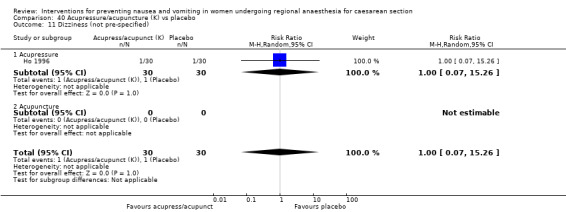
Comparison 40 Acupressure/acupuncture (K) vs placebo, Outcome 11 Dizziness (not pre‐specified).
40.12. Analysis.
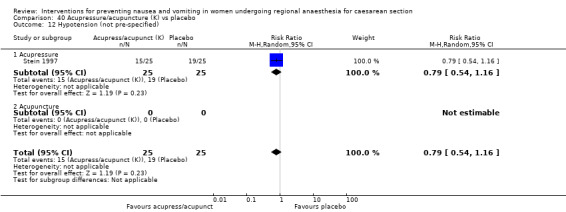
Comparison 40 Acupressure/acupuncture (K) vs placebo, Outcome 12 Hypotension (not pre‐specified).
Comparison 42. Acupuncture/acupressure (K) vs dopamine antagonist (B).
| Outcome or subgroup title | No. of studies | No. of participants | Statistical method | Effect size |
|---|---|---|---|---|
| 1 Nausea ‐ intraoperative | 1 | 50 | Risk Ratio (M‐H, Random, 95% CI) | 1.5 [0.48, 4.68] |
| 1.1 Acupressure vs metoclopramide (10 mg) | 1 | 50 | Risk Ratio (M‐H, Random, 95% CI) | 1.5 [0.48, 4.68] |
| 2 Vomiting ‐ intraoperative | 1 | 50 | Risk Ratio (M‐H, Random, 95% CI) | 3.0 [0.33, 26.92] |
| 2.1 Acupressure vs metoclopramide (10 mg) | 1 | 50 | Risk Ratio (M‐H, Random, 95% CI) | 3.0 [0.33, 26.92] |
| 3 Nausea ‐ postoperative | 0 | 0 | Risk Ratio (M‐H, Random, 95% CI) | 0.0 [0.0, 0.0] |
| 3.1 Acupressure vs metoclopramide (10 mg) | 0 | 0 | Risk Ratio (M‐H, Random, 95% CI) | 0.0 [0.0, 0.0] |
| 4 Vomiting ‐ postoperative | 0 | 0 | Risk Ratio (M‐H, Random, 95% CI) | 0.0 [0.0, 0.0] |
| 4.1 Acupressure vs metoclopramide (10 mg) | 0 | 0 | Risk Ratio (M‐H, Random, 95% CI) | 0.0 [0.0, 0.0] |
| 5 Maternal adverse effects | 0 | 0 | Risk Ratio (M‐H, Random, 95% CI) | 0.0 [0.0, 0.0] |
| 5.1 Acupressure vs metoclopramide (10 mg) | 0 | 0 | Risk Ratio (M‐H, Random, 95% CI) | 0.0 [0.0, 0.0] |
| 6 Apgar < 7 at 5 min | 0 | 0 | Risk Ratio (M‐H, Random, 95% CI) | 0.0 [0.0, 0.0] |
| 6.1 Acupressure vs metoclopramide (10 mg) | 0 | 0 | Risk Ratio (M‐H, Random, 95% CI) | 0.0 [0.0, 0.0] |
| 7 Initiaition of breastfeeding | 0 | 0 | Risk Ratio (M‐H, Random, 95% CI) | 0.0 [0.0, 0.0] |
| 7.1 Acupressure vs metoclopramide (10 mg) | 0 | 0 | Risk Ratio (M‐H, Random, 95% CI) | 0.0 [0.0, 0.0] |
| 8 Duration of exclusive breastfeeding | 0 | 0 | Std. Mean Difference (IV, Random, 95% CI) | 0.0 [0.0, 0.0] |
| 8.1 Acupressure vs metoclopramide (10 mg) | 0 | 0 | Std. Mean Difference (IV, Random, 95% CI) | 0.0 [0.0, 0.0] |
| 9 Maternal satisfaction | 0 | 0 | Risk Ratio (M‐H, Random, 95% CI) | 0.0 [0.0, 0.0] |
| 9.1 Acupressure vs metoclopramide (10 mg) | 0 | 0 | Risk Ratio (M‐H, Random, 95% CI) | 0.0 [0.0, 0.0] |
| 10 Anxiety (not pre‐specified) | 1 | 50 | Risk Ratio (M‐H, Random, 95% CI) | 0.25 [0.03, 2.08] |
| 10.1 Acupressure vs metoclopramide (10 mg) | 1 | 50 | Risk Ratio (M‐H, Random, 95% CI) | 0.25 [0.03, 2.08] |
| 11 Hypotension (not pre‐specified) | 1 | 50 | Risk Ratio (M‐H, Random, 95% CI) | 0.88 [0.58, 1.34] |
| 11.1 Acupressure vs metoclopramide (10 mg) | 1 | 50 | Risk Ratio (M‐H, Random, 95% CI) | 0.88 [0.58, 1.34] |
Comparison 43. Dopamine antagonists + corticosteroids (B+C) vs placebo.
| Outcome or subgroup title | No. of studies | No. of participants | Statistical method | Effect size |
|---|---|---|---|---|
| 1 Nausea ‐ intraoperative | 0 | 0 | Risk Ratio (M‐H, Random, 95% CI) | 0.0 [0.0, 0.0] |
| 1.1 Dexamethasone 4 mg + Droperidol 0.625 mg vs placebo | 0 | 0 | Risk Ratio (M‐H, Random, 95% CI) | 0.0 [0.0, 0.0] |
| 2 Vomiting ‐ intraoperative | 0 | 0 | Risk Ratio (M‐H, Random, 95% CI) | 0.0 [0.0, 0.0] |
| 2.1 Dexamethasone 4 mg + Droperidol 0.625 mg vs placebo | 0 | 0 | Risk Ratio (M‐H, Random, 95% CI) | 0.0 [0.0, 0.0] |
| 3 Nausea ‐ postoperative | 0 | 0 | Risk Ratio (M‐H, Random, 95% CI) | 0.0 [0.0, 0.0] |
| 3.1 Dexamethasone 4 mg + Droperidol 0.625 mg vs placebo | 0 | 0 | Risk Ratio (M‐H, Random, 95% CI) | 0.0 [0.0, 0.0] |
| 4 Vomiting ‐ postoperative | 1 | 60 | Risk Ratio (M‐H, Random, 95% CI) | 0.4 [0.18, 0.89] |
| 4.1 Dexamethasone 4 mg + Droperidol 0.625 mg vs placebo | 1 | 60 | Risk Ratio (M‐H, Random, 95% CI) | 0.4 [0.18, 0.89] |
| 5 Maternal adverse effects | 0 | 0 | Risk Ratio (M‐H, Random, 95% CI) | 0.0 [0.0, 0.0] |
| 5.1 Dexamethasone 4 mg + Droperidol 0.625 mg vs placebo | 0 | 0 | Risk Ratio (M‐H, Random, 95% CI) | 0.0 [0.0, 0.0] |
| 6 Apgar < 7 at 5 min | 0 | 0 | Risk Ratio (M‐H, Random, 95% CI) | 0.0 [0.0, 0.0] |
| 6.1 Dexamethasone 4 mg + Droperidol 0.625 mg vs placebo | 0 | 0 | Risk Ratio (M‐H, Random, 95% CI) | 0.0 [0.0, 0.0] |
| 7 Initiation of breastfeeding | 0 | 0 | Risk Ratio (M‐H, Random, 95% CI) | 0.0 [0.0, 0.0] |
| 7.1 Dexamethasone 4 mg + Droperidol 0.625 mg vs placebo | 0 | 0 | Risk Ratio (M‐H, Random, 95% CI) | 0.0 [0.0, 0.0] |
| 8 Duration of breastfeeding | 0 | 0 | Mean Difference (IV, Random, 95% CI) | 0.0 [0.0, 0.0] |
| 8.1 Dexamethasone 4 mg + Droperidol 0.625 mg vs placebo | 0 | 0 | Mean Difference (IV, Random, 95% CI) | 0.0 [0.0, 0.0] |
| 9 Maternal satisfaction | 0 | 0 | Risk Ratio (M‐H, Random, 95% CI) | 0.0 [0.0, 0.0] |
| 9.1 Dexamethasone 4 mg + Droperidol 0.625 mg vs placebo | 0 | 0 | Risk Ratio (M‐H, Random, 95% CI) | 0.0 [0.0, 0.0] |
Comparison 44. Dopamine antagonists + corticosteroids (B+C) vs dopamine antagonists (B).
| Outcome or subgroup title | No. of studies | No. of participants | Statistical method | Effect size |
|---|---|---|---|---|
| 1 Nausea ‐ intraoperative | 0 | 0 | Risk Ratio (M‐H, Random, 95% CI) | 0.0 [0.0, 0.0] |
| 1.1 Droperidol 1.25 mg + dexamethasone 8 mg (B+C) vs droperidol 1.25 mg (B) | 0 | 0 | Risk Ratio (M‐H, Random, 95% CI) | 0.0 [0.0, 0.0] |
| 2 Vomiting ‐ intraoperative | 0 | 0 | Risk Ratio (M‐H, Random, 95% CI) | 0.0 [0.0, 0.0] |
| 2.1 Droperidol 1.25 mg + dexamethasone 8 mg (B+C) vs droperidol 1.25 mg (B) | 0 | 0 | Risk Ratio (M‐H, Random, 95% CI) | 0.0 [0.0, 0.0] |
| 3 Nausea ‐ postoperative | 0 | 0 | Risk Ratio (M‐H, Random, 95% CI) | 0.0 [0.0, 0.0] |
| 3.1 Droperidol 1.25 mg + dexamethasone 8 mg (B+C) vs droperidol 1.25 mg (B) | 0 | 0 | Risk Ratio (M‐H, Random, 95% CI) | 0.0 [0.0, 0.0] |
| 4 Vomiting ‐ postoperative | 1 | 60 | Risk Ratio (M‐H, Random, 95% CI) | 0.67 [0.27, 1.64] |
| 4.1 Droperidol 1.25 mg + dexamethasone 8 mg (B+C) vs droperidol 1.25 mg (B) | 1 | 60 | Risk Ratio (M‐H, Random, 95% CI) | 0.67 [0.27, 1.64] |
| 5 Maternal adverse effects | 0 | 0 | Risk Ratio (M‐H, Random, 95% CI) | 0.0 [0.0, 0.0] |
| 5.1 Droperidol 1.25 mg + dexamethasone 8 mg (B+C) vs droperidol 1.25 mg (B) | 0 | 0 | Risk Ratio (M‐H, Random, 95% CI) | 0.0 [0.0, 0.0] |
| 6 Apgar < 7 at 5 min | 0 | 0 | Risk Ratio (M‐H, Random, 95% CI) | 0.0 [0.0, 0.0] |
| 6.1 Droperidol 1.25 mg + dexamethasone 8 mg (B+C) vs droperidol 1.25 mg (B) | 0 | 0 | Risk Ratio (M‐H, Random, 95% CI) | 0.0 [0.0, 0.0] |
| 7 Initiation of breastfeeding | 0 | 0 | Risk Ratio (M‐H, Random, 95% CI) | 0.0 [0.0, 0.0] |
| 7.1 Droperidol 1.25 mg + dexamethasone 8 mg (B+C) vs droperidol 1.25 mg (B) | 0 | 0 | Risk Ratio (M‐H, Random, 95% CI) | 0.0 [0.0, 0.0] |
| 8 Duration of breastfeeding | 0 | 0 | Mean Difference (IV, Random, 95% CI) | 0.0 [0.0, 0.0] |
| 8.1 Droperidol 1.25 mg + dexamethasone 8 mg (B+C) vs droperidol 1.25 mg (B) | 0 | 0 | Mean Difference (IV, Random, 95% CI) | 0.0 [0.0, 0.0] |
| 9 Maternal satisfaction | 0 | 0 | Risk Ratio (M‐H, Random, 95% CI) | 0.0 [0.0, 0.0] |
| 9.1 Droperidol 1.25 mg + dexamethasone 8 mg (B+C) vs droperidol 1.25 mg (B) | 0 | 0 | Risk Ratio (M‐H, Random, 95% CI) | 0.0 [0.0, 0.0] |
Comparison 45. Dopamine antagonists + corticosteroids (B+C) vs corticosteroids (C).
| Outcome or subgroup title | No. of studies | No. of participants | Statistical method | Effect size |
|---|---|---|---|---|
| 1 Nausea ‐ intraoperative | 0 | 0 | Risk Ratio (M‐H, Random, 95% CI) | 0.0 [0.0, 0.0] |
| 1.1 Droperidol 1.25 mg + dexamethasone 8 mg (B+C) vs dexamethasone 8 mg (C) | 0 | 0 | Risk Ratio (M‐H, Random, 95% CI) | 0.0 [0.0, 0.0] |
| 2 Vomiting ‐ intraoperative | 0 | 0 | Risk Ratio (M‐H, Random, 95% CI) | 0.0 [0.0, 0.0] |
| 2.1 Droperidol 1.25 mg + dexamethasone 8 mg (B+C) vs dexamethasone 8 mg (C) | 0 | 0 | Risk Ratio (M‐H, Random, 95% CI) | 0.0 [0.0, 0.0] |
| 3 Nausea ‐ postoperative | 0 | 0 | Risk Ratio (M‐H, Random, 95% CI) | 0.0 [0.0, 0.0] |
| 3.1 Droperidol 1.25 mg + dexamethasone 8 mg (B+C) vs dexamethasone 8 mg (C) | 0 | 0 | Risk Ratio (M‐H, Random, 95% CI) | 0.0 [0.0, 0.0] |
| 4 Vomiting ‐ postoperative | 1 | 60 | Risk Ratio (M‐H, Random, 95% CI) | 0.46 [0.20, 1.05] |
| 4.1 Droperidol 1.25 mg + dexamethasone 8 mg (B+C) vs dexamethasone 8 mg (C) | 1 | 60 | Risk Ratio (M‐H, Random, 95% CI) | 0.46 [0.20, 1.05] |
| 5 Maternal adverse effects | 0 | 0 | Risk Ratio (M‐H, Random, 95% CI) | 0.0 [0.0, 0.0] |
| 5.1 Droperidol 1.25 mg + dexamethasone 8 mg (B+C) vs dexamethasone 8 mg (C) | 0 | 0 | Risk Ratio (M‐H, Random, 95% CI) | 0.0 [0.0, 0.0] |
| 6 Apgar < 7 at 5 min | 0 | 0 | Risk Ratio (M‐H, Random, 95% CI) | 0.0 [0.0, 0.0] |
| 6.1 Droperidol 1.25 mg + dexamethasone 8 mg (B+C) vs dexamethasone 8 mg (C) | 0 | 0 | Risk Ratio (M‐H, Random, 95% CI) | 0.0 [0.0, 0.0] |
| 7 Initiation of breastfeeding | 0 | 0 | Risk Ratio (M‐H, Random, 95% CI) | 0.0 [0.0, 0.0] |
| 7.1 Droperidol 1.25 mg + dexamethasone 8 mg (B+C) vs dexamethasone 8 mg (C) | 0 | 0 | Risk Ratio (M‐H, Random, 95% CI) | 0.0 [0.0, 0.0] |
| 8 Duration of breastfeeding | 0 | 0 | Mean Difference (IV, Random, 95% CI) | 0.0 [0.0, 0.0] |
| 8.1 Droperidol 1.25 mg + dexamethasone 8 mg (B+C) vs dexamethasone 8 mg (C) | 0 | 0 | Mean Difference (IV, Random, 95% CI) | 0.0 [0.0, 0.0] |
| 9 Maternal satisfaction | 0 | 0 | Risk Ratio (M‐H, Random, 95% CI) | 0.0 [0.0, 0.0] |
| 9.1 Droperidol 1.25 mg + dexamethasone 8 mg (B+C) vs dexamethasone 8 mg (C) | 0 | 0 | Risk Ratio (M‐H, Random, 95% CI) | 0.0 [0.0, 0.0] |
Characteristics of studies
Characteristics of included studies [ordered by study ID]
Abouleish 1999.
| Methods | RCT. | |
| Participants | 74 women 18‐40 years undergoing elective CS at term under spinal anaesthesia, ASA 1‐2, no significant maternal medical conditions. | |
| Interventions | Intervention: 5‐HT3antagonist (A)
Comparison: Placebo
|
|
| Outcomes | Nausea ‐ presence/absence and severity. Vomiting ‐ severity, frequency. |
|
| Notes | Setting: Texas, USA. | |
| Risk of bias | ||
| Bias | Authors' judgement | Support for judgement |
| Random sequence generation (selection bias) | Low risk | Computer‐generated random number table. |
| Allocation concealment (selection bias) | Low risk | Syringes produced by pharmacy. |
| Blinding (performance bias and detection bias) All outcomes | Low risk | Double blind. |
| Incomplete outcome data (attrition bias) All outcomes | Low risk | 8 participants withdrawn, 5 withdrew consent, 2 had an exclusion criteria (oesophageal reflux), 1 failed spinal converted to GA. Data not re‐included. |
| Selective reporting (reporting bias) | Unclear risk | We did not assess the trial protocol. |
| Other bias | Low risk | Mild increase in BP in the control group, not significant. |
Apiliogullari 2007.
| Methods | RCT. | |
| Participants | 181 women. Spinal anaesthesia for CS. | |
| Interventions | Intervention 1: Antihistamine (D)
Intervention 2: Antihistamine (D)
Comparison: Placebo
|
|
| Outcomes | PONV, sedation, side effects. | |
| Notes | Abstract only. | |
| Risk of bias | ||
| Bias | Authors' judgement | Support for judgement |
| Random sequence generation (selection bias) | Unclear risk | No information. |
| Allocation concealment (selection bias) | Unclear risk | No information. |
| Blinding (performance bias and detection bias) All outcomes | Low risk | Reported as double blind. |
| Incomplete outcome data (attrition bias) All outcomes | Unclear risk | No information. |
| Selective reporting (reporting bias) | Unclear risk | We did not assess the trial protocol. |
| Other bias | Unclear risk | No information. |
Birnbach 1993.
| Methods | RCT. | |
| Participants | 60 women undergoing elective CS with spinal anaesthesia, no history of nausea or vomiting within 24 hours or after previous anaesthetics. | |
| Interventions | Intervention 1: Acupuncture/acupressure (K)
Intervention 2: Dopamine antagonist (B)
Comparison: Placebo
|
|
| Outcomes | VAS nausea and vomiting. | |
| Notes | This study currently provides no data for the review because we were unable to assess results from graphical data ‐ we have written to authors. | |
| Risk of bias | ||
| Bias | Authors' judgement | Support for judgement |
| Random sequence generation (selection bias) | Unclear risk | Method not stated. |
| Allocation concealment (selection bias) | Unclear risk | Methods not stated. |
| Blinding (performance bias and detection bias) All outcomes | Unclear risk | Participant was blinded, but unclear whether the assessor was blinded or not. |
| Incomplete outcome data (attrition bias) All outcomes | Unclear risk | Not reported. |
| Selective reporting (reporting bias) | Unclear risk | We did not assess the trial protocol. |
| Other bias | Low risk | No apparent problems. |
Biswas 2003.
| Methods | RCT. | |
| Participants | 80 women undergoing spinal anaesthesia for CS, ASA 1, 20‐35 years, without a history of nausea/vomiting, motion sickness, GI or liver disease, current antiemetic use. | |
| Interventions | Intervention 1: Anticholenergic (E)
Intervention 2: Steroid (C)
Intervention 3: Dopamine antagonist (B)
Comparison: Placebo
|
|
| Outcomes | Nausea, vomiting, cardiovascular instability, Apgar scores. | |
| Notes | Measured Apgar scores but we have not ben able to used this data. | |
| Risk of bias | ||
| Bias | Authors' judgement | Support for judgement |
| Random sequence generation (selection bias) | Unclear risk | "randomly allocated." |
| Allocation concealment (selection bias) | Unclear risk | Not described. |
| Blinding (performance bias and detection bias) All outcomes | Unclear risk | Outcome assessor blinded, others unclear. |
| Incomplete outcome data (attrition bias) All outcomes | Low risk | None described. |
| Selective reporting (reporting bias) | Unclear risk | Protocol not assessed. |
| Other bias | Unclear risk | Nil apparent. |
Biwas 2002.
| Methods | RCT. | |
| Participants | 60 women undergoing spinal anaesthesia for CS, ASA 1, 20‐35 years, without a history of nausea/vomiting, motion sickness, GI or liver disease, current antiemetic use. | |
| Interventions | Intervention 1. Dopamine antagonist (B)
Intervention 2: Anticholenergic (E)
Intervention 3: Dopamine antagonist + anticholinergic (B+E)
|
|
| Outcomes | Emetic episodes, heart rate < 60 beats/min; BP drop > 10%, 20% and 30%. | |
| Notes | This study currently provides no data for the review because we were unable to assess results from combined "emetic symptoms" data ‐ we have written to authors. | |
| Risk of bias | ||
| Bias | Authors' judgement | Support for judgement |
| Random sequence generation (selection bias) | Unclear risk | "randomly assigned." |
| Allocation concealment (selection bias) | Unclear risk | Not described. |
| Blinding (performance bias and detection bias) All outcomes | Unclear risk | "blinded." |
| Incomplete outcome data (attrition bias) All outcomes | Unclear risk | Not described. |
| Selective reporting (reporting bias) | Unclear risk | We did not assess the trial protocol. |
| Other bias | Unclear risk | None described. |
Boone 2002.
| Methods | RCT. | |
| Participants | 98 women undergoing CS under regional anaesthesia, poorly described. | |
| Interventions | Intervention: 5‐HT3antagonist (A)
Comparison: No treatment
|
|
| Outcomes | Nausea/retching/vomiting ‐ presented as a combined score. | |
| Notes | Setting: Texas, USA. Abstract only. This study currently provides no data for the review. We have written to authors requesting separated outcome data. |
|
| Risk of bias | ||
| Bias | Authors' judgement | Support for judgement |
| Random sequence generation (selection bias) | Unclear risk | "Randomised." |
| Allocation concealment (selection bias) | Unclear risk | Not described. |
| Blinding (performance bias and detection bias) All outcomes | Unclear risk | Not stated. |
| Incomplete outcome data (attrition bias) All outcomes | Unclear risk | None described. |
| Selective reporting (reporting bias) | Unclear risk | We did not assess the trial protocol. |
| Other bias | Unclear risk | None apparent. |
Caba 1997.
| Methods | RCT. | |
| Participants | 60 women (though 57 analysed) undergoing elective or emergency CS with intradural anaesthesia. Exclusions: "any contraindication to spinal anaesthesia, pre‐eclampsia, clear background of hypertension and NVPO (post operative nausea and vomiting), body mass index greater than 45, and less than 6 hour fasting…” |
|
| Interventions | Intervention: Sedative (F)
Comparison: Placebo
|
|
| Outcomes | Nausea and vomiting before and after intervention, and postoperative; change in haemodynamics; sedation. | |
| Notes | In Spanish. Translated by Edgardo Abalos. | |
| Risk of bias | ||
| Bias | Authors' judgement | Support for judgement |
| Random sequence generation (selection bias) | Low risk | ‘…through a table of randomisation …’ |
| Allocation concealment (selection bias) | Unclear risk | Prepared by hospital pharmacy. |
| Blinding (performance bias and detection bias) All outcomes | Low risk | Syringes prepared by hospital pharmacy, placebo was propofol exipient, given in similar way and at similar time. |
| Incomplete outcome data (attrition bias) All outcomes | Unclear risk | 3 women excluded from the Protofol group, 2 had GA due to inadequate block, 1 had anaphylaxis. There appeared to be no other loss of data, but overall we felt uncertain about this. |
| Selective reporting (reporting bias) | Unclear risk | We did not assess the trial protocol. |
| Other bias | Low risk | Study was not stopped early. Baseline data was similar on age, height, weight, BMI, gestational age, birthweight, previous medication for dilatation, surgical time (min), other associated interventions, surgical incision: vertical intraumbilical, Pfannenstiel. |
Charuluxananan 2003.
| Methods | RCT. | |
| Participants | 240 ASA 1‐2 women undergoing CS under spinal anaesthesia without allergy to study drugs, pruritis, skin disease. | |
| Interventions | Intervention 1: Opioid antagonist (G)
Intervention 2: 5‐HT3antagonist (A)
Intervention 3: 5‐HT3antagonist (A)
Comparison: Placebo.
|
|
| Outcomes | Pruritis, nausea and vomiting, adverse effects. | |
| Notes | Setting: King Chulalongkorn Memorial Hospital, Bangkok, Thailand. In Comparison 1, Groups 2 and 3 combined to yield overall treatment effect. |
|
| Risk of bias | ||
| Bias | Authors' judgement | Support for judgement |
| Random sequence generation (selection bias) | Low risk | Random number table. |
| Allocation concealment (selection bias) | Low risk | Sealed envelopes. |
| Blinding (performance bias and detection bias) All outcomes | Low risk | "double blind." |
| Incomplete outcome data (attrition bias) All outcomes | Low risk | None described. |
| Selective reporting (reporting bias) | Unclear risk | We did not assess the trial protocol. |
| Other bias | Unclear risk | No baseline differences. |
Chaudhuri 2004.
| Methods | RCT. | |
| Participants | 93 women undergoing CS under regional anaesthesia. | |
| Interventions | Group 1: 5‐HT3antagonist + dopamine antagonist (A+B)
Group 2: Dopamine antagonist (B)
|
|
| Outcomes | Nausea, vomiting at 2, 8, 24 hours | |
| Notes | This study currently provides no data for the review because outcome are categorised as "Nausea OR vomiting". We have written to the authors requesting separated data. | |
| Risk of bias | ||
| Bias | Authors' judgement | Support for judgement |
| Random sequence generation (selection bias) | Low risk | "Randomisation table." |
| Allocation concealment (selection bias) | Unclear risk | Not described. |
| Blinding (performance bias and detection bias) All outcomes | Low risk | "Double blind." |
| Incomplete outcome data (attrition bias) All outcomes | Low risk | None apparent. |
| Selective reporting (reporting bias) | Unclear risk | We did not assess the trial protocol. |
| Other bias | Unclear risk | None apparent. |
Cherian 2001.
| Methods | RCT. | |
| Participants | 81 women undergoing elective CS at term under spinal anaesthesia. | |
| Interventions | Intervention: 5‐HT3 antagonist (A)
Comparison: Placebo
|
|
| Outcomes | Nausea ‐ mild/severe, vomiting, pain, sedation, women's satisfaction. | |
| Notes | Setting: Distrist General hospital, UK. Combined "mild" and "severe" to form overall incidence of nausea. Combine "moderate" and "poor" satisfaction. |
|
| Risk of bias | ||
| Bias | Authors' judgement | Support for judgement |
| Random sequence generation (selection bias) | Low risk | Computer‐generated sequence. |
| Allocation concealment (selection bias) | Low risk | Sequentially allocated numbered envelopes. |
| Blinding (performance bias and detection bias) All outcomes | Unclear risk | Unclear what placebo was given, although states participants were "unaware" of group allocation. |
| Incomplete outcome data (attrition bias) All outcomes | Low risk | No loss of data described. |
| Selective reporting (reporting bias) | Unclear risk | We did not assess the trial protocol. |
| Other bias | Low risk | No baseline imbalance. |
Chestnut 1987.
| Methods | RCT. | |
| Participants | 69 ASA 1‐2 women undergoing lumbar epidural for elective CS, with no history of nausea or vomiting in the 24 hours before surgery (or any adjunctive surgery apart from tubal ligation). | |
| Interventions | Intervention 1: Dopamine antagonist (B)
Comparison: Placebo
|
|
| Outcomes | Intraoperative and PONV, anxiety, sedation. | |
| Notes | ||
| Risk of bias | ||
| Bias | Authors' judgement | Support for judgement |
| Random sequence generation (selection bias) | Low risk | Table of random numbers. |
| Allocation concealment (selection bias) | Low risk | Pharmacy undertook preparation. |
| Blinding (performance bias and detection bias) All outcomes | Low risk | All participating unaware of allocation. |
| Incomplete outcome data (attrition bias) All outcomes | Low risk | None described. |
| Selective reporting (reporting bias) | Unclear risk | We did not assess the trial protocol. |
| Other bias | Low risk | Similar baseline variables. |
Chestnut 1989.
| Methods | RCT. | |
| Participants | 81 healthy women having elective CS under epidural anaesthesia. Women were ASA classification 1 or 2. | |
| Interventions | Intervention: Dopamine antagonist (B) ‐ metoclopramide
Comparison: Dopamine antagonist (B) ‐ droperidol
|
|
| Outcomes | Intraoperative nausea; intraoperative vomiting; postoperative nausea; postoperative vomiting; sedation; respiratory rate. Scoring was done on scales 0 to 100, where 100 = worst. |
|
| Notes | ||
| Risk of bias | ||
| Bias | Authors' judgement | Support for judgement |
| Random sequence generation (selection bias) | Low risk | Study solutions prepared according to “...a table of random numbers...” |
| Allocation concealment (selection bias) | Unclear risk | No information provided. |
| Blinding (performance bias and detection bias) All outcomes | Low risk | “The patient, anaesthesiologist, obstetrician, and nursing staff were unaware of the identity of the study solution.” |
| Incomplete outcome data (attrition bias) All outcomes | Low risk | There appeared to be no exclusions or lost data. |
| Selective reporting (reporting bias) | Unclear risk | We did not assess the trial protocol. |
| Other bias | Low risk | There appeared to be no other biases. |
Duggal 1998.
| Methods | RCT. | |
| Participants | 244 women ASA 1‐2 undergoing elective CS under spinal anaesthesia with no hyperemesis or antiemetic use in the previous 48 hours. | |
| Interventions | Intervention: Acupuncture/acupressure (K)
Comparison: Placebo
|
|
| Outcomes | Nausea or vomiting intraoperative and up to 10 hours postoperatively. | |
| Notes | ||
| Risk of bias | ||
| Bias | Authors' judgement | Support for judgement |
| Random sequence generation (selection bias) | Low risk | Random number table. |
| Allocation concealment (selection bias) | Unclear risk | Method not reported. |
| Blinding (performance bias and detection bias) All outcomes | Low risk | Bands placed by nurse not involved in rest of study. |
| Incomplete outcome data (attrition bias) All outcomes | Unclear risk | Many exclusions ‐ not ITT. |
| Selective reporting (reporting bias) | Unclear risk | We did not assess the trial protocol. |
| Other bias | Low risk | No baseline imbalance. |
Duman 2010.
| Methods | RCT. | |
| Participants | 210 women. Spinal anaesthesia for CS, non‐smoking; ASA 1; term (> 38 weeks): without pregnancy complications or major systemic disease and without tubal ligation, excluding women concurrently using any antiemetic or antipsychotic medication; women in whom non‐steroidal anti‐inflammatories were contraindicated, history of allergy, car sickness, hyperemesis gravidarum or PONV; women weighing < 50 kg and > 100 kg. | |
| Interventions | Intervention 1: Antihistamine (D)
Intervention 2: Dopamine antagonist (B)
Comparison: Placebo
|
|
| Outcomes | PONV in 1st 24 hours after surgery; nausea; vomiting; severe nausea; rescue antiemetic; pruritus; sedation. | |
| Notes | This study initially provided very limited information in abstract form. We wrote to the authors and obtained further data. | |
| Risk of bias | ||
| Bias | Authors' judgement | Support for judgement |
| Random sequence generation (selection bias) | Low risk | Computer‐generated random number table. |
| Allocation concealment (selection bias) | Unclear risk | Not described. |
| Blinding (performance bias and detection bias) All outcomes | Low risk | “...double blind controlled trial...”, “The patients were unaware of to which group they were randomised. Nursing staff were blinded to randomisation process and selection of the drugs used in this study.” |
| Incomplete outcome data (attrition bias) All outcomes | High risk | Women were excluded if they received intraoperative propofol “due to propofol’s known antiemetic properties". The number excluded were: Dimenhydrinate (Gp D) excluded 9/70 = 13%, Metoclopramide (Gp M) excluded 12/70 = 17%, placebo (Gp P) excluded 7/70 = 10%. |
| Selective reporting (reporting bias) | Unclear risk | We did not assess the trial protocol. |
| Other bias | Low risk | No problems apparent. |
El‐Deeb 2011.
| Methods | Individual RCT. | |
| Participants | ASA 1‐2, uncomplicated pregnancy, elective CS under spinal. | |
| Interventions | Intervention 1: Steroid + sedative (C+F)
Intervention 2: Steroid + 5‐HT3 antagonist (C+A)
Comparison: Placebo
|
|
| Outcomes | Nausea score, vomiting, antiemetic use, drowsiness, headache, blurred vision, allergy, women's satisfaction. | |
| Notes | ||
| Risk of bias | ||
| Bias | Authors' judgement | Support for judgement |
| Random sequence generation (selection bias) | Low risk | Computer‐generated randomisation code. |
| Allocation concealment (selection bias) | Unclear risk | No information given. |
| Blinding (performance bias and detection bias) All outcomes | Low risk | Drugs prepared by anaesthetist not otherwise involved in the conduct of women's care or outcome assessment. |
| Incomplete outcome data (attrition bias) All outcomes | Unclear risk | None described. |
| Selective reporting (reporting bias) | Unclear risk | We did not assess the trial protocol. |
| Other bias | Low risk | Nil apparent. |
Gaiser 2002.
| Methods | RCT. | |
| Participants | 10 pregnant women for elective CS under regional anaesthesia. | |
| Interventions | Intervention 1: IV fluid (J)
Comparison: Placebo
|
|
| Outcomes | Nausea, vomiting. | |
| Notes | Figures taken from the 0‐12 hour period. This study is a conference abstract only. | |
| Risk of bias | ||
| Bias | Authors' judgement | Support for judgement |
| Random sequence generation (selection bias) | Unclear risk | Not described. |
| Allocation concealment (selection bias) | Low risk | Sealed envelopes. |
| Blinding (performance bias and detection bias) All outcomes | Unclear risk | Not adequately described. |
| Incomplete outcome data (attrition bias) All outcomes | Unclear risk | Difficult to assess. |
| Selective reporting (reporting bias) | Unclear risk | We did not assess the trial protocol. |
| Other bias | Unclear risk | Inadequately described. |
Habib 2006.
| Methods | RCT. | |
| Participants | 91 women scheduled for elective CS under spinal anaesthesia without previous experience of acupuncture or acu‐stimulation or had experienced nausea or vomiting or taken antiemetics or glucocorticoids within 24 hours before surgery or who had an implanted pacemaker or defibrillator device. | |
| Interventions | Intervention: Acupuncture/acupressure (K)
Comparison: Placebo
|
|
| Outcomes | Nausea and vomiting (intra and postoperative), intraoperative and postoperative antiemetic use and pruritis. | |
| Notes | ||
| Risk of bias | ||
| Bias | Authors' judgement | Support for judgement |
| Random sequence generation (selection bias) | Unclear risk | Not described. |
| Allocation concealment (selection bias) | Unclear risk | Not described. |
| Blinding (performance bias and detection bias) All outcomes | Low risk | Opaque gauze over wrist band. |
| Incomplete outcome data (attrition bias) All outcomes | Unclear risk | 3 women excluded for protocol violations post randomisation. |
| Selective reporting (reporting bias) | Unclear risk | We did not assess the trial protocol. |
| Other bias | Low risk | No baseline differences. |
Harmon 2000.
| Methods | RCT. | |
| Participants | 94 ASA 1 women 18‐40 years scheduled for elective CS under spinal anaesthesia, with no previous history of nausea and vomiting postoperatively or in the previous 24 hours, obesity, diabetes, previous experience of acupuncture or acupressure. | |
| Interventions | Intervention: Acupuncture/acupressure (K)
Comparison: Placebo
|
|
| Outcomes | Nausea and vomiting during and up to 24 hours postoperative. | |
| Notes | ||
| Risk of bias | ||
| Bias | Authors' judgement | Support for judgement |
| Random sequence generation (selection bias) | Unclear risk | 'randomly allocated.' |
| Allocation concealment (selection bias) | Unclear risk | Not described. |
| Blinding (performance bias and detection bias) All outcomes | Unclear risk | Unclear if/how the participant was blinded. |
| Incomplete outcome data (attrition bias) All outcomes | Unclear risk | 4 participants excluded, but unclear pre or post randomisation. |
| Selective reporting (reporting bias) | Unclear risk | We did not assess the trial protocol. |
| Other bias | Low risk | No baseline imbalance described. |
Harnett 2007.
| Methods | Individual RCT. | |
| Participants | 240 healthy women undergoing elective CS under spinal anaesthetic at Brigham and Women's Hospital, Harvard Medical School. Women excluded if history of PONV, hyperemesis, antiemetics within 1 week. |
|
| Interventions | Group 1: Anticholinergic (E)
Group 2: 5‐HT3antagonist (A)
Group 3: Placebo
|
|
| Outcomes | Intraop nausea, vomiting, post‐op N or V at 0‐2, 2‐6, 6‐24 hrs, rescue antiemetics. | |
| Notes | Postoperative nausea reported as a VAS score, and therefore were not usable data. | |
| Risk of bias | ||
| Bias | Authors' judgement | Support for judgement |
| Random sequence generation (selection bias) | Low risk | "Computer generated scheme." |
| Allocation concealment (selection bias) | Unclear risk | No details given. |
| Blinding (performance bias and detection bias) All outcomes | Low risk | Inactive patch and normal saline blinding. |
| Incomplete outcome data (attrition bias) All outcomes | Low risk | No apparent exclusions or dropouts, ITT. |
| Selective reporting (reporting bias) | Unclear risk | We did not assess the trial protocol. |
| Other bias | Low risk | No baseline imbalance. |
Ho 1996.
| Methods | RCT. | |
| Participants | 60 women ASA 1, aged 21‐35, undergoing elective CS, under spinal anaesthesia with epidural morphine, no history of carpal tunnel syndrome or nausea or vomiting within 24 hours of CS. | |
| Interventions | Intervention: Acupuncture/acupressure (K)
Comparison: Placebo
|
|
| Outcomes | Nausea, vomiting, pruritis, dizziness. | |
| Notes | ||
| Risk of bias | ||
| Bias | Authors' judgement | Support for judgement |
| Random sequence generation (selection bias) | Low risk | Computer‐generated. |
| Allocation concealment (selection bias) | Unclear risk | Sealed envelopes but it unclear if they were opaque. |
| Blinding (performance bias and detection bias) All outcomes | Low risk | Placebo wrist bands. |
| Incomplete outcome data (attrition bias) All outcomes | Low risk | None. |
| Selective reporting (reporting bias) | Unclear risk | We did not assess the trial protocol. |
| Other bias | Low risk | None apparent. |
Ho 2006.
| Methods | RCT. | |
| Participants | 110 women scheduled for elective CS under spinal anaesthesia, ASA 1‐2, between 23 and 40 years, without carpal tunnel syndrome or nausea and vomiting in the previous 24 hours. | |
| Interventions | Intervention: Acupuncture/acupressure (K)
Comparison: Placebo
|
|
| Outcomes | Nausea and vomiting ‐ 1. spinal ‐ skin incision, 2. incision to delivery, 3. delivery to skin closure, 4 skin closure to PACU. | |
| Notes | ||
| Risk of bias | ||
| Bias | Authors' judgement | Support for judgement |
| Random sequence generation (selection bias) | Unclear risk | Randomised using "envelope system". |
| Allocation concealment (selection bias) | Unclear risk | Type of envelope unclear. |
| Blinding (performance bias and detection bias) All outcomes | Low risk | Placebo wrist bands. |
| Incomplete outcome data (attrition bias) All outcomes | Low risk | No loss to follow‐up. |
| Selective reporting (reporting bias) | Unclear risk | We did not assess the trial protocol. |
| Other bias | Low risk | No baseline imbalance. |
Huang 1992.
| Methods | RCT. | |
| Participants | 100 primiparous women 20‐38 years, undergoing emergency CS, with regional anaesthesia, with normal heart, lung, blood, urine examination and with no history of drug allergy, pre‐eclampsia, supine low BP syndrome. | |
| Interventions | Intervention. Dopamine antagonist (B)
Comparison: No treatment
|
|
| Outcomes | Nausea, hypotension, bradycardia. | |
| Notes | ||
| Risk of bias | ||
| Bias | Authors' judgement | Support for judgement |
| Random sequence generation (selection bias) | Unclear risk | Not described. |
| Allocation concealment (selection bias) | Unclear risk | Not described. |
| Blinding (performance bias and detection bias) All outcomes | Unclear risk | No placebo group described, no blinding of participants described. |
| Incomplete outcome data (attrition bias) All outcomes | Unclear risk | None described. |
| Selective reporting (reporting bias) | Unclear risk | We did not assess the trial protocol. |
| Other bias | Unclear risk | None described. |
Imbeloni 1986.
| Methods | RCT. | |
| Participants | 80 pregnant women at term undergoing CS under epidural anaesthesia. | |
| Interventions | Group 1: Dopamine antagonist (B)
Group 2: Placebo
|
|
| Outcomes | Nausea and vomiting. | |
| Notes | This study currently provides no data for the review because nausea and vomiting are presented as combined data. We have written to the authors to request separated data. | |
| Risk of bias | ||
| Bias | Authors' judgement | Support for judgement |
| Random sequence generation (selection bias) | Unclear risk | "Women were divided into groups randomly." |
| Allocation concealment (selection bias) | Unclear risk | Not described. |
| Blinding (performance bias and detection bias) All outcomes | Unclear risk | Not stated. |
| Incomplete outcome data (attrition bias) All outcomes | Unclear risk | None described. |
| Selective reporting (reporting bias) | Unclear risk | We did not assess the trial protocol. |
| Other bias | Low risk | No apparent baseline differences. |
Jaafarpour 2008.
| Methods | RCT. | |
| Participants | 80 women undergoing elective CS under spinal anaesthesia in a university hospital in Iran. Contraindications: use of antiemetics within 24 hours, contraindication to regional anaesthesia, allergy to dexamethasone, GI disease, HT or glucose intolerance, PONV or motion sickness. | |
| Interventions | Group 1: Steroid (C)
Group 2: Placebo
|
|
| Outcomes | Intraoperative nausea, vomiting, retching and pain. | |
| Notes | Retching data was combined with vomiting. | |
| Risk of bias | ||
| Bias | Authors' judgement | Support for judgement |
| Random sequence generation (selection bias) | Unclear risk | "Randomly assigned" ‐ no other details. |
| Allocation concealment (selection bias) | Unclear risk | "sealed envelopes" ‐ no other details. |
| Blinding (performance bias and detection bias) All outcomes | Unclear risk | "double blind" ‐ no other details. |
| Incomplete outcome data (attrition bias) All outcomes | Low risk | No apparent loss to follow‐up or exclusions, appears to be ITT. |
| Selective reporting (reporting bias) | Unclear risk | We have not assessed the trial protocol. |
| Other bias | Low risk | No apparent baseline imbalance. |
Kasodekar 2006.
| Methods | RCT. | |
| Participants | 176 women undergoing elective CS under spinal anaesthesia. | |
| Interventions | Intervention: 5‐HT3antagonist (A)
Comparison: Placebo
|
|
| Outcomes | Intraoperative nausea, vomiting, retching, rescue antiemetic, hypotension, pain. | |
| Notes | Setting: Mount Sinai Hospital, Toronto, Canada. Abstract only. Retching data combined with vomiting. |
|
| Risk of bias | ||
| Bias | Authors' judgement | Support for judgement |
| Random sequence generation (selection bias) | Unclear risk | "randomly." |
| Allocation concealment (selection bias) | Unclear risk | Not described. |
| Blinding (performance bias and detection bias) All outcomes | Unclear risk | "double blind." |
| Incomplete outcome data (attrition bias) All outcomes | Low risk | No loss of participants described. |
| Selective reporting (reporting bias) | Unclear risk | We did not assess the trial protocol. |
| Other bias | Low risk | No baseline imbalance. |
Kotelko 1989.
| Methods | RCT. | |
| Participants | 203 ASA 1‐2 women undergoing elective CS, 18‐38 years with epidural anaesthesia and epidural morphine. | |
| Interventions | Intervention: Antichoienergic (E)
Comparison: Placebo
|
|
| Outcomes | Nausea, vomiting, retching, rescue antiemetics required, itch, pain, adverse effects. | |
| Notes | Various adverse effects listed, pruritis used as most common side effect. | |
| Risk of bias | ||
| Bias | Authors' judgement | Support for judgement |
| Random sequence generation (selection bias) | Unclear risk | "randomised." |
| Allocation concealment (selection bias) | Unclear risk | Not described. |
| Blinding (performance bias and detection bias) All outcomes | Low risk | "double blind." |
| Incomplete outcome data (attrition bias) All outcomes | Low risk | None identified. |
| Selective reporting (reporting bias) | Unclear risk | We did not assess the trial protocol. |
| Other bias | Unclear risk | "No significant differences between groups." |
Lussos 1992.
| Methods | RCT. | |
| Participants | 42 women undergoing elective CS under spinal anaesthesia, without treatment of nausea and vomiting in the week before surgery, diabetes or uteroplacental insufficiency. | |
| Interventions | Intervention: Dopamine antagonist (B)
Comparison: Placebo
|
|
| Outcomes | Nausea and vomiting pre and postdelivery. | |
| Notes | ||
| Risk of bias | ||
| Bias | Authors' judgement | Support for judgement |
| Random sequence generation (selection bias) | Unclear risk | Not described. |
| Allocation concealment (selection bias) | Unclear risk | Not described. |
| Blinding (performance bias and detection bias) All outcomes | Low risk | "randomised in a double blind fashion." |
| Incomplete outcome data (attrition bias) All outcomes | Low risk | All included. |
| Selective reporting (reporting bias) | Unclear risk | We did not assess the trial protocol. |
| Other bias | Low risk | Similar baseline characteristics. |
Mandell 1992.
| Methods | RCT. | |
| Participants | 128 healthy women at term, singleton pregnancies, elective (or non‐emergent) CS, with regional anaesthesia, with no other anaesthetic adjuvants or the use of adjuvants. | |
| Interventions | Intervention: Dopamine antagonist (B)
Comparison: Placebo
|
|
| Outcomes | Incidence of nausea and vomiting, narcotic administration, hypotension. | |
| Notes | Results were provided as a percentage of the overall number of participants in each group. Actual participant numbers with each outcome calculated by multiplication of this percentage by the number of participants in each group. | |
| Risk of bias | ||
| Bias | Authors' judgement | Support for judgement |
| Random sequence generation (selection bias) | Unclear risk | Not described. |
| Allocation concealment (selection bias) | Unclear risk | Not described. |
| Blinding (performance bias and detection bias) All outcomes | Low risk | "double blind fashion." |
| Incomplete outcome data (attrition bias) All outcomes | Unclear risk | Unclear, 7 participants lost before intervention. |
| Selective reporting (reporting bias) | Unclear risk | We did not assess the trial protocol. |
| Other bias | Unclear risk | Only reports on those women who completed the treatment. |
Manullang 2000.
| Methods | RCT. | |
| Participants | 30 ASA 1‐2 women undergoing elective CS under spinal anaesthesia, without a history of motion sickness or hyperemesis. | |
| Interventions | Group 1: Opioid (G)
Group 2: 5‐HT3antagonist (A)
|
|
| Outcomes | Nausea, retching, vomiting. | |
| Notes | This study currently provides no data for the review because data are provided as a "cumulative score". We have written to the authors to request separated data. | |
| Risk of bias | ||
| Bias | Authors' judgement | Support for judgement |
| Random sequence generation (selection bias) | Low risk | Block randomised by computer‐generated allocation. |
| Allocation concealment (selection bias) | Low risk | Sealed envelopes. |
| Blinding (performance bias and detection bias) All outcomes | Low risk | Dispensed in unlabelled syringes. Observer blinded to treatment. |
| Incomplete outcome data (attrition bias) All outcomes | Low risk | No loss to follow‐up. |
| Selective reporting (reporting bias) | Unclear risk | We did not assess the trial protocol. |
| Other bias | Low risk | No apparent issues. |
Mukherjee 2006.
| Methods | RCT. | |
| Participants | 80 ASA 1‐2, age 20‐34, undergoing CS under spinal anaesthesia, with no antiemetic drugs within 24 hours. | |
| Interventions | Intervention 1: Sedative (F)
Intervention 2: Sedative (F)
Intervention 3: Sedative (F)
Comparison: Placebo
|
|
| Outcomes | Intraoperative nausea, vomiting, retching, adverse events. | |
| Notes | Retching combined with vomiting, dosage groups combined to yield overall treatment effect. | |
| Risk of bias | ||
| Bias | Authors' judgement | Support for judgement |
| Random sequence generation (selection bias) | Low risk | Computer‐generated randomisation chart. |
| Allocation concealment (selection bias) | Low risk | Identical syringes prepared by uninvolved anaesthetist. |
| Blinding (performance bias and detection bias) All outcomes | Low risk | Outcomes assessed by anaesthetist unaware of allocation. |
| Incomplete outcome data (attrition bias) All outcomes | Low risk | No loss of participants. |
| Selective reporting (reporting bias) | Unclear risk | We did not assess the trial protocol. |
| Other bias | Low risk | No differences in baseline groups. |
Munnur 2008.
| Methods | RCT. | |
| Participants | 192 women undergoing CS with regional anaesthesia. | |
| Interventions | Intervention 1: 5‐HT3antagonist (A)
Intervention 2: 5‐HT3antagonist (A)
Comparison: Placebo
|
|
| Outcomes | Composite PONV. | |
| Notes | Unable to use the data as they report the composite outcome. We shall write to try to obtain the specific data for nausea and for vomiting. | |
| Risk of bias | ||
| Bias | Authors' judgement | Support for judgement |
| Random sequence generation (selection bias) | Unclear risk | "..randomised..." ‐ no further information. |
| Allocation concealment (selection bias) | Unclear risk | No information provided. |
| Blinding (performance bias and detection bias) All outcomes | Unclear risk | Reported as a double blind trial, but no information provided. |
| Incomplete outcome data (attrition bias) All outcomes | Low risk | No exclusions or lost data reported. |
| Selective reporting (reporting bias) | Unclear risk | We did not assess the trial protocol. |
| Other bias | Unclear risk | No information provided on baseline data. Only a conference abstract so not able to assess if there were other biases. |
Nortcliffe 2003.
| Methods | RCT. | |
| Participants | 99 women undergoing elective CS under spinal anaesthesia, without pregnancy‐induced hypertension, diabetes, GI disease or antiemetic use in the 24 hours prior to CS. | |
| Interventions | Intervention 1. Antihistamine (D)
Intervention 2: Steroid (C)
Comparison: Placebo
|
|
| Outcomes | Incidence of nausea and vomiting in the 24 hours postsurgery, requirement for rescue antiemetic medication, women's satisfaction. | |
| Notes | ||
| Risk of bias | ||
| Bias | Authors' judgement | Support for judgement |
| Random sequence generation (selection bias) | Unclear risk | Blocked randomisation is groups of 9, unclear how produced. |
| Allocation concealment (selection bias) | Unclear risk | Sealed envelopes but no mention of their being sequentially numbered. |
| Blinding (performance bias and detection bias) All outcomes | Unclear risk | Medication prepared by the anaesthetist who did not collect data. |
| Incomplete outcome data (attrition bias) All outcomes | Low risk | All missing data accounted for. |
| Selective reporting (reporting bias) | Unclear risk | We did not assess the trial protocol. |
| Other bias | Low risk | No baseline differences in groups. |
Owczarzak 1997.
| Methods | RCT. | |
| Participants | 90 healthy pregnant women undergoing CS under epidural anaesthesia. | |
| Interventions | Intervention: 5‐HT3antagonist (A)
Comparison: Dopamine antagonist (B)
|
|
| Outcomes | Nausea, vomiting, pruritis, sedation. | |
| Notes | Early side effects (< 8 hours) used when data separated into 0‐8 hours, 8‐24 hours. Numerical results only provided for postoperative vomiting, not nausea. | |
| Risk of bias | ||
| Bias | Authors' judgement | Support for judgement |
| Random sequence generation (selection bias) | Unclear risk | Not described. |
| Allocation concealment (selection bias) | Unclear risk | Not described. |
| Blinding (performance bias and detection bias) All outcomes | Low risk | "double blind." |
| Incomplete outcome data (attrition bias) All outcomes | Unclear risk | Not reported. |
| Selective reporting (reporting bias) | Unclear risk | We did not assess the trial protocol. |
| Other bias | Unclear risk | Control group was heavier and older. |
Pan 1996.
| Methods | RCT. | |
| Participants | 48 women undergoing elective CS under epidural anaesthesia, ASA 1‐2, not planning to breast feed, no psychiatric disease or motion sickness. | |
| Interventions | Intervention 1: 5‐HT3antagonist (A)
Intervention 2: Dopamine antagonist (B)
Comparison: Placebo
|
|
| Outcomes | Intraoperative nausea, vomiting (combined to make a cumulative score). | |
| Notes | Setting: University Medical Centre, Virginia, USA. | |
| Risk of bias | ||
| Bias | Authors' judgement | Support for judgement |
| Random sequence generation (selection bias) | Low risk | Computer‐generated. |
| Allocation concealment (selection bias) | Unclear risk | Who made up the syringes was not described. |
| Blinding (performance bias and detection bias) All outcomes | Low risk | Syringes made up to 10 mL, assessor unaware of allocation. |
| Incomplete outcome data (attrition bias) All outcomes | Low risk | No loss of participants described. |
| Selective reporting (reporting bias) | Unclear risk | We did not assess the protocol. |
| Other bias | Low risk | No baseline differences. |
Pan 2001.
| Methods | RCT. | |
| Participants | 156 ASA 1‐2 undergoing elective CS under epidural anaesthesia with no history of psychiatric disease or breastfeeding. | |
| Interventions | Intervention 1: 5‐HT3antagonist (A)
Intervention 2: Dopamine antagonist (B)
Comparison: Placebo
|
|
| Outcomes | Nausea or vomiting intraoperative or up to 24 hours postoperative, sedation score. | |
| Notes | Setting: University Medical Centre, Virginia, USA. All interventions given in 10 mL after clamping cord. |
|
| Risk of bias | ||
| Bias | Authors' judgement | Support for judgement |
| Random sequence generation (selection bias) | Low risk | Computer‐generated. |
| Allocation concealment (selection bias) | Unclear risk | Not described in detail. |
| Blinding (performance bias and detection bias) All outcomes | Low risk | Explicitly stated that all were blinded. |
| Incomplete outcome data (attrition bias) All outcomes | Low risk | 8 participants were excluded after randomisation and could not be re‐included. |
| Selective reporting (reporting bias) | Unclear risk | We did not assess the trial protocol. |
| Other bias | Low risk | No baseline differences. |
Pan 2003.
| Methods | RCT. | |
| Participants | 40 women undergoing elective CS under epidural anaesthesia. Women were excluded if the had a recent history of GI disease, nausea and vomiting or a "maternal history of chronic utero‐placental insufficiency". |
|
| Interventions | Intervention: 5‐HT3antagonist (A)
Comparison: Placebo
|
|
| Outcomes | Nausea ‐ before/after birth, vomiting/retching before/after birth. | |
| Notes | Setting: Calcutta National Medical College, India. Retching data included in vomiting. |
|
| Risk of bias | ||
| Bias | Authors' judgement | Support for judgement |
| Random sequence generation (selection bias) | Unclear risk | "randomised." |
| Allocation concealment (selection bias) | Unclear risk | Not described. |
| Blinding (performance bias and detection bias) All outcomes | Unclear risk | "double blind." |
| Incomplete outcome data (attrition bias) All outcomes | Low risk | No loss of data described. |
| Selective reporting (reporting bias) | Unclear risk | We did not assess the trial protocol. |
| Other bias | Low risk | No other bias apparent. |
Pecora 2009.
| Methods | RCT. | |
| Participants | 94 women having elective CS under subarachnoid block. Women aged 14‐43; P1 or P” on ASA criteria; elective CS. N = 94 but 5 women were excluded so data on 89. Exclusions: women with diabetes, GI disorder, contraindication to study medication, weight > 120 kg or < 50 kg. |
|
| Interventions | Intervention: Supplemental oxygen (H)
Comparison: Placebo
|
|
| Outcomes | Nausea; vomiting; satisfaction; (intraoperative and postoperative) BP; heart rate; pulse oximetry; On baby: Apgar at 1 and 5 min; birthweight; umbilical cord pH; time between anaesthesia and baby’s birth. | |
| Notes | ||
| Risk of bias | ||
| Bias | Authors' judgement | Support for judgement |
| Random sequence generation (selection bias) | Unclear risk | "...randomly divided..." |
| Allocation concealment (selection bias) | Unclear risk | “...using sealed envelopes...” but these are not reported as sequentially numbered opaque envelopes. |
| Blinding (performance bias and detection bias) All outcomes | Unclear risk | “Air administered in the same manner...” but no details given. |
| Incomplete outcome data (attrition bias) All outcomes | Unclear risk | 5 women excluded. 1 from control group had GA. 4 from oxygen group: 1 had prior bariatric surgery, 1 had prophylactic antiemetic (ondansetron) after baby’s birth, 1 had antiemetic (metoclopramide) every 8 hours postop, 1 gave birth to baby with severe hydrops fetalis who died during first hour of life. 5/94 = < 5% but uneven distribution between the groups. |
| Selective reporting (reporting bias) | Unclear risk | We did not assess the trial protocol. |
| Other bias | Unclear risk | More smokers in oxygen group (15.2% vs 9.3%) and more women in the control group had history of PONV (18.6% vs 8.7%). This could affect the analysis. |
Peixoto 2006.
| Methods | RCT. | |
| Participants | 120 women undergoing elective CS under spinal anaesthesia, ASA 1‐2, no pre‐op emesis or antiemetic medications within 24 hours. | |
| Interventions | Intervention 1: 5‐HT3antagonist (A)
Intervention 2: Dopamine antagonist (B)
Comparison: Placebo
|
|
| Outcomes | Nausea and vomiting up to 24 hours postoperative, adverse events. | |
| Notes | Setting: Erechim, Brazil and Yale, Conneticut, USA. | |
| Risk of bias | ||
| Bias | Authors' judgement | Support for judgement |
| Random sequence generation (selection bias) | Low risk | Randomisation code. |
| Allocation concealment (selection bias) | Low risk | Sealed envelopes, syringes prepared by member of research team not involved in care. |
| Blinding (performance bias and detection bias) All outcomes | Low risk | All personnel unaware of allocation. |
| Incomplete outcome data (attrition bias) All outcomes | Low risk | Nil. |
| Selective reporting (reporting bias) | Unclear risk | We did not assess the trial protocol. |
| Other bias | Low risk | No significant differences reported on. |
Phillips 2007.
| Methods | RCT. | |
| Participants | 205 ASA 1‐3 women undergoing CS under spinal or epidural, age 18‐35, without vomiting 1 hour prior to CS or antiemetics in 24 hours prior (220 women enrolled but 205 provided data). | |
| Interventions | Intervention 1: Supplemental oxygen (H)
Comparison: Placebo
All women given metoclopramide and citrate prior to CS. |
|
| Outcomes | Incidence and severity of nausea and vomiting recorded during 1. induction to delivery, 2. delivery to end of procedure, 3. 24 hours postoperative. | |
| Notes | Intervention provided postdelivery, so time period 1 not included. | |
| Risk of bias | ||
| Bias | Authors' judgement | Support for judgement |
| Random sequence generation (selection bias) | Low risk | Computer‐generated allocation. |
| Allocation concealment (selection bias) | Low risk | Sealed envelopes. |
| Blinding (performance bias and detection bias) All outcomes | Low risk | Anaesthetist and women were blinded to concentration of oxygen with FDA approved device. |
| Incomplete outcome data (attrition bias) All outcomes | High risk | Data from women randomised were not re‐included, not ITT. |
| Selective reporting (reporting bias) | Unclear risk | We did not assess the trial protocol. |
| Other bias | Low risk | No baseline differences. |
Quiney 1995.
| Methods | RCT. | |
| Participants | 40 pregnant women undergoing elective CS under spinal anaesthesia. | |
| Interventions | Intervention: Anticholenergic (E)
Comparison: Placebo
|
|
| Outcomes | Hypotension, emetic symptoms, pain. | |
| Notes | This study currently provides no data for the review because they report combined data for nausea and vomiting. We have written to the authors to request separated data. | |
| Risk of bias | ||
| Bias | Authors' judgement | Support for judgement |
| Random sequence generation (selection bias) | Unclear risk | "randomised" ‐ but no further detail provided. |
| Allocation concealment (selection bias) | Unclear risk | Not described. |
| Blinding (performance bias and detection bias) All outcomes | Unclear risk | Not described. |
| Incomplete outcome data (attrition bias) All outcomes | Unclear risk | None described. |
| Selective reporting (reporting bias) | Unclear risk | We did not assess the trial protocol. |
| Other bias | Unclear risk | Not described. |
Rudra 2004a.
| Methods | RCT. | |
| Participants | 60 ASA 1‐2 women scheduled for CS with spinal anaesthesia, no GI/liver/ear disease, hyperemesis, hyperlipidaemia, antiemetics within 24 hours. | |
| Interventions | Intervention: Sedative (F)
Comparison: Placebo
|
|
| Outcomes | Nausea, retching, vomiting, rescue antiemetics. | |
| Notes | Retching data combined with vomiting. | |
| Risk of bias | ||
| Bias | Authors' judgement | Support for judgement |
| Random sequence generation (selection bias) | Low risk | Computer‐generated randomisation. |
| Allocation concealment (selection bias) | Unclear risk | Not described. |
| Blinding (performance bias and detection bias) All outcomes | High risk | Treating anaesthetist not blinded. |
| Incomplete outcome data (attrition bias) All outcomes | Unclear risk | Not described. |
| Selective reporting (reporting bias) | Unclear risk | We did not assess the trial protocol. |
| Other bias | Unclear risk | No major differences in baseline characteristics. |
Sahoo 2012.
| Methods | RCT. | |
| Participants | 52 women ASA 1‐2 undergoing elective CS with spinal anaesthesia, with no contraindications to spinal anaesthesia. | |
| Interventions | Intervention: 5HT3 antagonist (A)
Compaison: Placebo
|
|
| Outcomes | Heart rate, BP, oxygen saturations, nausea, vomiting, pain. | |
| Notes | ||
| Risk of bias | ||
| Bias | Authors' judgement | Support for judgement |
| Random sequence generation (selection bias) | Low risk | Computer‐generated randomisation. |
| Allocation concealment (selection bias) | Unclear risk | Not described. |
| Blinding (performance bias and detection bias) All outcomes | Low risk | Observations were made by an anaesthetist blinded to group allocation. |
| Incomplete outcome data (attrition bias) All outcomes | Low risk | None apparent. |
| Selective reporting (reporting bias) | Unclear risk | We did not assess the study protocol. |
| Other bias | Low risk | Nil apparent. |
Sanansilp 1998.
| Methods | RCT. | |
| Participants | 97 women undergoing CS under epidural, ASA 1‐2, without history of convulsions, parkinsonism, drug abuse and psychiatric problems. | |
| Interventions | Group 1: Dopamine antagonist (B)
Group 2: Dopamine antagonist (B)
Group 3. Placebo
|
|
| Outcomes | Pruritis, nausea, vomiting, sedation, pain. | |
| Notes | This study currently provides no data for the review because the data are presented graphically. We have also written to the authors for the specific data. We will combine epidural and IV droperidol (since we are not evaluating routes of administration). | |
| Risk of bias | ||
| Bias | Authors' judgement | Support for judgement |
| Random sequence generation (selection bias) | Unclear risk | No information provided. |
| Allocation concealment (selection bias) | Unclear risk | No information provided. |
| Blinding (performance bias and detection bias) All outcomes | Low risk | "double blind." |
| Incomplete outcome data (attrition bias) All outcomes | Low risk | Appears to be no exclusions or loss to follow‐up. |
| Selective reporting (reporting bias) | Unclear risk | We did not assess the trial protocol. |
| Other bias | Low risk | No evidence of other biases. |
Shahriari 2009.
| Methods | RCT. | |
| Participants | 80 women having elective CS under spinal anaesthesia. Women who were full term; 18‐38 years; weighing between 50‐75 kg; classified as ASA1. Exclusions: women with GI disease, antiemetic within 24 hours, fetal compromise. |
|
| Interventions | Intervention: Sedative (F)
Comparison: Dopamine receptor antagonist (B)
|
|
| Outcomes | Hypotension, sedation, respiratory depression, nausea and vomiting, satisfaction. | |
| Notes | ||
| Risk of bias | ||
| Bias | Authors' judgement | Support for judgement |
| Random sequence generation (selection bias) | Low risk | "...randomly allocated equally...using a computer generated list..." |
| Allocation concealment (selection bias) | Unclear risk | No information provided. |
| Blinding (performance bias and detection bias) All outcomes | Unclear risk | "...researchers were blinded to the details of the study until 3 hours after surgery...". It is unclear if the assessors were blinded or not. |
| Incomplete outcome data (attrition bias) All outcomes | Low risk | Full data were achieved on all women. |
| Selective reporting (reporting bias) | High risk | We did not assess the trial protocol. In addition, sedation is likely to a major adverse effect of the intervention. The authors do not numerically report the number of women suffering from this side effect (despite saying they would). |
| Other bias | Low risk | No imbalance in baseline data on: age, weight, height, duration of surgery. |
Stein 1997.
| Methods | RCT. | |
| Participants | 75 healthy pregnant women undergoing elective CS under spinal anaesthesia, without history of diabetes, morbid obesity previous postoperative nausea or vomiting, nausea or vomiting in the previous 24 hours. | |
| Interventions | Intervention 1: Acupuncture/acupressure (K)
Intervention 2: Dopamine antagonist (B)
Comparison: Placebo
|
|
| Outcomes | Hypotension, sedation, nausea and vomiting, Apgar. | |
| Notes | ||
| Risk of bias | ||
| Bias | Authors' judgement | Support for judgement |
| Random sequence generation (selection bias) | Low risk | "prospectively randomised using envelope system." |
| Allocation concealment (selection bias) | Low risk | As above. |
| Blinding (performance bias and detection bias) All outcomes | Low risk | "Patients, anaesthesiologists, nurses and obstetricians were all blinded." |
| Incomplete outcome data (attrition bias) All outcomes | Low risk | No loss to follow‐up. |
| Selective reporting (reporting bias) | Unclear risk | We did not assess the trial protocol. |
| Other bias | Low risk | None apparent. |
Tarhan 2007.
| Methods | RCT. | |
| Participants | 88 ASA 1‐2, 20‐38 year old women undergoing elective CS under spinal anaesthesia with no history of GI disease, recent antiemetic use or contraindication for regional anaesthesia. | |
| Interventions | Intervention 1: Sedative (F)
Intervention 2:Sedative (F)
Comparison: Placebo
|
|
| Outcomes | Nausea, vomiting, retching ‐ intraoperative and postoperative. | |
| Notes | Retching combined with vomiting. In Table 2, Column 4, reports that the control group consisted of n = 28, but then in the body of the table, it states n = 30. Email correspondence with author confirms that 28 participants were actually enrolled in the control group. | |
| Risk of bias | ||
| Bias | Authors' judgement | Support for judgement |
| Random sequence generation (selection bias) | Low risk | Computer‐generated random number list. |
| Allocation concealment (selection bias) | Low risk | Drugs prepared and covered according to a random number list by a personnel member who was not aware of the study. |
| Blinding (performance bias and detection bias) All outcomes | Low risk | They used identical syringes and perfusion systems for the drugs. Postoperative outcomes assessed by blinded clinician. |
| Incomplete outcome data (attrition bias) All outcomes | Low risk | None. |
| Selective reporting (reporting bias) | Unclear risk | We did not assess the trial protocol. |
| Other bias | Low risk | No baseline differences. |
Tzeng 2000.
| Methods | RCT. | |
| Participants | 113 women undergoing elective CS under epidural anaesthesia, ASA 1‐2, age 20‐35 years. | |
| Interventions | Intervention 1: Steroid (C)
Intervention 2: Doprmine antagonist (B)
Comparison: Placebo
|
|
| Outcomes | Nausea, vomiting, need for antiemetic rescue medication. | |
| Notes | Pruritis (local/generalised) was the only adverse event listed. | |
| Risk of bias | ||
| Bias | Authors' judgement | Support for judgement |
| Random sequence generation (selection bias) | Low risk | "randomisation table." |
| Allocation concealment (selection bias) | Unclear risk | Not described. |
| Blinding (performance bias and detection bias) All outcomes | Low risk | "identity of study drug was blinded." |
| Incomplete outcome data (attrition bias) All outcomes | Low risk | 7 women were withdrawn due to failed regional anaesthesia. |
| Selective reporting (reporting bias) | Unclear risk | We did not assess the study protocol. |
| Other bias | Unclear risk | No baseline difference in groups. |
Ure 1999.
| Methods | RCT. | |
| Participants | 49 ASA 1‐2, singleton pregnancies, elective CS at term under spinal anaesthesia, without pregnancy‐induced hypertension, placenta praevia, diabetes, coagulopathy, neurological or cardiac disease. | |
| Interventions | Intervention: Anticholenergic (E)
Comparison: Placebo
|
|
| Outcomes | Nausea and vomiting, hypotension, Apgar scores. | |
| Notes | Apgar scores not provided as median and range. | |
| Risk of bias | ||
| Bias | Authors' judgement | Support for judgement |
| Random sequence generation (selection bias) | Unclear risk | Not described. |
| Allocation concealment (selection bias) | Unclear risk | Not described. |
| Blinding (performance bias and detection bias) All outcomes | Unclear risk | Not described. |
| Incomplete outcome data (attrition bias) All outcomes | Low risk | 1 withdrawn prior to intervention. |
| Selective reporting (reporting bias) | Unclear risk | We did not assess the trial protocol. |
| Other bias | Low risk | None described. |
Wang 2001.
| Methods | RCT. | |
| Participants | 175 ASA 1‐2 women (body wt 50‐90 kg) undergoing elective CS under epidural anaesthesia without a history of PONV, GI disorder. | |
| Interventions | Intervention 1: Steroid (C)
Intervention 2: Steroid (C)
Intervention 3: Steroid (C)
Comparison: Placebo
|
|
| Outcomes | Incidence of nausea, vomiting, severe vomiting (> 4 episodes), rescue antiemetics, total proportion with no nausea or vomiting. | |
| Notes | Dose groups combined to yield overall treatment effect for dexamethasone (steroid). | |
| Risk of bias | ||
| Bias | Authors' judgement | Support for judgement |
| Random sequence generation (selection bias) | Unclear risk | Not stated. |
| Allocation concealment (selection bias) | Unclear risk | Not stated. |
| Blinding (performance bias and detection bias) All outcomes | Low risk | Clear solution, identical syringes. |
| Incomplete outcome data (attrition bias) All outcomes | Unclear risk | 5 excluded for missing data. |
| Selective reporting (reporting bias) | Unclear risk | We did not assess the trial protocol. |
| Other bias | Low risk | Baseline data similar. |
Weiss 1995.
| Methods | RCT. | |
| Participants | 74 women undergoing spinal anaesthesia for CS. | |
| Interventions | Intervention: Sedative (F)
Comparison: Placebo
|
|
| Outcomes | Nausea/pruritis scales at various postoperative times. | |
| Notes | This study currently provides no data for the review because the data are presented only in graphical form. We have written to the authors to request the specific data. | |
| Risk of bias | ||
| Bias | Authors' judgement | Support for judgement |
| Random sequence generation (selection bias) | Unclear risk | Not described. |
| Allocation concealment (selection bias) | Unclear risk | Not described. |
| Blinding (performance bias and detection bias) All outcomes | Low risk | All investigators blinded. Treatment identical in appearance to placebo. |
| Incomplete outcome data (attrition bias) All outcomes | Unclear risk | Not described. |
| Selective reporting (reporting bias) | Unclear risk | We did not assess the trial protocol. |
| Other bias | Unclear risk | None apparent. |
Wu 2007.
| Methods | Individual RCT. | |
| Participants | 120 women undergoing elective CS under spinal anaesthesia. Contraindications including if regional anaesthesia contraindicated; allergy to dexamethasone, droperidol, opioids, local anaesthetics; established hypertension; or glucose intolerance; GI disease; administration of antiemetic in previous 24 hours. | |
| Interventions | Group 1: Steroid (C)
Group 2: Dopamine antagonist (B)
Group 3: Steroid + Dopamine antagonist (C+B)
Group 4: Comparison: Placebo
|
|
| Outcomes | Composite outcome of nausea and vomiting | |
| Notes | Only useable data are postoperative vomiting. Other outcomes are amalgamated in composite score. We have written to the authors and attempt to get separated data. | |
| Risk of bias | ||
| Bias | Authors' judgement | Support for judgement |
| Random sequence generation (selection bias) | Low risk | "computer generated random numbers." |
| Allocation concealment (selection bias) | Unclear risk | No details. |
| Blinding (performance bias and detection bias) All outcomes | Low risk | Medications made up by uninvolved anaesthetist, observers blinded to allocations. |
| Incomplete outcome data (attrition bias) All outcomes | Low risk | No loss to follow‐up, ITT analysis. |
| Selective reporting (reporting bias) | Unclear risk | We did not assess the trial protocol. |
| Other bias | Low risk | No baseline imbalance. |
Yazigi 2002.
| Methods | RCT. | |
| Participants | 100 ASA 1‐2 women undergoing elective CS. | |
| Interventions | Intervention: 5‐HT3antagonist (A)
Comparison: Placebo
|
|
| Outcomes | Pruritis, nausea, vomiting, pain, side effects. | |
| Notes | Setting: Referral Centre, Beirut, Lebanan. This study currently provides no data for the review because the outcomes are reported as combined "Nausea and Vomiting". We have written to the authors requesting separated data. |
|
| Risk of bias | ||
| Bias | Authors' judgement | Support for judgement |
| Random sequence generation (selection bias) | Low risk | Computer‐generated. |
| Allocation concealment (selection bias) | Unclear risk | Not described. |
| Blinding (performance bias and detection bias) All outcomes | Unclear risk | Identical syringes. All blinded to treatment. |
| Incomplete outcome data (attrition bias) All outcomes | Low risk | None described. |
| Selective reporting (reporting bias) | Unclear risk | We did not assess the trial protocol. |
| Other bias | Unclear risk | None apparent. |
ASA: American Society of Anaesthesiologists BP: blood pressure CS: caesarean section GI: gastrointestinal GA: general anaesthesia ITT: intention to treat IV: intravenous NSAID: non‐steroidal anti‐inflammatory PACU: post anaesthesia care unit PCA: patient controlled analgesia PONV: postoperative nausea and vomiting RCT: randomised controlled trial VAS: visual analogue scale
Characteristics of excluded studies [ordered by study ID]
| Study | Reason for exclusion |
|---|---|
| Abboud 1984 | Study assessed interventions for reducing aspiration pneumonitis at caesarean section not for reducing nausea and vomiting. |
| Ackerman 1987 | Study assessed drugs given for analgesia, not for prevention of nausea and vomiting. |
| Ackerman 1988 | Study assessed drugs given for analgesia, not for prevention of nausea and vomiting. |
| Ackerman 1989 | Study assessed drugs given for analgesia, not for prevention of nausea and vomiting. |
| Atkinson 1980 | Not an RCT. |
| Avramovic 1979 | Study assesses an intervention given to reduce abdominal discomfort, not to reduce nausea and vomiting. |
| Ayorinde 2001 | Study assessing drugs given for blood pressure control, not prevention of nausea and vomiting. |
| Belzarena 1993 | Study assessing drugs given for blood pressure control, not prevention of nausea and vomiting. |
| Bifarini 1990 | Following translation, study assessed drugs given for aspiration prophylaxis, not for prevention of nausea and vomiting. |
| Bifarini 1992 | Following translation, study assessed drugs given for aspiration prophylaxis, not for prevention of nausea and vomiting. |
| Boschi 1984 | Not an RCT; women were divided into groups. |
| Brock‐Utne 1989 | Not an RCT; women were allocated to groups. |
| Bylsma‐Howell 1983 | Study was assessing the effect of metoclopramide on gastric emptying and aspiration prophylaxis not for reducing nausea and vomiting. |
| Chan 1992 | Study was a quasi‐RCT. |
| Chan 1997 | Study assessing drugs given for blood pressure control, not prevention of nausea and vomiting. |
| Chen 2005 | Not an RCT; women were assigned to groups. |
| Chung 1998 | Study assessed drugs given for analgesia, not for prevention of nausea and vomiting. |
| Cohen 1984 | Study assessed interventions for reducing aspiration pneumonitis at caesarean section not for reducing nausea and vomiting. No information on how women were allocated to groups. |
| Colman 1988 | Study assessed interventions for reducing aspiration pneumonitis at caesarean section not for reducing nausea and vomiting. No information on how women were allocated to groups. |
| Connelly 1997 | Study assessed drugs given for analgesia, not for prevention of nausea and vomiting. |
| Cooper 2002 | Study assessed drugs given for manipulation of blood pressure, not for prevention of nausea and vomiting. |
| Cowan 2002 | Study assessed drugs given for analgesia, not for prevention of nausea and vomiting. |
| Dahlgren 1997 | Study assessed drugs given for analgesia, not for prevention of nausea and vomiting. |
| Dailey 1988 | Studied effect of cimetidine and ranitidine on lignocaine concentrations in the blood. |
| Datta 1982 | Study assessing drugs given for blood pressure control, not prevention of nausea and vomiting. No information on how women were allocated to groups. |
| Dewan 1982 | Study assessed interventions for reducing aspiration pneumonitis at caesarean section not for reducing nausea and vomiting. Not described as an RCT; women were assigned to groups. |
| Dewan 1984 | Study assessed interventions for reducing aspiration pneumonitis at caesarean section not for reducing nausea and vomiting. |
| Dewan 1985 | Study assessed interventions for reducing aspiration pneumonitis at caesarean section not for reducing nausea and vomiting. |
| Dundee 1979 | Study assessed interventions for reducing aspiration pneumonitis at caesarean section not for reducing nausea and vomiting. No information on how women were allocated to groups. |
| Elhakim 2005 | Study assess medication given for the purpose of pain relief not reduction of nausea and vomiting. |
| Ewart 1990 | Study assessed interventions for reducing aspiration pneumonitis at caesarean section not for reducing nausea and vomiting. |
| Fan 1994 | Study assessed drugs given for analgesia, not for prevention of nausea and vomiting. |
| Flynn 1989a | Study assessed interventions for reducing aspiration pneumonitis at caesarean section not for reducing nausea and vomiting. Study of effect of 400 mg cimetidine or 150 mg ranitidine or placebo on plasma levels of bupivacaine at caesarean section. |
| Flynn 1989b | Study assessed interventions for reducing aspiration pneumonitis at caesarean section not for reducing nausea and vomiting. Study of effect of 200 mg cimetidine plasma levels of lignocaine at caesarean section. |
| Flynn 1989c | Study assessed interventions for reducing aspiration pneumonitis at caesarean section not for reducing nausea and vomiting. Study of effect of 400 mg cimetidine or 150 mg ranitidine or placebo on plasma levels of lidocaine at caesarean section. |
| Fogarty 1992 | Study assessed interventions for reducing aspiration pneumonitis at caesarean section not for reducing nausea and vomiting. |
| Frank 1984 | Study assessed interventions for reducing aspiration pneumonitis at caesarean section not for reducing nausea and vomiting. |
| Freeman 1999 | Study assessed the use of sodium citrate (normally used for reducing aspiration pneumonitis during general anaesthesia) for spinal anaesthesia at caesarean section. Although the study assessed nausea and vomiting, this was not the primary purpose. |
| Ghods 2005a | Intervention was given in the postoperative period for prevention of nausea and vomiting. Protocol includes studies only where interventions were given during the caesarean section. |
| Gutsche 1976 | Study assessing drugs given for blood pressure control, not prevention of nausea and vomiting. |
| Han 2007 | Study is assessing different routes of administration, not the efficacy of the medication itself. |
| Hildyard 2000 | Data presented graphically, but without numerical results. Wrote to authors (June 2008), no response. |
| Hodgkinson 1983 | Study assessed interventions for reducing aspiration pneumonitis at caesarean section not for reducing nausea and vomiting. Not ITT analysis for primary outcome and high exclusion rates post randomisation. |
| Holdsworth 1974 | Study assessed interventions for reducing aspiration pneumonitis at caesarean section not for reducing nausea and vomiting. Not an RCT. |
| Holdsworth 1978 | Study assessed interventions for reducing aspiration pneumonitis at caesarean section not for reducing nausea and vomiting. Quasi‐RCT. |
| Holdsworth 1980 | Study assessed interventions for reducing aspiration pneumonitis at caesarean section not for reducing nausea and vomiting. Not an RCT. Assessing women's positions for GA. |
| Hong 2004 | Study assessed interventions for reducing aspiration pneumonitis at caesarean section not for reducing nausea and vomiting. |
| Hunt 1989 | Study assessed drugs given for analgesia, not for prevention of nausea and vomiting. |
| Husemeyer 1980 | Study assessed interventions for reducing aspiration pneumonitis at caesarean section not for reducing nausea and vomiting. |
| Iqbal 2000 | Study assessed interventions for reducing aspiration pneumonitis at caesarean section not for reducing nausea and vomiting. |
| Ishiyama 2001 | Study assessed drugs given for analgesia, not for prevention of nausea and vomiting. |
| Jasson 1989a | Study assessed interventions for reducing aspiration pneumonitis at caesarean section not for reducing nausea and vomiting. |
| Kang 1982 | Study assessing drugs given for blood pressure control, not prevention of nausea and vomiting. |
| Kangas‐Saarela 1990 | Study assessing drugs given for blood pressure control, not prevention of nausea and vomiting. |
| Karamanlioglu 1995 | Study assessed interventions for reducing aspiration pneumonitis at caesarean section not for reducing nausea and vomiting. |
| King 1998 | Study assessing drugs given for blood pressure control, not prevention of nausea and vomiting. |
| Kjaer 2006 | In this review, we are assessing the efficacy of medication given for the specific purpose of reducing nausea and vomiting at caesarean section. In this study, the medication is given for the purpose of aspiration prophylaxis, and the incidence of emetic side effects is being studied. |
| Kocamanoglu 2005 | Study looked at prevention of postoperative nausea and vomiting after general anaesthesia for cesarean section not regional anaesthesia. |
| Lim 1991 | Study assessed interventions for reducing aspiration pneumonitis at caesarean section not for reducing nausea and vomiting. Not randomised. |
| Lim 2001a | Data presented as combined nausea and vomiting. Wrote to authors July 09, unable to contact. |
| Lim 2001b | Data presented as combined nausea and vomiting. Wrote to authors July 09, unable to contact. |
| Lin 1996 | Study assessed interventions for reducing aspiration pneumonitis at caesarean section not for reducing nausea and vomiting. |
| Loughrey 2002 | Study assessing drugs given for blood pressure control, not prevention of nausea and vomiting. |
| McCaughey 1981 | Study assessed interventions for reducing aspiration pneumonitis at caesarean section not for reducing nausea and vomiting. Not a randomised study. |
| Mebazaa 2003 | Study assessing the anaesthetic drug, not intervention for prevention of nausea and vomiting. |
| Murphy 1984 | Study assessed interventions on gastric emptying for reducing nausea and vomiting. |
| Ngan 2000 | Study assessing drugs given for blood pressure control, not prevention of nausea and vomiting. |
| Ngan 2001 | Study assessing drugs given for blood pressure control, not prevention of nausea and vomiting. |
| Ngan 2004a | Study assessing drugs given for blood pressure control, not prevention of nausea and vomiting. |
| Ngan 2004b | Study assessing drugs given for blood pressure control, not prevention of nausea and vomiting. |
| O'Sullivan 1985 | Study assessed interventions for reducing aspiration pneumonitis at caesarean section not for reducing nausea and vomiting. |
| O'Sullivan 1988 | Study assessed interventions for reducing aspiration pneumonitis at caesarean section not for reducing nausea and vomiting. |
| Olsen 1994 | Study assessing interventions for blood pressure control, not prevention of nausea and vomiting. |
| Ormezzano 1990 | Study assessed interventions for reducing aspiration pneumonitis at caesarean section not for reducing nausea and vomiting. |
| Orr 1993 | Study assessed interventions for reducing aspiration pneumonitis at caesarean section not for reducing nausea and vomiting. |
| Osman 1995 | Study assessed interventions for reducing aspiration pneumonitis at caesarean section not for reducing nausea and vomiting. No information on the number of women in each group. |
| Ostheimer 1982 | Study assessed interventions for reducing aspiration pneumonitis at caesarean section not for reducing nausea and vomiting. |
| Ouyang 2002 | Study assessed drugs given for analgesia, not for prevention of nausea and vomiting. |
| Ozkan 2000 | Study investigates medication given for aspiration prophylaxis not nausea and vomiting prevention. |
| Palmer 1991 | In this review, we are assessing the efficacy of medication given for the specific purpose of reducing nausea and vomiting at caesarean section. In this study, the medication is given for the purpose of aspiration prophylaxis, and the incidence of emetic side effects is being studied. |
| Palmer 1995 | Study assessing fentanyl for pain relief. |
| Pellegrini 2001 | Study assessed drugs given with regard to analgesia, not for prevention of nausea and vomiting. Opioid antagonists were not included in the protocol as possible interventions for reducing nausea and vomiting. |
| Pickering 1980 | Study assessed interventions for reducing aspiration pneumonitis at caesarean section not for reducing nausea and vomiting. |
| Prakash 2006 | Study assessed drugs given for analgesia, not for prevention of nausea and vomiting. |
| Qvist 1983 | Study assessed interventions for reducing aspiration pneumonitis at caesarean section not for reducing nausea and vomiting. Not randomised. |
| Qvist 1985 | Studied effect of placental transfer of cimetidine given prior to induction of anaesthesia. |
| Ramanathan 1983 | Study assessing interventions given for blood pressure control, not prevention of nausea and vomiting. |
| Ramin 1994 | Study assessing drugs given for blood pressure control, not prevention of nausea and vomiting. |
| Rocke 1994 | Study assessed interventions for reducing aspiration pneumonitis at caesarean section not for reducing nausea and vomiting. |
| Rout 1992 | Study assessing drugs given for blood pressure control, not prevention of nausea and vomiting. |
| Rout 1993 | Study assessed interventions for reducing aspiration pneumonitis at caesarean section not for reducing nausea and vomiting. |
| Rudra 2004b | Assesses medication given predominantly for the purpose of achieving surgical analgesia, not for the purpose of reducing nausea and vomiting. |
| Santos 1984 | Study did not appear to randomise women to each intervention. |
| Sen 2001 | Study assessed drugs given for analgesia, not for prevention of nausea and vomiting. |
| Seyedhejazi 2007 | Assess medication given for the purpose of achieving surgical anaesthesia, not for the purpose of reducing nausea and vomiting. |
| Shende 1998 | Study assessed drugs given for analgesia, not for prevention of nausea and vomiting. |
| Shifman 2010 | The study compared 2 different doses of the same drug (4 mg versus 12 mg dexamethasone). |
| Siddik‐Sayyid 2002 | Study assessed drugs given for analgesia, not for prevention of nausea and vomiting. |
| Stuart 1996 | Study assessed interventions for reducing aspiration pneumonitis at caesarean section not for reducing nausea and vomiting. Not ITT. |
| Tanaka 2007 | Not an RCT but a dose response study. |
| Taylor 1966 | Study assessed interventions for reducing aspiration pneumonitis at caesarean section not for reducing nausea and vomiting. Not an RCT. |
| Tettambel 1983 | Study assessed interventions for reducing aspiration pneumonitis at caesarean section not for reducing nausea and vomiting. Quasi‐RCT. |
| Tripathi 1995 | Study assessed interventions for reducing aspiration pneumonitis at caesarean section not for reducing nausea and vomiting. |
| Tryba 1983 | Assesses medication given for the purpose of aspiration prophylaxis not nausea and vomiting. |
| Tshibangu 2010 | The study assessed the impact of intrathecal morphine given primarily for postoperative analgesia. |
| Vercauteren 2000 | Study assessing drugs given for blood pressure control, not prevention of nausea and vomiting. |
| von Braun 1994 | Study assessed interventions for reducing aspiration pneumonitis at caesarean section not for reducing nausea and vomiting. Number of women in each group not reported. |
| Wig 1987 | Study assessed interventions for reducing aspiration pneumonitis at caesarean section not for reducing nausea and vomiting. |
| Yau 1992 | Study assessed interventions for reducing aspiration pneumonitis at caesarean section not for reducing nausea and vomiting. |
| Zoroglu 1999 | Study assessed interventions for reducing aspiration pneumonitis at caesarean section not for reducing nausea and vomiting. |
| Zue 1999 | Study assessed interventions for reducing aspiration pneumonitis at caesarean section not for reducing nausea and vomiting. |
GA: gestational age ITT: intention to treat RCT: randomised controlled trial
Characteristics of studies awaiting assessment [ordered by study ID]
Abdel‐Aleem 2012.
| Methods | RCT. |
| Participants | 173 women undergoing elective CS at term were eligible but 53 (31%) were excluded because of intraoperative nausea and vomiting. Excluded if any contraindication to spinal, contraindication/allergy to IT morphine, GI condition causing vomiting, hyperemesis, obesity, previous PONV, migraine, skin allergy causing itching, psych. Also excluded post‐enrolment if suffered intraoperative N+V. |
| Interventions | Intervention: Steroid (C)
Comparison: Placebo
|
| Outcomes | Nausea, vomiting, number of vomiting attacks, need for anti‐emetics, sedation, itch, respiratory depression, pain, satisfaction (retching classified as vomiting). |
| Notes | We will write to authors for clarification on whether the 53 women were excluded pre or post randomisation as it is unclear from the text of the publication. |
Atalay 2010.
| Methods | RCT. |
| Participants | 80 women undergoing CS under spinal anaesthesia. |
| Interventions | Group 1: Hyperbaric bupivacaine 5 mg + 25 mg pethidine IT. Group 2: Hyperbaric bupivacaine 5 mg + 30 mg pethidine IT. Group 3: Hyperbaric bupivacaine 5 mg + 35 mg pethidine IT. Group 4: Plain bupivacaine 10 mg. |
| Outcomes | Nausea, vomiting, blood pressure, surgical anaesthesia. |
| Notes | We are writing to authors for further information. |
Baciarello 2011.
| Methods | RCT. |
| Participants | 204 ASA 1‐2 women undergoing CS under spinal anaesthesia. |
| Interventions | Group 1: intrathecal bupivacaine, morphine and IT atropine and IV saline. Group 2: intrathecal bupivacaine, morphine and IV atropine and IT saline. Group 3: intrathecal bupivacaine, morphine and IT saline and IV saline. |
| Outcomes | PONV, pain. |
| Notes | We are writing to authors for further information. |
Banihashem 2011.
| Methods | RCT. |
| Participants | 50 women undergoing CS under spinal anaesthesia. |
| Interventions | Spinal anaesthesia using lidocaine and meperidine. Group 1: IV Dexamethasone 8 mg preoperative. Group 2: IV Ondansetron 8 mg preoperative. |
| Outcomes | Intraoperative and PONV. |
| Notes | We shall try and get this Arabic paper translated (only abstract in English). |
Bonhomme 2002.
| Methods | RCT. |
| Participants | 40 women undergoing CS under regional anaesthesia. |
| Interventions | Postoperative morphine provided by PCA device. Group 1 included droperidol in the morphine. Group 2 did not. |
| Outcomes | Nausea, vomiting, neonatal well being (NACS). |
| Notes | Abstract only. We have written to authors requesting further details. |
Fujii 1998a.
| Methods | RCT. |
| Participants | 100 ASA 1‐2 women undergoing non‐emergent CS, under regional anaesthesia, no history of motion sickness or postop emesis, GI disease or antiemetics in the previous 24 hours before surgery. |
| Interventions | Intervention 1: 5‐HT3antagonist (A)
Intervention 2: 5‐HT3antagonist (A)
Intervention 3: 5‐HT3antagonist (A)
Comparison 4: Placebo
|
| Outcomes | Intraoperative, postdelivery emetic episodes and adverse events. |
| Notes | Setting: Toride Kyodo General Hospital, Iberaki, Japan. We have pooled the data on women with both nausea and vomiting with the women with vomiting only to report vomiting. Data for women in placebo group are split amongst the 3 comparisons in the data table, so that when the data are pooled each women is counted only once. Moved to Awaiting Classification in May 2012 pending outcome of research authenticity investigations. |
Fujii 1998b.
| Methods | RCT. |
| Participants | 120 ASA 1‐2 pregnant women 22‐35 years of age undergoing spinal anaesthesia for elective CS with no history of GI disease, motion sickness, PONV or antiemetic medications in the previous 24 hours. |
| Interventions | Intervention 1. 5‐HT3antagonist (A)
Intervention 2: Dopamine antagonist (B)
Intervention 3: Dopamine antagonist (B)
Comparison: Placebo
|
| Outcomes | Nausea, vomiting, adverse effects. |
| Notes | Setting: Toride Kyod Genral Hospital, Ibaraki, Japan. We have pooled the data on women with both nausea and vomiting with the women with vomiting only to report vomiting. For the dopamine antagonists analysis, data for women in placebo group are split amongst the 2 comparisons in the data table so that when the data are pooled each women is counted only once. Moved to Awaiting Classification in May 2012 pending outcome of research authenticity investigations. |
Fujii 1999.
| Methods | RCT. |
| Participants | 120 women ASA 1‐2 undergoing elective CS under spinal anaesthesia, without history of GI disease, motion sickness, PONV, recent antiemetic use. |
| Interventions | Intervention 1: 5‐HT3antagonist + steroid (A+C)
Comparison: 5‐HT3antagonist (A)
|
| Outcomes | Nausea, vomiting, retching, satisfaction, adverse effects. |
| Notes | Retching data combined with vomiting, 24 hour data used for adverse effects. Moved to Awaiting Classification in May 2012 pending outcome of research authenticity investigations. |
Fujii 2002.
| Methods | RCT. |
| Participants | 80 ASA 1 women 23‐36 years undergoing elective CS, with regional anaesthesia, without GI disease, postoperative nausea/vomiting or motion sickness, antiemetics in the previous 24 hours. |
| Interventions | Intervention 1: Sedative (F)
Intervention 2: Sedative (F)
Intervention 3: Sedative (F)
Comparison: Placebo
|
| Outcomes | Nausea, vomiting, retching, satisfaction, sedation. |
| Notes | Satisfaction presented as median (range), data combined from all dose ranges to give an overall treatment effect. Retching was combined with vomiting. Moved to Awaiting Classification in May 2012 pending outcome of research authenticity investigations. |
Fujii 2004.
| Methods | RCT. |
| Participants | 120 women ASA 1 undergoing spinal anaesthesia for elective CS with no history of GI disease or antiemetic medication within 24 hours of surgery. |
| Interventions | Intervention 1: Steroid + sedative (C+F)
Comparison: Sedative (F)
|
| Outcomes | Intraoperatove nausea, retching, vomiting, nausea severity and sedation score. |
| Notes | Retching data was combined with vomiting. Moved to Awaiting Classification in May 2012 pending outcome of research authenticity investigations. |
Maranhao 1988.
| Methods | |
| Participants | |
| Interventions | |
| Outcomes | |
| Notes | Awaiting translation. |
Numazaki 2000.
| Methods | RCT. |
| Participants | 60 ASA 1‐2 women age 21‐38 undergoing elective CS under spinal anaesthesia, without GI disease or a past history of motion sickness or postoperative nausea or vomiting, or recent antiemetic use. |
| Interventions | Intervention: Sedative (F)
Comparison: Placebo
|
| Outcomes | Retching, nausea, vomiting, rescue antiemetics required, sedation VAS, severity of nausea VAS. |
| Notes | Retching combined with vomiting. Moved to Awaiting Classification in May 2012 pending outcome of research authenticity investigations. |
Numazaki 2003.
| Methods | RCT. |
| Participants | 100 women undergoing elective CS under spinal anaesthesia, ASA 1‐2, age 23‐36, with no GI disease or antiemetic medication in the 24 hours prior to surgery. |
| Interventions | Intervention 1: Sedative (F)
Intervention 2: Dopamine antagonist (B)
Intervention 3: Dopamine antagonist (B)
Comparison: Placebo
|
| Outcomes | Nausea, vomiting, retching, severity of nausea assessed by women. |
| Notes | Retching was combined with vomiting. For the dopamine antagonists analysis, data for women in placebo group are split amongst the 2 comparisons in the data table so that when the data are pooled each women is counted only once. Moved to Awaiting Classification in May 2012 pending outcome of research authenticity investigations. |
Sarat 2007.
| Methods | |
| Participants | |
| Interventions | |
| Outcomes | |
| Notes | Awaiting full paper. |
ASA: American Society of Anaesthesiologists CS: caesarean section GI: gastrointestinal IT: intrathecal IV: intravenous NACS: neurological and adaptive capacity score PCA: patient controlled analgesia PONV: postoperative nausea and vomiting RCT: randomised controlled trial VAS: visual analogue scale
Characteristics of ongoing studies [ordered by study ID]
Brody 2008.
| Trial name or title | Study of the effect of intramuscular ephedrine on the incidence of nausea and vomiting during elective cesarean section. |
| Methods | RCT. |
| Participants | Women having an elective caesarean section under spinal anaesthesia. |
| Interventions | Ephedrine ‐ 25 mg, IM vs placebo ‐ saline. |
| Outcomes | Nausea, vomiting, blood pressure, cord blood gasses. |
| Starting date | February 2007. |
| Contact information | Rachel Brody, RN. +1 212 746 2952; rab9029@med.cornell.edu Sharon Abremovitz, MD. +1 212 746 2679; sea2003@med.cornell.edu |
| Notes | ClinicalTrials.gov identifier: NCT00432991 |
RCT: randomised controlled trial IM: intramuscular
Differences between protocol and review
We have changed the outcomes of 'Maternal adverse effects' and 'Neonatal morbidity' from being primary outcomes to secondary outcomes.
We have modified the wording in the methods sections for Assessment of heterogeneity, Assessment of reporting biases and Data synthesis to update them with the new methods being used by the group, developed in conjunction with the group's statistician, Simon Gates, and Richard Riley. We have used these new methods in the review.
We have added another drug to the list of those being assessed, nalbuphine (an opioid).
We have clarified that this review is specifically assessing the efficacy of interventions for the prevention (rather than treatment) of nausea and vomiting. Treatment interventions will be assessed in a subsequent review.
We have changed the title of the review from that of the protocol which was ' Interventions for reducing nausea and vomiting at caesarean section'. We have done this to clarify for readers that we are looking at prevention and not treatment interventions. Also we have determined that this review should only assess studies where the caesarean section was performed under regional anaesthesia. Studies where general anaesthesia was performed will be assessed in a separate review.
We are now including subgroup analyses bases on type and doses of drugs used.
Contributions of authors
Shantini Paranjothy (SP) wrote the first drafts of the combined protocol (Drugs at caesarean section for preventing nausea, vomiting and aspiration pneumonitis) with input from Eugene Liu (EL), Heather Brown (HB) and Jane Thomas (JT). SP combined the drafts for editorial consideration with input from EL, HB and JT. The revisions in response to the editorial feedback were made by SP, EL, HB, and JT commented on the revised version. In 2007, James Griffiths (JG), Gill Gyte (GG) and Hannah Broughton (HKB) joined the review team. After the initial searches and papers were assessed for eligibility, it was agreed to split the primary review into two separate reviews. JG was appointed as contact person on the nausea and vomiting review. SP remained contact person for the aspiration pneumonitis review (Paranjothy 2010).
For this review, JG drafted the Background section with comments and input from other authors. JG, GG, SP, HKB and JT contributed to data extraction. JG entered the data, analysed the data and prepared the first draft of this review. GG checked data entry. All authors contributed to the interpretation of the data and the final draft of the review.
Sources of support
Internal sources
The University of Liverpool, UK.
External sources
-
National Institute for Health Research, UK.
NIHR NHS Cochrane Collaboration Programme Grant Scheme award for NHS‐prioritised centrally‐managed, pregnancy and childbirth systematic reviews: CPGS02
Declarations of interest
None known.
New
References
References to studies included in this review
Abouleish 1999 {published data only}
- Abouleish EI, Rashid S, Haque S, Giezentanner A, Joynton P, Chuang AZ. Ondansetron versus placebo for the control of nausea and vomiting during caesarean section under spinal anaesthesia. Anaesthesia 1999;54:479‐82. [DOI] [PubMed] [Google Scholar]
Apiliogullari 2007 {published and unpublished data}
- Apiliogullari S, Duman A, Gok F. Prophylactic dimenhydrinate (dramamine) is effective in the treatment of nausea‐vomiting with intrathecal morphine [abstract]. Regional Anesthesia and Pain Medicine 2007;32(5 Suppl):87. [Google Scholar]
Birnbach 1993 {published data only}
- Birnbach DJ, Stein DJ, Saunders TA, Grunebaum A, Kitain EM. Prophylactic use of acupressure for the prevention of nausea and vomiting during spinal anesthesia for cesarean section. Anesthesiology 1993;79:A1020. [Google Scholar]
Biswas 2003 {published data only}
- Biswas BN, Rudra A, Das SK, Nath S, Biswas SC. A comparative study of glycopyrrolate, dexamethasone and metoclopramide in control of post‐operative nausea and vomiting after spinal anaesthesia for caesarean delivery. Indian Journal of Anaesthesia 2003;47(3):198‐200. [Google Scholar]
Biwas 2002 {published data only}
- Biwas SC, Biswas BN, Rudra A, Pan A. A comparative study of metoclopramide, glycopyrrolate and combination of metoclopramide and glycopyrrolate in control of intraoperative and postoperative nausea and vomiting after spinal anaesthesia for caesarean section. Journal of Obstetrics and Gynecology of India 2002;52(3):73‐5. [Google Scholar]
Boone 2002 {published data only}
- Boone JB, Gao GG, Clark CP, Chaudhuri S, Chaudhuri K. Dolasetron for prevention of perioperative nausea and vomiting during cesarean section under regional anesthesia [abstract]. Anesthesiology 2002;96 Suppl:A1069. [Google Scholar]
Caba 1997 {published data only}
- Caba F, Echevarria M, Bernal‐Davalos L, Pallares‐Gonzalez JA, Rodriguez‐Rodriguez R. Prophylaxis for intraoperative nausea and vomiting with nonhypnotic doses of propofol during intradural anesthesia for cesarean delivery [Profilaxis de las nauseas y los vomitos intraoperatorios con dosis subhipnoticas de propofol durante la anestesia intradural en cesareas]. Revista Espanola De Anestesiologia y Reanimacion 1997;44:262‐6. [PubMed] [Google Scholar]
Charuluxananan 2003 {published data only}
- Charuluxananan S, Kyokong O, Somboonviboon W, Narasethakamol A, Promlok P. Nalbuphine versus ondansetron for prevention of intrathecal morphine‐induced pruritus after cesarean delivery. Anesthesia and Analgesia 2003;96(6):1789‐93. [DOI] [PubMed] [Google Scholar]
Chaudhuri 2004 {published data only}
- Chaudhuri K, Chaudhuri S, Lampe C, Rivera J, Solis‐Estrada J. Does addition of dolasetron to metoclopramide alter nausea and vomiting in cesarean section patients under regional anesthesia [abstract]. Anesthesiology 2004;101 Suppl:A1234. [Google Scholar]
Cherian 2001 {published data only}
- Cherian VT, Smith I. Prophylactic ondansetron does not improve patient satisfaction in women using pca after caesarean section. British Journal of Anaesthesia 2001;87(3):502‐4. [DOI] [PubMed] [Google Scholar]
Chestnut 1987 {published data only}
- Chestnut DH, Bates JN, Choi WW, Vandewalker GE. Administration of metoclopramide for prevention of nausea and vomiting during regional anesthesia for cesarean section: a randomized, double blind, placebo controlled study. Anesthesiology 1986;65:390. [DOI] [PubMed] [Google Scholar]
- Chestnut DH, Vandewalker GE, Owen CL, Bates JN, Choi WW. Administration of metoclopramide for prevention of nausea and vomiting during epidural anesthesia for elective cesarean section. Anesthesiology 1987;66:563‐6. [DOI] [PubMed] [Google Scholar]
Chestnut 1989 {published data only}
- Chestnut DH, Owen CL, Geiger M, Bates JN, Choi WW, Ostman PL. Metoclopramide versus droperidol for prevention of nausea and vomiting during epidural anesthesia for cesarean section. Southern Medical Journal 1989;82(10):1224‐7. [DOI] [PubMed] [Google Scholar]
- Chestnut DH, Owen CL, Ostman LG, Bates JN, Choi WW. A comparison of metoclopramide and droperidol for prevention of nausea and vomiting during and after elective cesarean section with epidural anesthesia. Proceedings of 19th Annual Meeting of Society for Obstetric Anesthesia and Perinatology; 1987 May 20‐23; Halifax, Nova Scotia, Canada. 1987:118.
Duggal 1998 {published data only}
- Duggal KN, Douglas MJ, Peter EA, Merrick PM. Acupressure for intrathecal narcotic‐induced nausea and vomiting after caesarean section. International Journal of Obstetric Anesthesia 1998;7(4):231‐6. [DOI] [PubMed] [Google Scholar]
Duman 2010 {published data only}
- Apiliogullari S, Gok F, Canpolat A, Soysal S, Toy H, Sukan F. Comparison of prophylactic dimenhydrinate and metoclopramide for prevention of nausea‐vomiting caused by intrathecal opioids in parturients undergoing caesarean delivery. Regional Anesthesia and Pain Medicine 2008;33(5 Suppl 1):131. [Google Scholar]
- Duman A, Apiliogullari S, Gok F, Sutcu E, Soysal S, Toy H. A randomized comparison of dimenhydrinate, metoclopramide and placebo for the prevention of nausea and vomiting following intrathecal fentanyl and morphine in cesarean delivery. Nobel Medicus 2010;6(3):13‐9. [Google Scholar]
- Duman A, Apiliogullari S, Gook F, Sutcu E, Soysal S, Toy H. A randomized comparison of dimenhydrinate, metoclopramide and placebo for the prevention of nausea and vomiting following intrathecal fentanyl and morphine for cesarean delivery. Data on file.
El‐Deeb 2011 {published data only}
- El‐Deeb A, Abd el Motlb E. Prophylactic multimodal antiemetic in women undergoing cesarean section under spinal anesthesia. Egyptian Journal of Anaesthesia 2011;27(2):107‐11. [Google Scholar]
Gaiser 2002 {published data only}
- Gaiser RR, Dong Y, Cheek TG, Gutsche BB. Does increased intravenous hydration decrease the incidence of nausea/vomiting following cesarean section? [abstract]. Anesthesiology 2002;96(Suppl 1):P83. [Google Scholar]
Habib 2006 {published data only}
- Habib AS, Itchon‐Ramos N, Phillips‐Bute BG, Gan TJ, the Duke Women's Anesthesia (DWA) Research Group. Transcutaneous acupoint electrical stimulation with the ReliefBand for the prevention of nausea and vomiting during and after cesarean delivery under spinal anesthesia. Anesthesia and Analgesia 2006;102(2):581‐4. [DOI] [PubMed] [Google Scholar]
Harmon 2000 {published data only}
- Harmon D, Ryan M, Kelly A, Bowen M. Acupressure and prevention of nausea and vomiting during and after spinal anaesthesia for caesarean section. British Journal of Anaesthesia 2000;84(4):463‐7. [DOI] [PubMed] [Google Scholar]
- Harmon D, Ryan M, Kelly A, Bowen M. Acupressure and the prevention of nausea and vomiting during and after spinal anaesthesia for caesarean section. British Journal of Anaesthesia 1999;82 Suppl:161. [DOI] [PubMed] [Google Scholar]
Harnett 2007 {published data only}
- Harnett MJ, O'Rourke N, Walsh M, Carabuena JM, Segal S. Transdermal scopolamine for prevention of intrathecal morphine‐induced nausea and vomiting after cesarean delivery. Anesthesia and Analgesia 2007;105(3):764‐9. [DOI] [PubMed] [Google Scholar]
Ho 1996 {published data only}
- Ho CM, Hseu SS, Tsai SK, Lee TY. Effect of P‐6 acupressure on prevention of nausea and vomiting after epidural morphine for post‐Cesarean section pain relief. Acta Anaesthesiologica Scandinavica 1996;40:372‐5. [DOI] [PubMed] [Google Scholar]
Ho 2006 {published data only}
- Ho CM, Tsai HJ, Chan KH, Tsai SK. P6 acupressure does not prevent emesis during spinal anesthesia for cesarean delivery. Anesthesia and Analgesia 2006;102(3):900‐3. [DOI] [PubMed] [Google Scholar]
- Ho CM, Tsai SK. P‐6 acupressure do not prevent emesis during cesarean section [abstract]. Canadian Journal of Anesthesia 2002;49(6 Suppl):A51. [Google Scholar]
Huang 1992 {published data only}
- Huang, W P. Clinical observation of using Metoclopramide to relieve dragging reaction during baby deliver in caesarean operation. Chinese Journal of Anaesthesiology 1992;12(1):33. [Google Scholar]
Imbeloni 1986 {published data only}
- Imbeloni LE, Santos JMM, Santos MM. Prophylactic use of metoclopramide for control of nausea and vomiting during epidural anesthesia for cesarean section [Uso profilatico da metoclopramida no controle de nauseas e vomitos durante anestesia peridural para cesariana]. Revista Brasileira de Anestesiologia 1986;36(4):295‐8. [Google Scholar]
Jaafarpour 2008 {published data only}
- Jaafarpour M, Khani A, Dyrekvandmoghadam A, Khajavikhan J, Saadipour KH. The effect of dexamethasone on nausea, vomiting and pain in parturients undergoing caesarean delivery. Journal of Clinical and Diagnostic Research 2008;2(3):854‐8. [Google Scholar]
Kasodekar 2006 {published data only}
- Kasodekar S, Dhumne S, Balki M, Carvalho J. Prophylactic granisetron does not prevent nausea and vomiting during elective cesarean section under spinal anesthesia [abstract]. Anesthesiology 2006;104(Suppl 1):9. [DOI] [PubMed] [Google Scholar]
Kotelko 1989 {published data only}
- Kotelko DM, Rottman RL, Wright WC, Stone JJ, Yamashiro AY, Rosenblatt RM. Transderm SCOP decreases post‐cesarean nausea and vomiting in patients receiving epidural morphine. Anesthesiology 1988;69:A666. [DOI] [PubMed] [Google Scholar]
- Kotelko DM, Rottman RL, Wright WC, Stone JJ, Yamashiro AY, Rosenblatt RM. Transdermal scopolamine decreases nausea and vomiting following cesarean section in patients receiving epidural morphine. Anesthesiology 1989;71:675‐8. [DOI] [PubMed] [Google Scholar]
Lussos 1992 {published data only}
- Lussos S, Bader A, Thornhill M, Datta S. The antiemetic efficacy of prophylactic metoclopramide for cesarean delivery. Anesthesiology 1991;75:A1081. [PubMed] [Google Scholar]
- Lussos SA, Bader AM, Thornhill ML, Datta S. The antiemetic efficacy and safety of prophylactic metoclopramide for elective cesarean delivery during spinal anesthesia. Regional Anesthesia 1992;17:126‐30. [PubMed] [Google Scholar]
Mandell 1992 {published data only}
- Mandell G, Dewan DM, Howard G, Floyd HM. The effectiveness of low dose droperidol in controlling nausea and vomiting during epidural anesthesia for cesarean section. Anesthesiology 1986;65:391. [DOI] [PubMed] [Google Scholar]
- Mandell GL, Dewan DM, Howard G, Floyd HM. The effectiveness of low dose droperidol in controlling nausea and vomiting during epidural anesthesia for cesarean section. International Journal of Obstetric Anesthesia 1992;1(2):65‐8. [DOI] [PubMed] [Google Scholar]
Manullang 2000 {published data only}
- Manullang TR, Viscomi CM, Pace NL. Intrathecal fentanyl is superior to intravenous ondansetron for the prevention of perioperative nausea during cesarean delivery with spinal anesthesia. Anesthesia and Analgesia 2000;90:1162‐6. [DOI] [PubMed] [Google Scholar]
Mukherjee 2006 {published data only}
- Mukherjee S, Rudra A, Mandel M, Kumar P. Optimum dose of propofol for prevention of emetic episodes during caesarean delivery: an evaluation. Journal of Anaesthesia and Clinical Pharmacology 2006;22(2):139‐43. [Google Scholar]
Munnur 2008 {published data only}
- Munnur U, Tran C, Zambare SN, Lozano‐Gorena M, Suresh MS. Post operative nausea and vomiting following cesarean section with intrathecal morphine. Anesthesiology 2008;109:A1113. [Google Scholar]
Nortcliffe 2003 {published data only}
- Nortcliffe SA, Buggy DJ. Prophylaxis of nausea and vomiting after spinal morphine analgesia for caesarean section: comparison between cyclizine, dexamethasone, and placebo [abstract]. British Journal of Anaesthesia 2001;87(4):657P. [DOI] [PubMed] [Google Scholar]
- Nortcliffe SA, Shah J, Buggy DJ. Prevention of postoperative nausea and vomiting after spinal morphine for caesarean section: comparison of cyclizine, dexamethasone and placebo. British Journal of Anaesthesia 2003;90(5):665‐70. [DOI] [PubMed] [Google Scholar]
Owczarzak 1997 {published data only}
- Owczarzak D, Ghellar MR, Oliveira GR, Semeghini MM. Ondansetron and epidural morphine‐induced pruritus and emesis after caesarean section: comparison with metoclopramide [abstract]. British Journal of Anaesthesia 1997;78 Suppl 1:110. [Google Scholar]
Pan 1996 {published data only}
- Pan PH, Moore CH. Intraoperative antiemetic efficacy of prophylactic ondansetron versus droperidol for cesarean section patients under epidural anesthesia. Anesthesia and Analgesia 1996;83(5):982‐6. [DOI] [PubMed] [Google Scholar]
Pan 2001 {published data only}
- Pan P, Moore C, Fragneto R, Ross V, Justis G. Is antiemetic prophylaxis cost‐effective for cesarean section patients [abstract]. Anesthesiology 2000;93(3A):A1092. [Google Scholar]
- Pan PH, Moore C, Fragneto R, Ross V, Justis G. Efficacy and cost‐effectiveness of prophylactic ondansetron versus metoclopramide for cesarean section patients under epidural anesthesia [abstract]. Anesthesiology 2000;92 Suppl:A40. [Google Scholar]
- Pan PH, Moore CH. Comparing the efficacy of prophylactic metoclopramide, ondansetron, and placebo in cesarean section patients given epidural anesthesia. Journal of Clinical Anesthesia 2001;13(6):430‐5. [DOI] [PubMed] [Google Scholar]
- Pan PH, Moore CM. Efficacy and cost‐effectiveness of prophylactic ondansetron versus metoclopramide for cesarean section patients under epidural anesthesia [abstract]. Anesthesia and Analgesia 2000;90 Suppl:S295. [DOI] [PubMed] [Google Scholar]
Pan 2003 {published data only}
- Pan AK, Rudra A. Prophylactic single dose intravenous administration of ondansetron in the prevention of postoperative emetic symptoms during spinal anaesthesia for caesarean delivery. Indian Journal of Anaesthesia 2003;47(3):178‐80. [Google Scholar]
Pecora 2009 {published data only}
- Pecora FS, Malbouisson LM, Torres ML. Supplemental oxygen and the incidence of perioperative nausea and vomiting in cesarean sections under subarachnoid block [Oxigenio suplmentar e incidencia de nauseas e vomitos perioperatorios no parto cesariano sob anestesia subaracnoidnea]. Revista Brasileira de Anestesiologia 2009;59(5):558‐69. [DOI] [PubMed] [Google Scholar]
Peixoto 2006 {published data only}
- Peixoto AJ, Celich MF, Zardo L, Peixoto Filho AJ. Ondansetron or droperidol for prophylaxis of nausea and vomiting after intrathecal morphine. European Journal of Anaesthesiology 2006;23(8):670‐5. [DOI] [PubMed] [Google Scholar]
Phillips 2007 {published data only}
- Phillips Jr TW, Broussard DM, Sumrall III WD, Hart SR. Intraoperative oxygen administration does not reduce the incidence or severity of nausea or vomiting associated with neuraxial anesthesia for cesarean delivery. Anesthesia and Analgesia 2007;105(4):1113‐7. [DOI] [PubMed] [Google Scholar]
- Phillips TW, Hart SR, Broussard D, Sumrall WD. Effects of supplemental oxygen administration on the incidence of nausea/vomiting during regional anesthesia for cesarean section [abstract]. Anesthesiology 2005;102(Suppl 1):28. [Google Scholar]
Quiney 1995 {published data only}
- Quiney NF, Murphy PG. The effect of pretreatment with glycopyrrolate on emetic and hypotensive problems during caesarean section conducted under spinal anaesthesia [abstract]. International Journal of Obstetric Anesthesia 1995;4:66‐7. [Google Scholar]
Rudra 2004a {published data only}
- Rudra A, Halder R, Sen A, Kundu S. Efficacy of low dose propofol for control of emetic episodes during caesarean delivery with spinal anaesthesia. Indian Journal of Anaesthesia 2004;48(1):31‐4. [Google Scholar]
Sahoo 2012 {published data only}
- Sahoo T, SenDasgupta C, Goswami A, Hazra A. Reduction in spinal‐induced hypotension with ondansetron in parturients undergoing caesarean section: A double‐blind randomised, placebo‐controlled study. International Journal of Obstetric Anesthesia 2012;21(1):24‐8. [DOI] [PubMed] [Google Scholar]
Sanansilp 1998 {published data only}
- Sanansilp V, Areewatana S, Tonsukchai N. Droperidol and the side effects of epidural morphine after cesarean section. Anesthesia & Analgesia 1998;86(3):532‐7. [DOI] [PubMed] [Google Scholar]
Shahriari 2009 {published data only}
- Shahriari A, Khooshideh M, Heidari MH. Prevention of nausea and vomiting in caesarean section under spinal anaesthesia with midazolam or metoclopramide?. JPMA ‐ Journal of the Pakistan Medical Association 2009;59(11):756‐9. [PubMed] [Google Scholar]
Stein 1997 {published data only}
- Stein DJ, Birnbach DJ, Danzer BI, Kuroda MM, Grunebaum A, Thys DM. Acupressure versus intravenous metoclopramide to prevent nausea and vomiting during spinal anesthesia for cesarean section. Anesthesia and Analgesia 1997;84(2):342‐5. [DOI] [PubMed] [Google Scholar]
Tarhan 2007 {published data only}
- Tarhan O, Canbay O, Celebi N, Uzun S, Sahin A, Coskun F, et al. Subhypnotic doses of midazolam prevent nausea and vomiting during spinal anesthesia for cesarean section. Minerva Anestesiologica 2007;73(12):629‐33. [PubMed] [Google Scholar]
Tzeng 2000 {published data only}
- Tzeng JI, Wang JJ, Ho ST, Tang CS, Liu YC, Lee SC. Dexamethasone for prophylaxis of nausea and vomiting after epidural morphine for post‐Caesarean section analgesia: comparison of droperidol and saline. British Journal of Anaesthesia 2000;85(6):865‐8. [DOI] [PubMed] [Google Scholar]
Ure 1999 {published data only}
- Ure D, James KS, McNeill M, Booth JV. Glycopyrrolate reduces nausea during spinal anaesthesia for caesarean section without affecting neonatal outcome. British Journal of Anaesthesia 1999;82(2):277‐9. [DOI] [PubMed] [Google Scholar]
Wang 2001 {published data only}
- Wang JJ, Ho ST, Wong CS, Tzeng JI, Liu HS, Ger LP. Dexamethasone prophylaxis of nausea and vomiting after epidural morphine for post‐cesarean analgesia. Canadian Journal of Anaesthesia 2001;48(2):185‐90. [DOI] [PubMed] [Google Scholar]
Weiss 1995 {published data only}
- Weiss MD, Diaz F, Zuberi F, Milman B, Pasricha S. Subhypnotic doses of propofol for prevention of postoperative pruritus and nausea in cesarean section patients given spinal opioids. Anesthesiology 1995;83(3A):A960. [Google Scholar]
Wu 2007 {published data only}
- Wu JI, Lo Y, Chia YY, Liu K, Fong WP, Yang LC, et al. Prevention of postoperative nausea and vomiting after intrathecal morphine for cesarean section: a randomized comparison of dexamethasone, droperidol, and a combination. International Journal of Obstetric Anesthesia 2007;16(2):122‐7. [DOI] [PubMed] [Google Scholar]
Yazigi 2002 {published data only}
- Yazigi A, Chalhoub V, Madi‐Jebara S, Haddad F, Hayek G. Prophylactic ondansetron is effective in the treatment of nausea and vomiting but not on pruritis after cesarean delivery with intrathecal sufentanil‐morphine. Journal of Clinical Anesthesia 2002;14:183‐6. [DOI] [PubMed] [Google Scholar]
References to studies excluded from this review
Abboud 1984 {published data only}
- Abboud TK, Curtis J, Earl S, Henriksen EH, Hughes SC, Levinson G, et al. Efficacy of clear antacid prophylaxis in obstetrics. Acta Anaesthesiologica Scandinavica 1984;28:301‐4. [DOI] [PubMed] [Google Scholar]
Ackerman 1987 {published data only}
- Ackerman WE, Colclough GW, Guiler JM, Guilder DS, Akin JM. Epidural lipophilic opioids administered prophylactically for control of nausea, vomiting and pain during cesarean section. Proceedings of 19th Annual Meeting of Society for Obstetric Anesthesia and Perinatology; 1987 May 20‐23; Halifax, Nova Scotia, Canada. 1987:143.
Ackerman 1988 {published data only}
- Ackerman WE, Juneja MM, Colclough GW, Kaczorowski DM. Epidural fentanyl significantly decreases nausea and vomiting during uterine manipulation in awake patients undergoing cesarean section. Anesthesiology 1988;69:A679. [Google Scholar]
Ackerman 1989 {published data only}
- Ackerman WE, Juneja MM, Colclough GW, Kaczorowski DM. Epidural lipophilic opioids significantly decrease nausea and emesis during uterine manipulation in awake patients undergoing cesarean section. Regional Anesthesia 1989;14(2):23. [Google Scholar]
Atkinson 1980 {published data only}
- Atkinson RE, Thomas T, Nicholas ADG, Anderson I. An antacid comparison trial. Anaesthesia 1980;35:1126‐30. [Google Scholar]
Avramovic 1979 {published data only}
- Avramovic D, Sulovic V, Lazarevic B, Cvetkovic M, Milacic D. Prevention of postoperative abdominal discomfort and gastrointestinal distension after cesarean section by use of simeticon. Jugoslavenska Ginekologija i Opstetricija 1979;19(5‐6):307‐11. [PubMed] [Google Scholar]
Ayorinde 2001 {published data only}
- Ayorinde B, Brown J, Buczkowski P, Shah J, Buggy DJ. Prevention of spinal anaesthesia‐induced hypotension during caesarean section: comparative study of pre‐emptive vasopressors. British Journal of Anaesthesia 2000;84(2):277P‐288P. [DOI] [PubMed] [Google Scholar]
- Ayorinde BT, Buczkowski P, Brown J, Shah J, Buggy DJ. Evaluation of pre‐emptive intramuscular phenylephrine and ephedrine for reduction of spinal anaesthesia‐induced hypotension during caesarean section. British Journal of Anaesthesia 2001;86(3):372‐6. [DOI] [PubMed] [Google Scholar]
Belzarena 1993 {published data only}
- Belzarena SD. Addition of epinephrine to a combination of bupivacaine and fentanyl in spinal anesthesia for cesarean section. Regional Anesthesia 1993;18S1:15. [Google Scholar]
Bifarini 1990 {published data only}
- Bifarini G, Trabalza N, Falconi S, Mala L, Favetta P. Effects on newborn of pharmacological prophylaxis for Mendelson's syndrome. Minerva Anestesiologica 1990;56:1447‐50. [PubMed] [Google Scholar]
Bifarini 1992 {published data only}
- Bifarini G, Favetta P, Ciammiti B, Cirulli P, Sindaco F, Pasqualucci A. Pharmacological prevention of Mendelson's syndrome: controlled clinical trial. Minerva Anestesiologica 1992;58(3):95‐9. [PubMed] [Google Scholar]
Boschi 1984 {published data only}
- Boschi S, Di MMG, Pigna A, Rossi R. The effect of ranitidine on gastric ph and volume in patients undergoing cesarean section: Possible relationship to Mendelson's syndrome. Current Therapeutic Research, Clinical and Experimental 1984;35(4):654‐62. [Google Scholar]
Brock‐Utne 1989 {published data only}
- Brock‐Utne JG, Rout C, Moodley J, Mayat N. Influence of preoperative gastric aspiration on the volume and pH of gastric contents in obstetric patients undergoing caesarean section. British Journal of Anaesthesia 1989;62:397‐401. [DOI] [PubMed] [Google Scholar]
Bylsma‐Howell 1983 {published data only}
- Bylsma‐Howell M, McMorland GH, Rurak DW, McErlane B, Axelson JE. Placental transport of metoclopramide: assessment of maternal and neonatal effects. Canadian Anaesthetists Society Journal 1983;30:487‐92. [DOI] [PubMed] [Google Scholar]
Chan 1992 {published data only}
- Chan YK. A comparison of sodium citrate and sodium citrate/ranitidine combination for acid aspiration prophylaxis. Medical Journal of Malaysia 1992;47(1):27‐30. [PubMed] [Google Scholar]
Chan 1997 {published data only}
- Chan WS, Irwin MG, Tong WN, Lam YH. Prevention of hypotension during spinal anaesthesia for caesarean section: ephedrine infusion versus fluid preload. Anaesthesia 1997;52(9):908‐13. [DOI] [PubMed] [Google Scholar]
Chen 2005 {published data only}
- Chen HM, Chang FY, Hsu CT. Effect of acupressure on nausea, vomiting, anxiety and pain among post‐cesarean section women in Taiwan. Kaohsiung Journal of Medical Sciences 2005;21(8):341‐50. [DOI] [PMC free article] [PubMed] [Google Scholar]
Chung 1998 {published data only}
- Chung CJ, Kim JS, Park HS, Chin YJ. The efficacy of intrathecal neostigmine, intrathecal morphine, and their combination for post‐cesarean section analgesia. Anesthesia and Analgesia 1998;87(2):341‐6. [DOI] [PubMed] [Google Scholar]
Cohen 1984 {published data only}
- Cohen SE, Barrier G. Does metoclopramide decrease gastric volume in cesarean section patients?. Anesthesiology 1983;59:A403. [DOI] [PubMed] [Google Scholar]
- Cohen SE, Jasson J, Talafre ML, Chauvelot‐Moachon L, Barrier G. Does metoclopramide decrease the volume of gastric contents in patients undergoing cesarean section?. Anesthesiology 1984;61:604‐7. [DOI] [PubMed] [Google Scholar]
Colman 1988 {published data only}
- Colman RD, Frank M, Loughnan BA, Cohen DG, Cattermole R. Use of i.m. ranitidine for the prophylaxis of aspiration pneumonitis in obstetrics. British Journal of Anaesthesia 1988;61:720‐9. [DOI] [PubMed] [Google Scholar]
Connelly 1997 {published data only}
- Connelly NR, Rahimi A, Parker RK. Nalmefene or naloxone for preventing intrathecal opioid mediated side effects in cesarean delivery patients. International Journal of Obstetric Anesthesia 1997;6:231‐4. [DOI] [PubMed] [Google Scholar]
Cooper 2002 {published data only}
- Cooper DW, Carpenter M, Mowbray P, Desira WR, Ryall DM, Kokri MS. Fetal and maternal effects of phenylephrine and ephedrine during spinal anesthesia for cesarean section. Anesthesiology 2002;97:1582‐90. [DOI] [PubMed] [Google Scholar]
Cowan 2002 {published data only}
- Cowan CM, Kendall JB, Barclay PM, Wilkes RG. Comparison of intrathecal fentanyl and diamorphine in addition to bupivacaine for caesarean section under spinal anaesthesia. British Journal of Anaesthesia 2002;89(3):452‐8. [PubMed] [Google Scholar]
Dahlgren 1997 {published data only}
- Dahlgren G, Hultstrand C, Jakobsson J, Norman M, Eriksson EW, Martin H. Intrathecal sufentanil, fentanyl, or placebo added to bupivacaine for cesarean section. Anesthesia and Analgesia 1997;85(6):1288‐93. [DOI] [PubMed] [Google Scholar]
Dailey 1988 {published data only}
- Dailey PA, Hughes SC, Rosen MA, Healy K, Cheek DBC, Pytka S, et al. Lidocaine levels during cesarean section after pretreatment with ranitidine or cimetidine. Anesthesiology 1985;63:444. [Google Scholar]
- Dailey PA, Hughes SC, Rosen MA, Healy K, Cheek DBC, Shnider SM. Effect of cimetidine and ranitidine on lidocaine concentrations during epidural anesthesia for cesarean section. Anesthesiology 1988;69:1013‐7. [DOI] [PubMed] [Google Scholar]
Datta 1982 {published data only}
- Datta S, Alper MH, Ostheimer GW, Weiss JB. Method of ephedrine administration and nausea and hypotension during spinal anesthesia for cesarean section. Anesthesiology 1982;56:68‐70. [DOI] [PubMed] [Google Scholar]
Dewan 1982 {published data only}
- Dewan DM, Wheeler AS, James FM III, Floyd HM, Rhyne L. Antacid anticholinergic regimens in patients undergoing elective caesarean section. Canadian Anaesthetists Society Journal 1982;29:27‐30. [DOI] [PubMed] [Google Scholar]
Dewan 1984 {published data only}
- Dewan DM, Floyd HM, Thistlewood JM, Bogard TD. Sodium citrate premedication for elective cesarean section. Anesthesia and Analgesia 1984;63:205. [PubMed] [Google Scholar]
Dewan 1985 {published data only}
- Dewan DM, Floyd HM, Thistlewood JM, Bogard TD, Spielman FJ. Sodium citrate pretreatment in elective cesarean section patients. Anesthesia and Analgesia 1985;64:34‐7. [PubMed] [Google Scholar]
Dundee 1979 {published data only}
- Dundee JW, Howe JP, Moore J, McCaughey W. Effect of cimetidine on gastric pH in women undergoing elective caesarean section [proceedings]. British Journal of Clinical Pharmacology 1979;8:391P‐2P. [DOI] [PubMed] [Google Scholar]
Elhakim 2005 {published data only}
- Elhakim M, El‐Megid WA, Metry A, El‐hennawy A, El‐Queseny K. Analgesic and antacid properties of i.m. tramadol given before caesarean section under general anaesthesia. British Journal of Anaesthesia 2005;95(6):811‐5. [DOI] [PubMed] [Google Scholar]
Ewart 1990 {published data only}
- Ewart MC, Yau G, Gin T, Kotur CF, Oh TE. A comparison of oral omeprazole and ranitidine as premedication for elective caesarean section. Proceedings of Spring Meeting of Obstetric Anaesthetists Associationl; 1990; London, UK. 1990:33.
- Ewart MC, Yau G, Gin T, Kotur CF, Oh TE. A comparison of the effects of omeprazole and ranitidine on gastric secretion in women undergoing elective caesarean section. Anaesthesia 1990;45:527‐30. [DOI] [PubMed] [Google Scholar]
Fan 1994 {published data only}
- Fan SZ, Susetio L, Wang YP, Cheng YJ, Liu CC. Low dose of intrathecal hyperbaric bupivacaine combined with epidural lidocaine for cesarean section ‐ a balance block technique. Anesthesia and Analgesia 1994;78:474‐7. [DOI] [PubMed] [Google Scholar]
Flynn 1989a {published data only}
- Flynn RJ, Moore J, Collier PS, McClean E. Does pretreatment with cimetidine and ranitidine affect the disposition of bupivacaine?. British Journal of Anaesthesia 1989;62:87‐91. [DOI] [PubMed] [Google Scholar]
Flynn 1989b {published data only}
- Flynn RJ, Moore J. Does cimetidine effect plasma lidocaine levels in the parturient?. Anesthesia and Analgesia 1989;68:S87. [DOI] [PubMed] [Google Scholar]
- Flynn RJ, Moore J, Collier PS, Howard PJ. Effect of intravenous cimetidine on lignocaine disposition during extradural caesarean section. Anaesthesia 1989;44:739‐41. [DOI] [PubMed] [Google Scholar]
Flynn 1989c {published data only}
- Flynn RJ, Moore J. Effect of H2‐receptor antagonists on plasma lignocaine concentrations in the obstetric patient. British Journal of Anaesthesia 1988;61:512P. [Google Scholar]
- Flynn RJ, Moore J. Lack of effect of cimetidine and ranitidine on lidocaine disposition in the parturient. Anesthesiology 1988;69:A656. [Google Scholar]
- Flynn RJ, Moore J, Collier PS, Howard PJ. Single dose oral H2‐antagonists do not affect plasma lidocaine levels in the parturient. Acta Anaesthesiologica Scandinavica 1989;33:593‐6. [DOI] [PubMed] [Google Scholar]
Fogarty 1992 {published data only}
- Fogarty DJ, Moore J. Further investigations of omeprazole in obstetric patients. International Journal of Obstetric Anesthesia 1992;1:180. [Google Scholar]
Frank 1984 {published data only}
- Frank M, Evans M, Flynn P, Aun C. Comparison of the prophylactic use of magnesium trisilicate mixture BPC, sodium citrate mixture or cimetidine in obstetrics. British Journal of Anaesthesia 1984;56:355‐61. [DOI] [PubMed] [Google Scholar]
Freeman 1999 {published data only}
- Freeman J, Lafreniere L, Watkins E, Dresner M. Does sodium citrate increase sickness associated with spinal anaesthesia for caesarean section?. British Journal of Anaesthesia 1999;82 Suppl:160. [Google Scholar]
Ghods 2005a {published data only}
- Ghods AA, Soleimani M, Narimani M. Effect of postoperative supplemental oxygen on nausea and vomiting after cesarean birth. Journal of Perianesthesia Nursing 2005;20(3):200‐5. [DOI] [PubMed] [Google Scholar]
Gutsche 1976 {published data only}
- Gutsche BB. Prophylactic ephedrine preceding spinal analgesia for cesarean section. Anesthesiology 1976;45:462‐5. [DOI] [PubMed] [Google Scholar]
Han 2007 {published data only}
- Han DW, Hong SW, Kwon JY, Lee JW, Kim KJ. Epidural ondansetron is more effective to prevent postoperative pruritus and nausea than intravenous ondansetron in elective cesarean delivery. Acta Obstetricia et Gynecologica Scandinavica 2007;86:683‐7. [DOI] [PubMed] [Google Scholar]
Hildyard 2000 {published data only}
- Hildyard C, Freeman J, Dresner M. Reducing the incidence of postoperative nausea and vomiting following elective caesarean section under spinal anaesthesia [abstract]. International Journal of Obstetric Anesthesia 2000;9:199. [Google Scholar]
- Hildyard CL, Quinn A, Dresner M, Freeman J. Cyclizine reduces the incidence of nausea and vomiting after elective caesarean section with intrathecal diamorphine [abstract]. British Journal of Anaesthesia 2001;87(4):672P. [Google Scholar]
Hodgkinson 1983 {published data only}
- Hodgkinson R, Glassenberg R, Joyce TH, Coombs DW, Ostheimer GW, Gibbs CP. Comparison of cimetidine (Tagamet) with antacid for safety and effectiveness in reducing gastric acidity before elective cesarean section. Anesthesiology 1983;59:86‐90. [DOI] [PubMed] [Google Scholar]
Holdsworth 1974 {published data only}
- Holdsworth JD, Furness RMB, Roulston RG. A comparison of apomorphine and stomach tubes for emptying the stomach before general anaesthesia in obstetrics. British Journal of Anaesthesia 1974;46:526‐9. [DOI] [PubMed] [Google Scholar]
Holdsworth 1978 {published data only}
- Holdsworth JD. The place of apomorphine prior to obstetric analgesia. Journal of International Medical Research 1978;6:26‐32. [PubMed] [Google Scholar]
Holdsworth 1980 {published data only}
- Holdsworth JD, Johnson K, Mascall G, Gwynne Roulston R, Tomlinson PA. Mixing of antacids with stomach contents. Anaesthesia 1980;35:641‐50. [DOI] [PubMed] [Google Scholar]
Hong 2004 {published data only}
- Hong JY. Effect of dextrose on preoperative gastric content and serum gastrin [abstract]. Canadian Journal of Anesthesia 2004;51(Suppl 1):A57. [Google Scholar]
Hunt 1989 {published data only}
- Hunt CO, Naulty JS, Bader AM, Hauch MA, Vartikar JV, Datta S, et al. Perioperative analgesia with subarachnoid fentanyl‐bupivacaine for cesarean delivery. Anesthesiology 1989;71:535‐40. [DOI] [PubMed] [Google Scholar]
Husemeyer 1980 {published data only}
- Husemeyer RP, Davenport HT. Prophylaxis for Mendelson's syndrome before elective caesarean section. A comparison of cimetidine and magnesium trisilicate mixture regimens. British Journal of Obstetrics and Gynaecology 1980;87:565‐70. [DOI] [PubMed] [Google Scholar]
Iqbal 2000 {published data only}
- Iqbal MS, Ashfaque M, Akram M. Gastric fluid volume and pH: a comparison of effects of ranitidine alone with combination of ranitidine and metoclopramide in patients undergoing elective caesarean section. Annals of King Edward Medical College 2000;6(2):189‐91. [Google Scholar]
Ishiyama 2001 {published data only}
- Ishiyama T, Yamaguchi T, Kashimoto S, Kumazawa T. Effects of epidural fentanyl and intravenous flurbiprofen for visceral pain during cesarean section under spinal anesthesia. Journal of Anesthesia 2001;15:69‐73. [DOI] [PubMed] [Google Scholar]
Jasson 1989a {published data only}
- Jasson J, Lefevre G, Talaffre ML, Legagneux F, Guerin JP, Vassilieff N, et al. Immediate pre‐anesthetic administration of sodium citrate in cesarean interventions [abstract] [Administration immediate pre‐anesthesique de citrate de sodium pour intervention cesarienne programmee]. Annales Francaises d'Anesthesie et de Reanimation 1987;6:R155. [Google Scholar]
- Jasson J, Lefevre G, Tallet F, Talafre ML, Legagneux F, Conseiller C. Oral sodium citrate before general anaesthesia for elective caesarean section Effects of pH and volume of gastric content [Ingestion de citrate de sodium avant l'anesthesie generale pour cesarienne programmee. Effet sur le pH et le volume du contenu gastrique.]. Annales Francaises d Anesthesie et de Reanimation 1989;8:12‐8. [DOI] [PubMed] [Google Scholar]
Kang 1982 {published data only}
- Kang YG, Abouleish E, Caritis S. Prophylactic intravenous ephedrine infusion during spinal anesthesia for cesarean section. Anesthesia and Analgesia 1982;61:839‐42. [PubMed] [Google Scholar]
Kangas‐Saarela 1990 {published data only}
- Kangas‐Saarela T, Hollmen AI, Tolonen U, Eskelinen P, Alahuhta S, Jouppila R, et al. Does ephedrine influence newborn neurobehavioural responses and spectral EEG when used to prevent maternal hypotension during caesarean section?. Acta Anaesthesiologica Scandinavica 1990;34:8‐16. [DOI] [PubMed] [Google Scholar]
Karamanlioglu 1995 {published data only}
- Karamanlioglu B, Canogullari M, Arslan G, Alagol A, Sengonul O. The value of omeprazole and h2 receptor blockers in the prophylaxis of aspiration in cesarean operation [Sezaryen ameliyatlarinda omeprazol ve H2 reseptor blokerlerinin aspirasyon pnomonisi profilaksisindeki degeri]. Turk Anesteziyoloji Ve Reanimasyon 1995;23(3):338‐42. [Google Scholar]
King 1998 {published data only}
- King SW, Rosen MA. Prophylactic ephedrine and hypotension associated with spinal anesthesia for cesarean delivery. International Journal of Obstetric Anesthesia 1998;7:18‐22. [DOI] [PubMed] [Google Scholar]
Kjaer 2006 {published data only}
- Kjaer K, Comerford M, Kondilis L, DiMaria L, Abramovitz S, Kiselev M, et al. Oral sodium citrate increases nausea amongst elective cesarean delivery patients. Canadian Journal of Anaesthesia 2006;53(8):776‐80. [DOI] [PubMed] [Google Scholar]
Kocamanoglu 2005 {published data only}
- Kocamanoglu IS, Baris S, Karakaya D, Sener B, Tur A, Cetinkaya M. Effects of granisetron with droperidol or dexamethasone on prevention of postoperative nausea and vomiting after general anesthesia for cesarean section. Methods and Findings in Experimental and Clinical Pharmacology 2005;27(7):489‐93. [DOI] [PubMed] [Google Scholar]
Lim 1991 {published data only}
- Lim SK, Elegbe EO. The use of single dose of sodium citrate as a prophylaxis against acid aspiration syndrome in obstetric patients undergoing caesarean section. Medical Journal of Malaysia 1991;46(4):349‐55. [PubMed] [Google Scholar]
Lim 2001a {published data only}
- Lim TJ, Chiu JW, Tan HM. Transcutaneous acupoint electrical stimulation for prevention of perioperative nausea and vomiting during cesarean section with spinal anesthesia [abstract]. Anesthesiology 2001;95 Suppl:A1078. [Google Scholar]
Lim 2001b {published data only}
- Lim TJ, Lim E, Chiu JW, Tan HM. Perioperative antiemetic efficacy of dexamethasone 4mg in cesarean section under spinal anaesthesia [abstract]. Anesthesiology 2001;95 Suppl:A466. [Google Scholar]
Lin 1996 {published data only}
- Lin CJ, Huang CL, Hsu HW, Chen TL. Prophylaxis against acid aspiration in regional anesthesia for elective cesarean section: a comparison between oral single‐dose ranitidine, famotidine and omeprazole assessed with fiberoptic gastric aspiration. Acta Anaesthesiologica Sinica 1996;34(4):179‐84. [PubMed] [Google Scholar]
Loughrey 2002 {published data only}
- Loughrey JP, Walsh F, Gardiner J. Prophylactic intravenous bolus ephedrine for elective caesarean section under spinal anaesthesia. European Journal of Anaesthesiology 2002;19(1):63‐8. [DOI] [PubMed] [Google Scholar]
McCaughey 1981 {published data only}
- McCaughey W, Howe JP, Moore J, Dundee JW. Cimetidine in elective caesarean section. Effect on gastric acidity. Anaesthesia 1981;36:167‐72. [DOI] [PubMed] [Google Scholar]
Mebazaa 2003 {published data only}
- Mebazaa MS, Meftah RB, Abassi M, Miraoui W, Bessa Z, Ammar MSB. Post‐operative nausea and vomiting after spinal anesthesia for cesarean section [abstract]. Anesthesiology 2003;99:A1201. [Google Scholar]
Murphy 1984 {published data only}
- Murphy DF, Nally B, Gardiner J, Unwin A. Effect of metoclopramide on gastric emptying before elective and emergency caesarean section. British Journal of Anaesthesia 1984;56:1113‐6. [DOI] [PubMed] [Google Scholar]
Ngan 2000 {published data only}
- Ngan Kee WD, Khaw KS, Lee BB, Lau TK, Gin T. A dose‐response study of prophylactic intravenous ephedrine for the prevention of hypotension during spinal anesthesia for cesarean delivery. Anesthesia and Analgesia 2000;90:1390‐5. [DOI] [PubMed] [Google Scholar]
Ngan 2001 {published data only}
- Ngan Kee WD, Lau TK, Khaw KS, Lee BB. Comparison of metaraminol and ephedrine infusions for maintaining arterial pressure during spinal anesthesia for elective cesarean section. Anesthesiology 2001;95:307‐13. [DOI] [PubMed] [Google Scholar]
Ngan 2004a {published data only}
- Ngan Kee WD, Khaw KS, Ng FF. Comparison of phenylephrine infusion regimens for maintaining maternal blood pressure during spinal anaesthesia for caesarean section. British Journal of Anaesthesia 2004;92(4):469‐74. [DOI] [PubMed] [Google Scholar]
Ngan 2004b {published data only}
- Ngan Kee WD, Khaw KS, Ng FF, Lee BB. Prophylactic phenylephedrine infusion for preventing hypotension during spinal anesthesia for cesarean delivery. Anesthesia and Analgesia 2004;98:815‐21. [DOI] [PubMed] [Google Scholar]
O'Sullivan 1985 {published data only}
- O'Sullivan G, Sear JW, Bullingham RE, Carrie LE. The effect of magnesium trisilicate mixture, metoclopramide and ranitidine on gastric ph, volume and serum gastrin. Anaesthesia 1985;40(3):246‐53. [DOI] [PubMed] [Google Scholar]
O'Sullivan 1988 {published data only}
- O'Sullivan GM, Smith M, Morgan B, Brighouse D, Reynolds F. H2 antagonists and bupivacaine clearance. Anaesthesia 1988;43:93‐5. [DOI] [PubMed] [Google Scholar]
Olsen 1994 {published data only}
- Olsen KS, Feilberg VL, Hansen CL, Rudkjobing O, Pedersen T, Kyst A. Prevention of hypotension during spinal anaesthesia for caesarean section. International Journal of Obstetric Anesthesia 1994;3:20‐4. [DOI] [PubMed] [Google Scholar]
Ormezzano 1990 {published data only}
- Ormezzano X, Francois TP, Viaud JY, Bukowski JG, Bourgeonneau MC, Cottron D, et al. Aspiration pneumonitis prophylaxis in obstetric anaesthesia: comparison of effervescent cimetidine‐sodium citrate mixture and sodium citrate. British Journal of Anaesthesia 1990;64:503‐6. [DOI] [PubMed] [Google Scholar]
Orr 1993 {published data only}
- Orr DA, Bill KM, Gillon KRW, Wilson CM, Fogarty DJ, Moore J. Effects of omeprazole, with and without metoclopramide, in elective obstetric anaesthesia. Anaesthesia 1993;48:114‐9. [DOI] [PubMed] [Google Scholar]
Osman 1995 {published data only}
- Osman H. Ranitidine versus cimetidine prior to emergency obstetric anesthesia. Middle East Journal of Anesthesiology 1995;13(2):205‐11. [PubMed] [Google Scholar]
Ostheimer 1982 {published data only}
- Ostheimer GW, Morrison JA, Lavoie C, Sepkoski C, Hoffman J, Datta S. The effect of cimetidine on the mother, newborn and neonatal neurobehavior. Anesthesiology 1982;57:A405. [Google Scholar]
Ouyang 2002 {published data only}
- Ouyang MW, Gu MN, Lin CS. Inhibiting effect of intrathecal fentanyl on intraoperative vomiting during cesarean delivery under epidural anesthesia. Journal of the First Military Medical University (Di Yi Junyi Daxue Xuebao) 2002;22(11):1037‐8. [PubMed] [Google Scholar]
Ozkan 2000 {published data only}
- Ozkan T, Senturk M, Yavru A, Celebi S, Pembeci K. Does preoperative fluid fasting have a benefit on aspiration prophylaxis in obstetric anaesthesia. Turk Anesteziyoloji Ve Reanimasyon 2000;28:425‐9. [Google Scholar]
Palmer 1991 {published data only}
- Palmer AW, Waugaman WR, Conklin KA, Kotelko DM. Does the administration of oral bicitra before elective cesarean section affect the incidence of nausea and vomiting in the parturient?. Nurse Anesthesia 1991;2(3):126‐33. [PubMed] [Google Scholar]
Palmer 1995 {published data only}
- Palmer CM, Voulgaropoulos D, Alves D. Subarachnoid fentanyl augments lidocaine spinal anesthesia for cesarean delivery. Regional Anesthesia 1995;20(5):389‐94. [PubMed] [Google Scholar]
Pellegrini 2001 {published data only}
- Pellegrini JE, Bailey SL, Graves J, Paice JA, Shott S, Faut‐Callahan M. The impact of nalmefene on side effects due to intrathecal morphine at cesarean section. AANA Journal 2001;69(3):199‐205. [PubMed] [Google Scholar]
Pickering 1980 {published data only}
- Pickering BG, Palahniuk RJ, Cumming M. Cimetidine premedication in elective caesarean section. Canadian Anaesthetists Society Journal 1980;27:33‐5. [DOI] [PubMed] [Google Scholar]
Prakash 2006 {published data only}
- Prakash S, Joshi N, Gogia AR, Prakash S, Singh R. Analgesic efficacy of two doses of intrathecal midazolam with bupivacaine in patients undergoing cesarean delivery. Regional Anesthesia and Pain Medicine 2006;31(3):221‐6. [DOI] [PubMed] [Google Scholar]
Qvist 1983 {published data only}
- Qvist N, Storm K. Cimethidine pre‐anesthetic ‐ a prophylactic method against Mendelson's syndrome in cesarean section. Acta Obstetricia et Gynecologica Scandinavica 1983;62:157‐9. [DOI] [PubMed] [Google Scholar]
Qvist 1985 {published data only}
- Qvist N, Storm K, Holmskov A. Cimetidine as pre‐anesthetic agent for cesarean section: perinatal effects on the infant, the placental transfer of cimetidine and its elimination in the infants. Journal of Perinatal Medicine 1985;13:179‐83. [DOI] [PubMed] [Google Scholar]
Ramanathan 1983 {published data only}
- Ramanathan S, Masih A, Rock I, Chalon J, Turndorf H. Maternal and fetal effects of prophylactic hydration with crystalloids or colloids before epidural anesthesia. Anesthesia and Analgesia 1983;62:673‐8. [PubMed] [Google Scholar]
Ramin 1994 {published data only}
- Ramin SM, Ramin KD, Cox K, Magness RR, Shearer VE, Grant NF. Comparison of prophylactic angiotensin II versus ephedrine infusion for prevention of maternal hypotension during spinal anesthesia. American Journal of Obstetrics and Gynecology 1994;171:734‐9. [DOI] [PubMed] [Google Scholar]
Rocke 1994 {published data only}
- Rocke DA, Rout CC, Gouws E. Intravenous administration of the proton pump inhibitor omeprazole reduces the risk of acid aspiration at emergency cesarean section. Anesthesia and Analgesia 1994;78:1093‐8. [DOI] [PubMed] [Google Scholar]
Rout 1992 {published data only}
- Rout CC, Rocke DA, Brijball R, Koovarjee RV. Prophylactic intramuscular ephedrine prior to caesarean section. Anaesthesia and Intensive Care 1992;20:448‐52. [DOI] [PubMed] [Google Scholar]
Rout 1993 {published data only}
- Rout CC, Rocke DA, Gouws E. Intravenous ranitidine reduces the risk of acid aspiration of gastric contents at emergency cesarean section. Anesthesia and Analgesia 1993;76:156‐61. [DOI] [PubMed] [Google Scholar]
Rudra 2004b {published data only}
- Rudra P, Rudra A. Comparison of intrathecal fentanyl and midazolam for prevention of nausea‐vomiting during caesarean delivery under spinal anaesthesia. Indian Journal of Anaesthesia 2004;48(6):461‐4. [Google Scholar]
Santos 1984 {published data only}
- Santos A, Datta S. Prophylactic use of droperidol for control of nausea and vomiting during spinal anesthesia for cesarean section. Anesthesia and Analgesia 1984;63:85‐7. [PubMed] [Google Scholar]
Sen 2001 {published data only}
- Sen A, Rudra A, Sarkar SK, Biswas B. Intrathecal midazolam for postoperative pain relief in caesarean section delivery. Journal of the Indian Medical Association 2001;99(12):683‐4, 686. [PubMed] [Google Scholar]
Seyedhejazi 2007 {published data only}
- Seyedhejazi M, Madarek E. The effect of small dose bupivacaine‐fentanyl in spinal anesthesia on hemodynamic nausea and vomiting in cesarean section. Pakistan Journal of Medical Sciences 2007;23(5):747‐50. [Google Scholar]
Shende 1998 {published data only}
- Shende D, Cooper GM, Bowden MI. The influence of intrathecal fentanyl on the characteristics of subarachnoid block for caesarean section. Anaesthesia 1998;53:702‐10. [DOI] [PubMed] [Google Scholar]
Shifman 2010 {published data only}
- Shifman E, Pogodin A. A comparison of different doses of dexamethasone for prevention of intraoperative nausea and vomiting during spinal anaesthesia for caesarean section. Regional Anesthesia and Pain Medicine 2010;35(3):E175. [Google Scholar]
Siddik‐Sayyid 2002 {published data only}
- Siddik‐Sayyid SM, Aouad MT, Jalbout MI, Zalaket MI, Berzina CE, Baraka AS. Intrathecal versus intravenous fentanyl for supplementation of subarachnoid block during cesarean section. Anesthesia and Analgesia 2002;95:209‐13. [DOI] [PubMed] [Google Scholar]
Stuart 1996 {published data only}
- Gin T, Stuart JC, Kan AF, Rowbottom SJ, Yau G. IV ranitidine or omeprazole for emergency caesarean section. Anaesthesia and Intensive Care 1994;22:483. [Google Scholar]
- Stuart JC, Kan AF, Rowbottom SJ, Yau G, Gin T. Acid aspiration prophylaxis for emergency caesarean section. Anaesthesia 1996;51(5):415‐21. [DOI] [PubMed] [Google Scholar]
Tanaka 2007 {published data only}
- Tanaka M, Balki M, Parkes R, Carvalho J. ED95 of phenylephrine to prevent hypotension and nausea/vomiting after spinal anesthesia for cesarean section [abstract]. Anesthesiology 2007;106(Suppl 1):55. [Google Scholar]
Taylor 1966 {published data only}
- Taylor G, Pryse‐Davies J. The prophylactic use of antacids in the prevention of the acid‐pulmonary‐aspiration syndrome (Mendelson's syndrome). Lancet 1966;1:288‐91. [DOI] [PubMed] [Google Scholar]
Tettambel 1983 {published data only}
- Tettambel MA. Preoperative use of antacids to prevent Mendelson's syndrome in cesarean section: a pilot study. Journal of the American Osteopathic Association 1983;82:858‐60. [PubMed] [Google Scholar]
Tripathi 1995 {published data only}
- Tripathi A, Somwanshi M, Singh B, Bajaj P. A comparison of intravenous ranitidine and omeprazole on gastric volume and ph in women undergoing emergency caesarean section [see comments]. Canadian Journal of Anaesthesia 1995;42(9):797‐800. [DOI] [PubMed] [Google Scholar]
Tryba 1983 {published data only}
- Tryba M, Burkert W, Husch M, Zenz M. Effectiveness of cimetidine in the prevention of aspiration pneumonia in obstetrics [Wirksamkeit von Cimetidin zur Prophylaxe der Aspirationspneumonie in der Geburtshilfe]. Fortschritte der Medizin 1983;101:1757‐61. [PubMed] [Google Scholar]
Tshibangu 2010 {published data only}
- Tshibangu N A, Motte Neuville F, Gepts E, Bailly A, Nguyen T, Hirsoux L. Impact of intrathecal morphine on the tolerance of early feeding after cesarean section. Annales Francaises d'Anesthesie et de Reanimation 2010;29(2):113‐6. [DOI] [PubMed] [Google Scholar]
Vercauteren 2000 {published data only}
- Vercauteren MP, Coppejans HC, Hoffmann VH, Mertens E, Adriaensen HA. Prevention of hypotension by a single 5‐mg dose of ephedrine during small‐dose spinal anesthesia in prehydrated cesarean delivery patients [see comments]. Anesthesia and Analgesia 2000;90:324‐7. [DOI] [PubMed] [Google Scholar]
von Braun 1994 {published data only}
- Braun GG, Koppert W, Martus P, Schywalsky M, Schmitt H, Mogendorf F, et al. Drug induced prevention of the acid aspiration syndrome in non‐elective cesarean section. Anaesthesiologie und Reanimation 1994;19:37‐42. [PubMed] [Google Scholar]
Wig 1987 {published data only}
- Wig J, Biswas GC, Malhotra SK, Gupta AN. Comparison of sodium citrate with magnesium trisilicate as pre‐anaesthetic antacid in emergency caesarean sections. Indian Journal of Medical Research 1987;85:306‐10. [PubMed] [Google Scholar]
Yau 1992 {published data only}
- Yau G, Kan AF, Gin T, Oh TE. A comparison of omeprazole and ranitidine for prophylaxis against aspiration pneumonitis in emergency caesarean section. Anaesthesia 1992;47:101‐4. [DOI] [PubMed] [Google Scholar]
Zoroglu 1999 {published data only}
- Zoroglu F, Karamanlioglu B, Pamukcu Z. The value of nizatidine and famotidine in the prophylaxis of acid aspiration pneumonia in cesarean operation [Elektif sezaryen ameliyatlarinda nizatidin ve famotidinin asit aspirasyon pnomonisi profilaksisindeki degeri]. Turk Anesteziyoloji Ve Reanimasyon 2000;28(10):521‐6. [Google Scholar]
- Zoroglu F, Karamanlioglu B, Unal C, Pamukcu Z. The value of nizatidine and famotidine in prophylaxis of aspiration pneumonia in caesarean section. British Journal of Anaesthesia 1999;82 Suppl:159‐60. [Google Scholar]
Zue 1999 {published data only}
- Zue AS, Meye JF, Nguema PN, Nsafu DN, Milama EN. Effervescent ranitidine before urgent caesarean section: effect on gastric pH [Ranitidine effervescente avant cesarienne en urgence: effet sur le pH gastrique]. Cahiers d'Anesthesiologie 1999;47:1‐3. [Google Scholar]
References to studies awaiting assessment
Abdel‐Aleem 2012 {published data only}
- Abdel‐Aleem M, Osman A, Morsy K. Effect of coadministration of dexamethasone with intrathecal morphine on postoperative outcomes after cesarean delivery. International Journal of Gynecology and Obstetrics 2012;116(2):158‐61. [DOI] [PubMed] [Google Scholar]
Atalay 2010 {published data only}
- Atalay C, Aksoy M, Aksoy AN, Dogan N, Kursad H. Combining intrathecal bupivacaine and meperidine during caesarean section to prevent spinal anaesthesia‐induced hypotension and other side‐effects. Journal of International Medical Research 2010;38(5):1626‐36. [DOI] [PubMed] [Google Scholar]
Baciarello 2011 {published data only}
- Baciarello M, Cornini A, Zasa M, Pedrona P, Scrofani G, Venuti FS, et al. Intrathecal atropine to prevent postoperative nausea and vomiting after cesarean section: A randomized, controlled trial. Minerva Anestesiologica 2011;77(8):781‐8. [PubMed] [Google Scholar]
Banihashem 2011 {published data only}
- Banihashem N, Hassannasab B, Naziri F, Rahimifar AR, Hosseini V, Shirkhani Z. Comparison of the prophylactic effect of ondansetron and dexamethasone on postoperative nausea and vomiting after intrathecal meperidine in women scheduled for elective cesarean section. Journal of Babol University of Medical Sciences 2011;13(3):30‐3. [Google Scholar]
Bonhomme 2002 {published data only}
- Bonhomme V, Brichant JF, Wuilmart M, Dewandre PY, Hans P. Droperidol reduces nausea after caesarean section but alters the neurological status of the breastfed infants [abstract]. Anesthesiology 2002;96:A1044. [Google Scholar]
Fujii 1998a {published data only}
- Fujii Y, Tanaka H, Toyooka H. Granisetron prevents nausea and vomiting during spinal anaesthesia for caesarean section. Acta Anaesthesiologica Scandinavica 1998;42(3):312‐5. [DOI] [PubMed] [Google Scholar]
Fujii 1998b {published data only}
- Fujii Y, Tanaka H, Toyooka H. Prevention of nausea and vomiting with granisetron, droperidol and metoclopramide during and after spinal anaesthesia for caesarean section: a randomized, double‐blind, placebo‐controlled trial. Acta Anaesthesiologica Scandinavica 1998;42(8):921‐5. [DOI] [PubMed] [Google Scholar]
Fujii 1999 {published data only}
- Fujii Y, Saitoh Y, Tanaka H, Toyooka H. Granisetron/dexamethasone combination for reducing nausea and vomiting during and after spinal anesthesia for cesarean section. Anesthesia and Analgesia 1999;88(6):1346‐50. [DOI] [PubMed] [Google Scholar]
Fujii 2002 {published data only}
- Fujii Y, Numazaki M. Dose‐range effects of propofol for reducing emetic symptoms during cesarean delivery. Obstetrics & Gynecology 2002;99:75‐9. [DOI] [PubMed] [Google Scholar]
Fujii 2004 {published data only}
- Fujii Y, Numazaki M. Randomized, double‐blind comparison of subhypnotic‐dose propofol alone and combined with dexamethasone for emesis in parturients undergoing cesarean delivery. Clinical Therapeutics 2004;26(8):1286‐91. [DOI] [PubMed] [Google Scholar]
Maranhao 1988 {published data only}
- Maranhao MVM, Coelho VV, Ivo CMA, Maranhao MHC, Amaral EB. A comparative study between metoclopramide and droperidol in the control of nauses and vomit in patients subjected to spinal blockade during cesarean section [Estudo comparativo entre a metoclopramida e o droperidol no controle de nauseas e vomitos na operacao cesariana em gestantes submetidas a bloqueio subaracnoideo]. Revista Brasileira de Anestesiologia 1988;38(4):245‐9. [Google Scholar]
Numazaki 2000 {published data only}
- Numazaki M, Fujii Y. Subhypnotic dose of propofol for the prevention of nausea and vomiting during spinal anaesthesia for caesarean section. Anaesthesia and Intensive Care 2000;28:262‐5. [PubMed] [Google Scholar]
Numazaki 2003 {published data only}
- Numazaki M, Fujii Y. Reduction of emetic symptoms during cesarean delivery with antiemetics: propofol at subhypnotic dose versus traditional antiemetics. Journal of Clinical Anesthesia 2003;15:423‐7. [DOI] [PubMed] [Google Scholar]
Sarat 2007 {published data only}
- Sarat Singh S, Upendra Singh K, Ratan Singh N, Rajkumar G, Maniram Singh Kh, Deban Singh L. Prevention of nausea and vomiting in caesarean delivery under spinal anaesthesia with glycopyrrolate, metoclopramide and ondansetron ‐ a comparative study. JMS ‐ Journal of Medical Society 2007;21(3):138‐42. [Google Scholar]
References to ongoing studies
Brody 2008 {published data only}
- Brody R. Study of the effect of intramuscular ephedrine on the incidence of nausea and vomiting during elective cesarean section. ClinicalTrials.gov (http://clinicaltrials.gov/) (accessed 20 February 2008).
Additional references
Balki 2005
- Balki M, Carvalho JCA. Intraoperative nausea and vomiting during cesarean section under regional anesthesia. International Journal of Obstetric Anesthesia 2005;14:230‐41. [DOI] [PubMed] [Google Scholar]
Bragg 2010
- Bragg F, Cromwell DA, Edozien LC, Gurol‐Urganci I, Mahmood TA, Templeton A, et al. Variation in rates of caesarean section among English NHS trusts after accounting for maternal and clinical risk: cross sectional study. BMJ 2010;341:5065. [DOI] [PMC free article] [PubMed] [Google Scholar]
Carlisle 2012
- Carlisle, JB. The analysis of 168 randomised controlled trials to test data integrity. Anaesthesia 2012;67:512‐37. [DOI: 10.1111/j.1365-2044.2012.07128.x] [DOI] [PubMed] [Google Scholar]
Cooke 1979
- Cooke RD, Comyn DJ, Ball RW. Prevention of postoperative nausea and vomiting by domperidone: a double‐blind randomized study using domperidone, metoclopramide and a placebo. South African Medical Journal 1979;56(21):827‐9. [PubMed] [Google Scholar]
Cyna 2006
- Cyna AM, Andrew M, Emmett RS, Middleton P, Simmons SW. Techniques for preventing hypotension during spinal anaesthesia for caesarean section. Cochrane Database of Systematic Reviews 2006, Issue 4. [DOI: 10.1002/14651858.CD002251.pub2] [DOI] [PubMed] [Google Scholar]
De Groot 1998
- Groot AN, Dongen PW, Vree TB, Hekster YA, Roosmalen J. Ergot alkaloids. Current status and review of clinical pharmacology and therapeutic use compared with other oxytocics in obstetrics and gynaecology. Drugs 1998;54(4):523‐35. [DOI] [PubMed] [Google Scholar]
Deeks 2001
- Deeks JJ, Altman DG, Bradburn MJ. Statistical methods for examining heterogeneity and combining results from several studies in meta‐analysis. In: Egger M, Davey Smith G, Altman DG editor(s). Systematic Reviews in Health Care: Meta‐analysis in Context. London: BMJ Books, 2001. [Google Scholar]
Egger 1997
- Egger M, Smith GD, Schneider M, Minder C. Bias in meta‐analysis detected by a simple, graphical test. BMJ 1997;315:629‐34. [DOI] [PMC free article] [PubMed] [Google Scholar]
Flake 2004
- Flake ZA, Scalley RD, Bailey AG. Practical selection of antiemetics. American Family Physician 2004;69(5):1169‐74. [PubMed] [Google Scholar]
Gan 2003
- Gan TJ, Meyer T, Apfel CC, Chung F, Davis PJ, Eubanks S, et al. Consensus guidelines for managing postoperative nausea and vomiting. Anesthesia and Analgesia 2003;97(1):62‐71. [DOI] [PubMed] [Google Scholar]
Ghods 2005
- Ghods AA, Soleimani M, Narimani M. Effect of postoperative supplemental oxygen on nausea and vomiting after cesarean birth. Journal of Perianesthesia Nursing 2005;20(3):200‐5. [DOI] [PubMed] [Google Scholar]
Habib 2007
- Habib AS, Reuveni J, Taguchi A, White WD, Gan TJ. A comparison of ondansetron with promethazine for treating postoperative nausea and vomiting in patients who received prophylaxis with ondansetron: a retrospective database analysis. Anesthesia and Analgesia 2007;104(3):548‐51. [DOI] [PubMed] [Google Scholar]
Harbord 2006
- Harbord RM, Egger M, Sterne JA. A modified test for small‐study effects in meta‐analyses of controlled trials with binary endpoints. Statistics in Medicine 2006;25:3443‐57. [DOI] [PubMed] [Google Scholar]
Higgins 2011
- Higgins JPT, Green S, editors. Cochrane Handbook for Systematic Reviews of Interventions Version 5.1.0 [updated March 2011]. The Cochrane Collaboration, 2009. Available from www.cochrane‐handbook.org.
Jasson 1987
- Jasson J, Lefevre G, Talaffre ML, Legagneux F, Guerin JP, Vassilieff N, et al. Immediate pre‐anesthetic administration of sodium citrate in cesarean interventions [abstract] [Administration immediate pre‐anesthesique de citrate de sodium pour intervention cesarienne programmee]. Annales Francaises d'Anesthesie et de Reanimation 1987;6:R155. [Google Scholar]
Jasson 1989b
- Jasson J, Lefevre G, Tallet F, Talafre ML, Legagneux F, Conseiller C. Oral sodium citrate before general anaesthesia for elective caesarean section Effects of pH and volume of gastric content [Ingestion de citrate de sodium avant l'anesthesie generale pour cesarienne programmee. Effet sur le pH et le volume du contenu gastrique.]. Annales Francaises d Anesthesie et de Reanimation 1989;8:12‐8. [DOI] [PubMed] [Google Scholar]
Morgan 2001
- Morgan PJ, Halpern SH, Tarshis J. The effects of an increase of central blood volume before spinal anesthesia for cesarean delivery: a qualitative systematic review. Anesthesia and Analgesia 2001;92(4):997‐1005. [DOI] [PubMed] [Google Scholar]
NICE 2011
- National Collaborating Centre for Women's and Children's Health. Caesarean section: NICE clinical guideline. 2nd Edition. London: RCOG Press, 2011. [Google Scholar]
Paranjothy 2010
- Paranjothy S, Griffiths JD, Broughton HK, Gyte GML, Brown HC, Thomas J. Interventions at caesarean section for reducing aspiration pneumonitis. Cochrane Database of Systematic Reviews 2010, Issue 1. [DOI: 10.1002/14651858.CD004943.pub3] [DOI] [PMC free article] [PubMed] [Google Scholar]
Redshaw 2007
- Redshaw M, Rowe R, Hockley C, Brocklehurst P. Recorded delivery: a national survey of women's experiences of maternity care 2006. Oxford: National Perinatal Epidemiology Unit, 2007. [Google Scholar]
RevMan 2011 [Computer program]
- The Cochrane Collaboration. Review Manager. Version 5.1. Copenhagen, The Nordic Cochrane Centre: The Cochrane Collaboration, 2011.
Thomas 2001
- Thomas J, Paranjothy S. The National Sentinel Caesarean Section Audit Report. Royal College of Obstetricians and Gynaecologists, Clinical Effectiveness Support Unit. London: RCOG Press, 2001. [Google Scholar]
Wahab 1999
- Wahab MA, Karantzis P, Eccersley PS, Russell IF, Thompson JW, Lindow SW. A randomised, controlled study of uterine exteriorisation and repair at caesarean section. British Journal of Obstetrics and Gynaecology 1999;106(9):913‐6. [DOI] [PubMed] [Google Scholar]
Warwick 1997
- Warwick JP, Kearns CF, Scott WE. The effect of subhypnotic doses of propofol on the incidence of pruritus after intrathecal morphine for caesarean section. Anaesthesia 1997;52(3):270‐5. [DOI] [PubMed] [Google Scholar]
WHO 2008
- World Health Organization. WHOSIS ‐ World Health Organization Statistical Information System. http://www.who.int/whosis/en/index.html (accessed 24 July 2008).


